Early Views of UCLA and Westwood
The State Normal School to UCLA
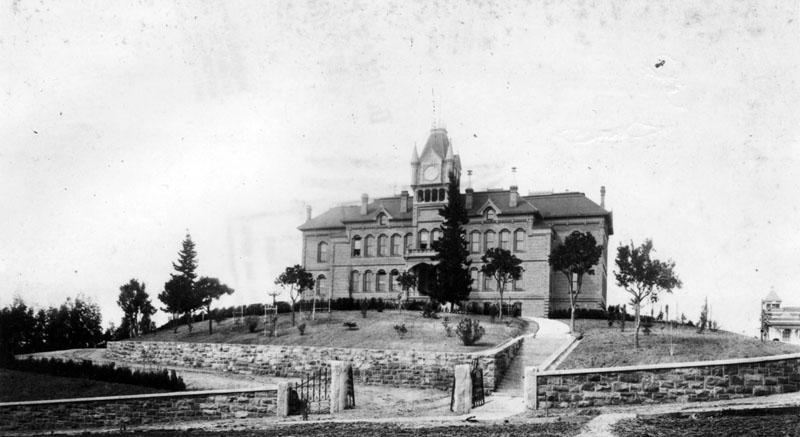 |
|
| (ca. 1882)* - Front view of the State Normal School, located at Grand and 5th Street on a hill that would later be occupied by the Los Angeles Central Library. |
Historical Notes In March 1881, after heavy lobbying by Los Angeles residents, the California State Legislature authorized the creation of a southern branch of the California State Normal School (which later became San Jose State University) in downtown Los Angeles to train teachers for the growing population of Southern California. The State Normal School at Los Angeles opened on August 29, 1882, on what is now the site of the Central Library of the Los Angeles Public Library system. |
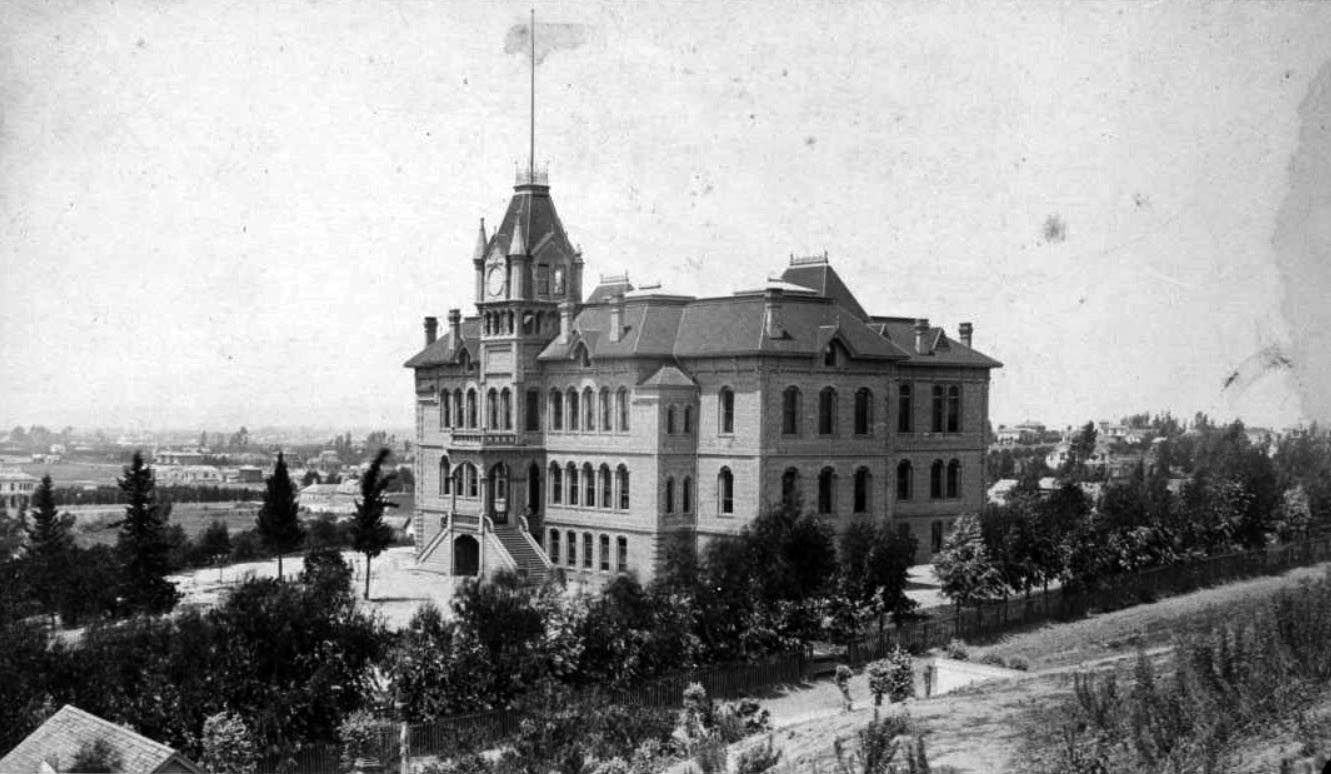 |
|
| (1882)#* – View showing the State Normal School on Fifth Street shortly after its construction. |
Historical Notes The new facility included an elementary school where teachers-in-training could practice their teaching technique on children. That elementary school is related to the present day version, UCLA Lab School. In 1887, the school became known as the Los Angeles State Normal School. |
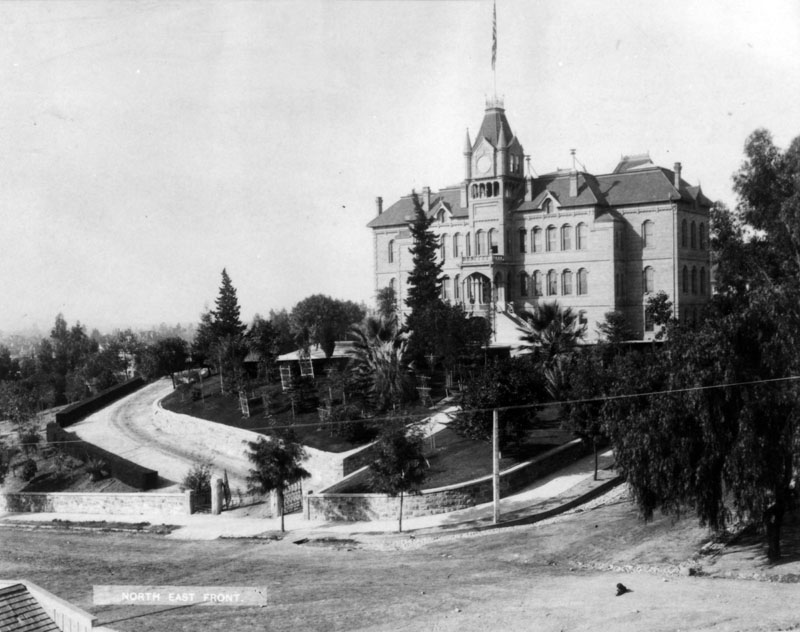 |
|
| (ca. 1893)* - Southwest corner view of the State Normal School, located at Grand and 5th Street. A long and winding driveway is located on the left side of the entrance, and a long flight of stairs (barely visible) is on the right; the school sits impressively on the last knoll of Bunker Hill, aptly dubbed "Normal Hill". |
Historical Notes After the demolition of this structure (1922), 5th Street was straightened and the remainder of the site was eventually occupied by the L.A. Public Library. |
.jpg) |
|
| (ca. 1905)^^ - The four-story Victorian-style Normal School building can be seen at center overlooking a beautiful courtyard. The building features steep gables, pointed towers and ceilings, a circular tower at left, and a square tower at right. A few other much smaller buildings can be seen at right. Legible signs include: "State Normal School". |
Historical Notes Through the years, the State Normal School was expanded and several new wings were added; the "new and improved" facility would eventually include an elementary school where the teachers-in-training could practice their teaching technique on real children.* |
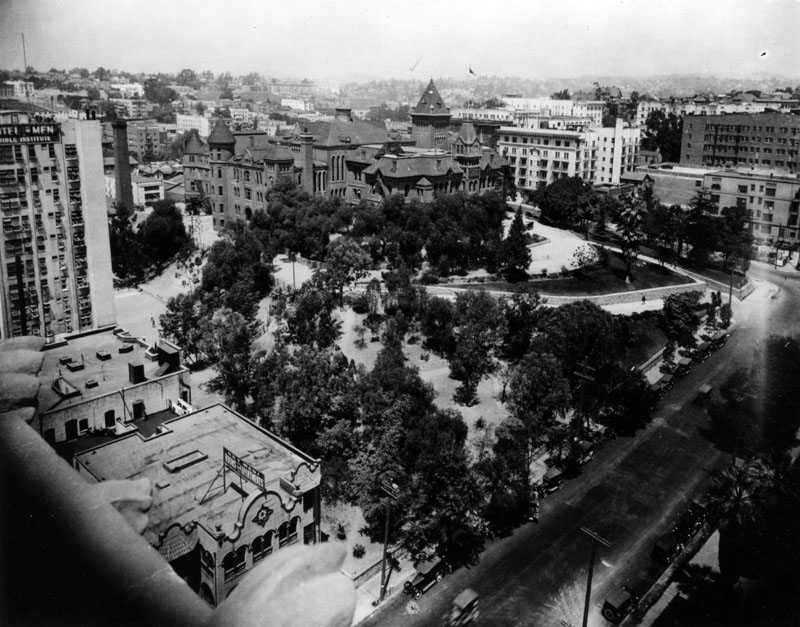 |
|
| (Early 1900s)* - Aerial view of the State Normal School, located at Grand Avenue and 5th Street. Because the school sat impressively on the last knoll of Bunker Hill, aptly dubbed "Normal Hill", there were two ways to get to the main entrance: either taking the long and winding driveway located on the left side, or a long flight of stairs on the right (partially covered by the trees), which was parallel to 5th Street. The beautiful brick building had numerous tall windows all around, several chimneys, gabled dormers, a tower with a balcony and ornate grill, a set of stairs on either side leading to the main doors, and beautiful landscaping all around. The large white building on the middle left is the Bible Institute, later to become the Church of the Open Door, that was located on Hope Street; the Key West Rooms and Apartments is visible on the lower left. |
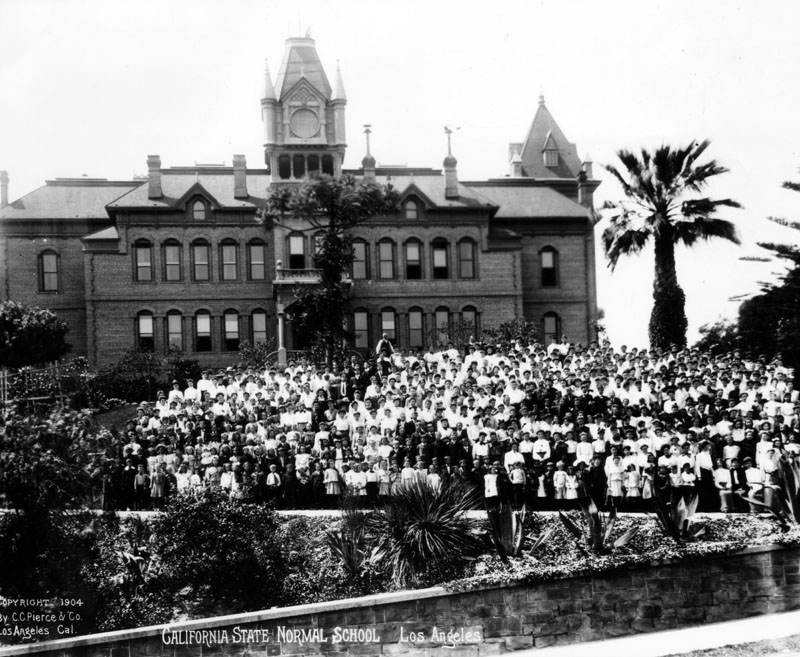 |
|
| (1904)* - Panoramic photo of teachers and student body of the California State Normal School, located at 5th Street and Grand Avenue in Los Angeles. |
Historical Notes By 1914 the little pueblo of Los Angeles had grown to a city of 350,000 and the school, whose enrollment far exceeded its capacity, moved to new quarters -- a Hollywood ranch off a dirt road which would later become Vermont Avenue.^^ |
UCLA is Born
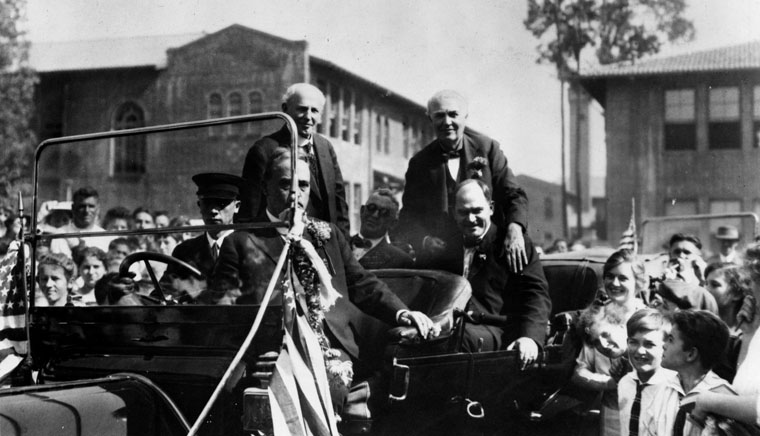 |
|
| (ca. 1915)* - Thomas Edison visits the Los Angeles State Normal School (the old Vermont Avenue campus, University of California). To Edison's left is the school's president, Jesse H. Millspaugh. |
Historical Notes In 1917, UC Regent Edward A. Dickson, the only regent representing the Southland at the time, and Ernest Carroll Moore, Director of the Normal School, began working together to lobby the State Legislature to enable the school to become the second University of California campus, after Berkeley. They met resistance from Berkeley alumni, Northern California members of the state legislature, and Benjamin Ide Wheeler, President of the University of California from 1899 to 1919, who were all vigorously opposed to the idea of a southern campus. However, David Prescott Barrows, the new President of the University of California, did not share Wheeler's objections and, in 1919, the Southern Californians efforts finally paid off.*^ |
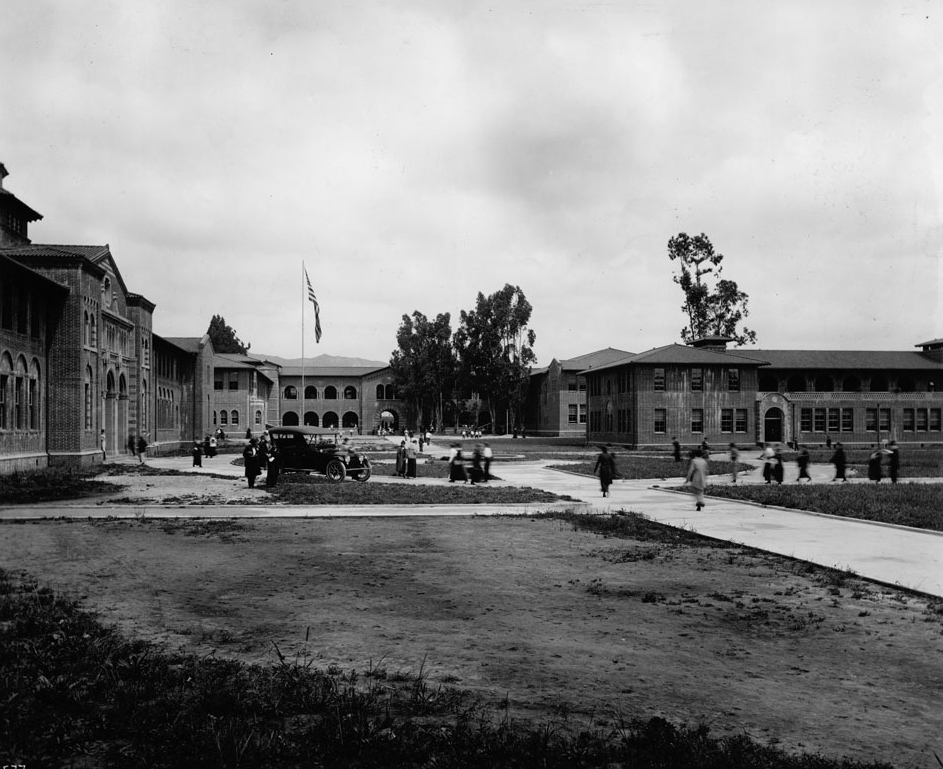 |
|
| (ca. 1919)^^ - Photograph of the campus of the University of California Los Angeles (UCLA) on north Vermont Avenue, later Los Angeles State College for a time, and Los Angeles City College. Surrounded by Romanesque brick architecture full of arches, an early automobile is parked in front of a flag pole which sports the American flag. Several people stand by it while others walk around on the campus walkways. |
Historical Notes On May 23, 1919, Governor William D. Stephens signed Assembly Bill 626 into law, which merged the Los Angeles Normal School with the University of California as the Southern Branch of the University of California. The same legislation added its general undergraduate program, the College of Letters and Science. The Southern Branch campus opened on September 15 of that year, offering two-year undergraduate programs to 250 Letters and Science students and 1,250 students in the Teachers College, under Moore's continued direction.*^ |
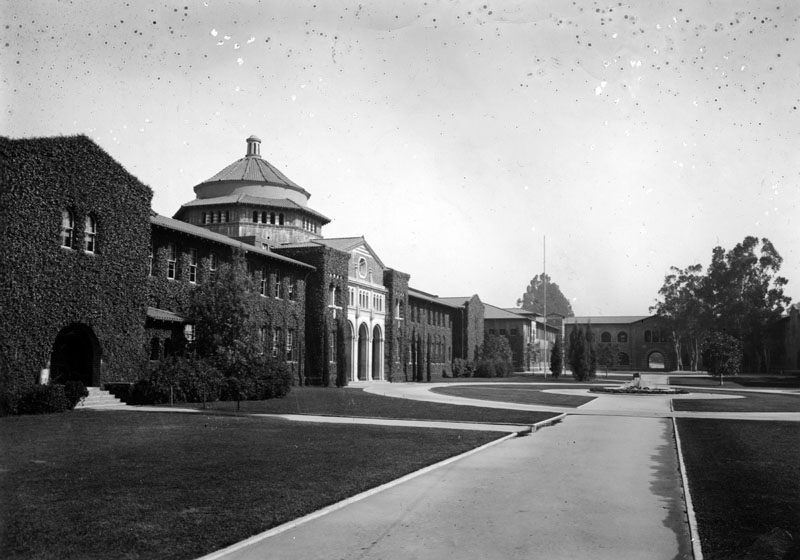 |
|
| (ca. 1920)* - The ivy-covered Beaux-Arts style building with the flared polygonal dome (seen on the left) is Millspaugh Hall, the Administration building of the University of California, Southern Branch, located at 855 N. Vermont Ave. |
Historical Notes The cornerstone for Millspaugh Hall was laid on November 18, 1913; in September 1914, the school began its sessions in the new building. It was the center of student and administrative activity and occasionally an outdoor assembly area. The University of California, Southern Branch campus was laid out along a central axis, with the fine arts, domestic science, and library buildings facing the gymnasium, science building and teacher training school; the administration building (Millspaugh Hall) sat at the head of the group. The University of California, Southern Branch would eventually come to be known as the University of California, Los Angeles - or UCLA for short.* |
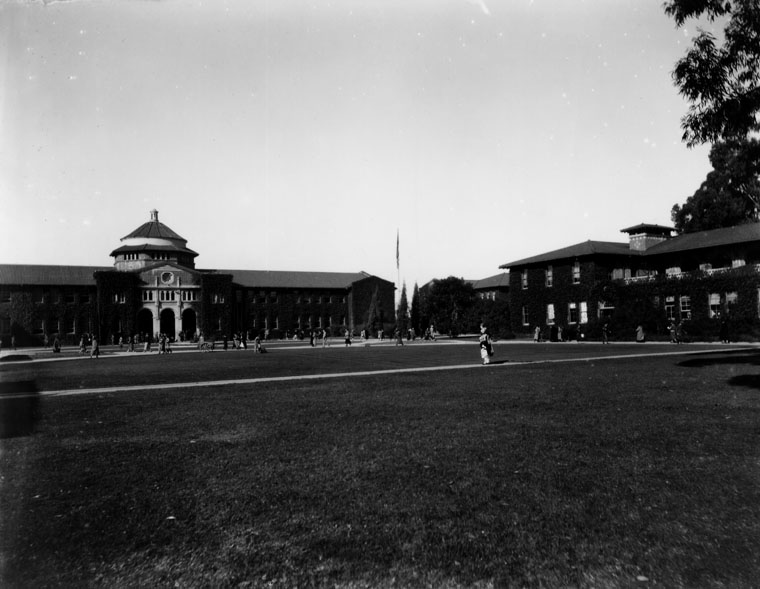 |
|
| (ca. 1922)* - Students on pathways in front of Millspaugh Hall at the old Vermont Avenue campus, Univeristy of California, Los Angeles, Southern Branch, later known as Los Angeles City College. Twelve of the buildings were designed by architects Allison and Allison and built in 1914. |
Historical Notes UCLA's first Commencement was in 1920 and was held in Millspaugh Hall of what was then the Los Angeles State Normal School on Vermont avenue. The institution conferred its first bachelor's degree in education in 1923, and its first bachelor of arts degree in 1925. The Class of 1928 was graduated in ceremonies held in the Hollywood Bowl, the site of UCLA Commencements for several years, even following the move from the Vermont Avenue campus to Westwood in 1929.^* |
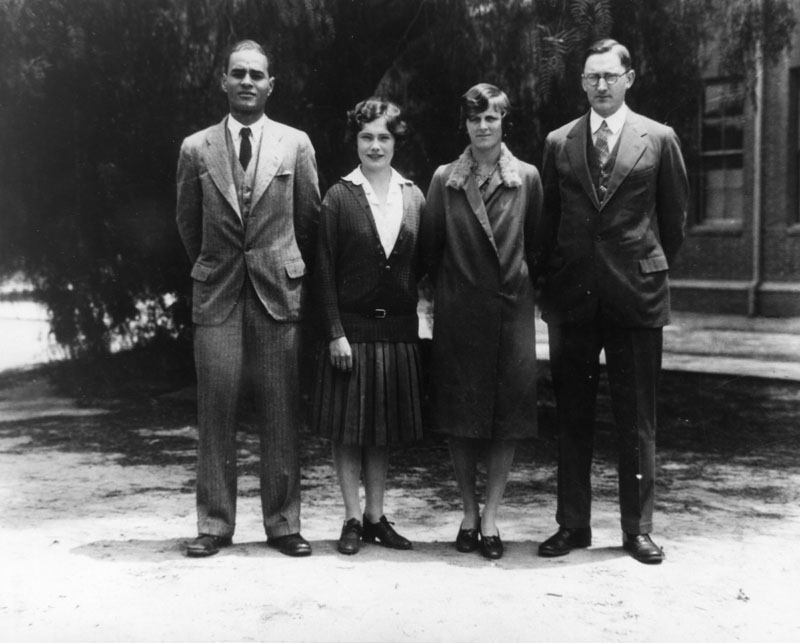 |
|
| (ca. 1927)* - Ralph Bunche, left, with a group at the Southern Branch of the University of California on Vermont Avenue. |
Historical Notes The valedictorian of his class at Jefferson High, Ralph Bunche was an all-around athlete who competed in football, baseball and track. He attended UCLA when the school campus was located on Vermont Avenue, playing basketball on an athletic scholarship. Later he helped to write the charter for the United Nations. Bunche won the Nobel Peace Prize in 1950 for his efforts in developing peace agreements in the Middle East.* |
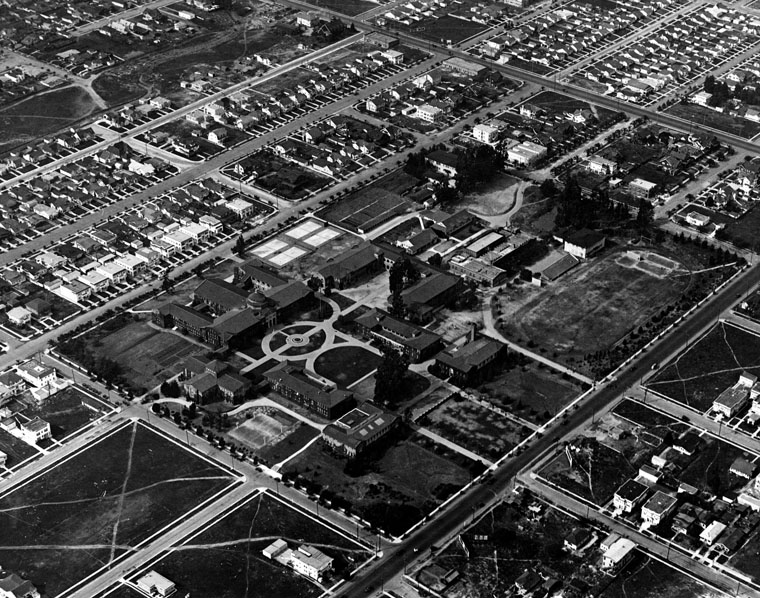 |
|
| (1922)* - Aerial view of the old Vermont Avenue campus of the University of California, Los Angeles, which later became Los Angeles City College. Vermont Avenue runs from the bottom of the photo to the right. |
Historical Notes The "Southern Branch" of the University of California was no longer merely a teacher's college but an institution that offered two years of instruction in Letters and Science. Third- and fourth-year courses were soon added, the first class of 300 students was graduated in 1925, and by 1927 the Southern Branch had earned its new name: University of California at Los Angeles (the "at" became a comma in 1958). As the student population of the University continued to increase, the need for a new site became obvious and the search was soon under way for a permanent home for UCLA. |
* * * * |
Development of Westwood
Historical Notes Westwood and UCLA were developed on the lands of the historic 'Wolfskill Ranch', a 3,000-acre parcel that was purchased by Arthur Letts, the successful founder of the Broadway, and Bullock's department stores, in 1919. Upon Arthur Lett's death, his son-in-law, Harold Janss, vice president of Janss Investment Company, inherited the land and started to develop the area in 1922.*^ |
.jpg) |
|
| (1922)* - Aerial view of Westwood and surrounding area looking north. Santa Monica Boulevard runs horizontally at bottom of photo while a tree-lined Wilshire Boulevard runs from left to right at center. Beverly Glen, not yet constructed here, will run from lower-left, under Santa Monica Boulevard bridge, up north to the Wolfskill ranch house (seen at center-left) on Wilshire Boulevard. |
Historical Notes The view above, from about the time of the Letts purchase, shows the land with the Wolfskill ranch house (center left), located on what is today the northwest corner of Wilshire Boulevard and Beverly Glen. |
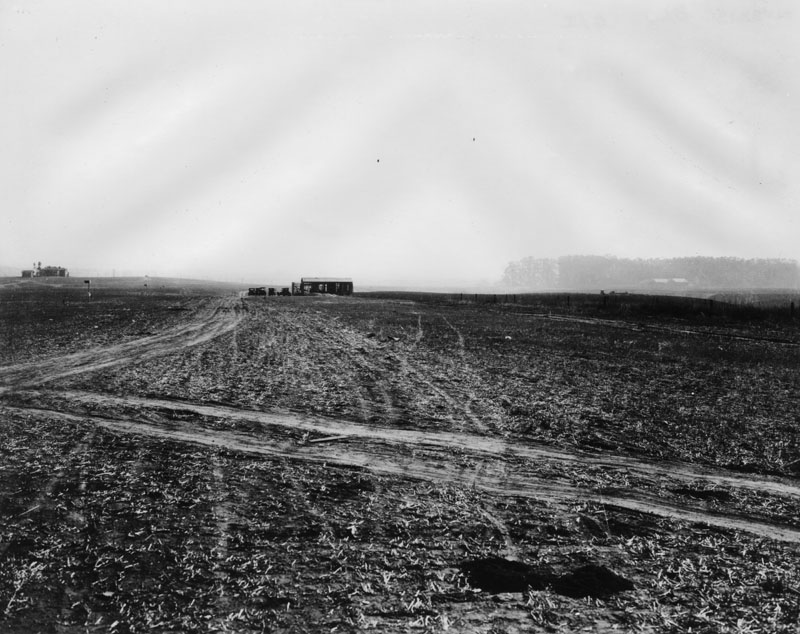 |
|
| (ca. 1924)* - View of part of the old Wolfskill Ranch, also known as the Rancho San Jose de Buenos Aires. The house, shown here on the extreme left, occupied the present corner of Wilshire Boulevard and Beverly Glen, and UCLA occupies part of the rancho. |
 |
|
| (1924)* - The old John Wolfskill home, also known as the Rancho San Jose de Buenos Aires. The house was located at the present corner of Wilshire Boulevard and Beverly Glen. |
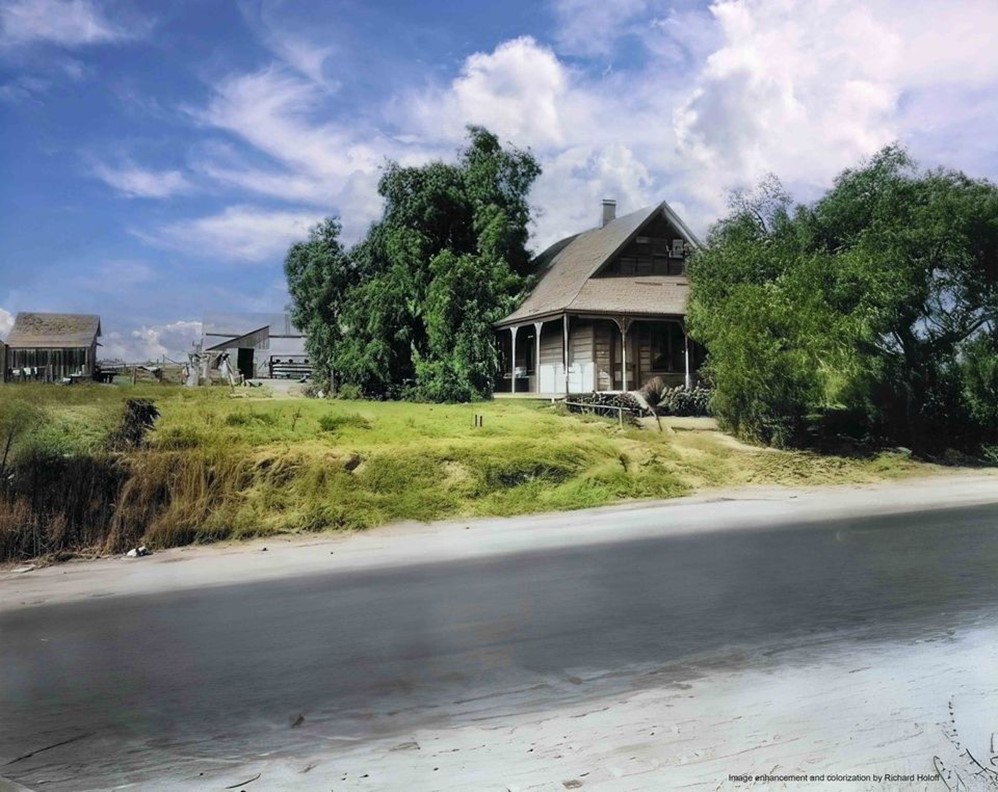 |
|
| (1924)* - The old John Wolfskill home, also known as the Rancho San Jose de Buenos Aires. The house was located at the present corner of Wilshire Boulevard and Beverly Glen. Image enhancement and colorization by Richard Holoff. |
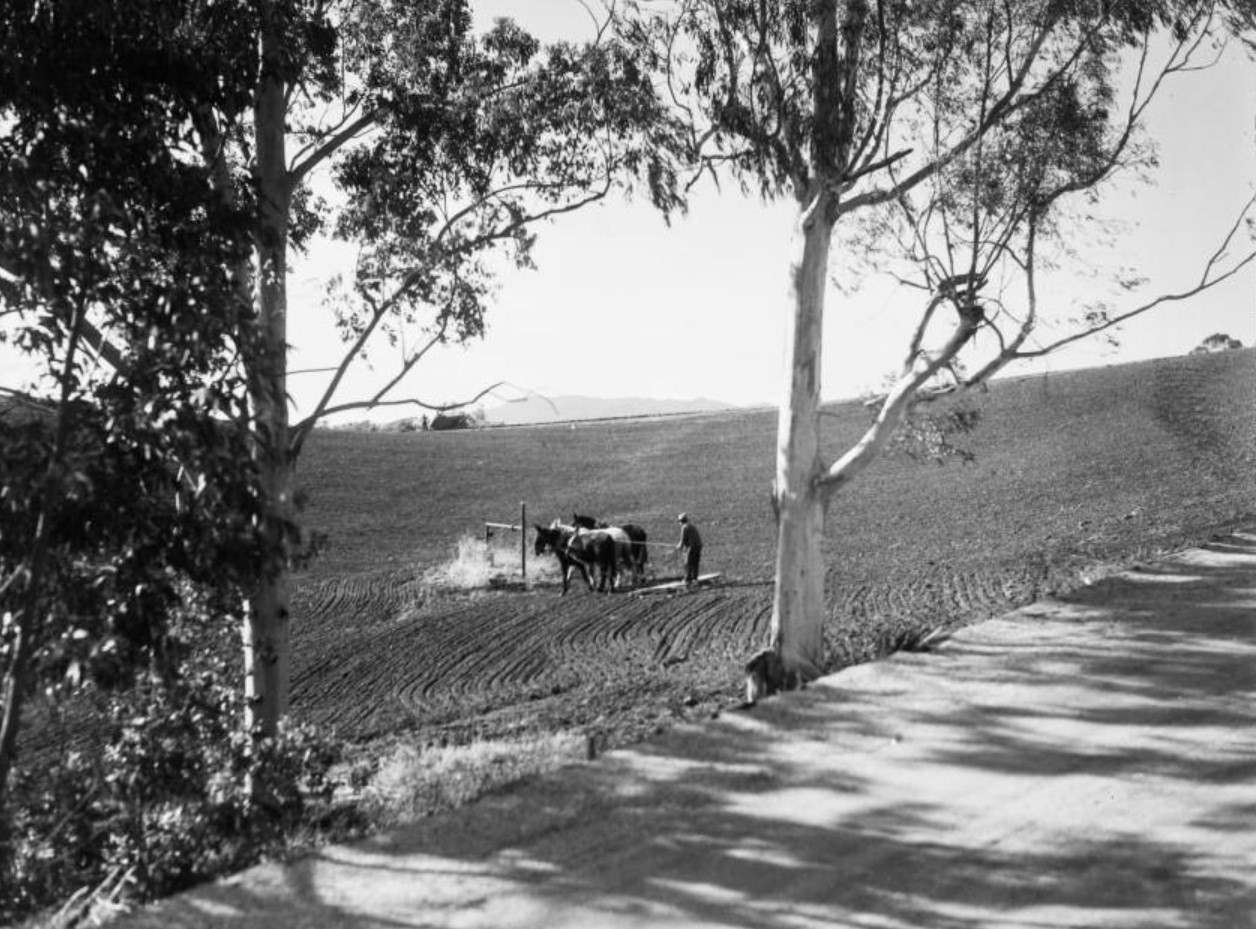 |
|
| (1920s)#* - A man stands on a plow being pulled by mules, preparing soil for farming on land that would become Westwood. |
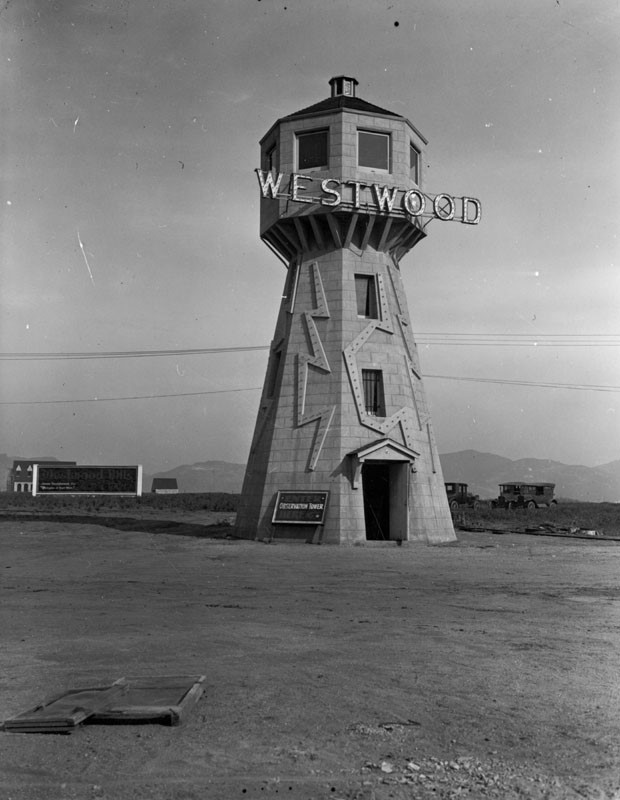 |
|
| (ca. 1924)* - View showing an observation tower in Westwood at Beverly Glen and Wilshire Boulevards. It has a sign, "Westwood" with lightbulbs, and little else surrounds it. |
Historical Notes Built by the Janss Investment Corporation in the 1920s, this oddly shaped tower was located on the northeast corner of Wilshire and Beverly Glen Boulevards. It stood at 420 feet above sea level, making it the highest point on Wilshire Boulevard at the time and was used primarily as a landmark advertisement. At night, the lightning bolts along the sides and the 'WESTWOOD' sign would light up and be seen for miles. Potential home owners were allowed to climb the tower to get a better view of the new community and identify the lot they would like to purchase.^# |
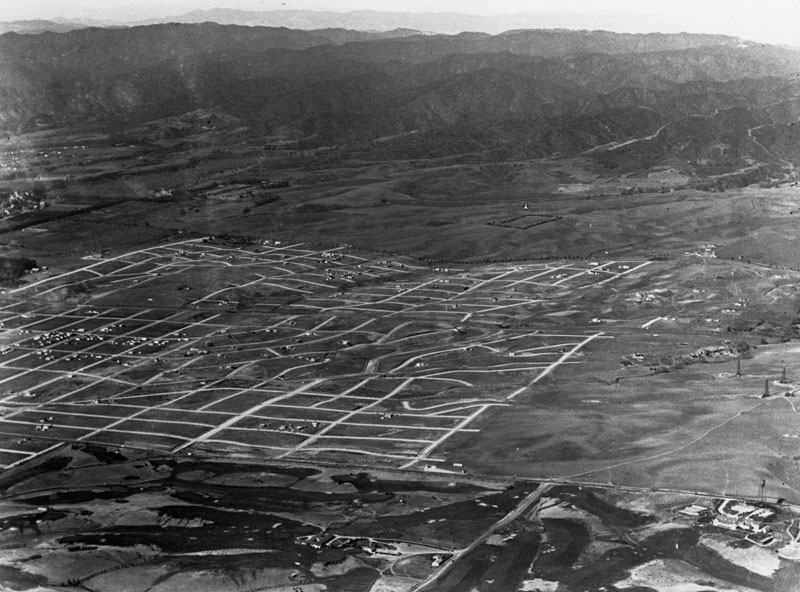 |
|
| (1924)* - View of the new development reaching from Wilshire on the north to Pico on the south and from Westwood Blvd on the west to Fox Hills Drive on the east, with a further small section running SW from Patricia and Pico. |
Historical Notes The large empty parcel, upper left, within the platted area is the Wolfskill ranch house, on the P.E. route, at the T-junction with Overland Ave, standing alone on twenty-five plus acres. The Harold Lloyd Motion Picture Company's Westwood studio ranch occupied this site a bit after this photo was taken. The northern portion was sold off to build the Saint Paul the Apostle RC church and school circa 1930. Lloyd's declining fortunes caused him to sell the rest to the LDS church in 1937. The church finally built the LDS Temple there in 1956.^# |
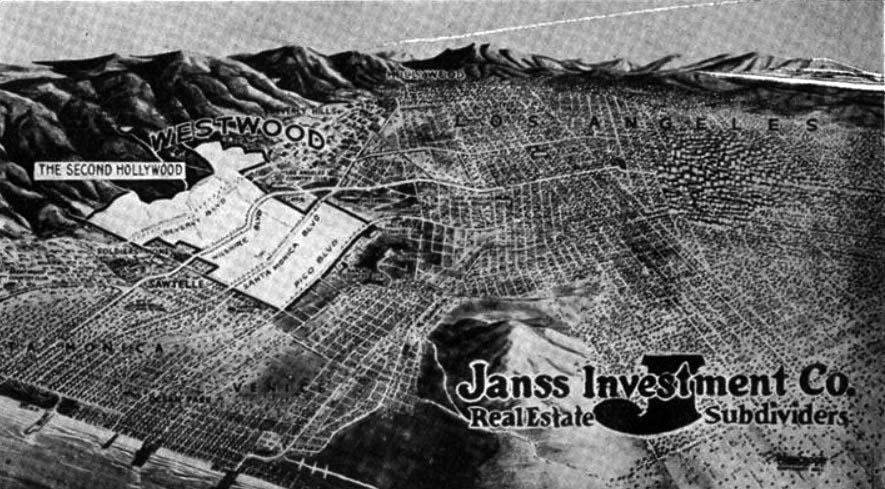 |
|
| (ca. 1925)^#^ – Photo of the Janss Real Estate map for its new westside subdivision. The Westwood development area was billed as “The Second Hollywood”. |
Historical Notes In 1925, in a deal to get the University of California, Los Angeles built, the Janss Investment Company sold 375 acres to the cities of Los Angeles, Santa Monica and Beverly Hills at the bargain price of $1.2 million — about a quarter of its value. The cities, whose voters had passed bond issues to pay for the site, turned around and donated it to the state. While the UCLA campus was being built, Janss Investment Company went to work developing the Westwood Village commercial area and surrounding residential neighborhoods.*^ |
1st Structure on the UCLA Campus (Arroyo Bridge)
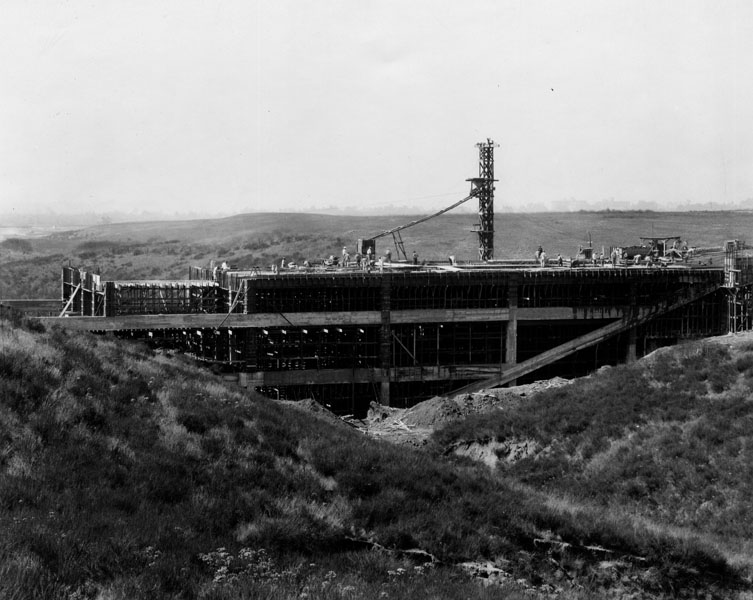 |
|
| (1927)* - Construction of the UCLA Bridge. This was the first structure built on the new Westwood campus |
Historical Notes In May 1927, ground was broken at UCLA’s new Westwood campus and the first priority was to construct a bridge to cross the deep arroyo. The bridge was necessary for transporting construction supplies over the ravine that divided the east and west parts of the site. |
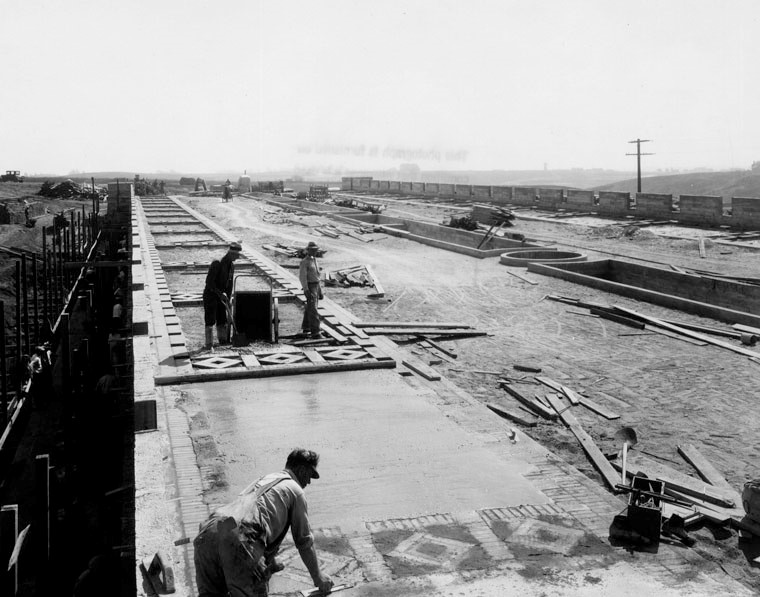 |
|
| (1927)* - Workers are seen laying sidewalk on the new Arroyo Bridge. |
Historical Notes The Arroyo Bridge was dedicated in a ceremony officiated by Gov. C. C. Young on Oct. 23, 1927, marking the completion of the first structure on campus.^*^ |
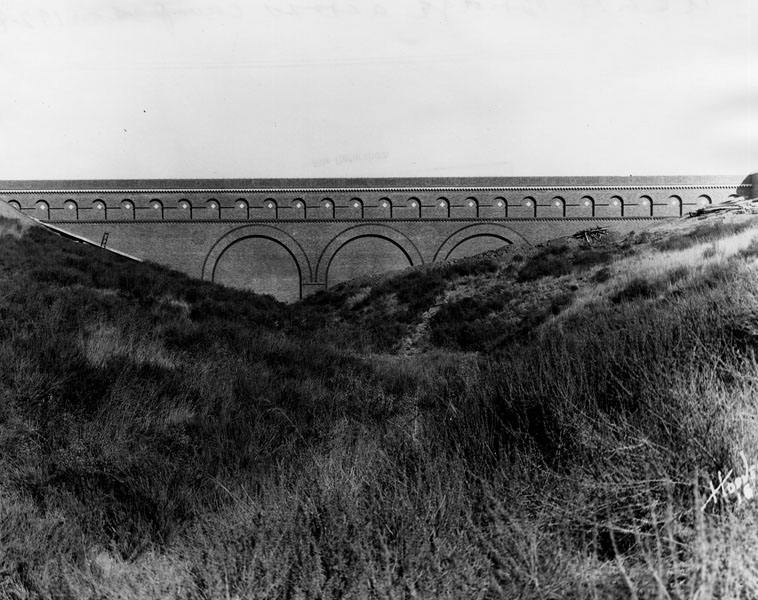 |
|
| (1927)* - Side view of the new UCLA Bridge (aka Arroyo Bridge). This was the axial link between the main quad and other buildings across an arroyo. |
Historical Notes Modeled after the Roman aqueducts by University of California supervising architect George W. Kelham, the bridge was necessary for transporting construction supplies over the chaparral-covered ravine and was originally intended to be UCLA's main entryway. Mules pulled materials including cement sacks, lumber and bricks over the Arroyo Bridge from the east entrance on Hilgard Avenue.^ |
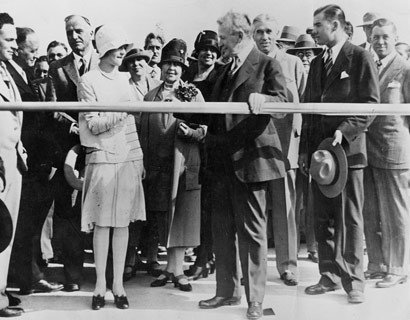 |
|
| (1927)^x^ - Gov. C.C. Young cuts the ceremonial ribbon at the dedication of the Arroyo Bridge, UCLA’s first structure at Westwood. Student Helen Fitch ’30 handed him the honorary shears. To the right, holding his hat, stands UCLA student body President Tom Cunningham ’28. UC Regent Edward A. Dickson observes from the far right. |
Historical Notes Hailed as the "avenue to the future," the $100,000 Arroyo Bridge was dedicated at a ceremony officiated by Associated Students President Thomas J. Cunningham and attended by California Gov. C.C. Young on October 22, 1927, officially marking the completion of the first structure on campus. "In opening this bridge, we are opening the portals for a new era in the history of the university," Cunningham said.^ |
.jpg) |
|
| (1929)* - View looking west showing the full extent of the Arroyo Bridge with the twin towers of Royce Hall seen in the distance. |
Historical Notes The reinforced concrete walls of the bridge contained three huge arches, and Kelham's Romanesque design featured intricate rosette and diamond patterns of carved limestone and inlaid red brick, with decorative parapets and a series of smaller arches running along the upper portion of the structure. It stood approximately 300 feet long, 75 feet wide and 50 feet above the arroyo.^ |
.jpg) |
|
| (1929)* - Students cross the Arroyo Bridge on their way to and from classes and the library. |
Historical Notes Over the years, the bridge has become a storied part of UCLA's history. During the Great Depression, it provided shelter for impoverished students. In wartime, when the Japanese were targeting the California coast via submarine, enough food was reportedly stored beneath it to feed 50,000 people — in case of attack.^ |
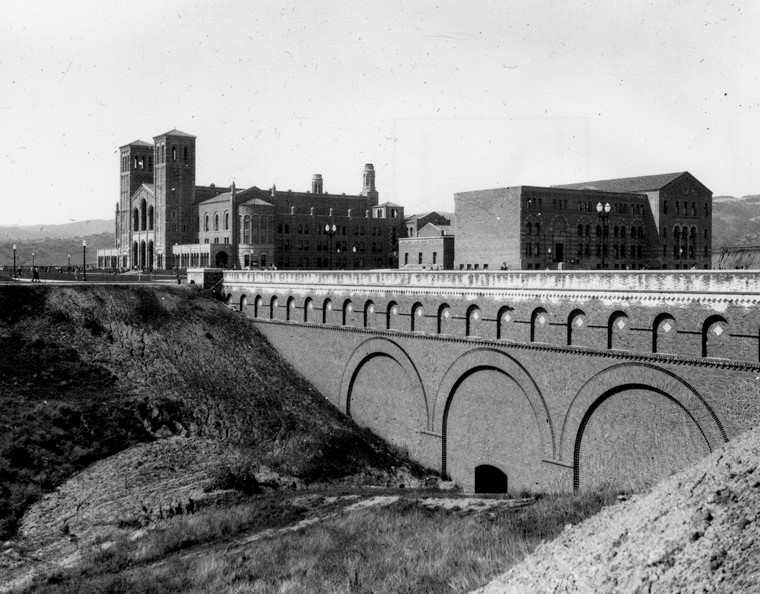 |
|
| (1929)* - Looking northwest toward the Arroyo Bridge which connects Hilgard Avenue to the main campus quadrangle at U.C.L.A. The newly constructed Royce Hall and Haines Hall are seen in the background. |
Historical Notes In the summer of 1947, the gully was filled to increase the amount of useable property on the campus. Today, the bridge’s arches remain hidden underground at Dickson Plaza.^*^ |
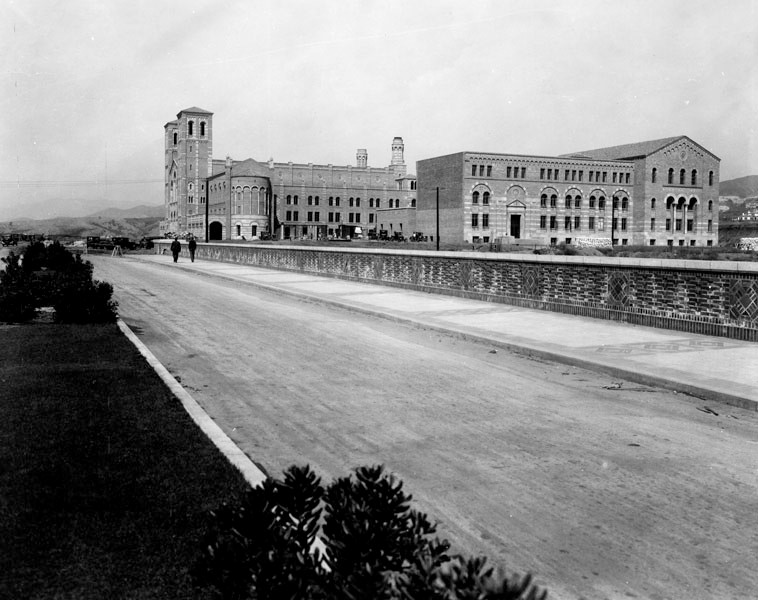 |
|
| (1929)* - Street level view showing two men walking across the Arroyo Bridge with the center median at left. Seen in the background are Royce Hall and Haines Hall. |
Historical Notes Today, the bridge's arches remain hidden underground at Dickson Court, largely ignored by the many crossing it daily. A sign cautions a weight restriction, and it continues to be inspected to meet safety and earthquake standards.^ |
Construction of the 1st Buildings on the UCLA Campus
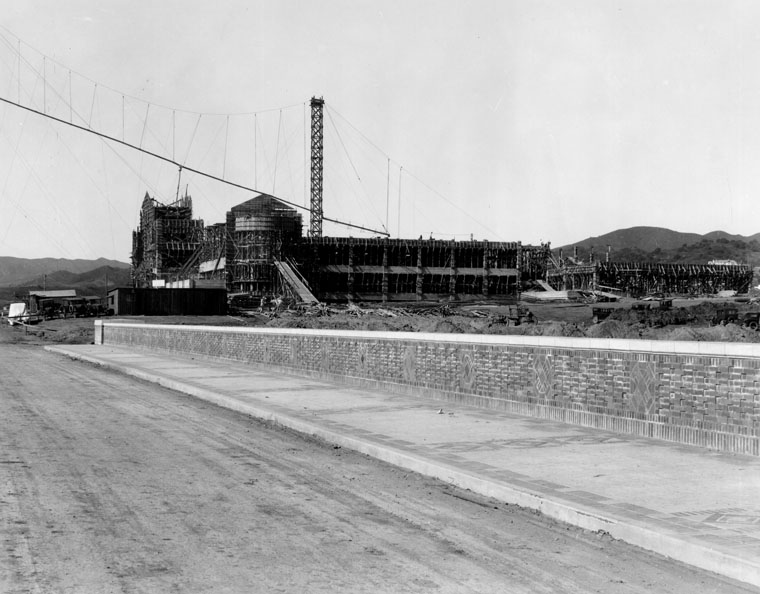 |
|
| (ca. 1928)* - View looking northwest as seen from the Arroyo Bridge showing the construction of Royce Hall. Note the type of cranes used during the 1920s and 1930s. |
Historical Notes Ground was broken on the new campus in Westwood on September 27, 1927. The original four buildings were the College Library, Royce Hall, the Physics-Biology Building, and the Chemistry Building (presently Powell Library, Royce Hall, the Humanities Building, and Haines Hall, respectively), arrayed around a quadrangular courtyard on the 400 acre campus. George W. Kelham of San Francisco was the supervising architect, assisted by David Allison of the Los Angeles firm Allison & Allison. Allison, who was also the designer of the Vermont Avenue campus, envisioned the Romanesque style of the Westwood campus.*^ |
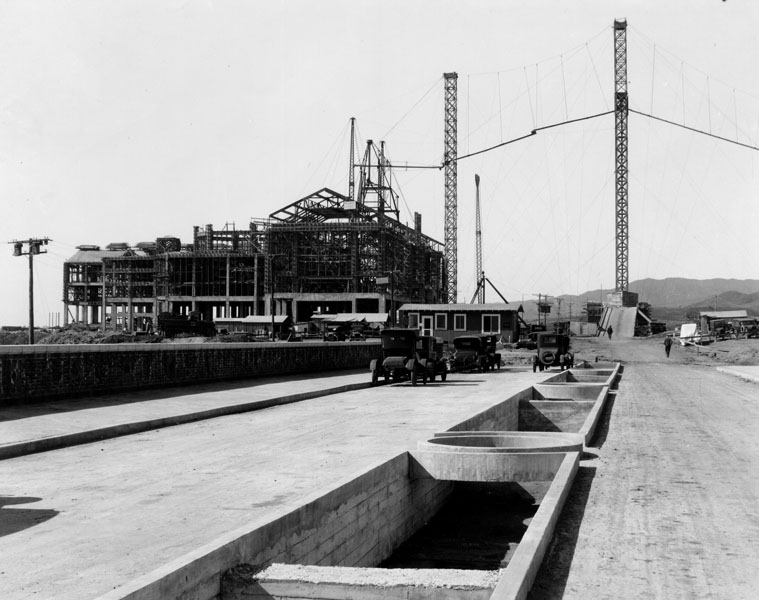 |
|
| (ca. 1928)* - View showing the construction of the library, now the Lawrence Clark Powell Library (originally called College Library), from a still yet to be completed Arroyo Bridge. |
Historical Notes Built between 1927 and 1929, the Powell Library was constructed in Italian Romanesque Revival style and designed by architect George W. Kelham.* |
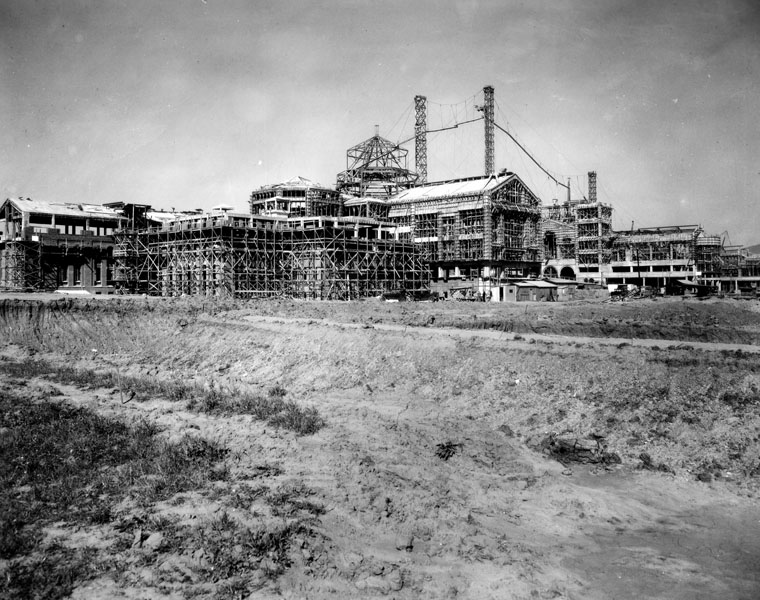 |
|
| (1928)* - View looking northeast showing the construction of the first four buildings on UCLA's new campus. |
Historical Notes Because the rolling terrain of the campus suggested northern Italy, a Romanesque or Italian Renaissance style of architecture was adopted, featuring red brick, cast stone trim, and tile roofs. Many of the early buildings were modeled from churches and universities in Bologna, Milan, and Verona.** |
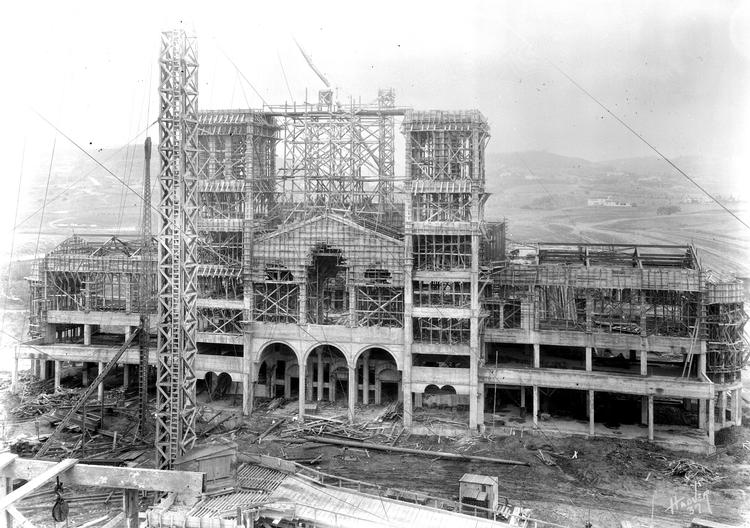 |
|
| (1928)*# - View showing Italian Renaissance style Royce Hall under construction with cranes and scaffolding. |
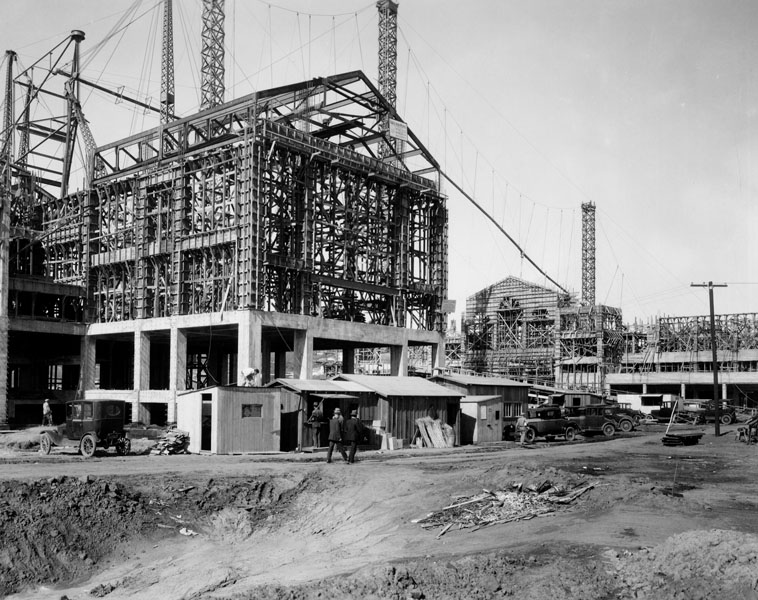 |
|
| (ca. 1928)* - Two men wearing suits walk past the construction site of the College Library (presently Powell Library). On the right can be seen Royce Hall, which is still under construction. |
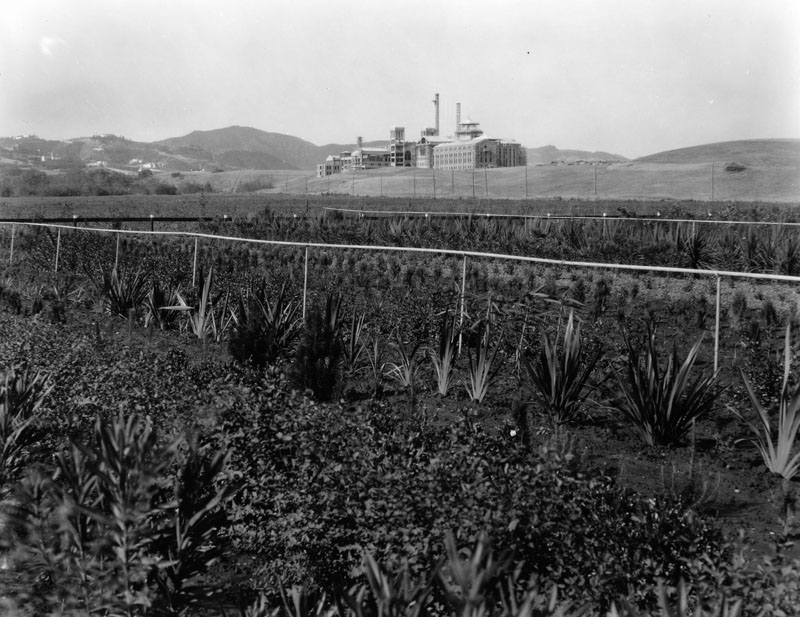 |
|
| (ca. 1928)* - View looking from the southwest from the propagation fields showing the UCLA campus starting to take form. |
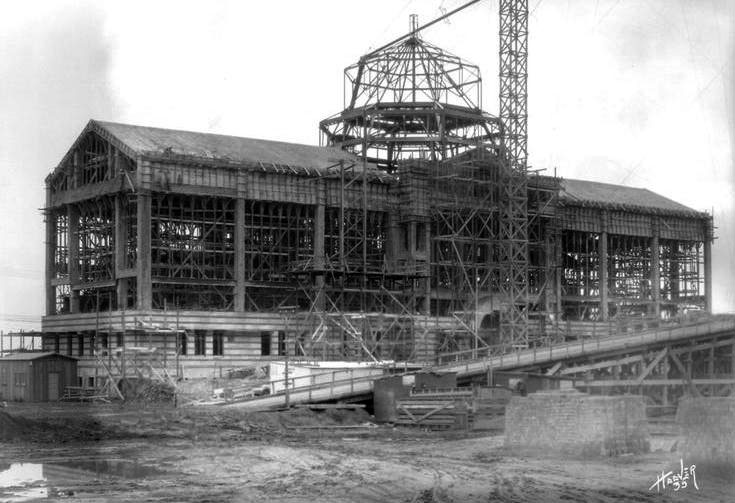 |
|
| (1928)*# - View showing the early stages of construction of Powell Library, showing the steel beems of its central tower. The building is surrounded by and filled-in with scaffolding. |
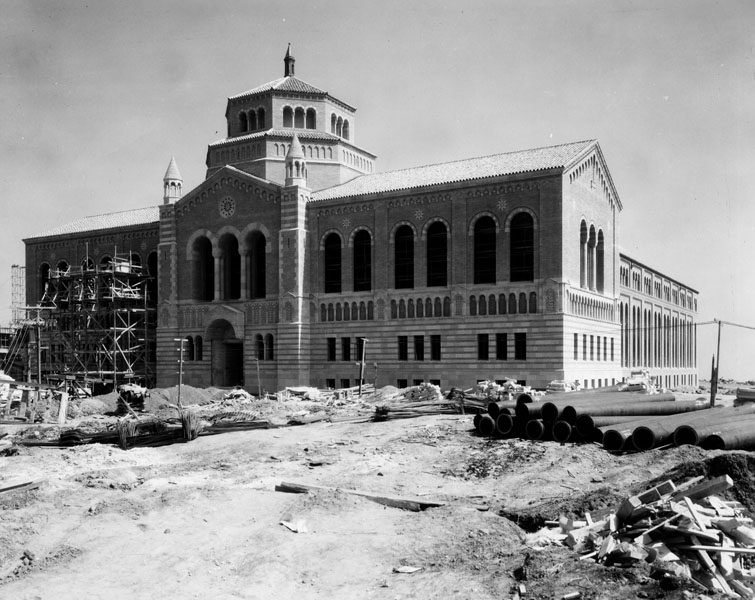 |
|
| (1928)* - The Lawrence Clark Powell Library (originally College Library) nearing completion. |
Historical Notes Powell Library (originally called College Library) is named for Lawrence Clark Powell, the University Librarian at UCLA from 1944 to 1961 and Dean of the Graduate School of Library Service from 1960 to 1966.*^ |
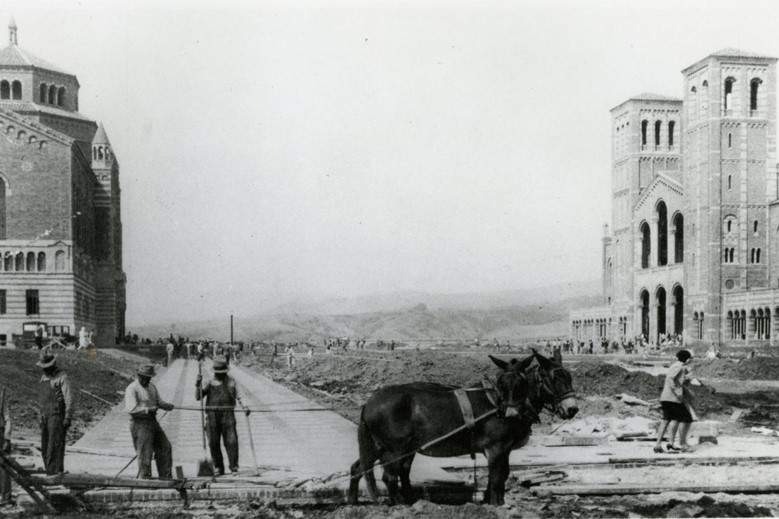 |
|
| (1928)*- Harnessing mule power to build the UCLA Campus. |
Then and Now
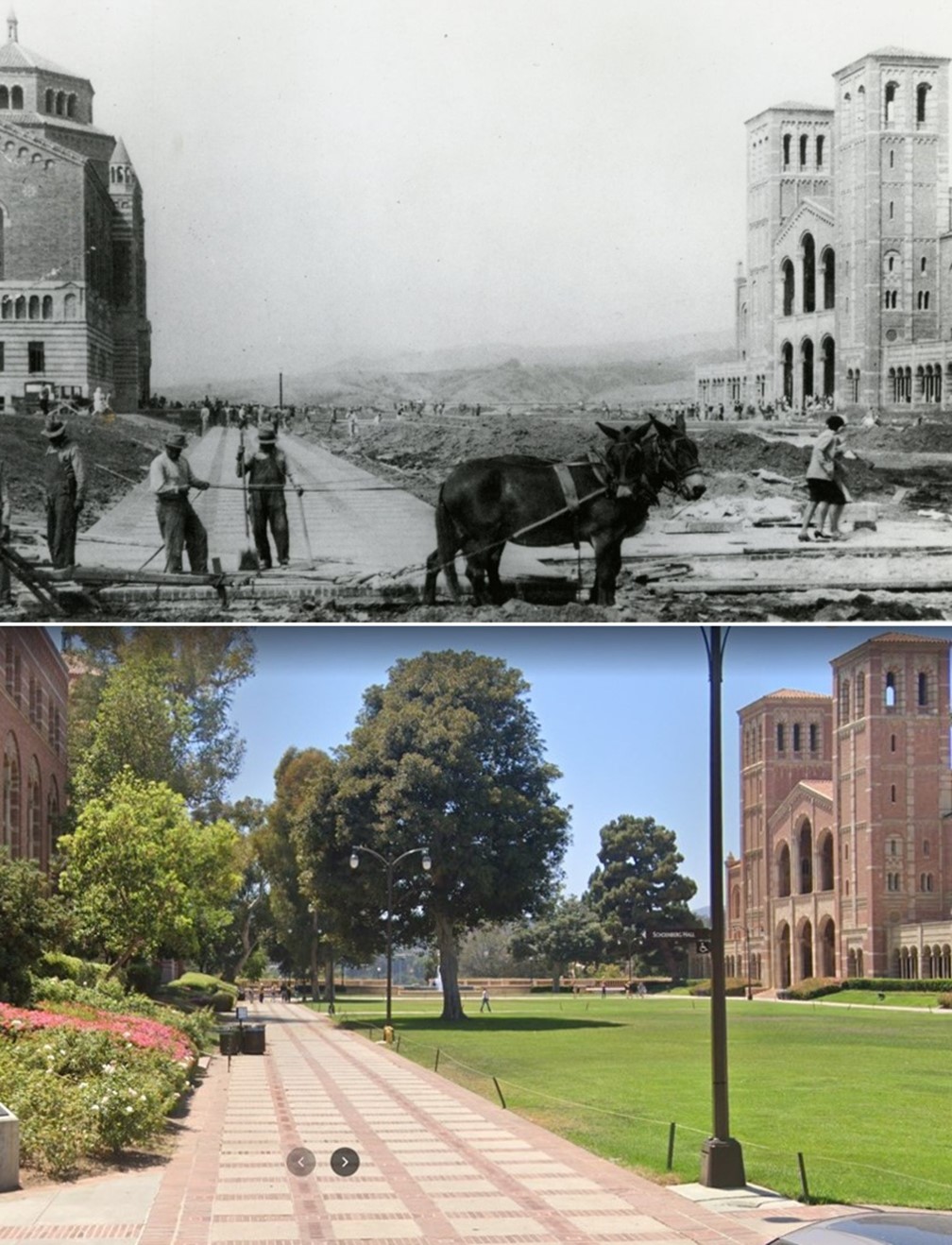 |
|
| (1928 vs. 2021)* - UCLA Campus Then and Now. Photo comparison by Jack Feldman. |
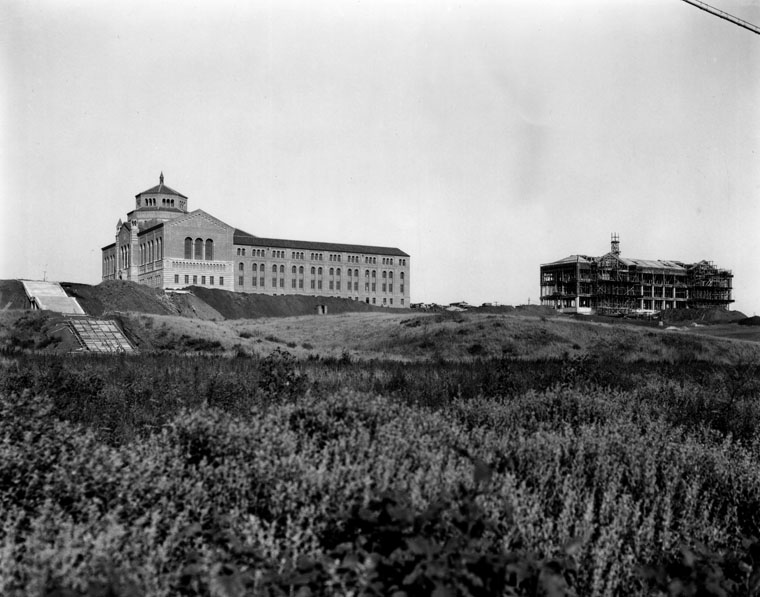 |
|
| (ca. 1928)* - View of the new UCLA Westwood campus. On the left is Powell Library. On the right is Moore Hall, still under construction (completed in 1930). Both buildings were constructed in a northern Italian Romanesque Revival style, designed by architect George W. Kelham. |
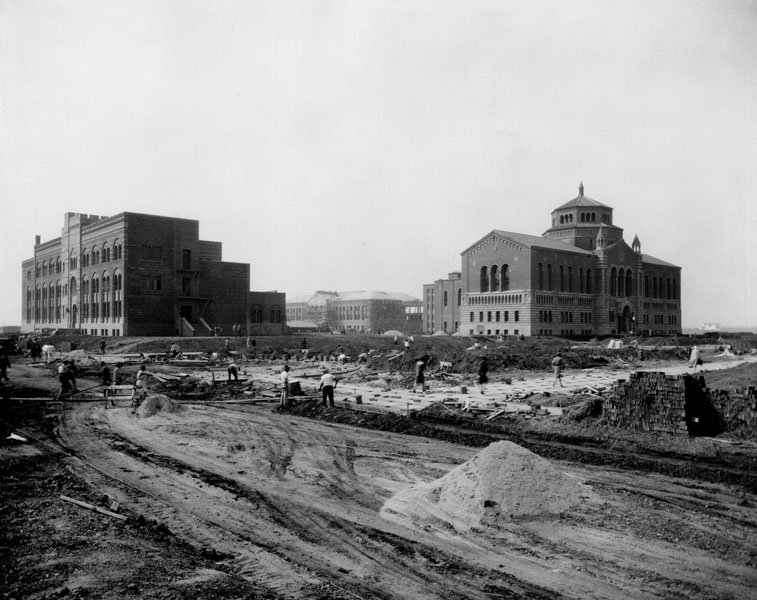 |
|
| (ca. 1928)* - This view shows the Physics Building on the left, Moore Hall in the rear center, and Powell Library on the right. The Physics Building, now Kinsey Hall, was built in 1928-29 and designed by Allison and Allison, Architects. |
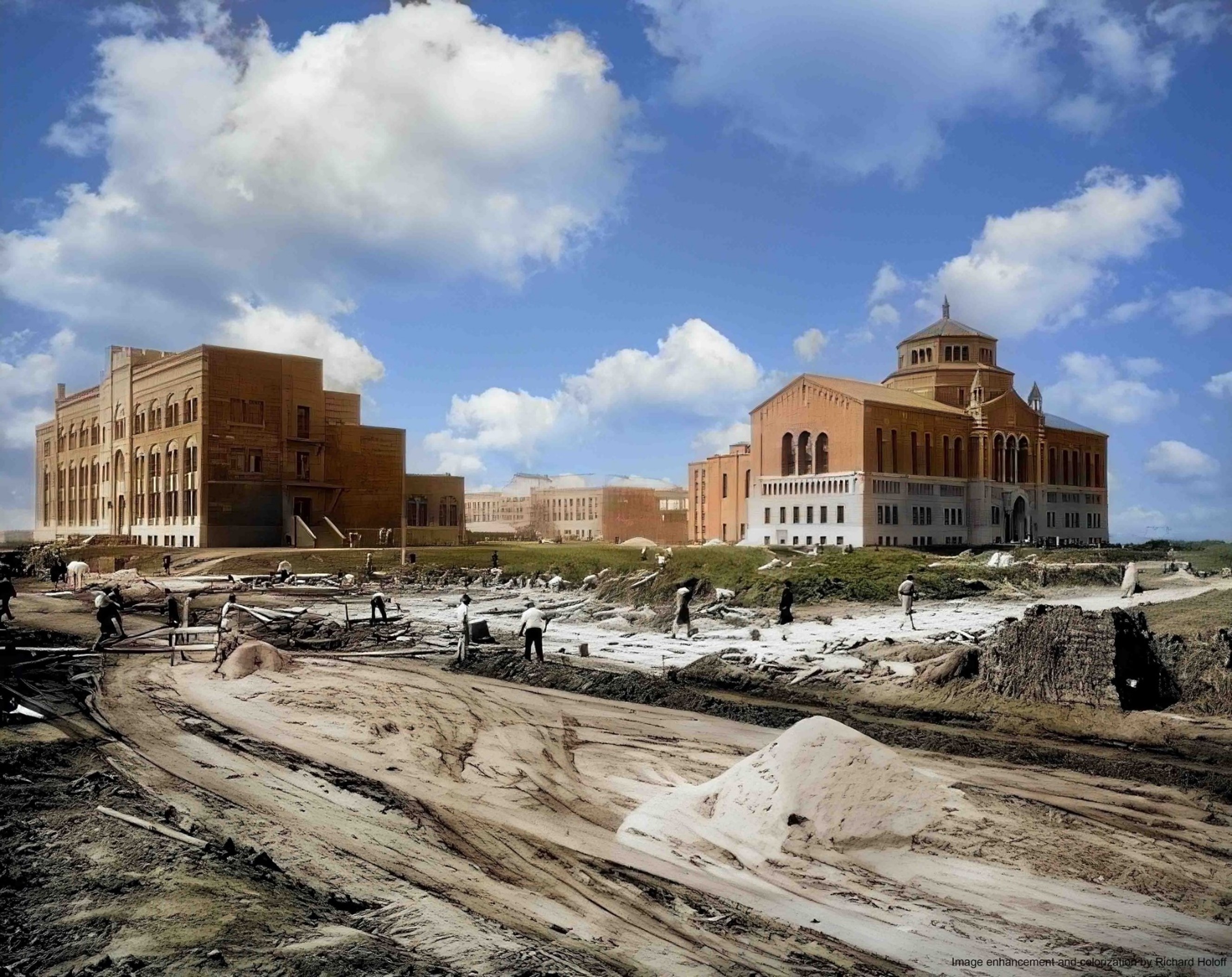 |
|
| (ca. 1928)* - This view shows the Physics Building on the left, Moore Hall in the rear center, and Powell Library on the right. The Physics Building, now Kinsey Hall, was built in 1928-29 and designed by Allison and Allison, Architects. Image enhancement and colorization by Richard Holoff. |
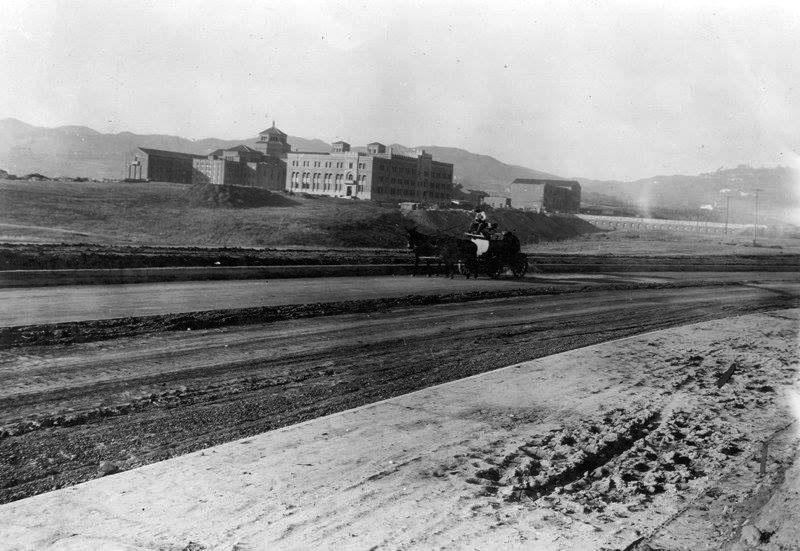 |
|
| (1928)^x^ – View looking northwest showing a mule-drawn water wagon on a dirt road (now Hilgard Ave) with the new UCLA campus in the distance. The bridge connecting Hilgard Ave to the main campus quadrangle is seen at center-right. |
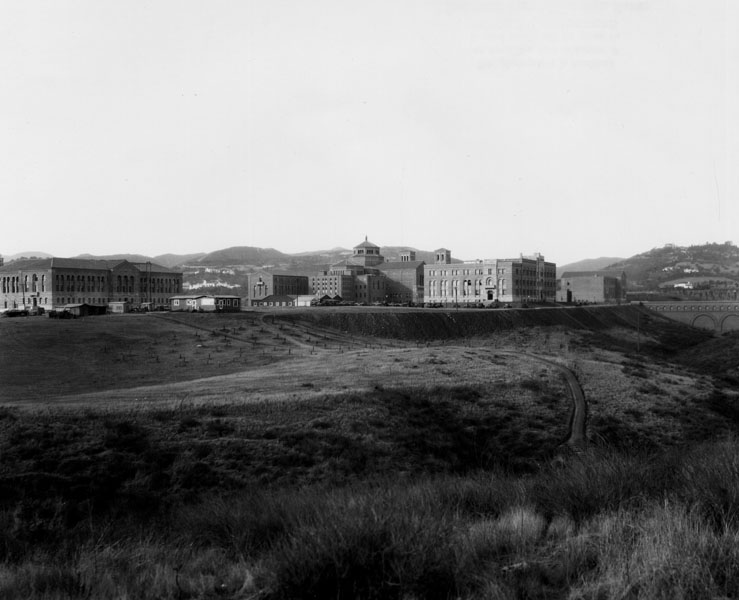 |
|
| (ca. 1928)* - Overall view of the Westwood campus buildings. On the left is Moore Hall, the Education Building, which was built in 1930. On the right is Powell Library, built in 1927-29. To the far right can be seen the bridge to Hilgard Avenue. |
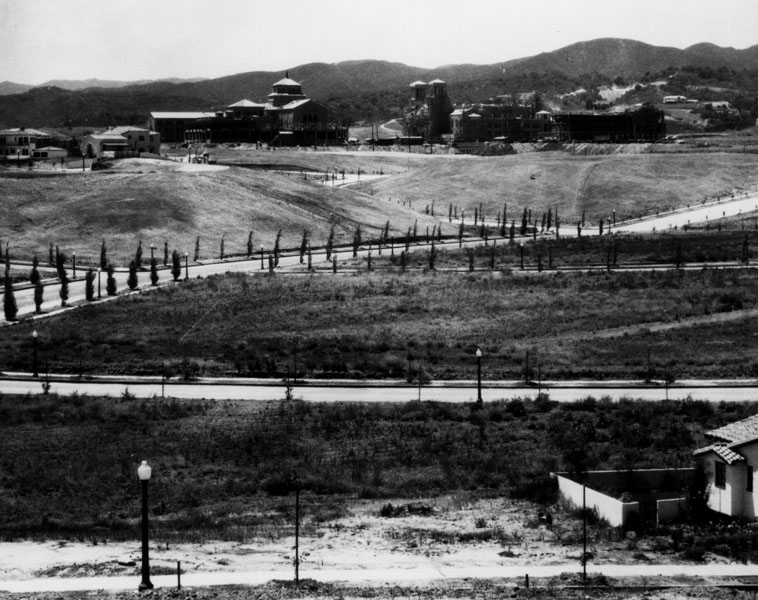 |
|
| (1928)* - View of the UCLA Westwood campus under construction, as seen from a residential area to the southeast. |
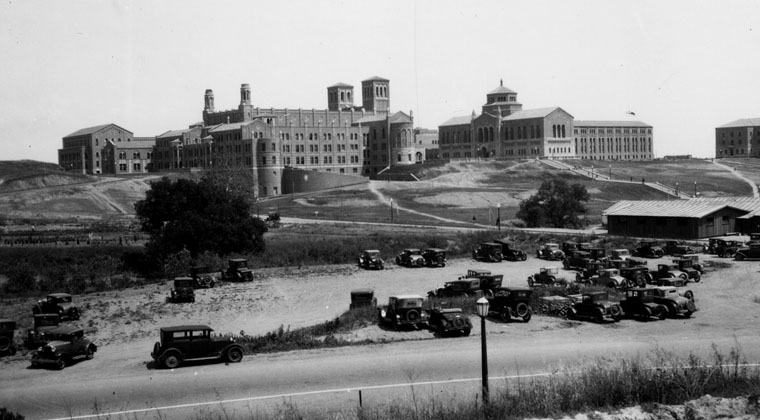 |
|
| (ca. 1929)* - Panoramic view looking southeast showing the UCLA campus. The building on the left is the backside of Royce Hall which was built in 1928-29. Building on the right is Powell Library, built in 1927-28. |
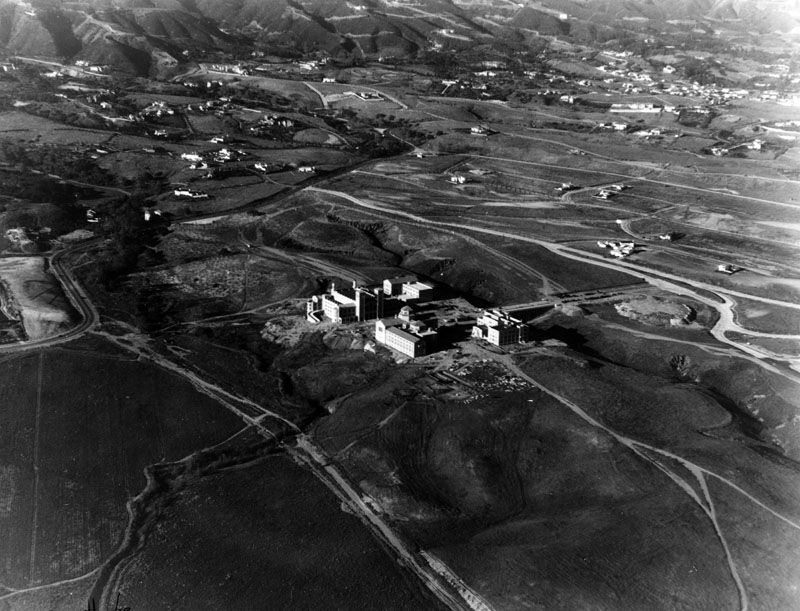 |
|
| (ca. 1929)* - Aerial view of UCLA's Westwood campus while the campus was under construction in 1929, looking from Beverly Boulevard. Buildings pictured are the original four buildings: Royce Hall, built in 1928-29 and designed by Allison and Allison, Architects; College Library (presently the Lawrence Clark Powell Library) built in 1927-29, and the Chemistry Building (presently Haines Hall) built in 1928, both designed by architect George W. Kelham; and the Physics-Biology Building (presently the Humanities Building). These four buildings, arrayed around a quadrangular courtyard on the 400-acre campus, were constructed in a northern Italian Romanesque Revival style. On the right of the buildings is the bridge, designed by architect George W. Kelham, which crosses the gully to Hilgard Avenue. The Holmby Hills/Westwood area only had a few houses at this time. |
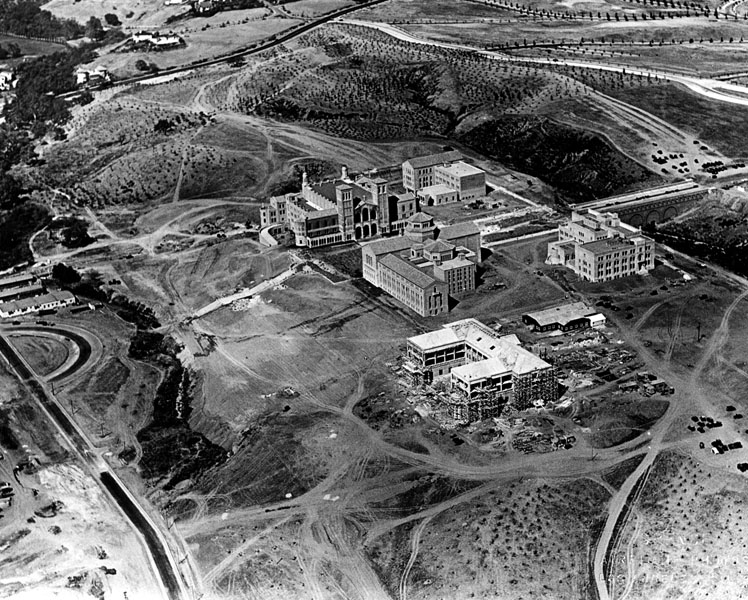 |
|
| (1929)* - Aerial view of UCLA's campus during construction, as seen from the southwest. View shows Royce Hall, left rear, the Physics building, center right, Haines Hall, right rear, Powell Library, center left, and Moore Hall (under construction), in foreground. Note the foliage northeast of the compass (upper-right). This was the nursery that grew most of the trees later used on compus. |
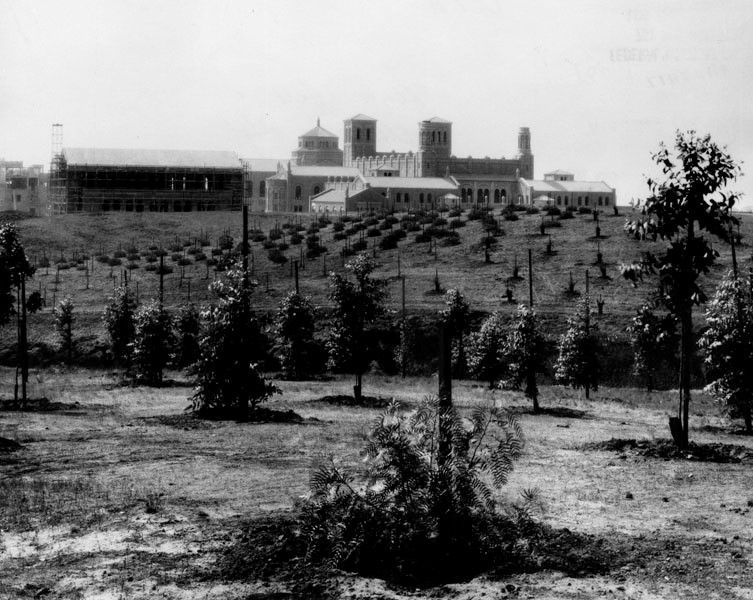 |
|
| (1929)* - View of the U.C.L.A. Westwood campus, as seen from the North Campus tree nursey. Nursery was growing the foliage which now decorates the area. In the background is Haines Hall, under construction on the left. |
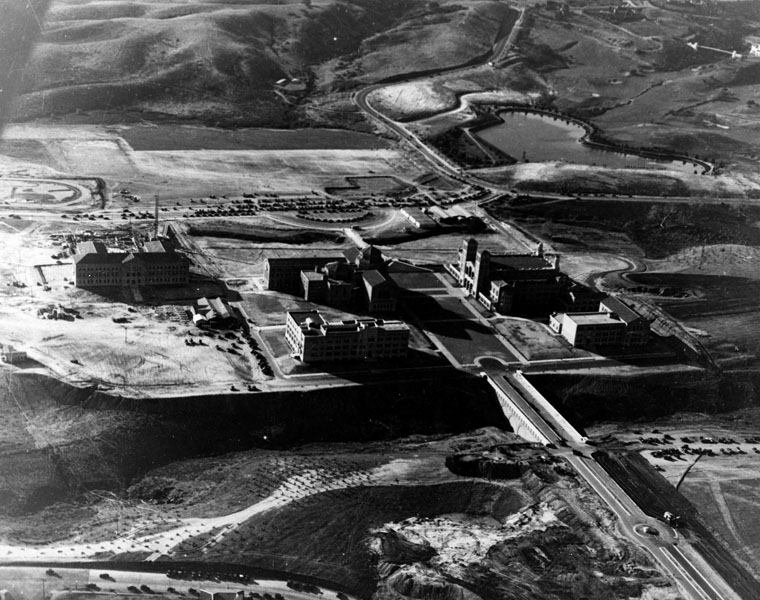 |
|
| (1929)* - An aerial view of the new UCLA Westwood campus, looking west, as construction was completed in 1929. Buildings from left to right: Moore Hall, then called the Education Building, left; Physics Building, foreground center; Powell Library, back center; Royce Hall, back right; and Haines Hall, far right. The main campus quadrangle appears at the center. In the foreground is the bridge which connected the campus to Hilgard Avenue. The gully which the bridge crossed was filled-in after World War II. |
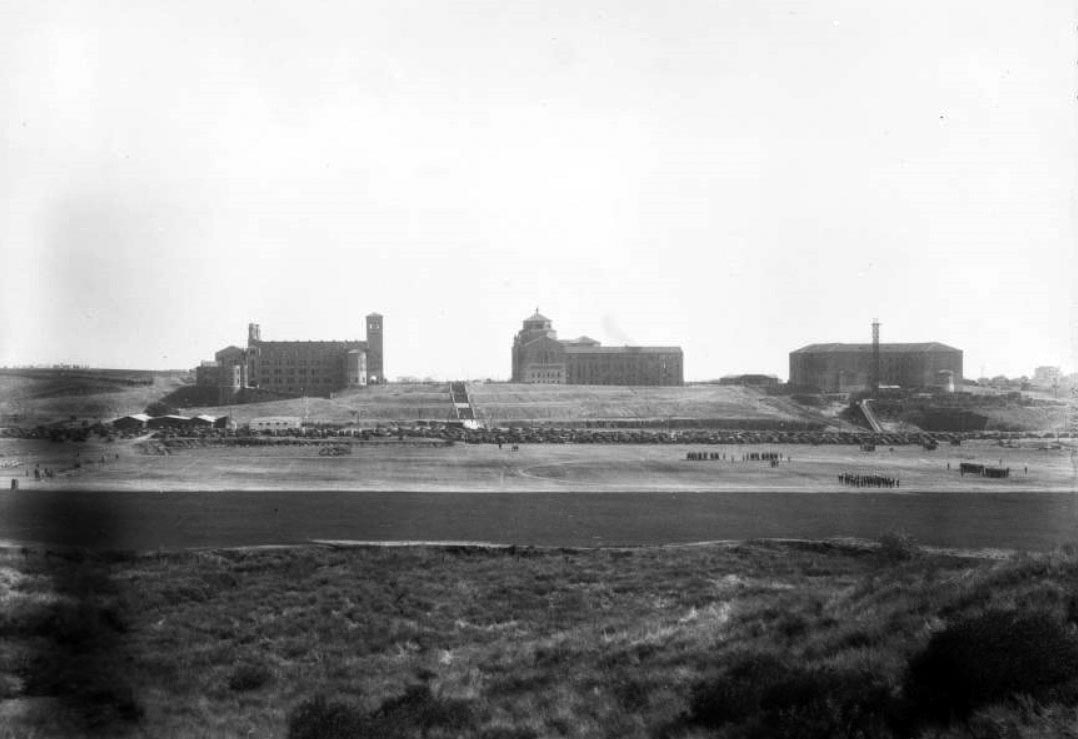 |
|
| (1929)#* – View looking east of the newly built campus of the University of California, Los Angeles (UCLA), showing the four original buildings at left, completed in 1929: Royce Hall, Powell Library, Kinsey Hall (now the Humanities Building), and Haines Hall. Another building is under construction at right. People and automobiles are also in the view. |
Janss Steps
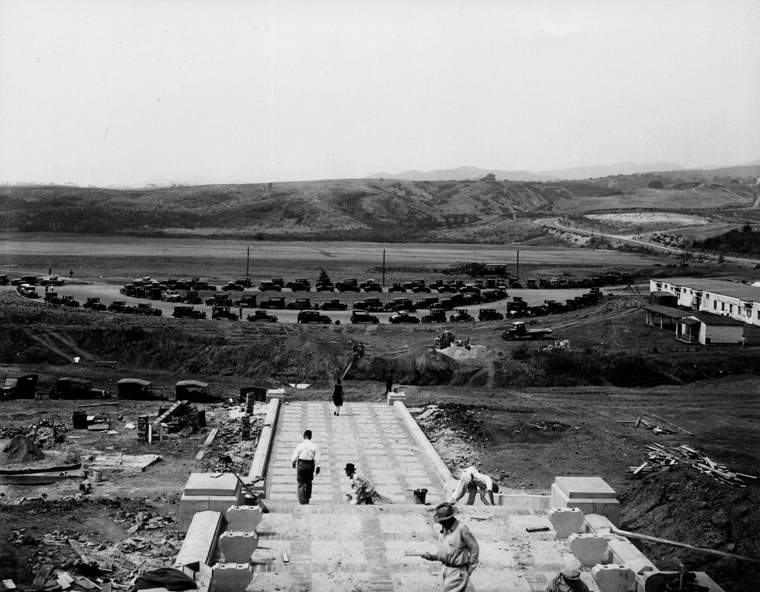 |
|
| (ca. 1928)* - View of the new UCLA Westwood campus looking west from the top of Janss Steps. Workers are seen constructing the steps. |
Historical Notes The UCLA campus's "Janss Steps" is named for two brothers, Harold and Edwin Janss of the Janss Investment Company who developed Westwood and also made it possible for UCLA to be built. The steps were donated to UCLA by the Janss brothers. |
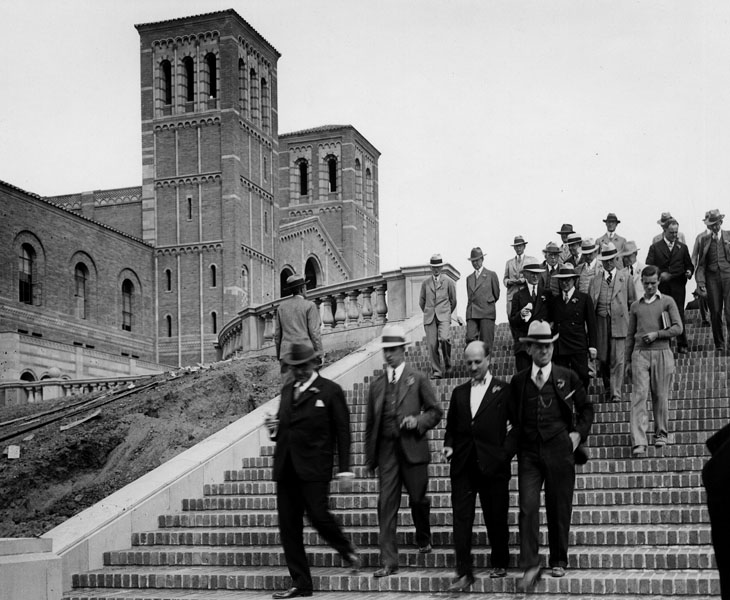 |
|
| (1929)* - Opening Day at the new UCLA campus in Westwood. A group of men are shown walking down Janss Steps, constructed in 1928-29 and designed by architect George W. Kelham. A partial view of Royce Hall is seen in the background. |
Historical Notes The Janss Steps were were constructed in 1928-29 and designed by architect George W. Kelham. |
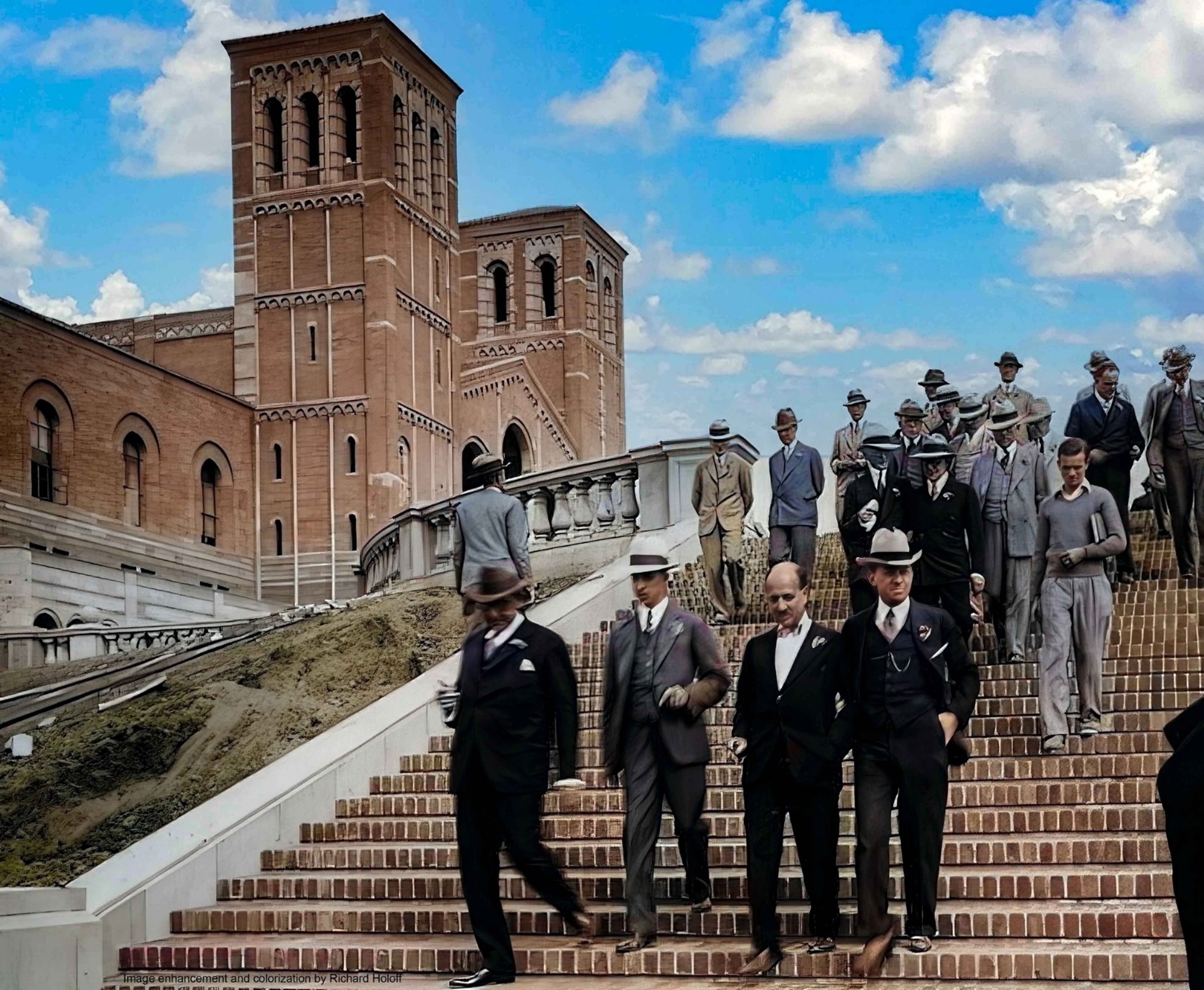 |
|
| (1929)* - Opening Day at the new UCLA campus in Westwood. A group of men are shown walking down Janss Steps, constructed in 1928-29 and designed by architect George W. Kelham. A partial view of Royce Hall is seen in the background. Image enhancement and colorization by Richard Holoff. |
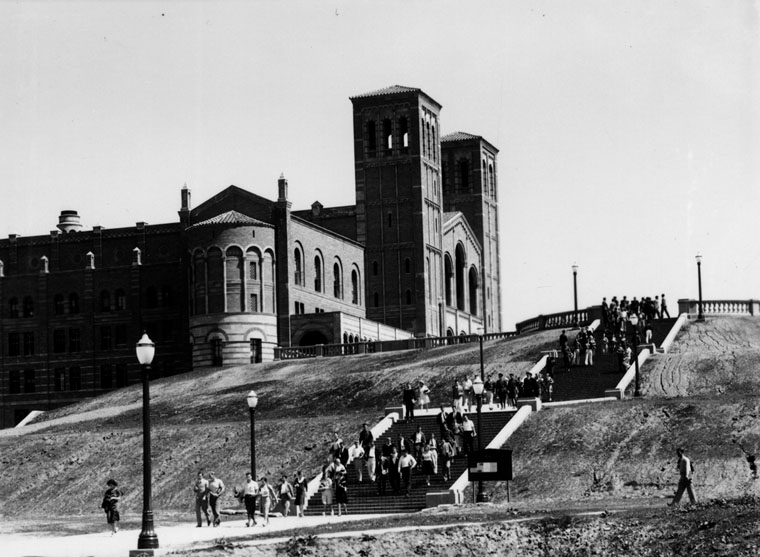 |
|
| (ca. 1929)* - View is looking northeast up Janss Steps, as the UCLA Westwood campus opens in 1929. The twin towers of Royce Hall appear in the background. Groups of people are walking down the steps. |
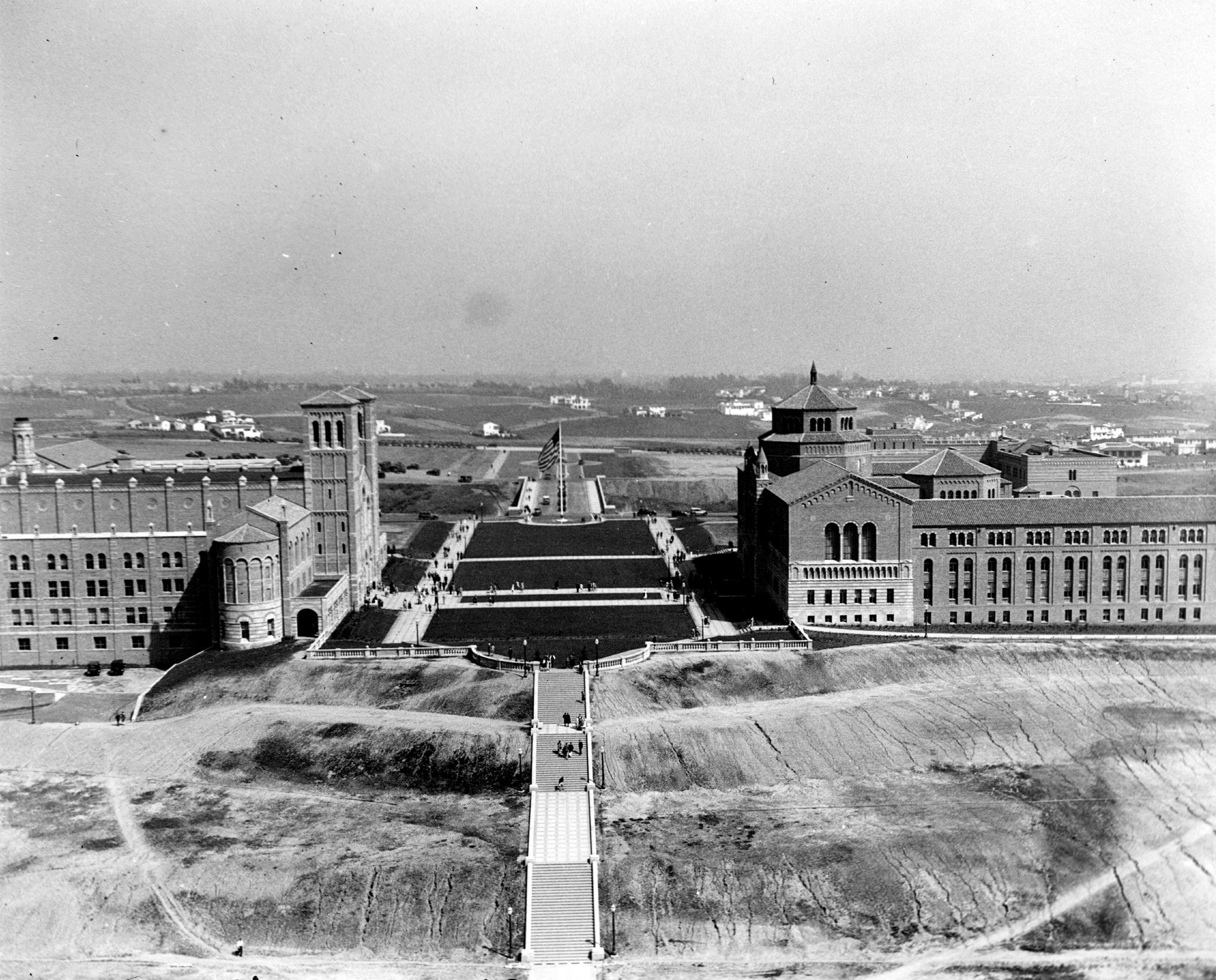 |
|
| (1930)*# - UCLA as viewed from the Goodyear blimp with the Janss Stepss seen in the foreground. |
Then and Now
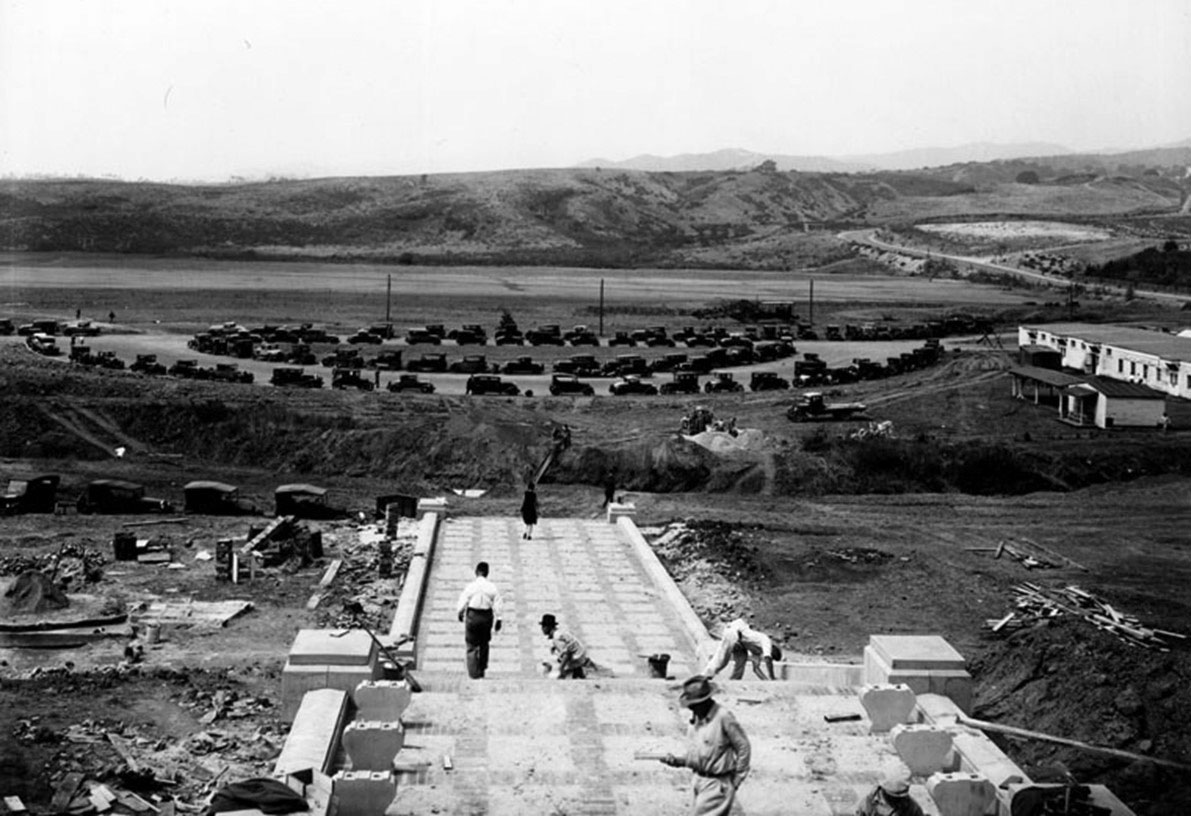 |
|
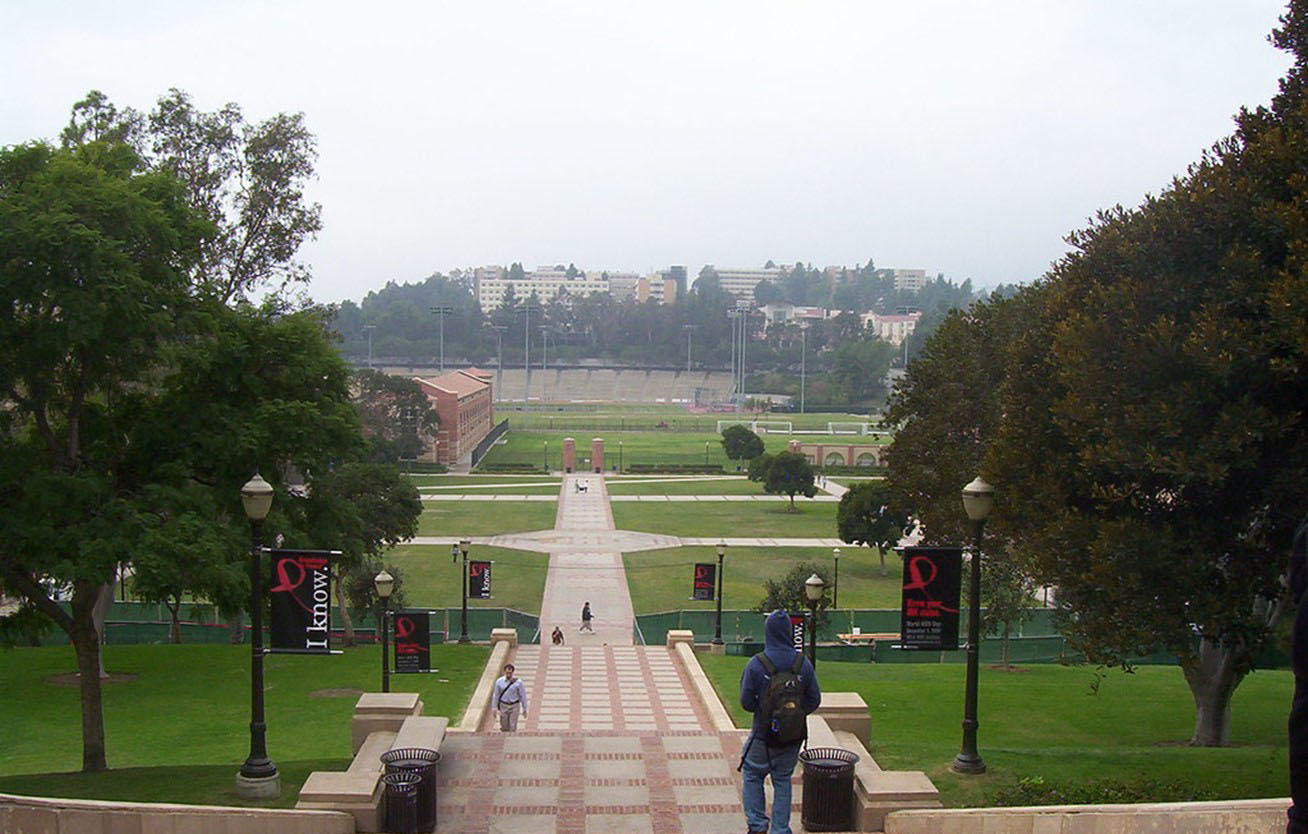 |
|
| Then and Now (1928 vs. 2007) - Janns Steps at UCLA - View looking West.^# |
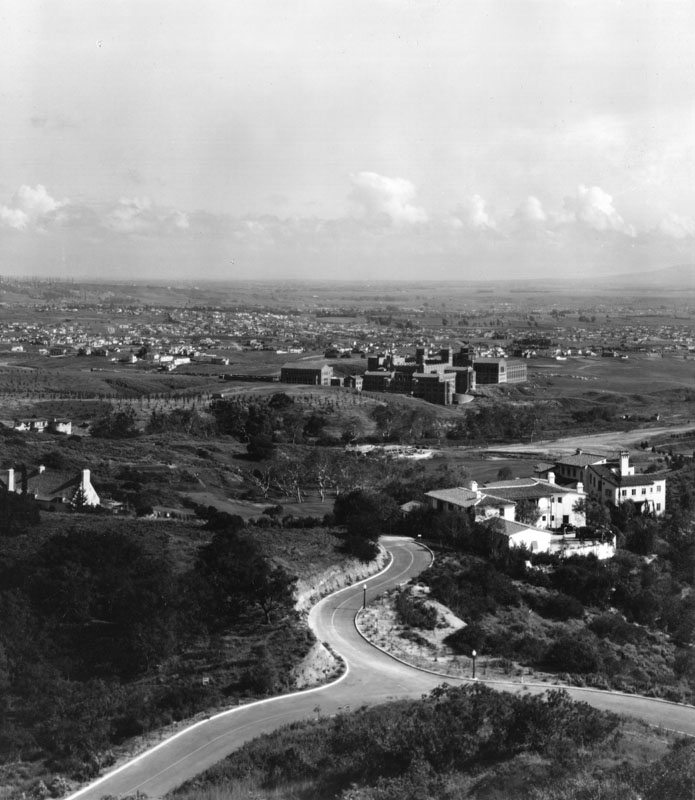 |
|
| (1929)* - Panoramic view of UCLA from Bel-Air in 1929, including Holmby Hills and Westwood. |
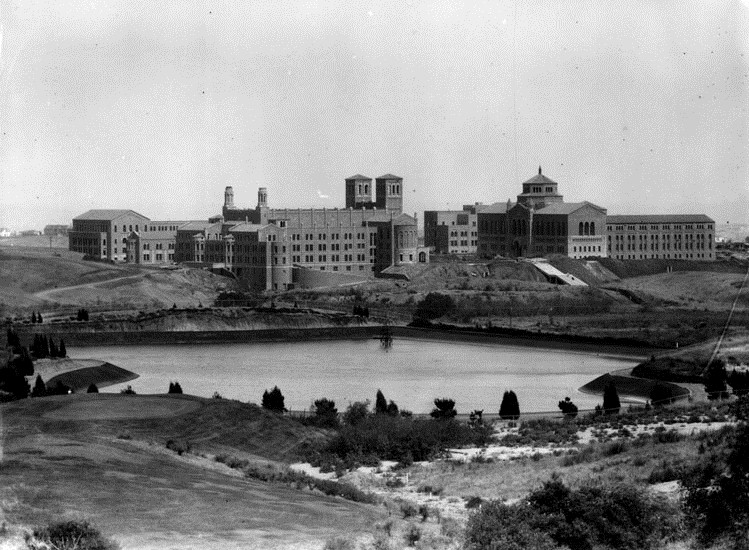 |
|
| (1929)* - View of the UCLA Westwood campus, at the time of its opening in 1929. View is looking southeast from the golf course of the Bel-Air Country Club. The body of water shown is the Sawtelle Pressure Break Reservoir. Click HERE to see more in Early LA Water Reservoirs. |
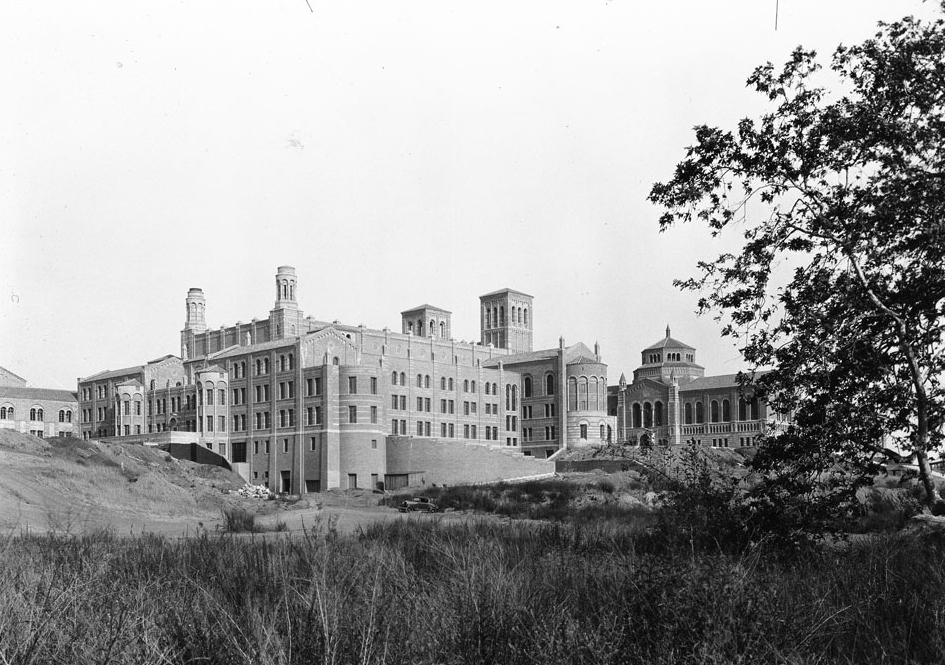 |
|
| (1929)^^ - View is looking from the northwest toward Royce Hall and Powell Library. |
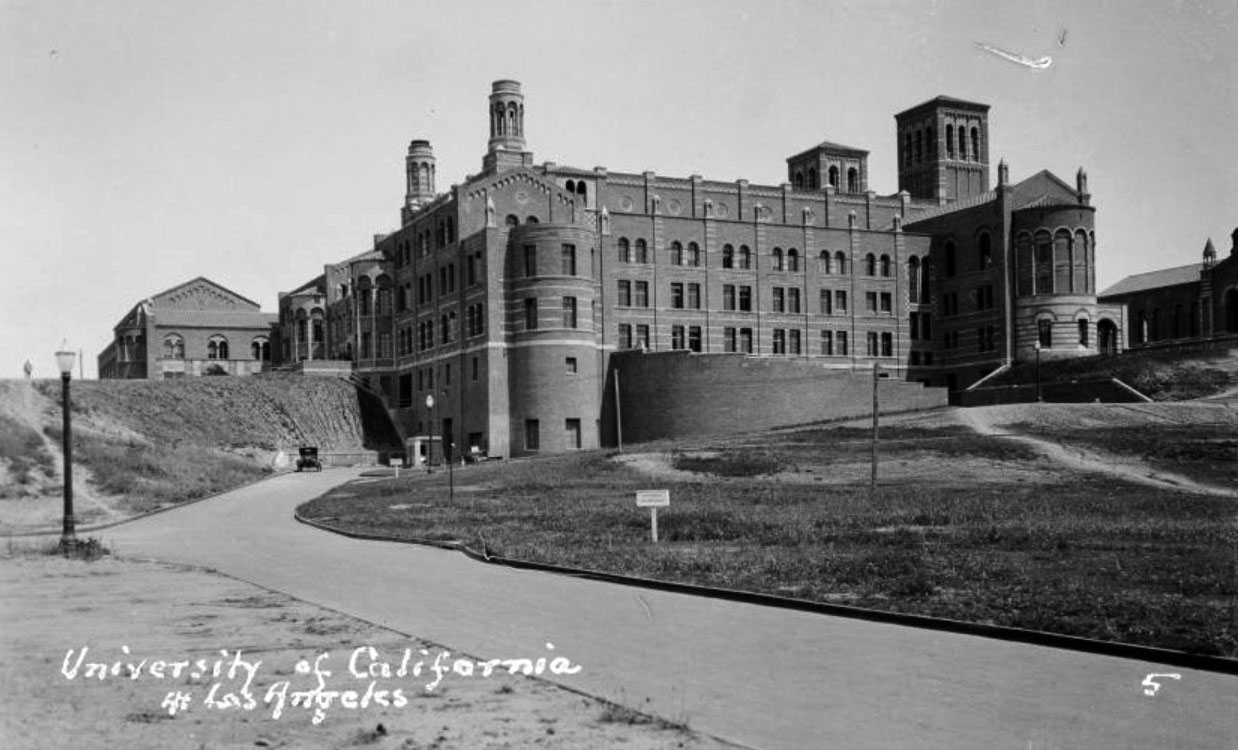 |
|
| (1929)* – Closer postcard view showing the side and back of Royce Hall, and parts of the other original buildings, completed in 1929. |
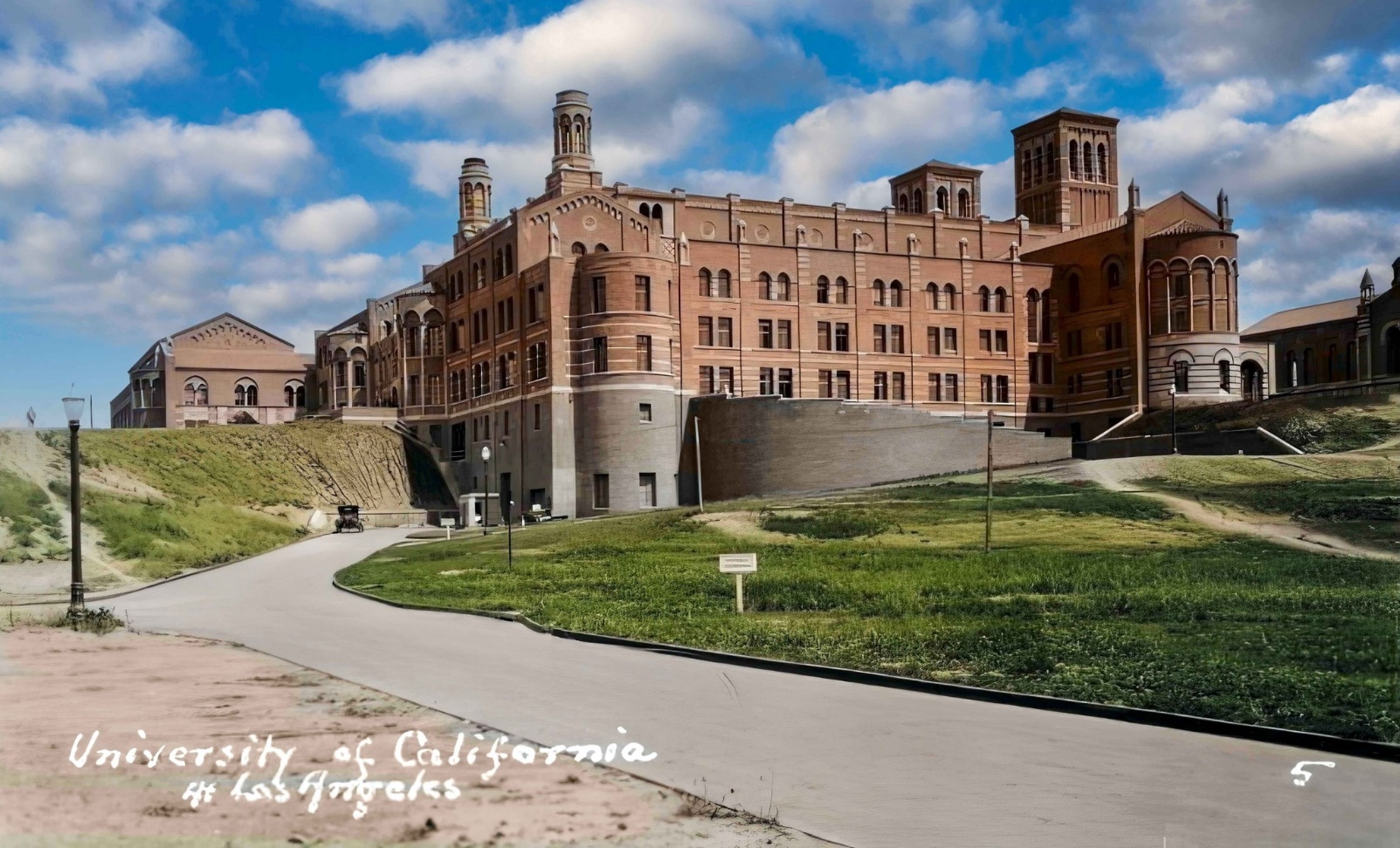 |
|
| (1929)* – Closer postcard view showing the side and back of Royce Hall, and parts of the other original buildings. Image enhancement & colorization by Richard Holoff. |
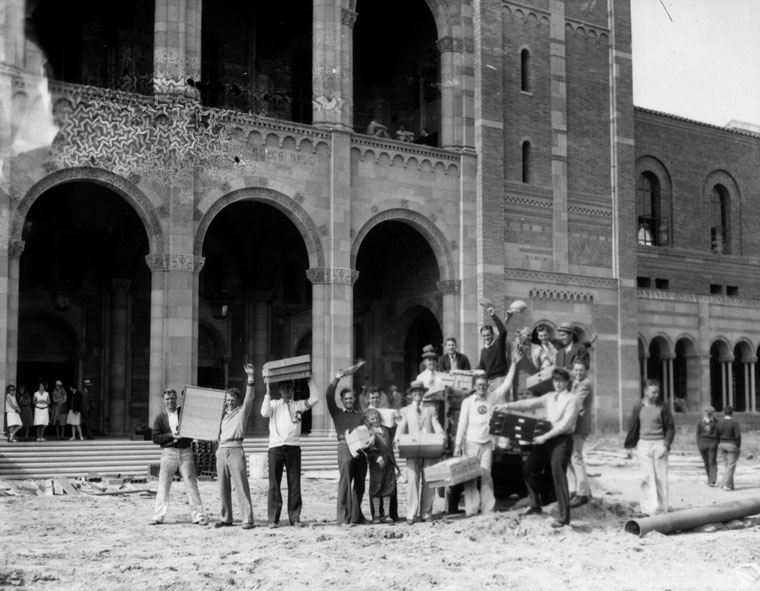 |
|
| (1929)* - Moving Day, from UCLA's Vermont Avenue campus to the new Westwood site, on May 31, 1929. A group of workers and student helpers are shown standing outside of Royce Hall. |
Opening Day
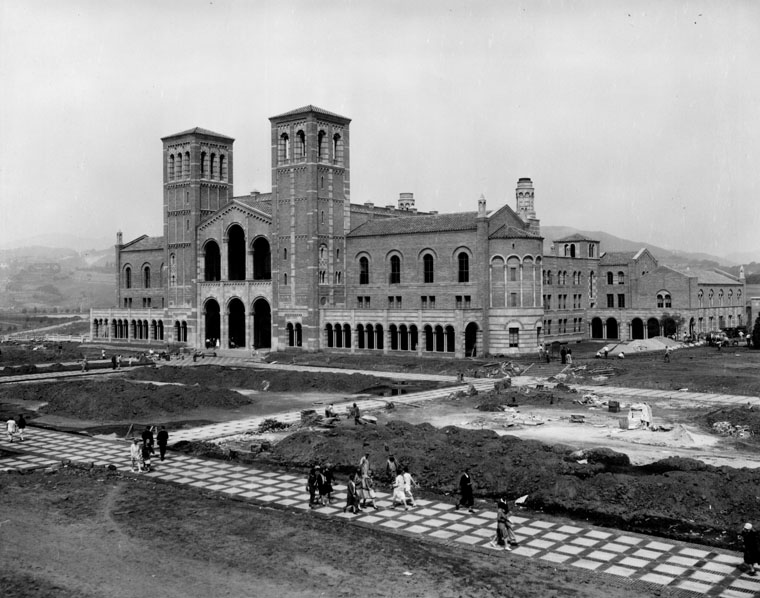 |
|
| (1929)* - Opening Day on the new UCLA Westwood campus, September 20, 1929. Construction activity continued while classes began. The area shown is the original campus quadrangle. View above shows students walking along the pathway. Royce Hall is just barely complete. |
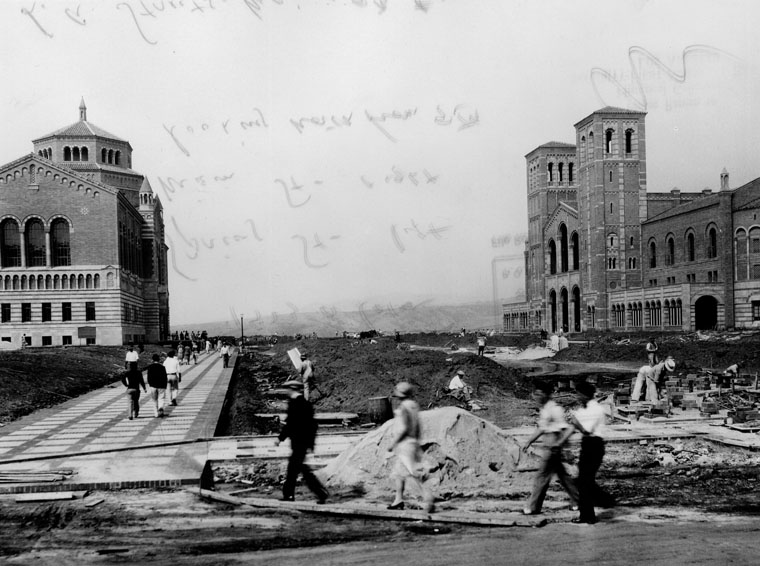 |
|
| (1929)* - Opening Day at the new UCLA Westwood campus, September 20, 1929. Students are registering for classes amid hectic construction activity. The view is looking west across the main campus quadrangle, with Powell Library on the left, and Royce Hall on the right. |
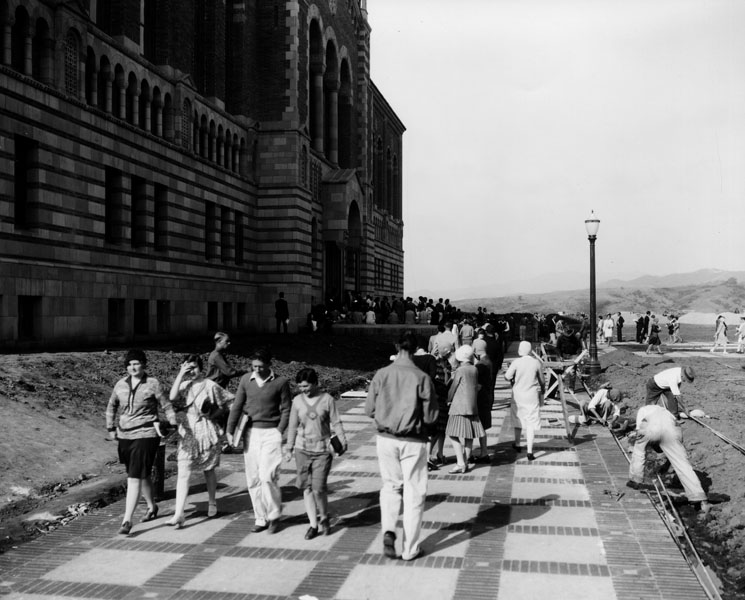 |
|
| (1929)* - View looking west showing both students and construction workers in front of the Powell Library on Opening Day. |
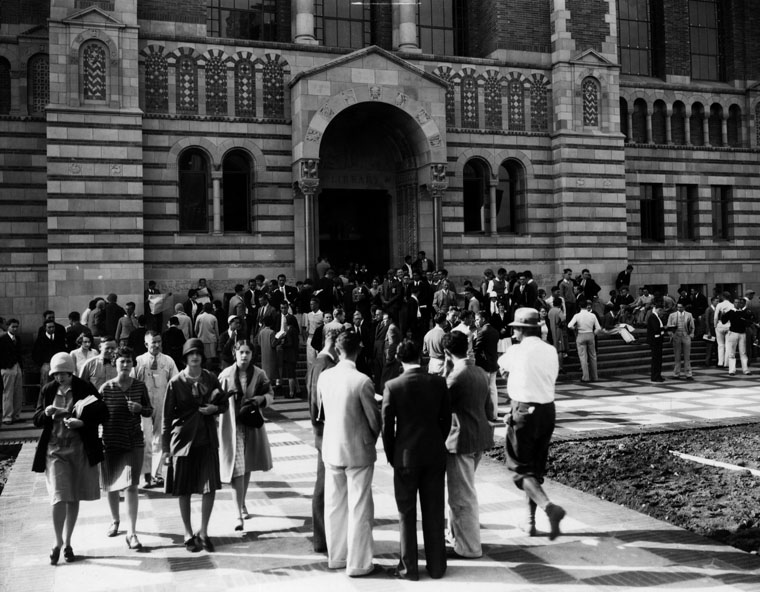 |
|
| (1929)* - Opening Day at the new UCLA campus. Students are dressed in the latest styles. |
Royce Hall
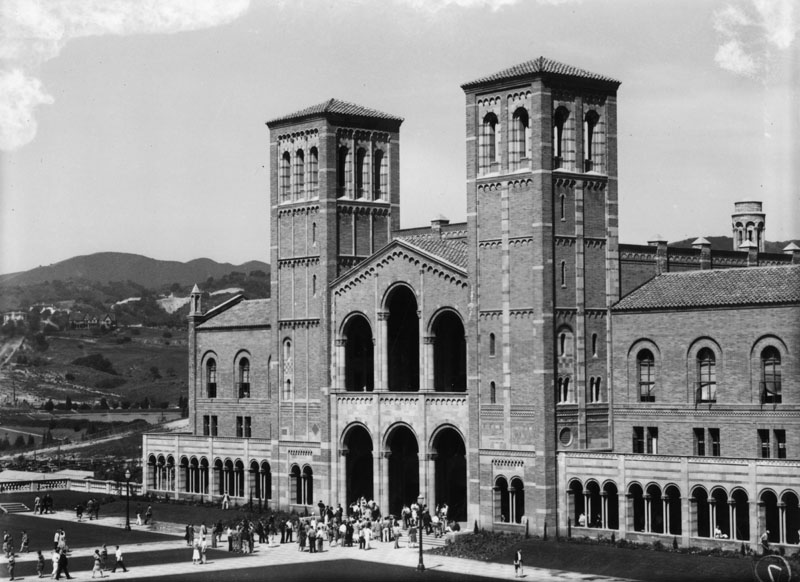 |
|
| (1929)* - Royce Hall, at the time that the UCLA Westwood campus opened in 1929. View shows the twin towers on either side of the entrance to Royce Hall. A group gathers on the steps, outside the building. |
Historical Notes Royce Hall was built in 1928-29 and designed by Allison and Allison, Architects. It was constructed in a northern Italian Romanesque Revival style, inspired by Sant' Ambrogio in Milan (12th century). It is one of the four original buildings on UCLA's Westwood campus and has come to be the defining image of the university. |
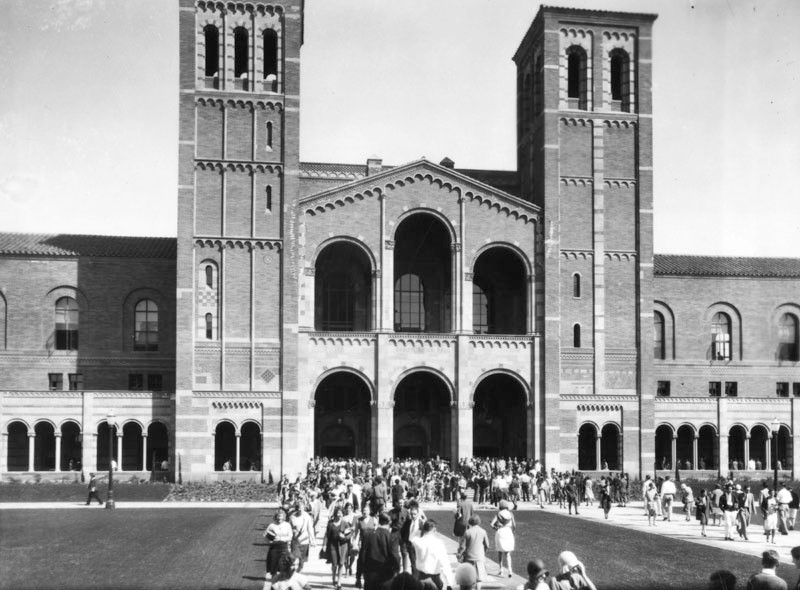 |
|
| (1929)* – Students are seen walking between Royce Hall and the Powell Library |
Historical Notes The brick and tile building is in the Lombard Romanesque style, and once functioned as the main classroom facility of the university. Today, Royce Hall’s twin-towered front remains the best known UCLA landmark. Royce Hall was named after Josiah Royce, a California-born philosopher who received his bachelor's degree from UC Berkeley in 1875.*^ |
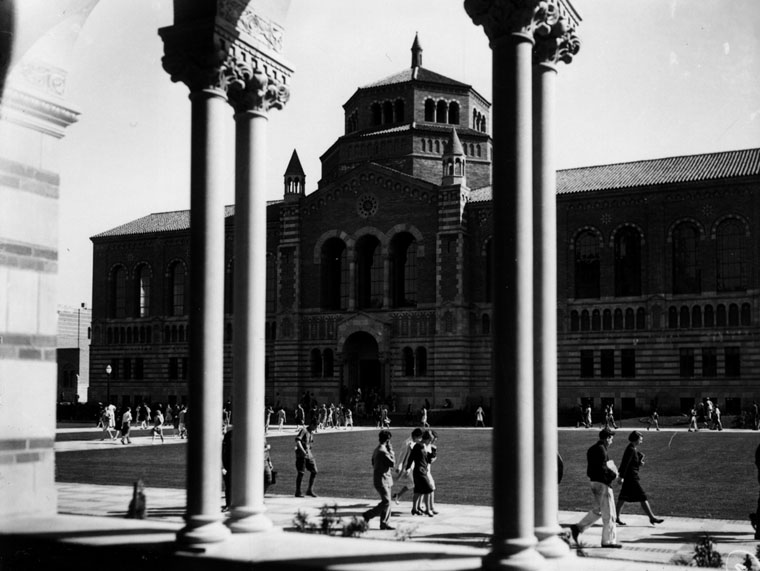 |
|
| (1929)*- Exterior view of Powell Library as seen through the arches of Royce Hall. |
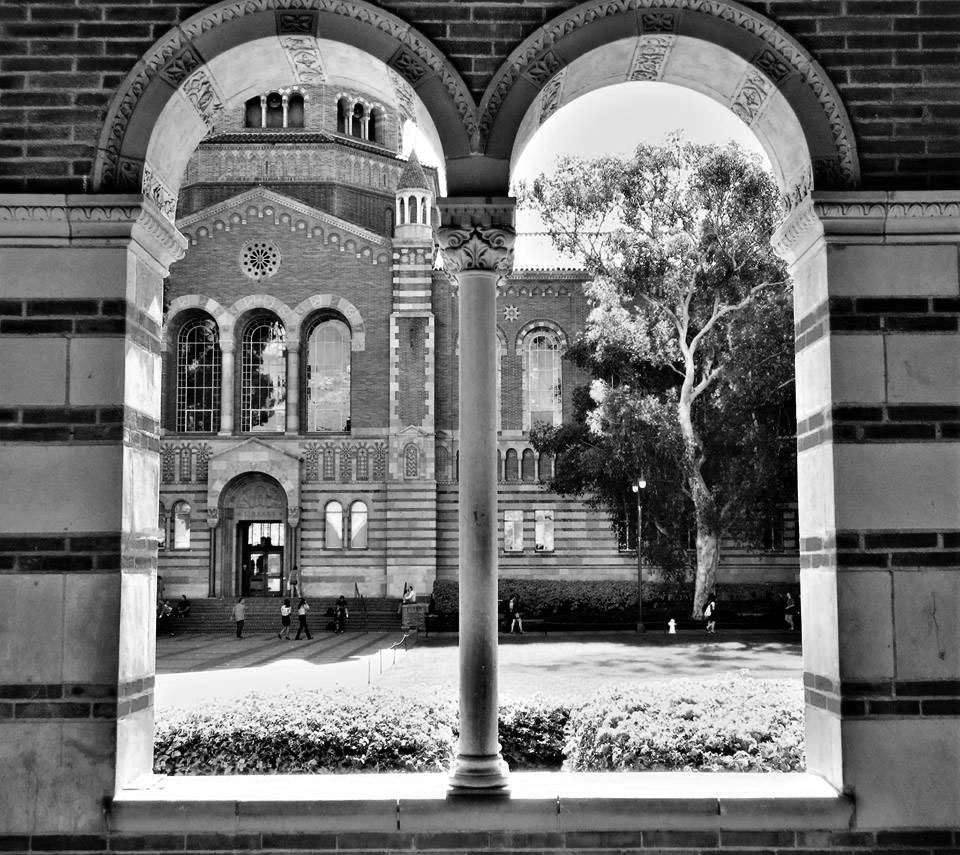 |
|
| (2018)^.^ - Contemporary view showing Powell Library as seen through the Royce Hall arches. Photo by Howard Gray |
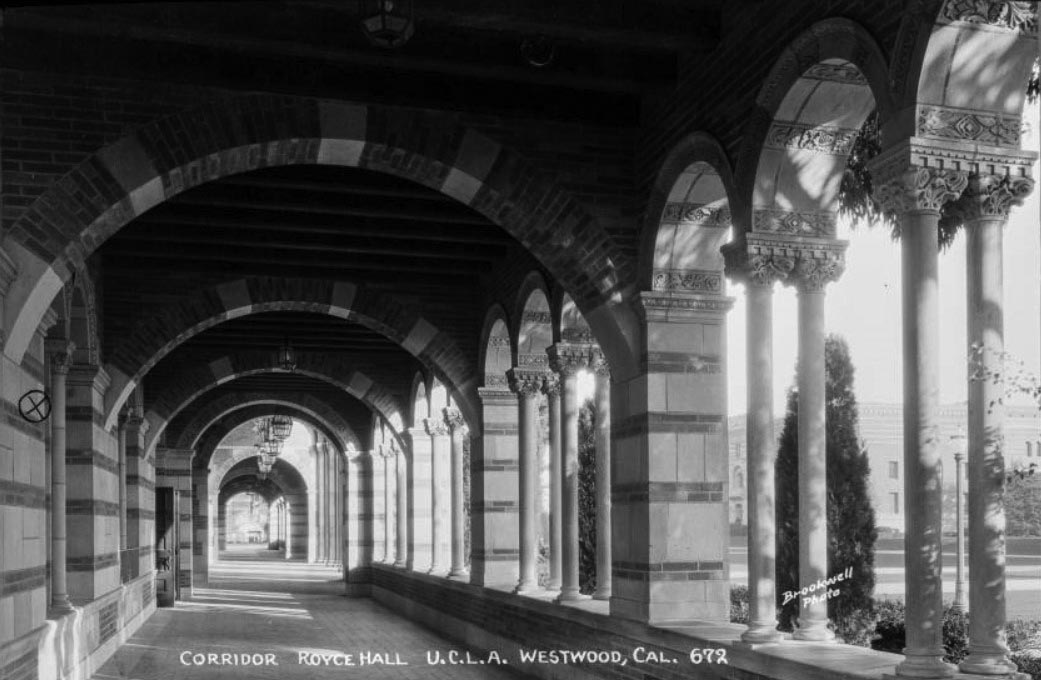 |
|
| (1930s)#* – Postcard view showing the corridor of Royce Hall on the campus of the University of California, Los Angeles (UCLA). |
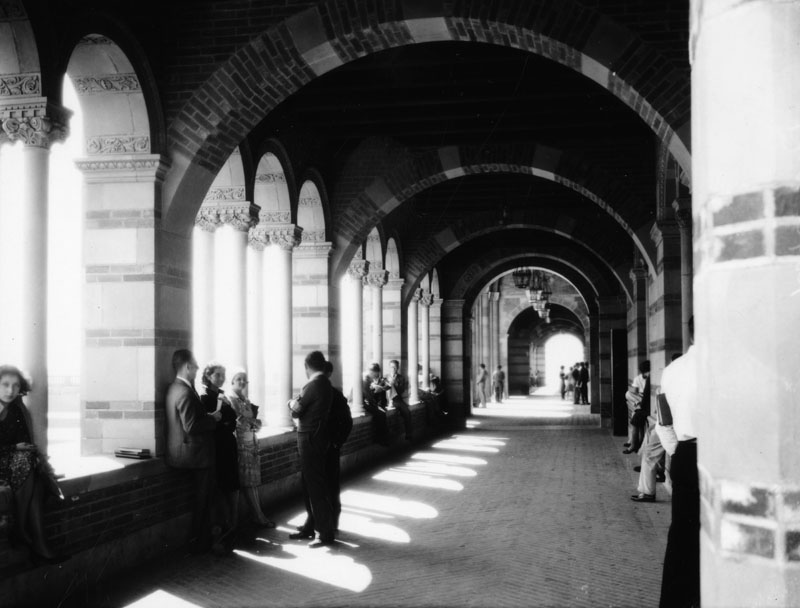 |
|
| (1929)* - Looking down the outside hallway of Royce Hall, small groups of students are seen standing, while others are seated on ledges beneath the arches. |
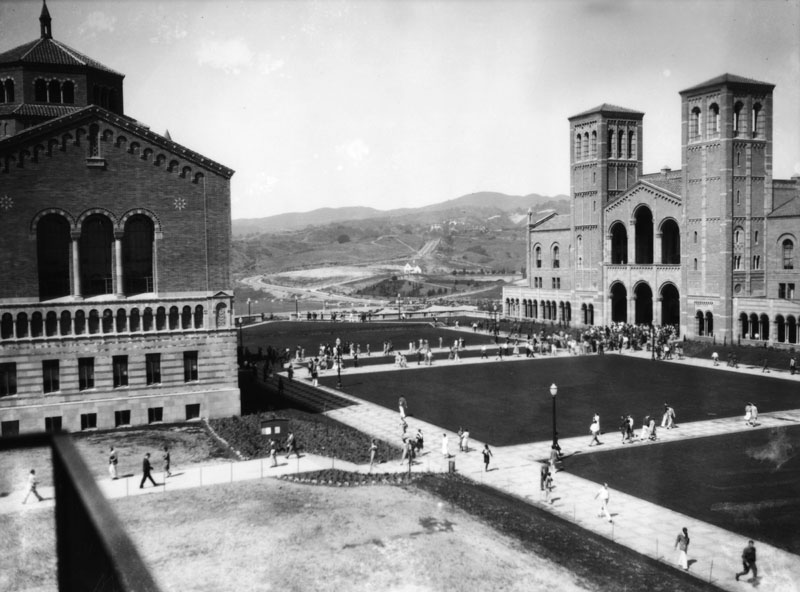 |
|
| (1929)* - Overall view looking across the quadrangle towards the twin towers of Royce Hall with Powell Library to the left. |
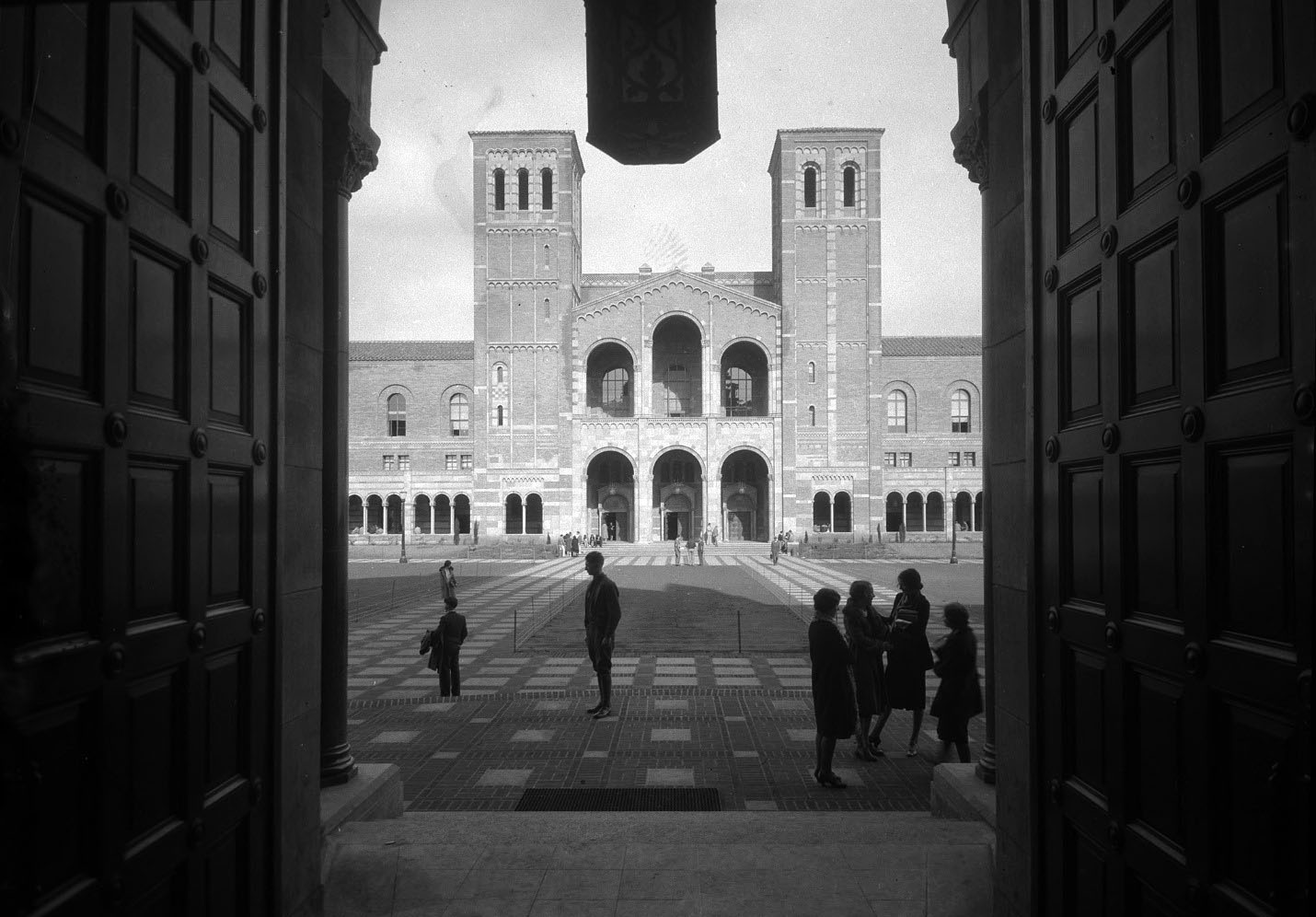 |
|
| (1930)^.^ – View looking out the front doors of Powell Library towards Royce Hall. Photo by Adelbert Bartlett |
Powell Library
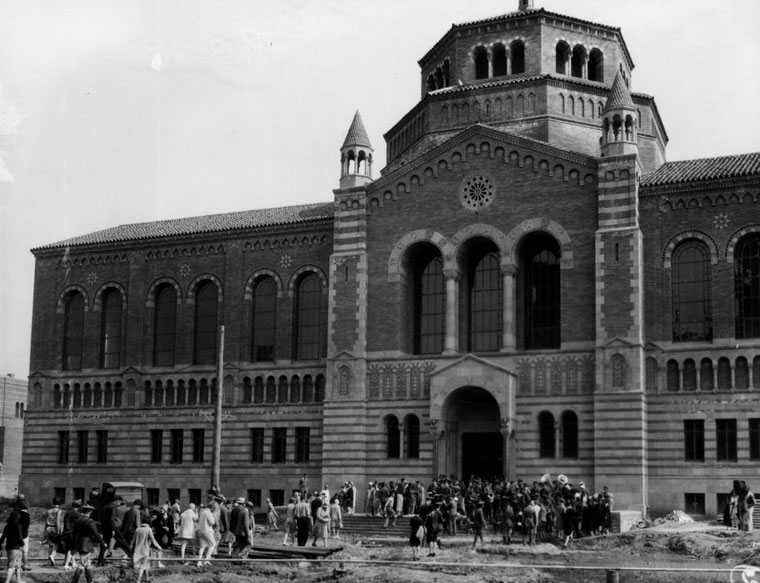 |
|
| (1929)* - Exterior view of Powell Library at the UCLA Westwood campus. Students are seen walking to and from the library, amid the construction activity. |
Historical Notes Powell Library (originally called College Library) is named for Lawrence Clark Powell, the University Librarian at UCLA from 1944 to 1961 and Dean of the Graduate School of Library Service from 1960 to 1966. Like the building facing it across the quad, Royce Hall, the building's exterior is modeled after Milan's Basilica of Sant'Ambrogio.*^ |
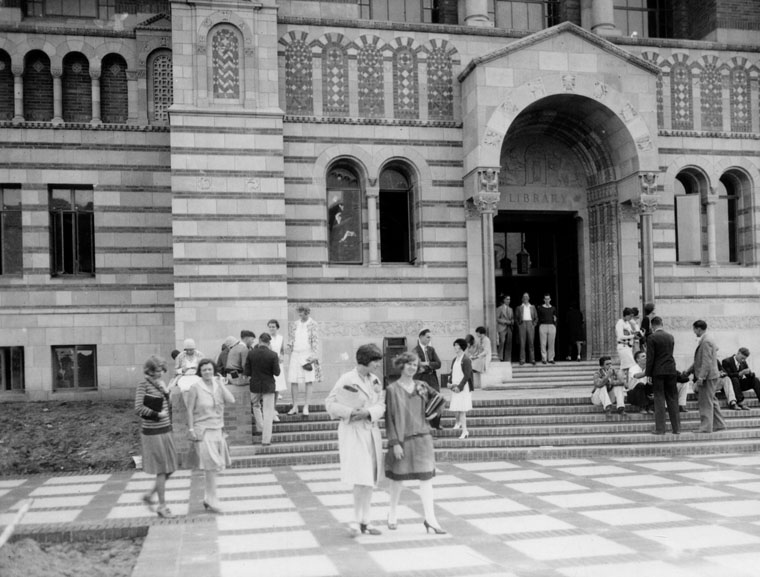 |
|
| (1929)* - Close-up view showing the front of Powell Library. Three young men are seen standing inside the main entrance of the building. Other students are shown on the left side and sitting on the steps in front of the library. |
Historical Notes The entrance of the library is adorned with several mosaics, one of which depicts two men holding a book bearing the phrase, from Cicero's Pro Archia Poeta, "Haec studia adulescentiam alunt, senectutem oblectant". This loosely translates as "Studying in youth sustains delight into old age", an appropriate dictum for the vast collection for undergraduate students.*^ |
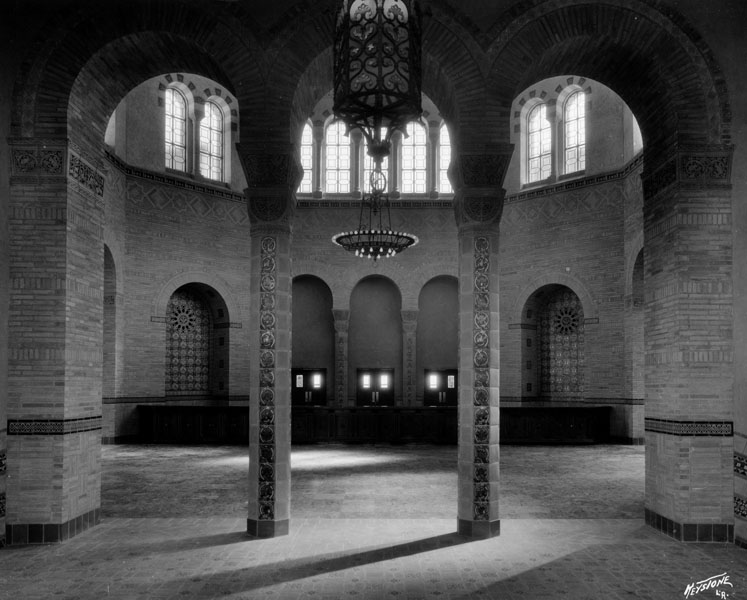 |
|
| (1930)* - Interior view of the rotunda at Powell Library, at UCLA Building was built 1927-29 in a Italian (Lombard) Romanesque Revival style. |
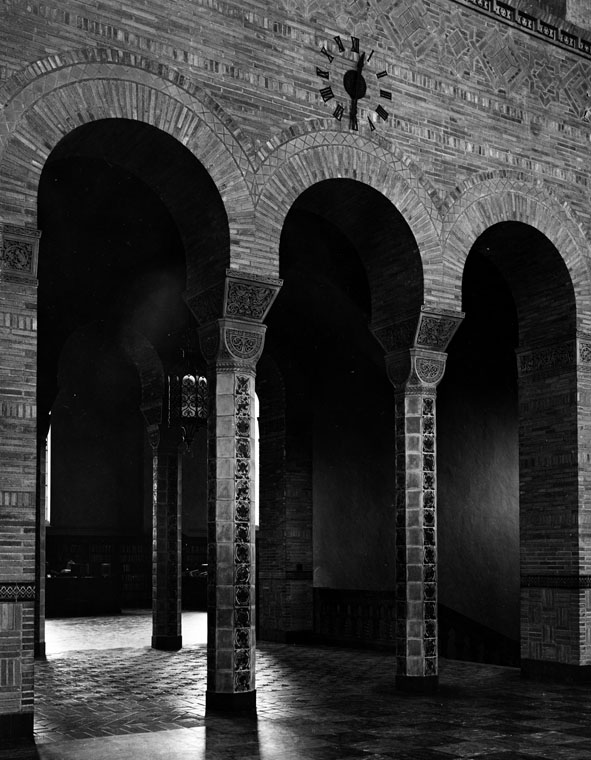 |
|
| (ca. 1930)* - Interior view of Powell Library showing the intricate designs on the pillars and arches of the stair court and rotunda. |
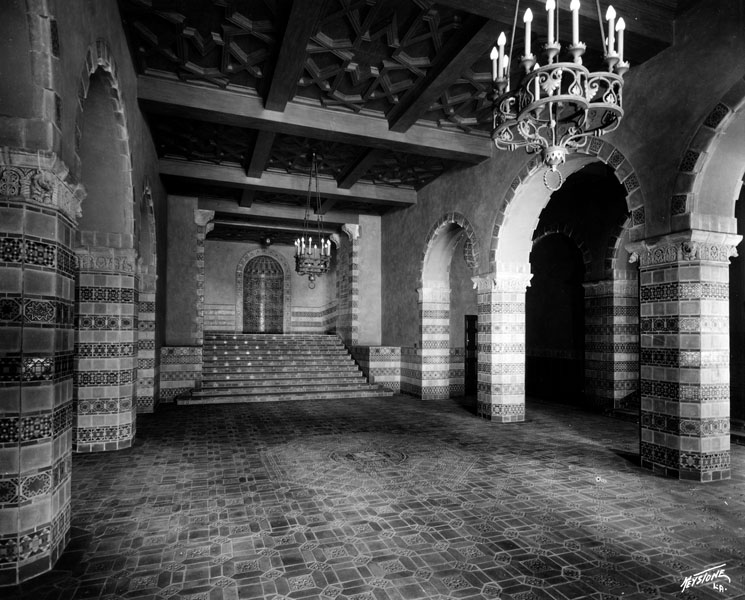 |
|
| (1930)* - Interior view of the Library Building at the new UCLA campus showing detailed tile and brick work. The building was later named the Lawrence Clark Powell Library. |
Historical Notes The great amount of skilled hand work needed for the detailed tile and brick work of the Lombard style of architecture made it impossible to continue in the same architectural tradition when costs rose after World War II. The above view shows the interior of the main lobby and stairs to the reading room at the Powell Library.* |
.jpg) |
|
| (1930)* - Interior view showing the main study hall at the new UCLA library. |
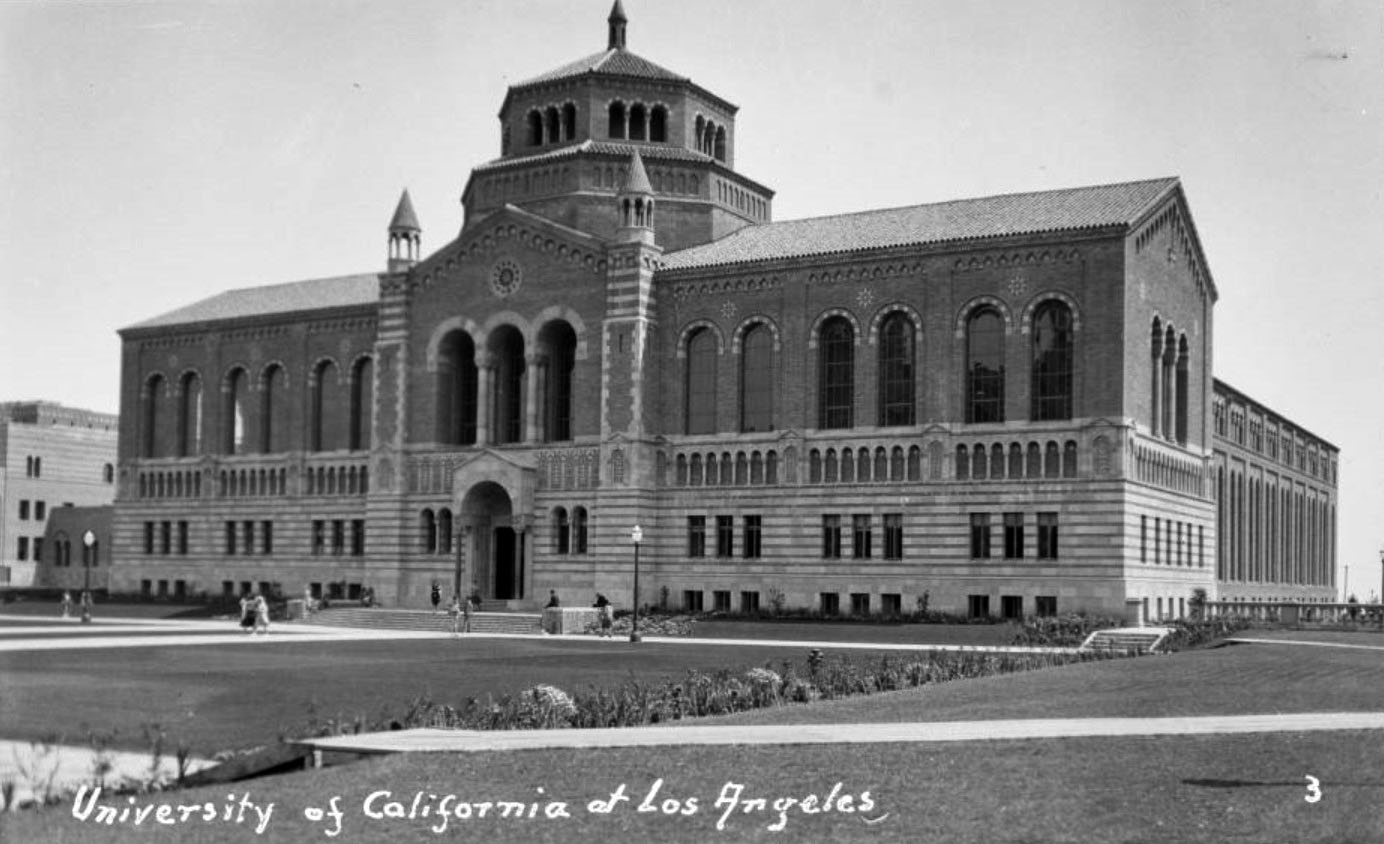 |
|
| (ca. 1930)#* – Postcard view showing people, walkways, and lawn of the quad in front of Powell Library on the campus of the University of California, Los Angeles (UCLA). |
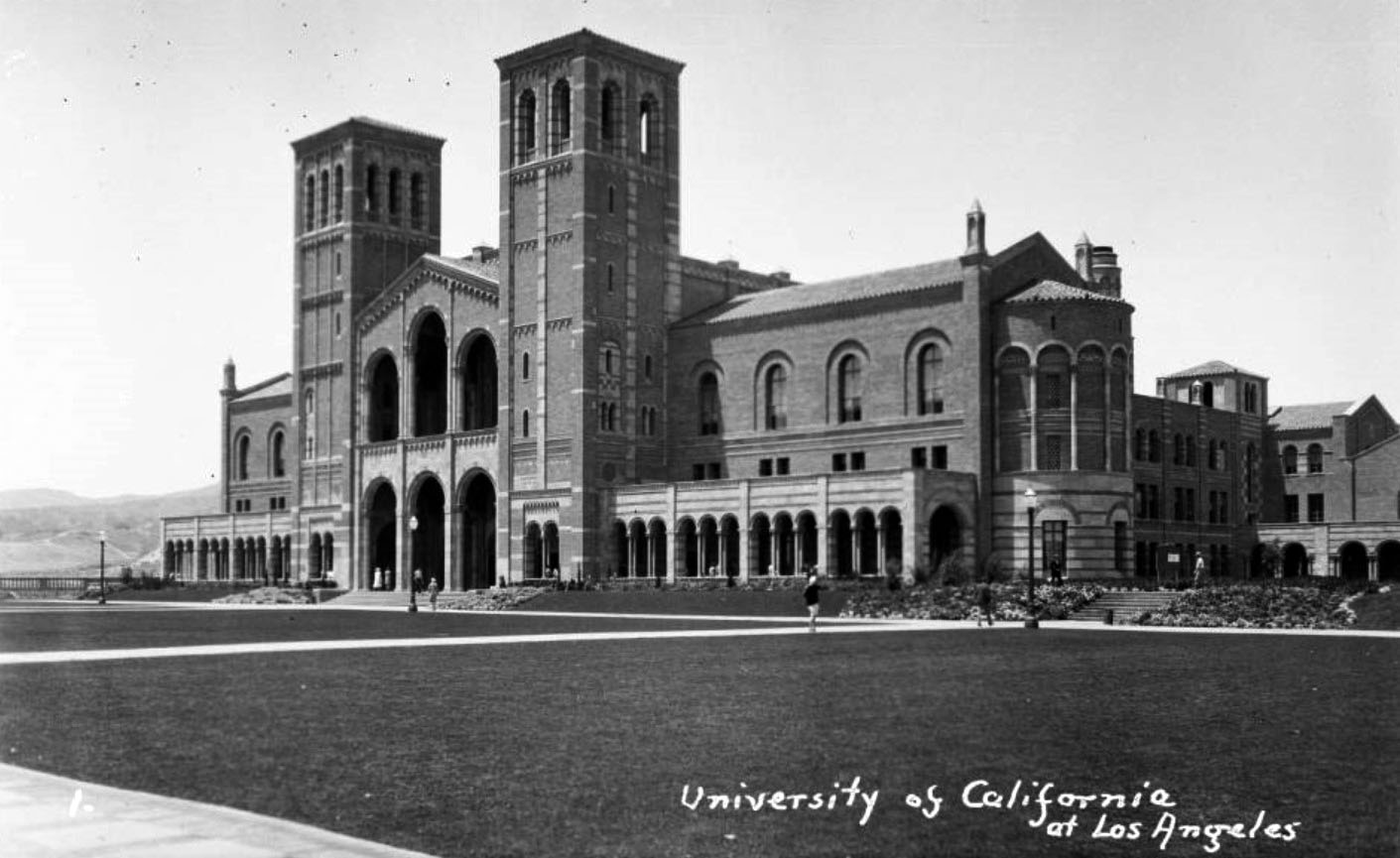 |
|
| (ca. 1930)#* – Postcard view showing the front of Royce Hall and lawn of the quad on the campus of the University of California, Los Angeles (UCLA). |
Historical Notes Royce Hall’s first performing arts season was 1937. The first subscription series included the great contralto Marian Anderson, the Budapest String Quartet and the Los Angeles Philharmonic. Also appearing at Royce Hall that year were Jimmy Dorsey’s Band and the Los Angeles Philharmonic conducted by famed conductor Otto Klemperer. A year later in 1937, Duke Ellington’s Orchestra and avant-garde composer Arnold Schoenberg made appearances. Luminaries who have appeared on its stage include musicians George Gershwin, Leonard Bernstein, and Ella Fitzgerald, and speakers Albert Einstein and John F. Kennedy.*^ |
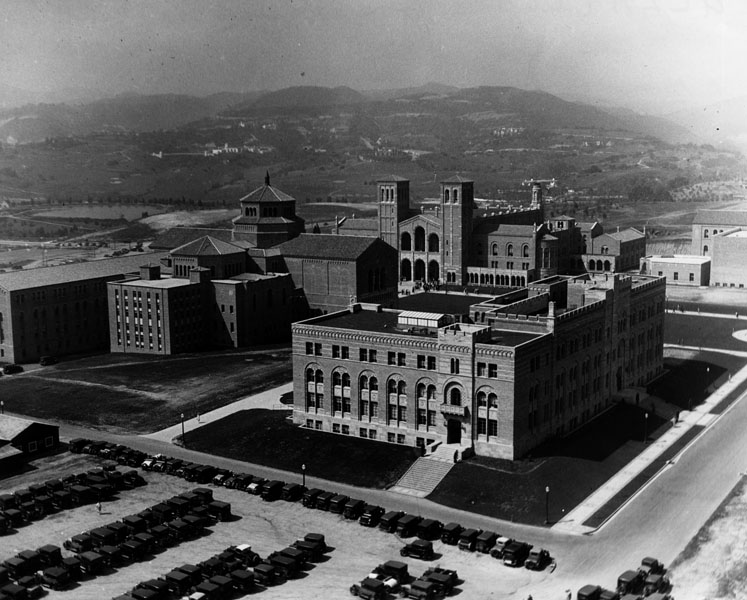 |
|
| (1930)* - Aerial view looking north at the UCLA campus, as seen from the Goodyear Blimp. Buildings from left to right: Powell Library, Royce Hall and the Physics building. |
Historical Notes During the 1930s several other buildings were added to the cluster around the main quadrangle--the Education Building, Kerckhoff Hall, the Men's Gymnasium, the Women's Gymnasium, Mira Hershey Hall, and the Administration Building.** |
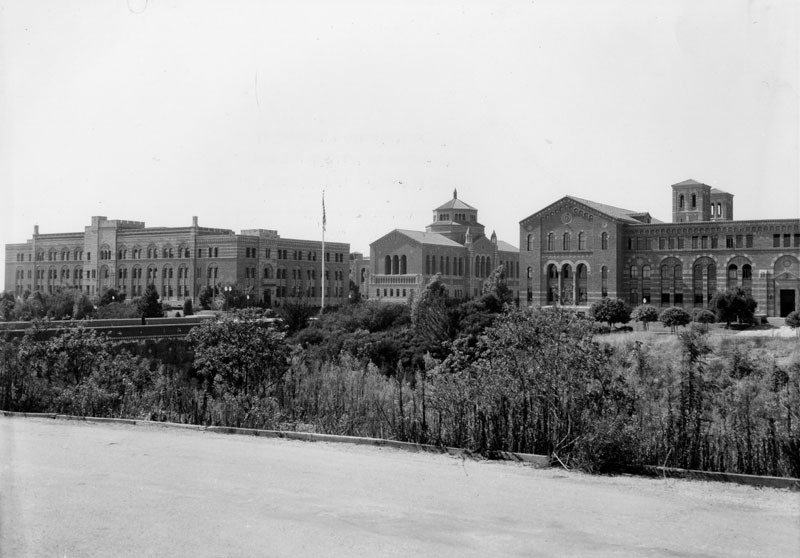 |
|
| (ca. 1930)* - View of several campus buildings at UCLA, as seen from across the ravine (in foreground) now Dickson Court. Buildings from left to right are: Physics Building, Powell Library, and Haines Hall. |
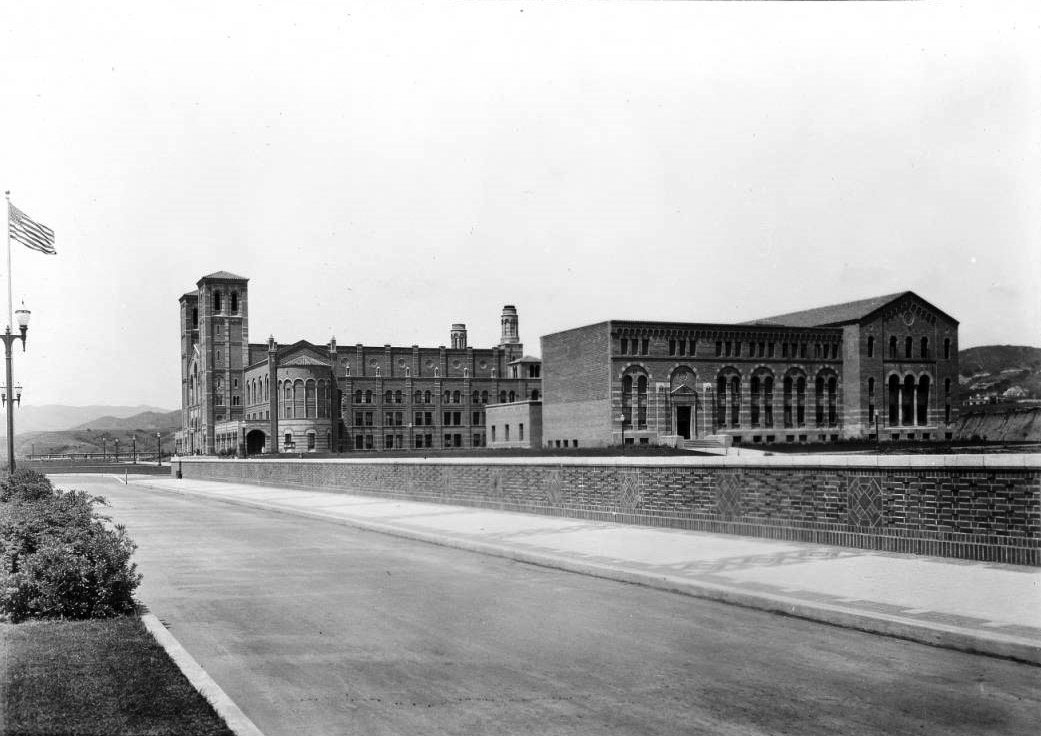 |
|
| (1930)^^ - View of Royce Hall and Haines Hall at the University of California, Los Angeles, April 24, 1930, as seen from the Arroyo Bridge. To the left is the bridge's center median. |
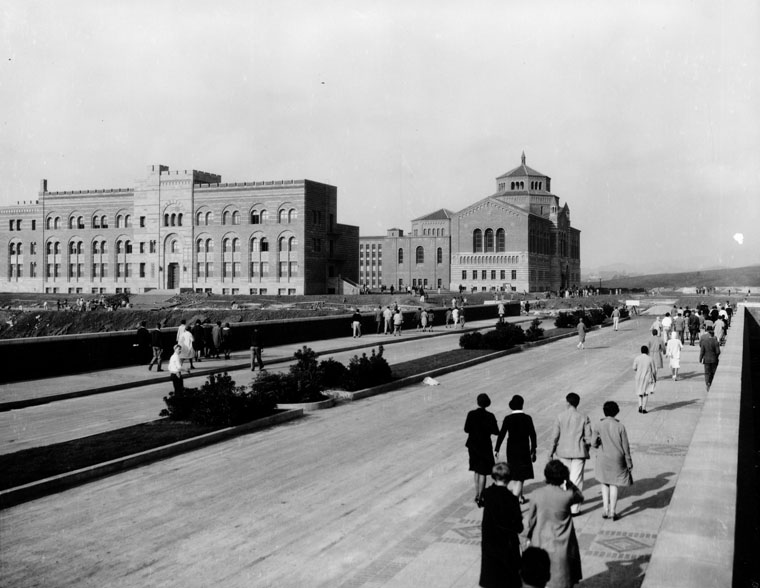 |
|
| (ca. 1930)* - View shows UCLA students crossing the Arroyo Bridge from Hilgard Avenue to the campus. The gully which the bridge crossed, was filled in after World War II. |
UCLA is Formally Dedicated (March 27 and 28, 1930)
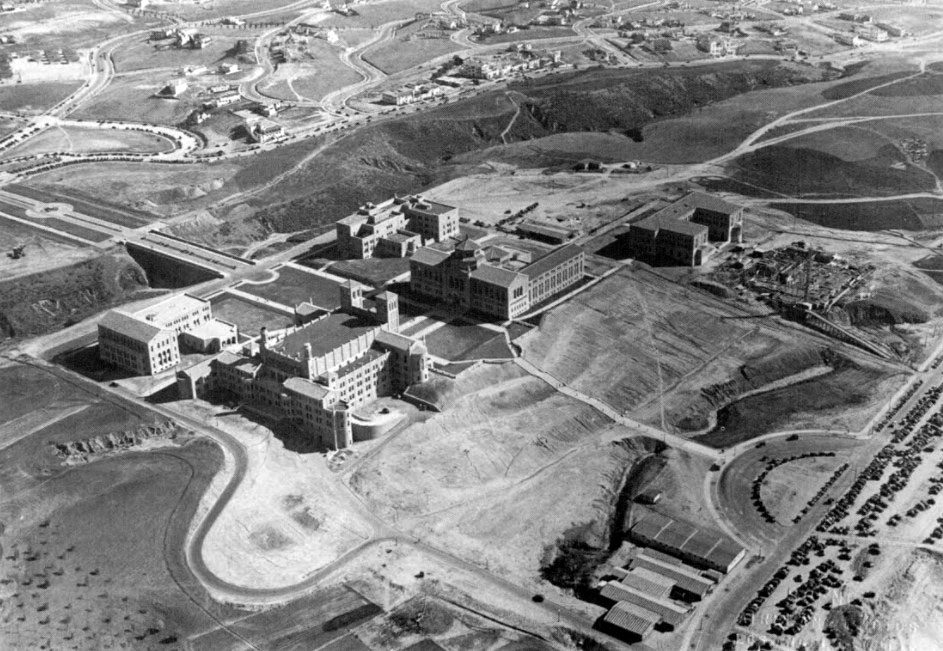 |
|
| (1930)^v^ – Aerial view looking southeast showing the UCLA campus. Visible at far left is the Arroyo Bridge. Kerkhoff Hall is seen under construction at far right next to the education building. |
Historical Notes On March 27 and 28, 1930, the formal dedication of the University of California at Los Angeles took place. Speakers at the ceremonies included Dr. Arthur Thompson of the University of Aberdeen and Dr. Ernest Carroll Moore, director of UCLA. Delegates representing 168 colleges and universities from around the world were present. |
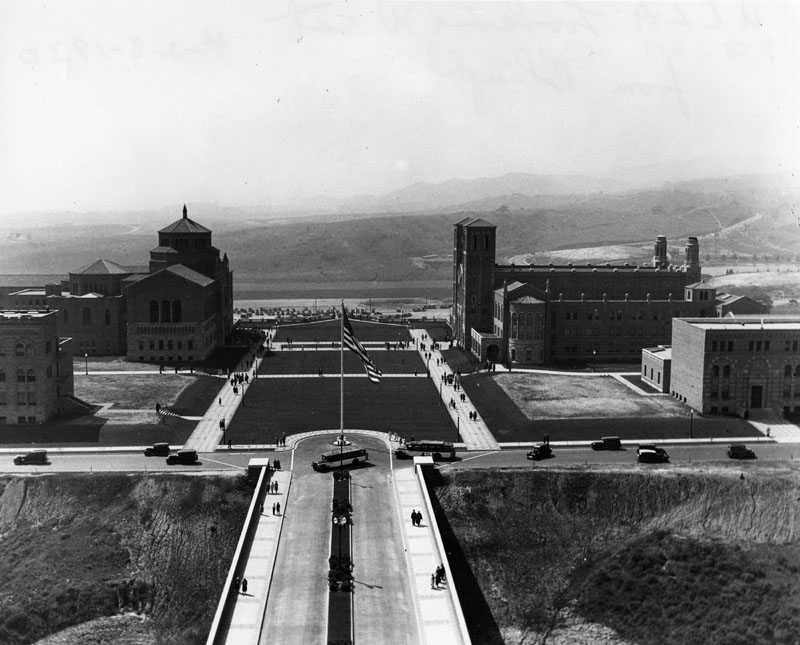 |
|
| (1930)* - Aerial view of UCLA looking west, as seen from the Goodyear blimp. View was taken after the construction of the original quadrangle was completed on the Westwood campus. The view is from directly over the Arroyo Bridge, over which students passed from Hilgard Avenue to the campus. |
| (1930)*# - Aerial view looking southeast showing the full extent of Janss Steps before the hillside was landscaped. |
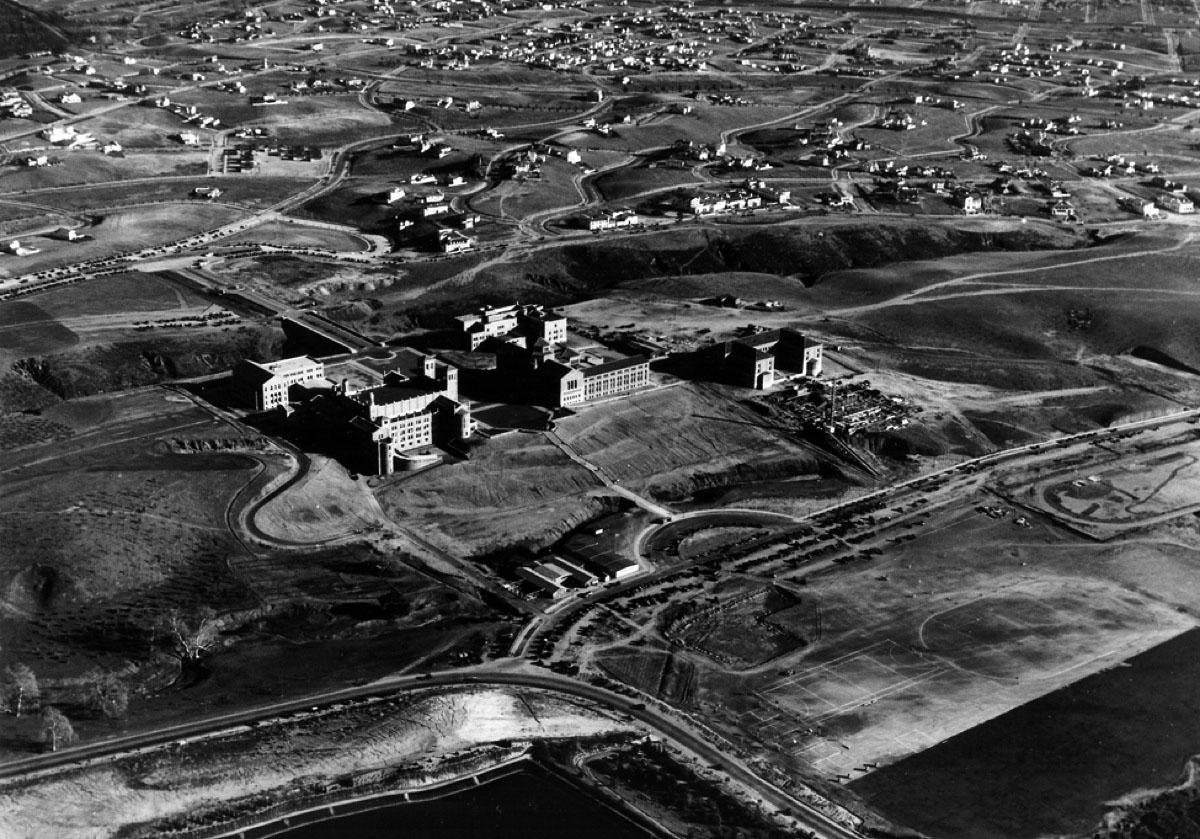 |
|
| (1930)*#- Aerial view of UCLA showing the full range of residential development to the southeast of campus. There is a clear view of the bridge and gully, later filled in, between the campus and the community. |
 |
|
| (1930)* - A panoramic view of the UCLA Westwood campus, shortly after it opened. View is looking from the golf course of the Bel-Air Country Club. The body of water shown is the Sawtelle Pressure Break Resevoir. The twin towers of Royce Hall may be seen in the middle of this photo. Click HERE to see more Early Views of LA Water Reservoirs. |
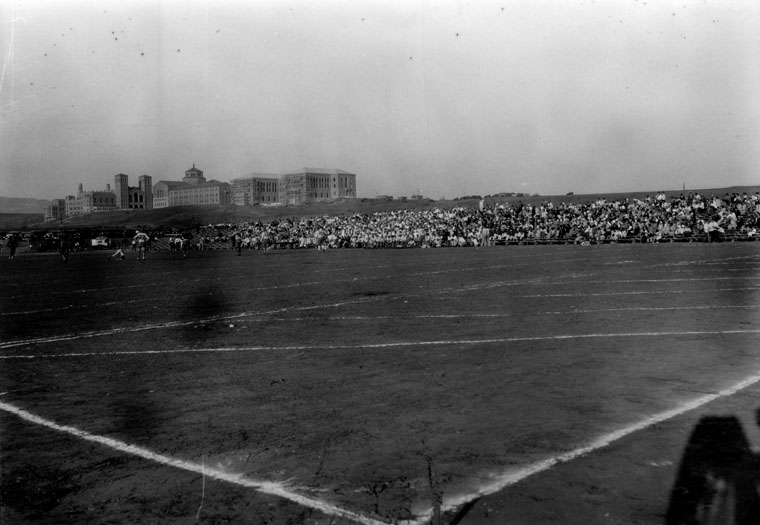 |
|
| (ca. 1930)* - View looking across UCLA's playing field, where a football game is in progress. In the far background is UCLA's Royce Hall, the backs of Powell Library and the Physics building, the earliest campus buildings. |
* * * * * |
Kerckhoff Hall
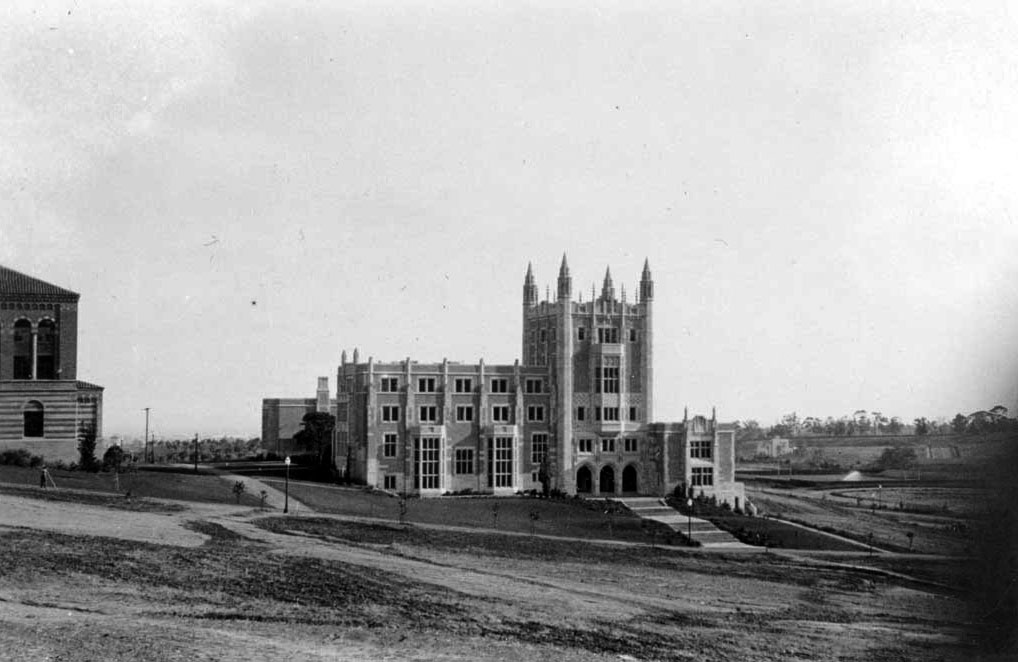 |
|
| (1931)* - View showing the front of the newly constructed Kerckhoff Hall with Moore Hall to the left. |
Historical Notes Designed by architects Allison & Allison, Kerckhoff Hall was completed in 1931. The hall is named for William G. Kerckhoff, a successful lumber and energy magnate, who died prior to the building's completion. Mr Kerckhoff's widow spent $815,000 to build and completely furnish Kerckhoff Hall. |
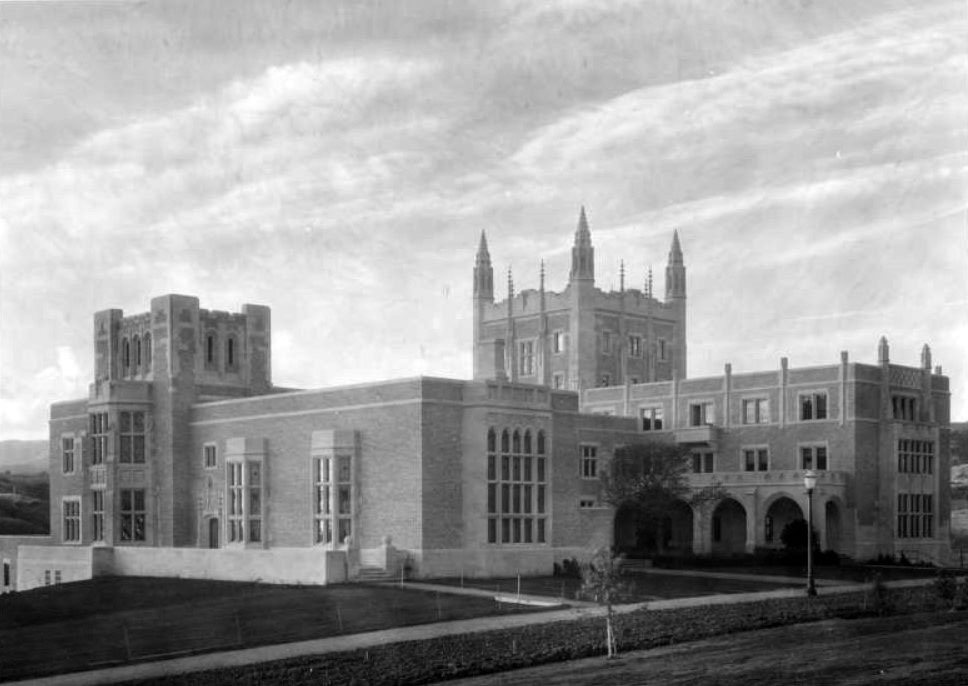 |
|
| (ca. 1931)^^ - View of Kerckhoff Hall (Student Union Building) on the southeast side of the University of California Los Angeles campus, The multi-faceted brick building is three stories tall at its zenith. Towards the back of the building, a small tower is visible, while the lower levels of the building are adorned with tall, bay windows. |
Historical Notes The Kerckhoffs visited the Westwood campus under construction in early 1929 and were told by the provost of the need for a student union. On his deathbed a month later, Kerckhoff told his wife that he wanted to build such a building.* |
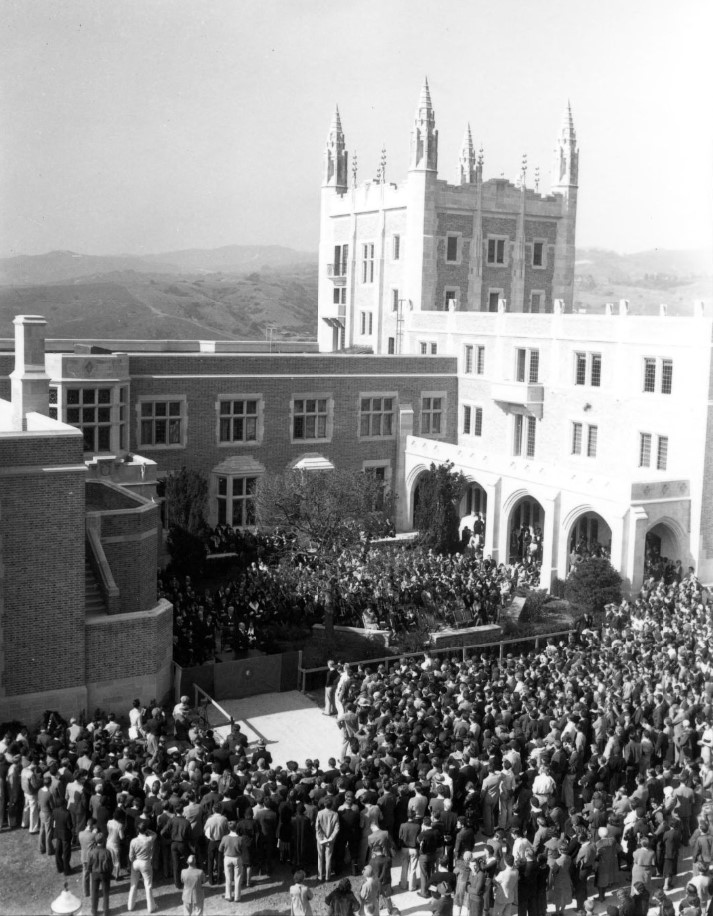 |
|
| (1931)** - View showing the dedication ceremony of the new Kerchoff Hall Building as seen from a vantage point in the Education Building (Moore Hall). |
Historical Notes William Kerckhoff moved to Los Angeles from Indiana in 1878-1879 and worked for the Jackson Lumber Company. In 1887, he built the first ocean-going vessel to use oil for fuel. In the 1890s, he founded the San Gabriel Power Company, a hydroelectric power company. By the turn of the century, together with A.C. Balch, he owned half the stock of Henry E. Huntington Pacific Light & Power Company used to provide electricity to Pacific Electric, and he served as its President. In 1902, they purchased the San Joaquin Electric Company. They also founded Southern California Gas Corporation in 1910, and built a 120-mile pipeline from the San Joaquin Valley to Los Angeles. In 1900, Kerckhoff together with Burton E. Green, Charles A. Canfield, Max Whittier, Frank H. Buck, Henry E. Huntington, William F. Herrin, W.S. Porter and Frank H. Balch, known as the Amalgated Oil Company, purchased Rancho Rodeo de las Aguas from Henry Hammel and Andrew H. Denker and renamed it Morocco Junction. After drilling for oil and only finding water, they reorganized their business into the Rodeo Land and Water Company to develop a new residential town later known as Beverly Hills, California. As President of the South Coast Land Company, kerckhoff also helped found the city of Del Mar, California.*^ |
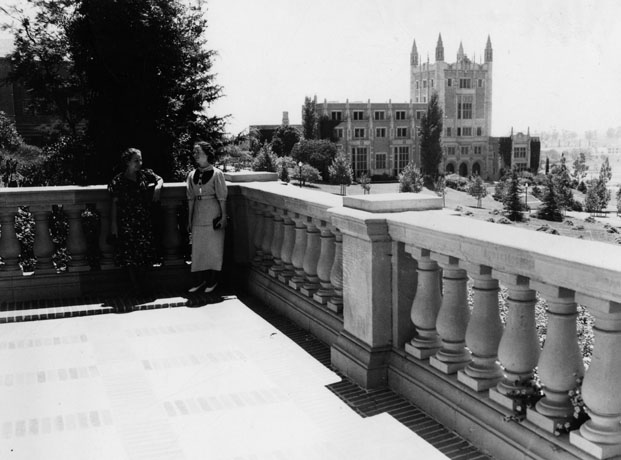 |
|
| (1937)* - View of Kerckhoff Hall (formerly Commissary Hall), as seen from the rotunda at the west end of the quadrangle, where two women are seen talking. |
Historical Notes Today, Kerckhoff Hall is one of the main student union buildings of UCLA. Among its offerings are: study lounges, an art gallery, a coffeehouse, meeting rooms, a salon and the student government offices.* |
 |
|
| (2020)^.^ - Kerckhoff Hall as it appears today. Photo by Howard Gray |
Historical Notes For many Bruins, the iconic Gothic spires of Kerckhoff Hall, rising majestically high above campus, are second only to Royce Hall as a symbol of UCLA. |
* * * * * |
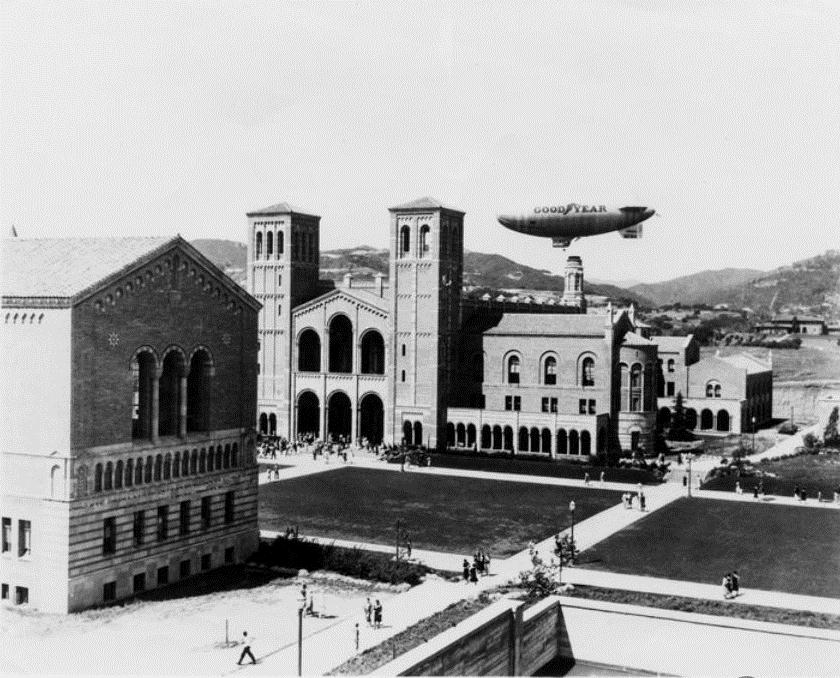 |
|
| (1931)*# - Photographed from the Physics-Biology Building (Kinsey Hall, subsequently the Humanities Building), the Goodyear Blimp flies over Royce Hall. The airship--named the "Volunteer"--was used by Thelner Hoover for aerial photography of campus. Here the airship joins the festivities of the annual freshman "Green Day" in the Spring of 1931. The Library (Powell Library) is in the foreground and the Provost's Residence (University Residence) is in the distant background. Click HERE to see more in Aviation in Early Los Angeles. |
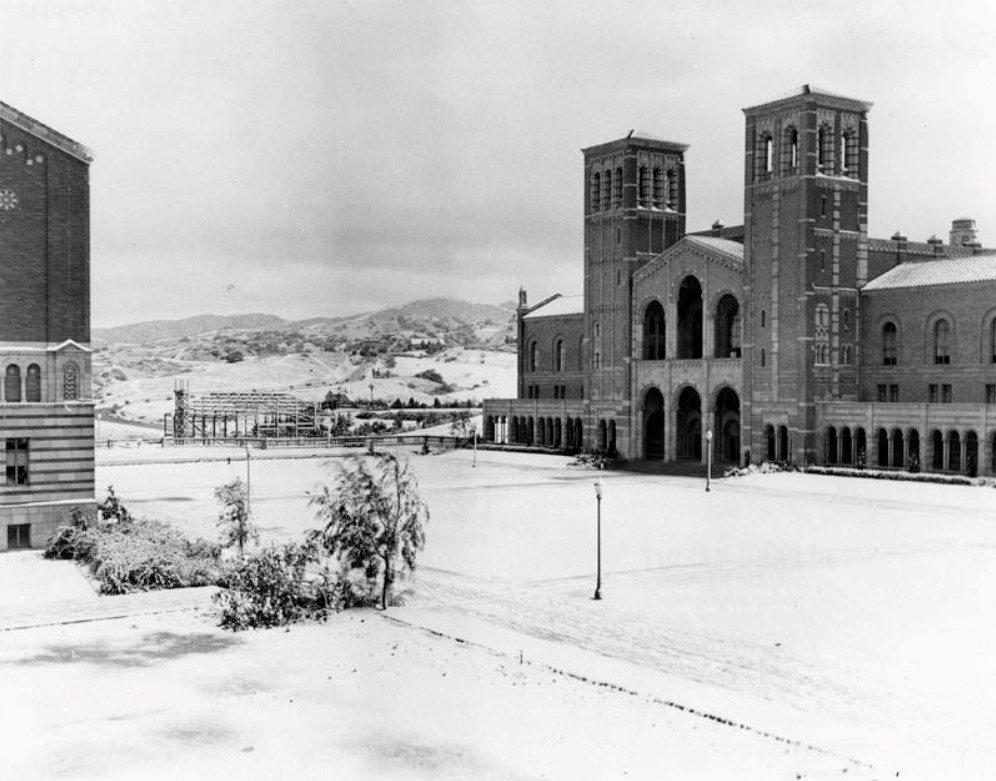 |
|
| (1932)^^* - Snow on the grounds of UCLA's Royce Hall on January 15, 1932. |
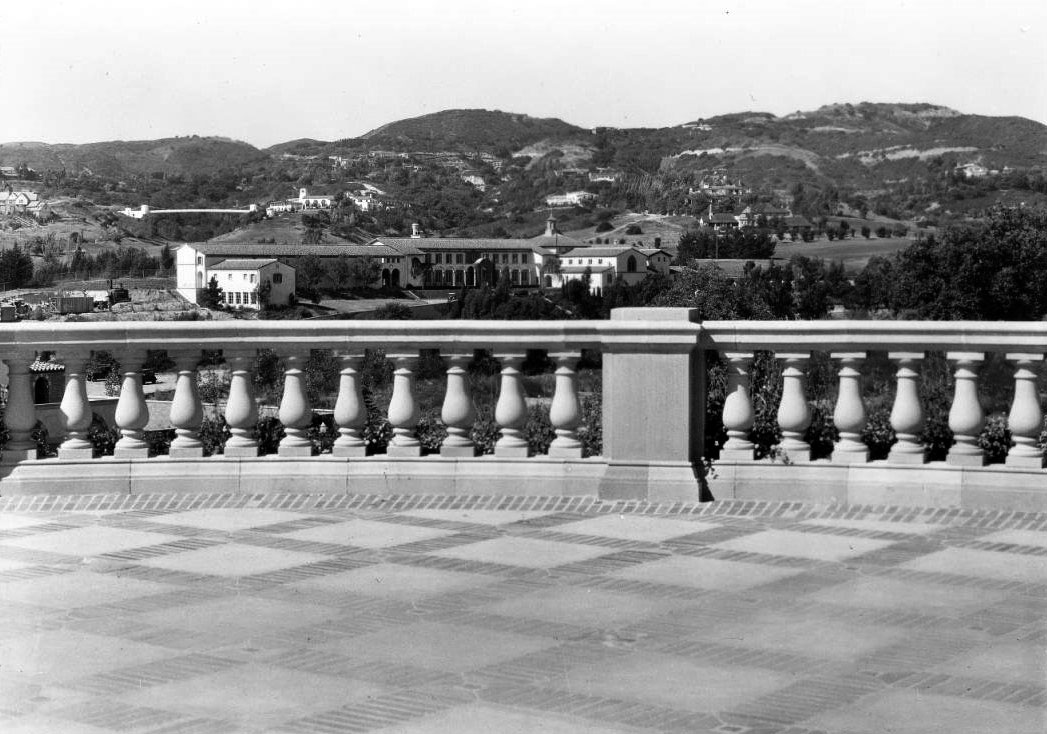 |
|
| (ca. 1935)^^ - View of Marymount High School, seen across Sunset Boulevard from a balcony on UCLA's Royce Hall. A tiled balcony lines the foreground, and over it, one can see a stretch of buildings across an arboreal area. Several smaller house-like structures dot the hill-lined distance. |
Historical Notes Marymount was established in 1923 by the Religious of the Sacred Heart of Mary. Mother Joseph Butler of the Religious of the Sacred Heart of Mary founded the school in 1923. Marymount students and teams are known as the "Sailors." *^ |
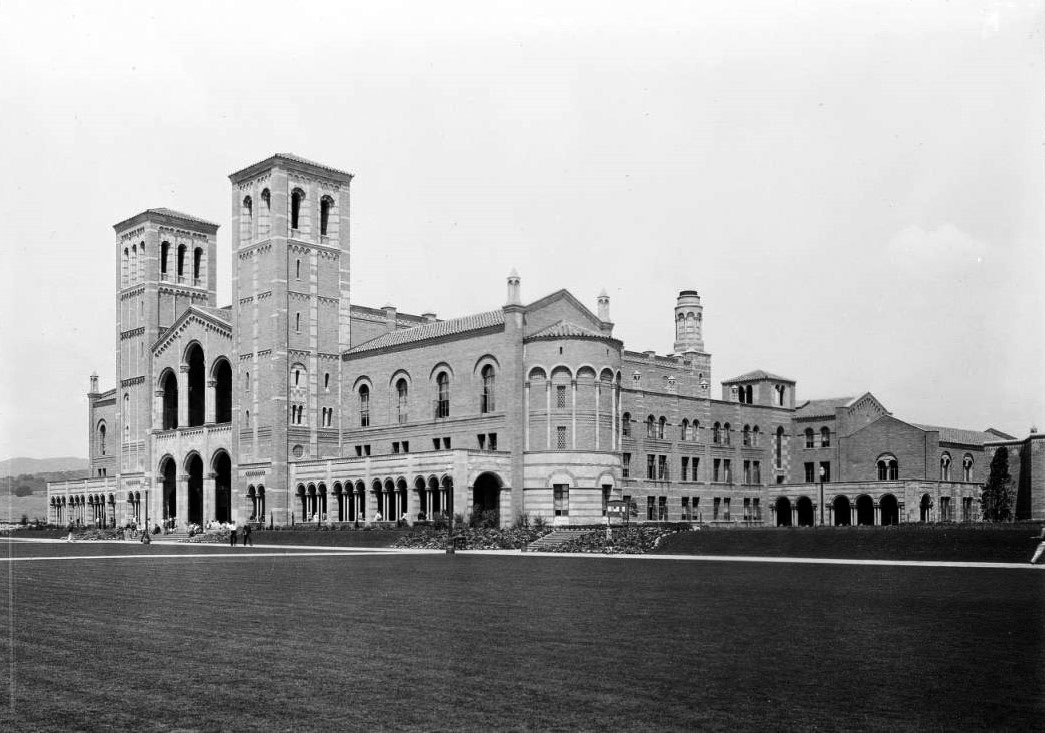 |
|
| (1938)^^ - Profile view showing the full extent of Royce Hall. The photo allows one to view the entire side of the building, and a rounded columned structure emerges at center, while rows of both squared and arched windows line a three-story structure that works its way into more structures in the back. Several rounded turrets stand atop roofs in this area. A large manicured lawn stretches in front of the building, and a sky with a sprinkling of clouds hangs overhead. |
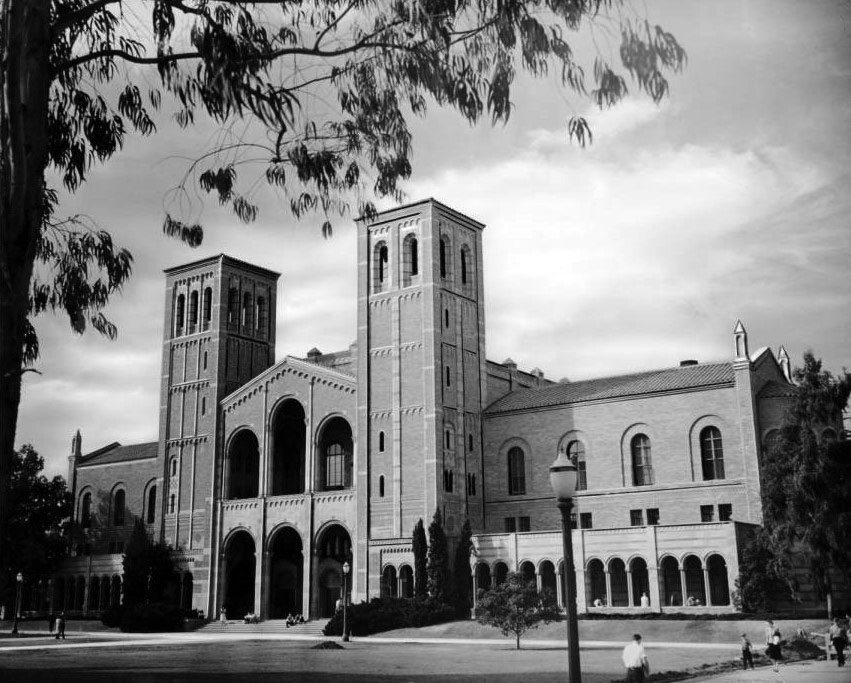 |
|
| (ca. 1950)^^ - View of the beautiful Royce Hall at UCLA. The large brick building is pictured with bell tower to either side of the its large arched entranceway. Several students can be seen sitting on the front steps, while at right more can be seen walking down a path. |
UCLA Parking
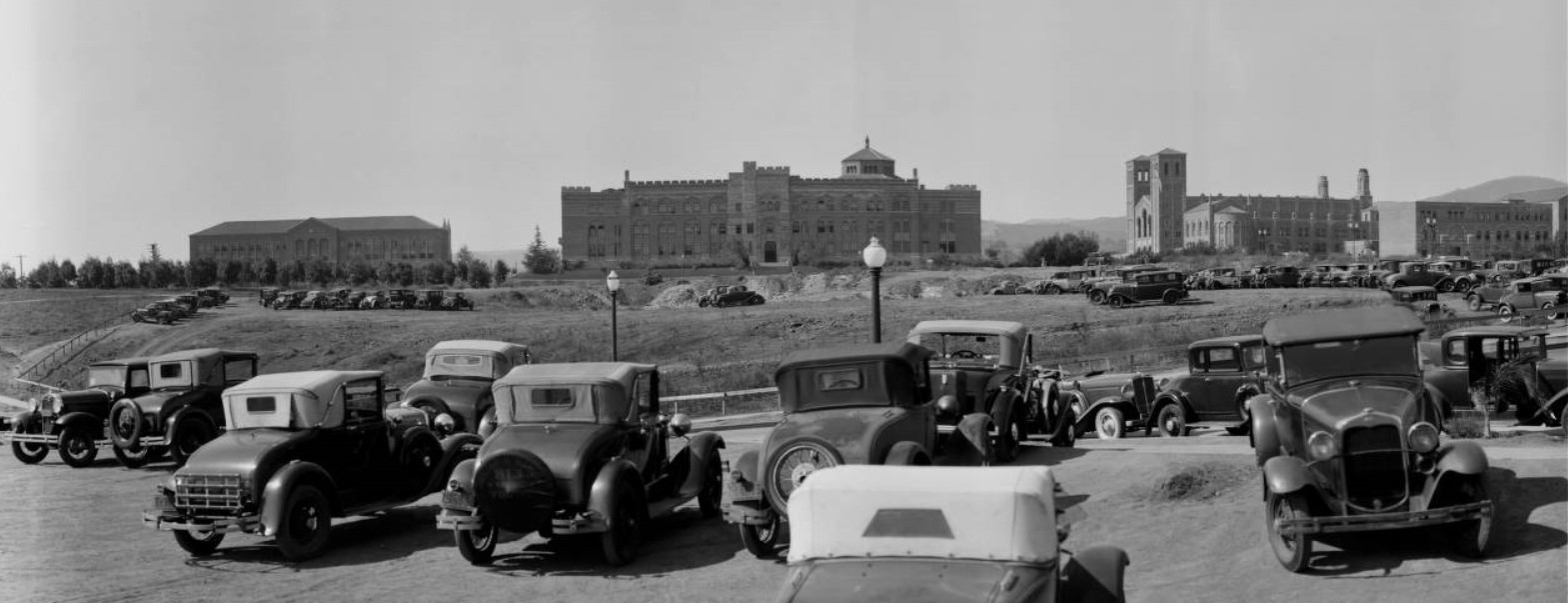 |
|
| (1932)* - A panoramic view of the campus of UCLA facing west. College Library (now Powell Library) is in the center, with the Education Building (now Moore Hall) on its left and Royce Hall on its right. The photograph was taken from a parking lot. There are other lots filled with parked automobiles between the camera and the campus buildings. Source: Huntington Library |
Historical Notes In the early years, parking on the UCLA campus was not a significant concern. After World War II, UCLA experienced significant growth, and this growth led to increased demand for parking facilities. This expansion coincided with the post-war boom in car ownership in the United States. To address the growing parking demand, UCLA constructed its first parking structures in the 1950s and 1960s. These multi-level parking garages helped alleviate some of the parking congestion on campus. |
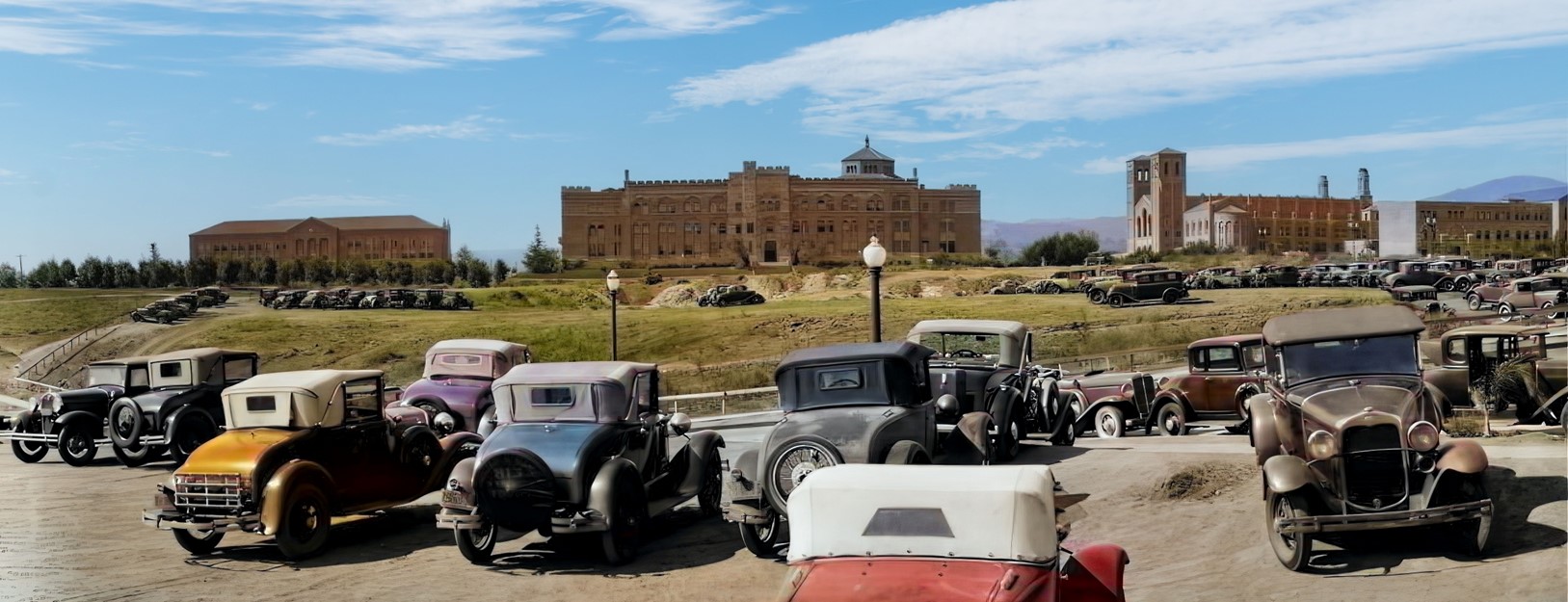 |
|
| (1932) - Panoramic view of the UCLA campus facing west showing parking lots in the foreground. AI image enhancement and colorization by Richard Holoff |
* * * * * |
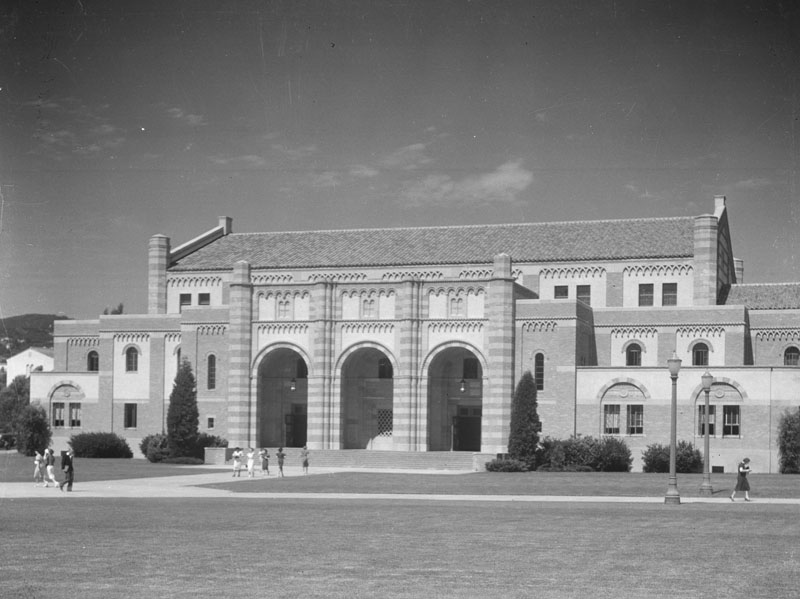 |
|
| (1932)* - Exterior view of the Women's Gym on the UCLA Westwood campus (currently Kaufman Hall). Built in 1932. |
Historical Notes Named for philanthropist Glorya Kaufman, Kaufman Hall was originally UCLA's women's gym. She is the widow of Donald Bruce Kaufman, who co-founded KB Home with Eli Broad in 1957. The building was eventually remodeled and renovated in 2005 to become the house of UCLA Department of World Arts and Cultures as well as dance. Aside from the WAC department, Kaufman Hall also is host to the Kaufman Garden Courtyard, the Kaufman Garden Theater, the Kaufman Hall Dance Theater, and the North pool. Glorya (Pinkis) Kaufman was born in Detroit, Michigan during the Great Depression. Her father worked as a production manager for Automotive News and her mother volunteered for Jewish charities. Her parents could not afford dancing lessons for her. In 2009, she donated $20 million to the Los Angeles Music Center to establish the Glorya Kaufman Presents Dance series. She has also donated millions to the Alvin Ailey American Dance Theater and the Juilliard School in New York City. In 2011, she donated several millions to the University of Southern California for the establishment of the Glorya Kaufman School of Dance and the construction of the Glorya Kaufman International Dance Center.*^ |
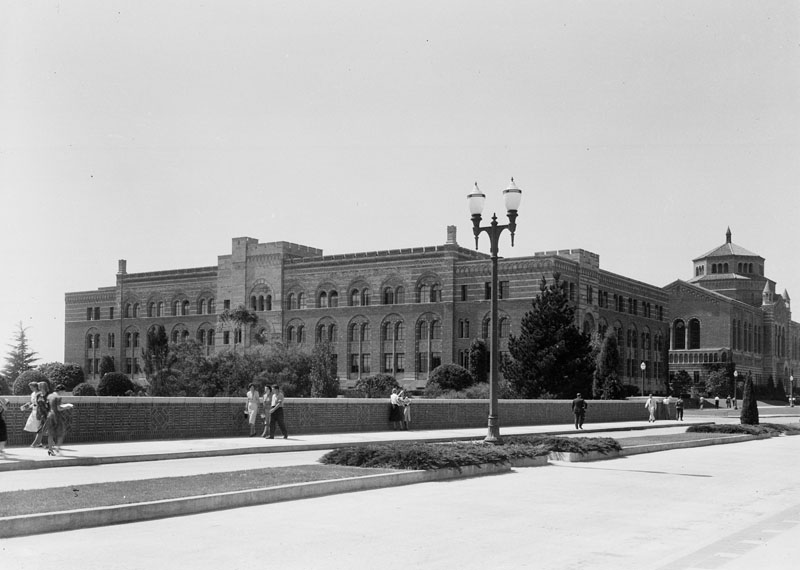 |
|
| (CA. 1935)* - Exterior view of the Physics-Biology building on the UCLA Westwood campus. |
Historical Notes On August 8, 1933, just 14 years after the Los Angeles campus became a part of the University; the Regents authorized graduate training for the M.A. degree and specified a graduate enrollment of 125 students. In the first year, 170 qualified students applied and were enrolled. Graduate enrollment has been climbing ever since. On May 22, 1936, the Regents extended their authorization to include the Ph.D. degree. At June Commencement two years later, the first Ph.D. degree was awarded to Kenneth P. Bailey, a student in the Department of History. One year earlier, a Ph.D. degree had been conferred at Berkeley on Norman Watson, a student in the Department of Physics who had done much of his graduate research at Los Angeles.** |
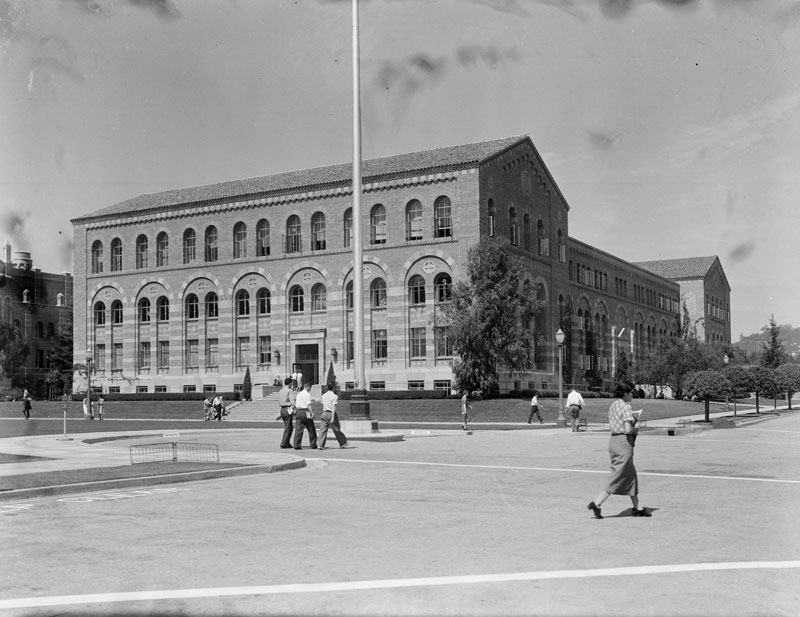 |
|
| (ca. 1935)* - Exterior view of the Chemistry building on the UCLA Westwood campus. |
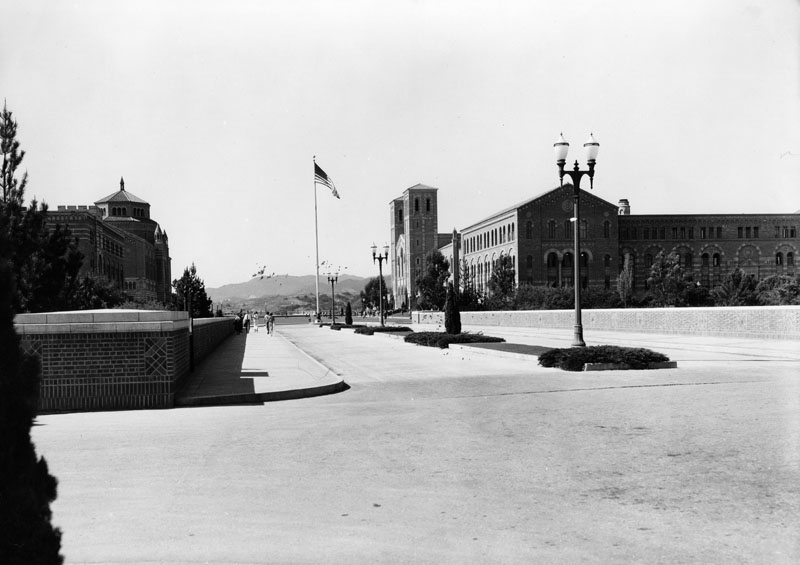 |
|
| (ca. 1935)* - View of two of UCLA's buildings as seen from the bridge. First building in the foreground is Haines Hall. It was built in 1928 and designed by George W. Kelham. The twin towers of Royce Hall are also seen in the background. |
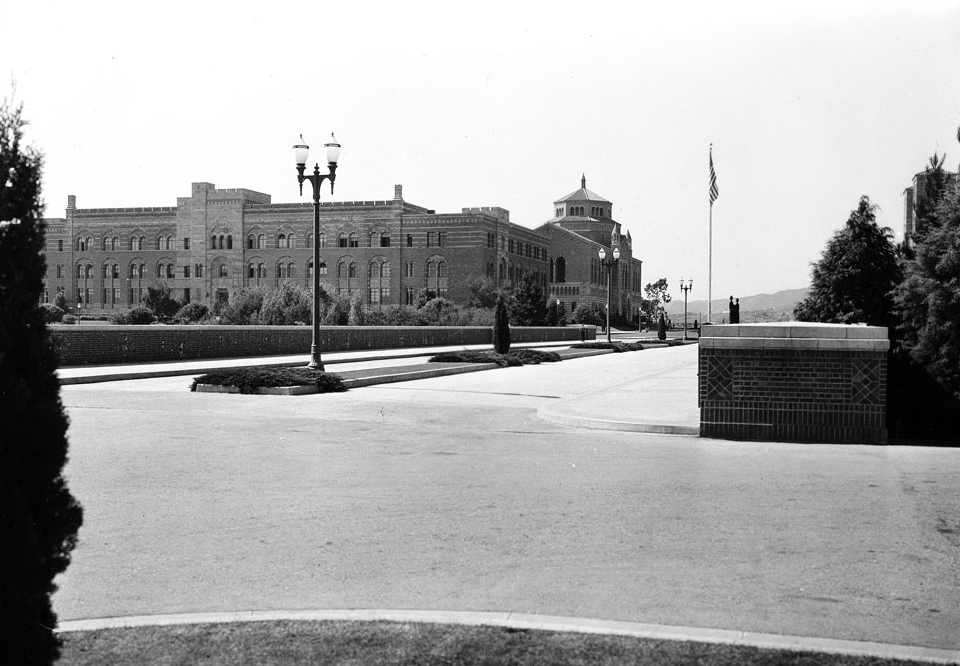 |
|
| (ca. 1935)^^ - Another view of Powell Library from the Arroyo Bridge. |
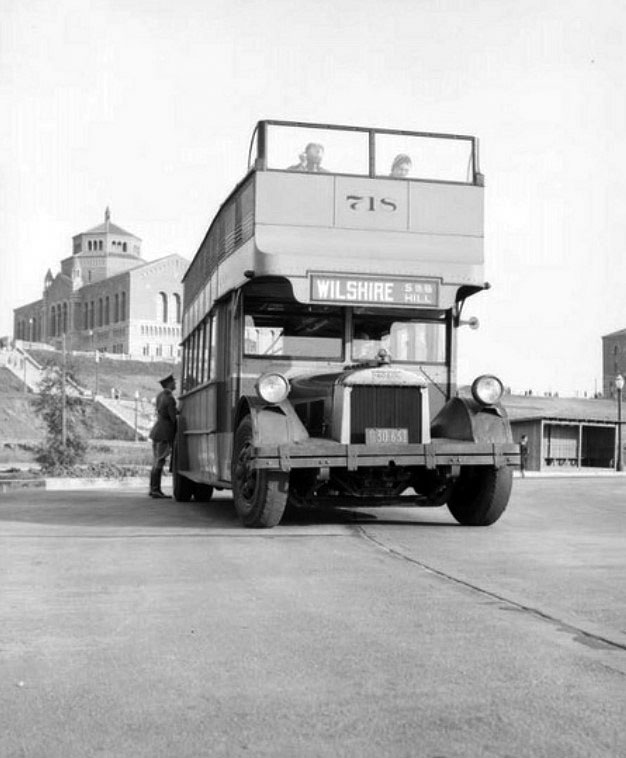 |
|
| (1931)^ – View showing the UCLA stop on the Wilshire bus route, essentially at the foot of Janss Steps with Powell Library in the background. The bus is parked on what would soon become a vast athletic field which would, in turn, give itself over to Pauley Pavilion (out-of-frame to the right). |
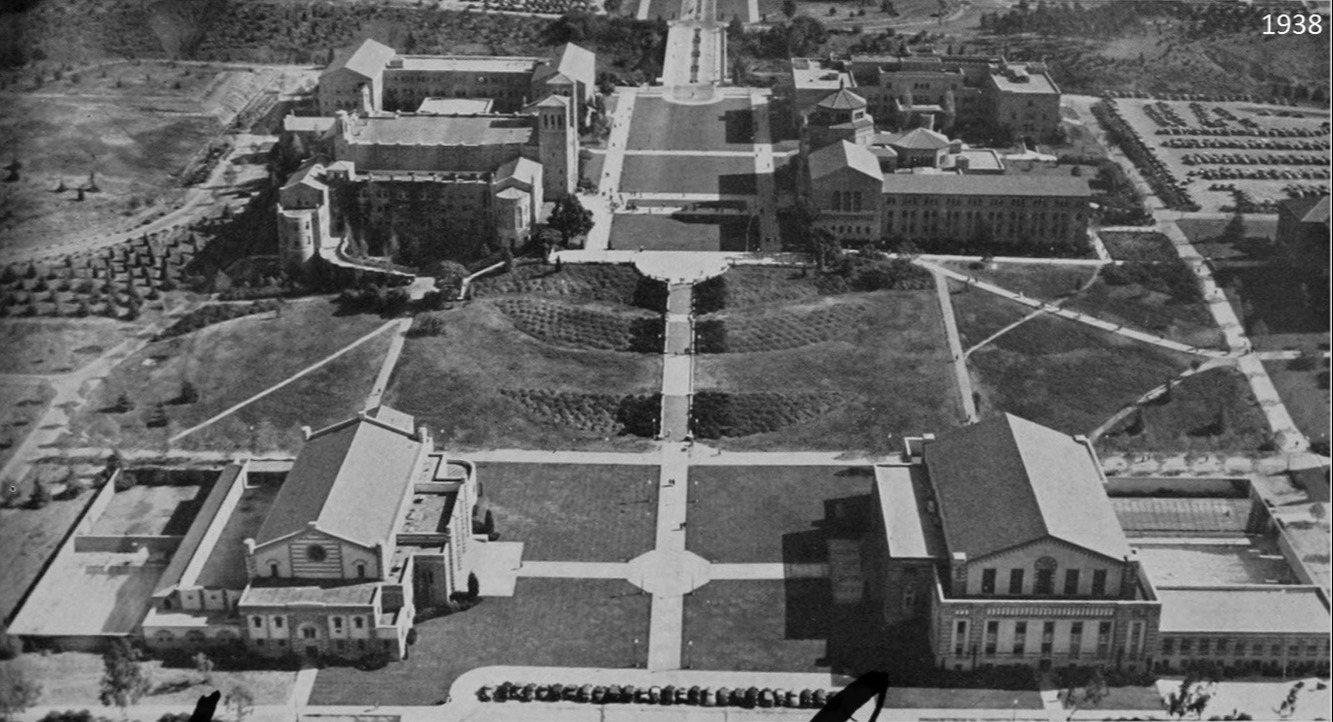 |
|
| (1938)* –Aerial view showing most of the UCLA campus. |
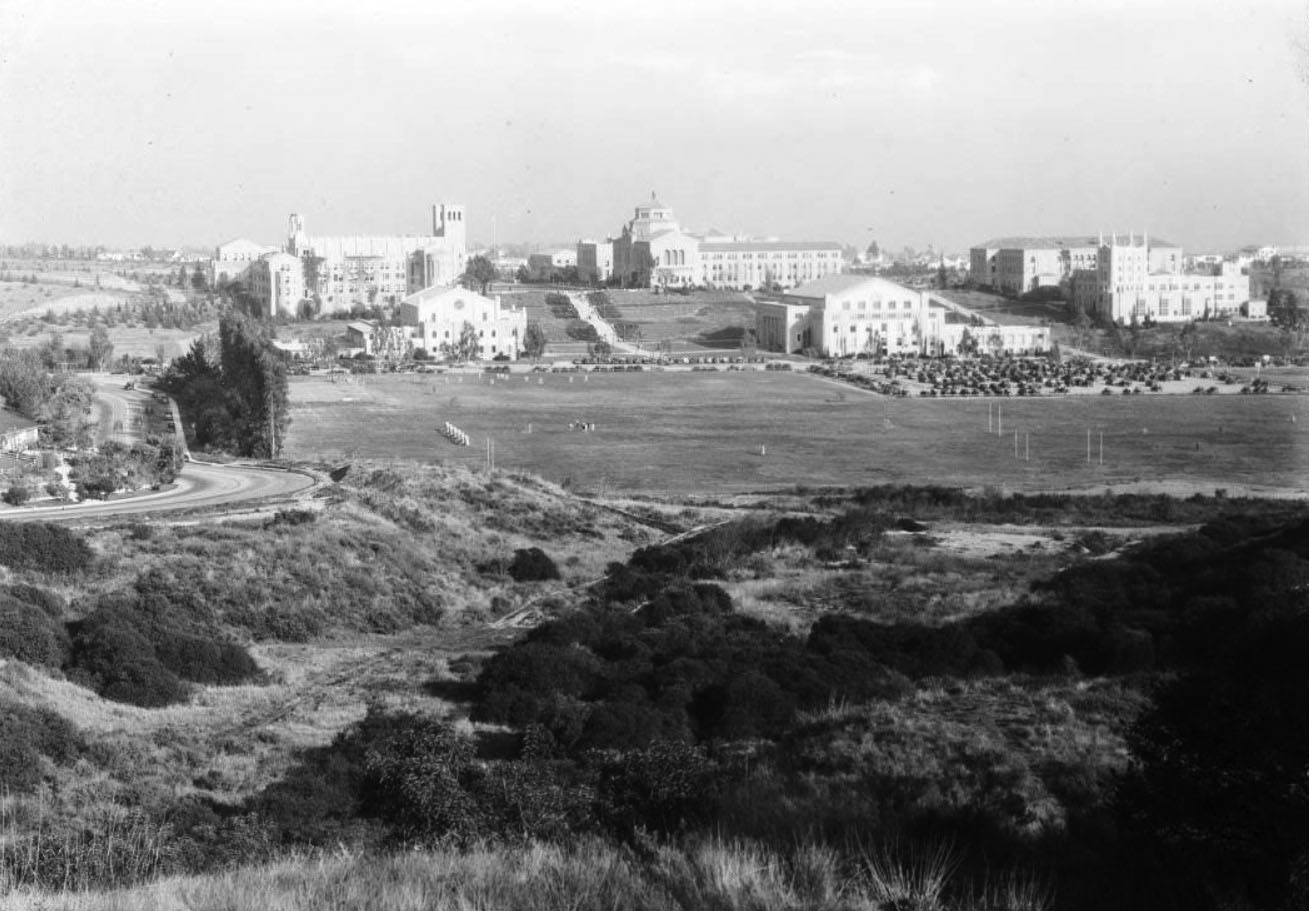 |
|
| (1930s)^^ - Photograph of a wide view of the University of California at Los Angeles. The buildings of the campus lie beyond two vast fields. The field in the foreground is rocky and overgrown, while the field nearest the buildings is manicured and used for sports. Sunset Boulevard is seen on the left. |
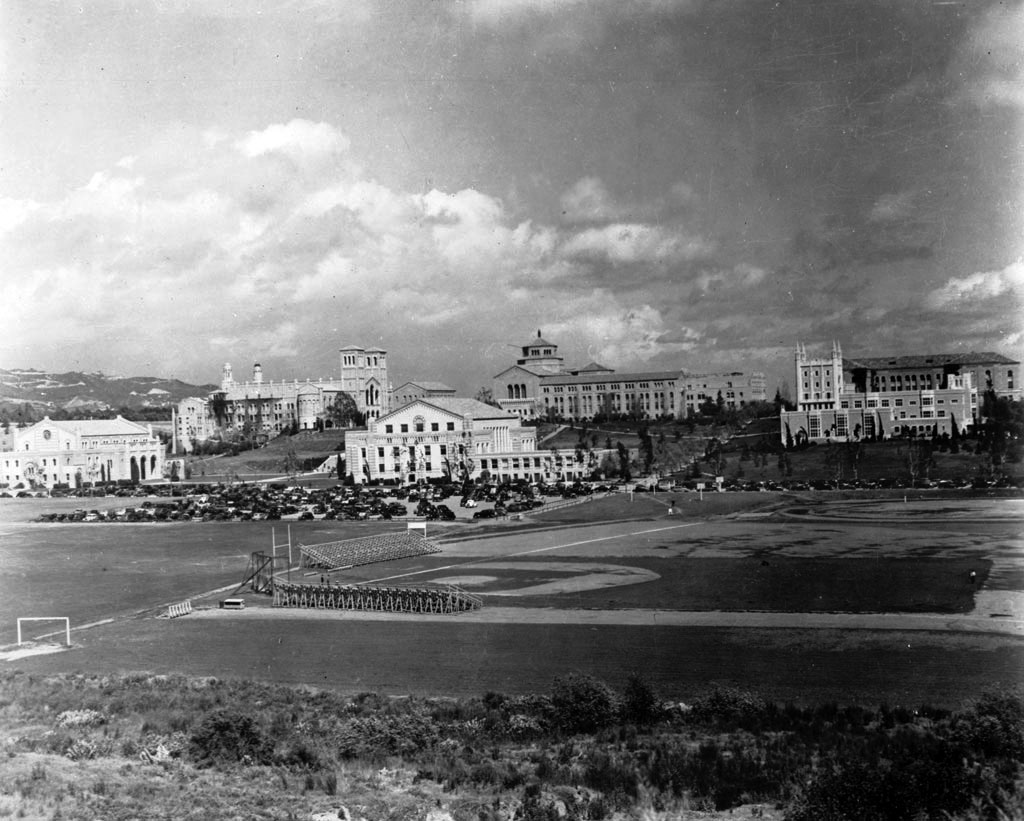 |
|
| (ca. 1938)^^ - View of the University of California Los Angeles campus from the baseball field, ca.1938. A baseball diamond is visible in the foreground at center, and bleachers can be seen on both the first and third base lines. In the background are several large brick buildings. These include, from left to right: Women's Gym, Royce Hall, Men's Gym, Powell Library, Kerckhoff Hall, and Moore Hall behind. A parking lot can be seen between the diamond and the buildings and is full of cars, indicating that UCLA was a commuter campus from early in its history. |
 |
|
| (ca. 1930s)^^ - View of the buildings on the UCLA from across an open field. In the foreground, a wide field is pictured with football blocking equipment at left and what appears to be a sprinkler at right. Behind this, a cluster of Roman Revival-style and gothic buildings comprises the University of California, Los Angeles campus. At left, a stand of trees makes a border to the field. |
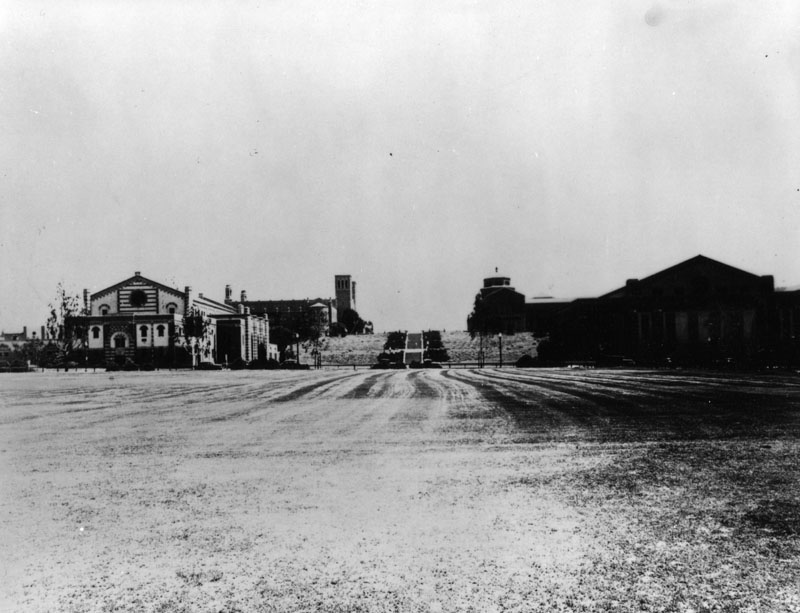 |
|
| (1937)* - View of UCLA's campus buildings from left to right: Men's gymnasium, Royce Hall, Janss Steps; and Powell Library. |
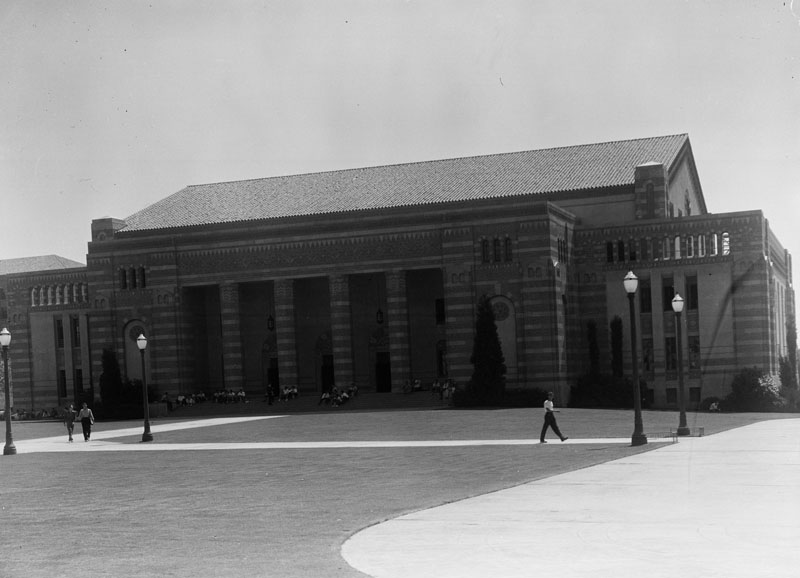 |
|
| (1939)* - Exterior view of the Men's Gym on the UCLA Westwood campus on May 3, 1939. |
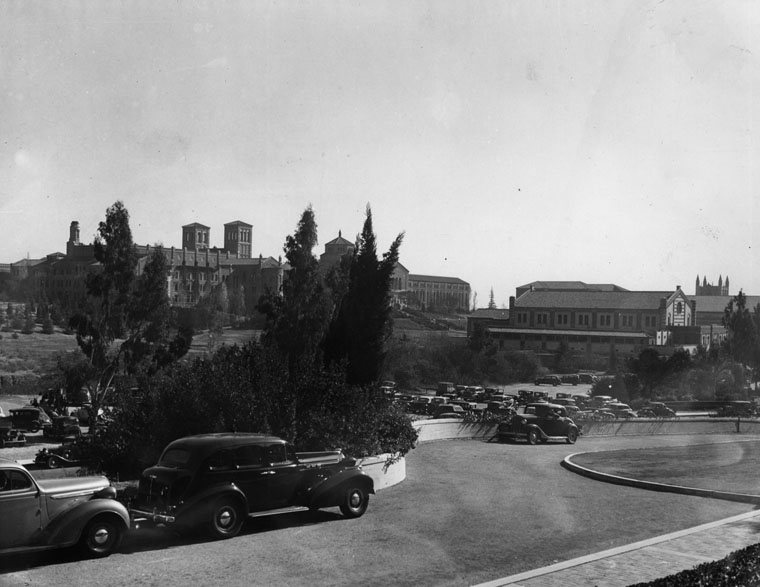 |
|
| (1939)* - View of UCLA's campus buildings, as seen from the northwest. |
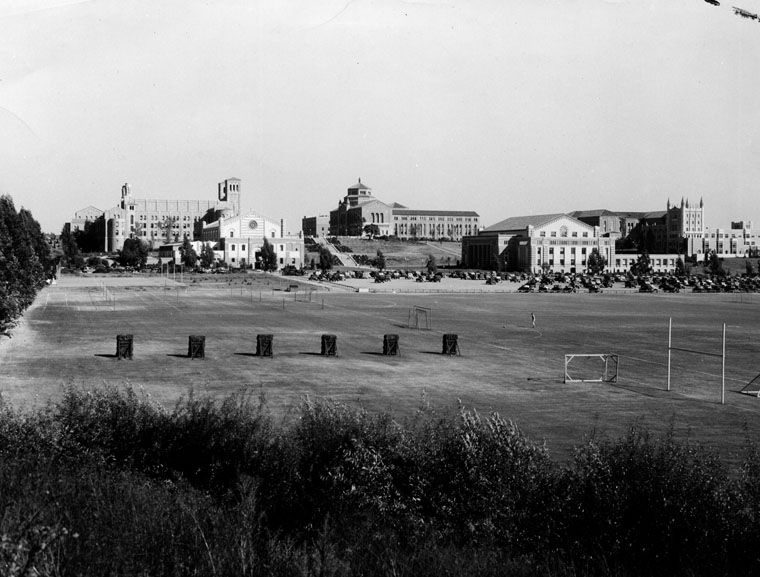 |
|
| (ca. 1940)* - View of UCLA's campus buildings, as seen from the west, across the playing fields. From left to right: Royce Hall, built in 1928-29, and the Women's gymnasium, built in 1932. |
 |
|
| (ca. 1940)* - View of UCLA's campus buildings, as seen from the west. |
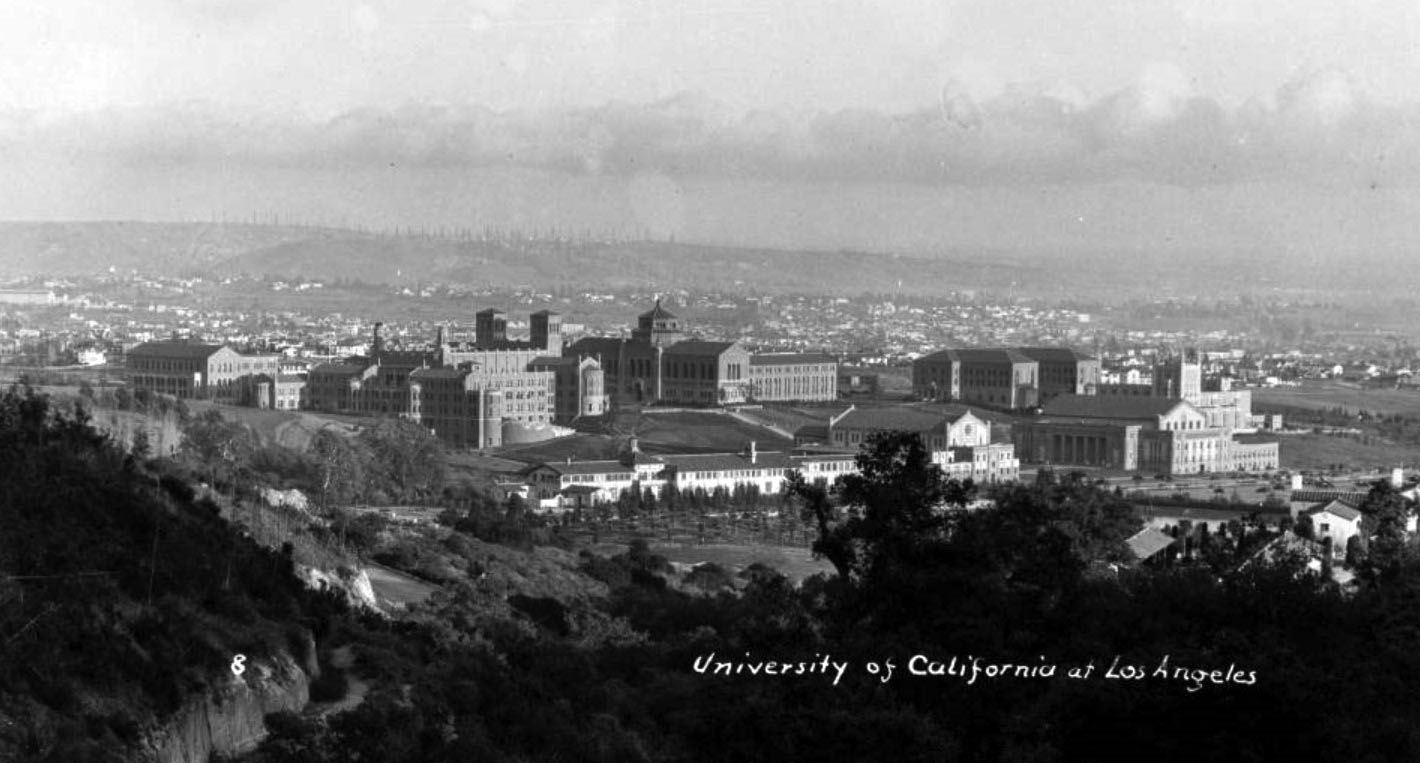 |
|
| (1940s)#* – Postcard view looking southeast showing the campus of UCLA with the Powell Library in the distance at center, the backside of Royce Hall at left and the Women's and Men's gym in the foreground at right. Homes can be seen in the hills, and what appear to be oil derricks in the far distance. |
Click HERE to see more Early Views of UCLA |
Westwood Village
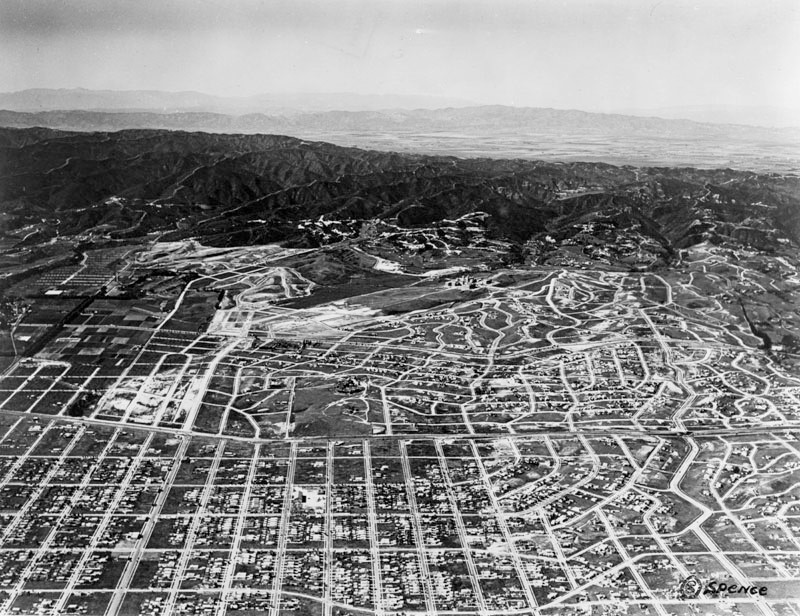 |
|
| (1929)* - Aerial view of Westwood north of Pico Boulevard. The first group of buildings of UCLA are in place, and the streets and blocks of the village are laid out. |
Historical Notes Westwood and UCLA were developed on the lands of the historic 'Wolfskill Ranch', a 3,000-acre parcel that was purchased by Arthur Letts, the successful founder of the Broadway, and Bullock's department stores, in 1919.*^ |
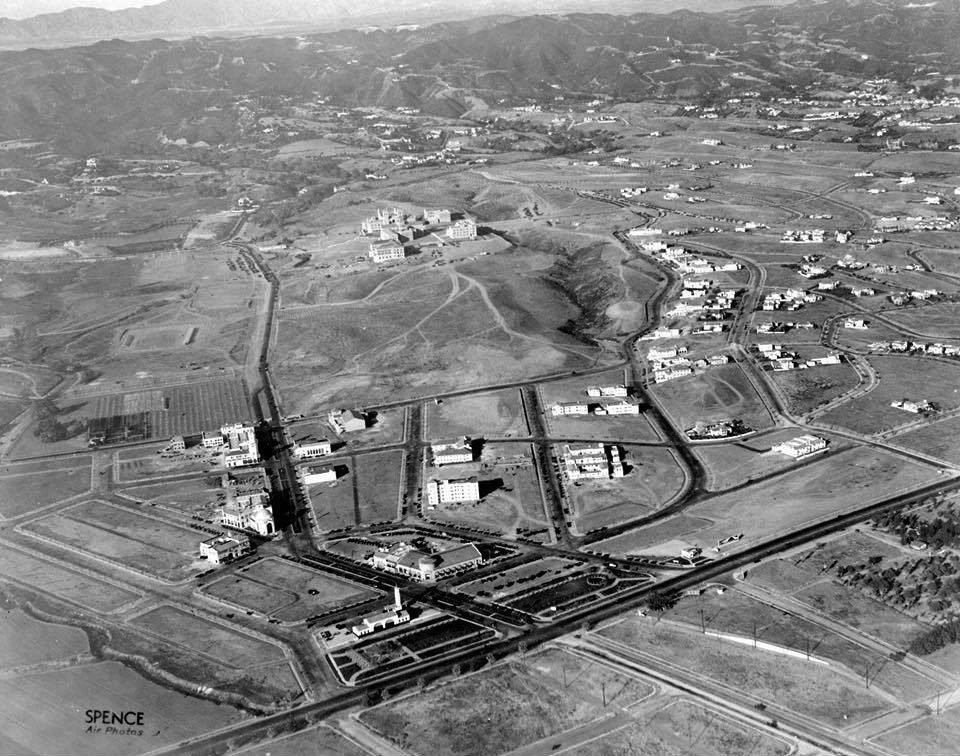 |
|
| (1929)^.^ – Aerial view showing the newly built Westwood Village with the original UCLA buildings seen in the background. |
Historical Notes Westwood Village would contain a unique blend of pedestrian and automobile-oriented development. Wide sidewalks and landscaping were priorities. Corner buildings would be accessible from both streets and interior courtyards. |
 |
|
| (1929)^v^ – Aerial view looking east showing the newly constructed Westwood Village with street names annotated. Wilshire runs away from the camera at far right. |
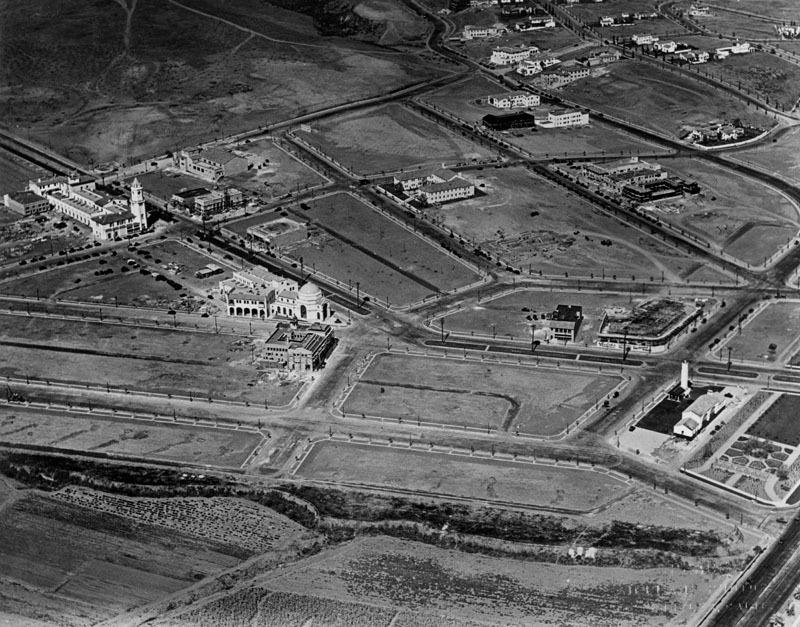 |
|
| (1929)* - Aerial close-up view of Westwood Village, showing the beginning of development but a great deal of open space still. Janss Dome can be seen at center-left. Wilshire is at lower-right. |
Historical Notes Westwood Village was created by the Janss Investment Company, run by Harold and Edwin Janss and their father, Peter, in the late 1920s as an autonomous shopping district and headquarters of the Janss Company. Its boom was complemented by the boom of UCLA (which selected the Westwood Hills as its new home in 1926), developed as a shopping district not just for the residents of Westwood but also for the university.*^ |
.jpg) |
|
| (1929)#^ - View showing Westwood Village under construction. The Janss Dome seen above was the first building to be constructed. When completed in 1930 it would house the headquarters of the Janss Investment Company |
Historical Notes In 1911 Harold Janss married Arthur Letts' daughter Gladys. In 1923 after Arthur Letts, Sr. died, leaving control of the 3,300-acre William Wolfskill ranch on Rancho San Jose de Buenos Ayres to Harold and Gladys Janss. Through a three-way deal with the State of California and the cities of Los Angeles, Santa Monica, and Beverly Hills, the UCLA campus was built. Janss Investment Company went to work in parallel developing the Westwood Village commercial area and surrounding residential neighborhoods.*^^ |
 |
|
| (1929)#* - A panoramic view of Westwood. The area in the foreground is mostly open fields, but beyond that Westwood Village is under construction. There are several tree-lined streets laid out, but only a few large buildings are under construction. There are numerous houses in the distance beyond that, and the beginnings of the University of California, Los Angeles, campus in the distance on the left. |
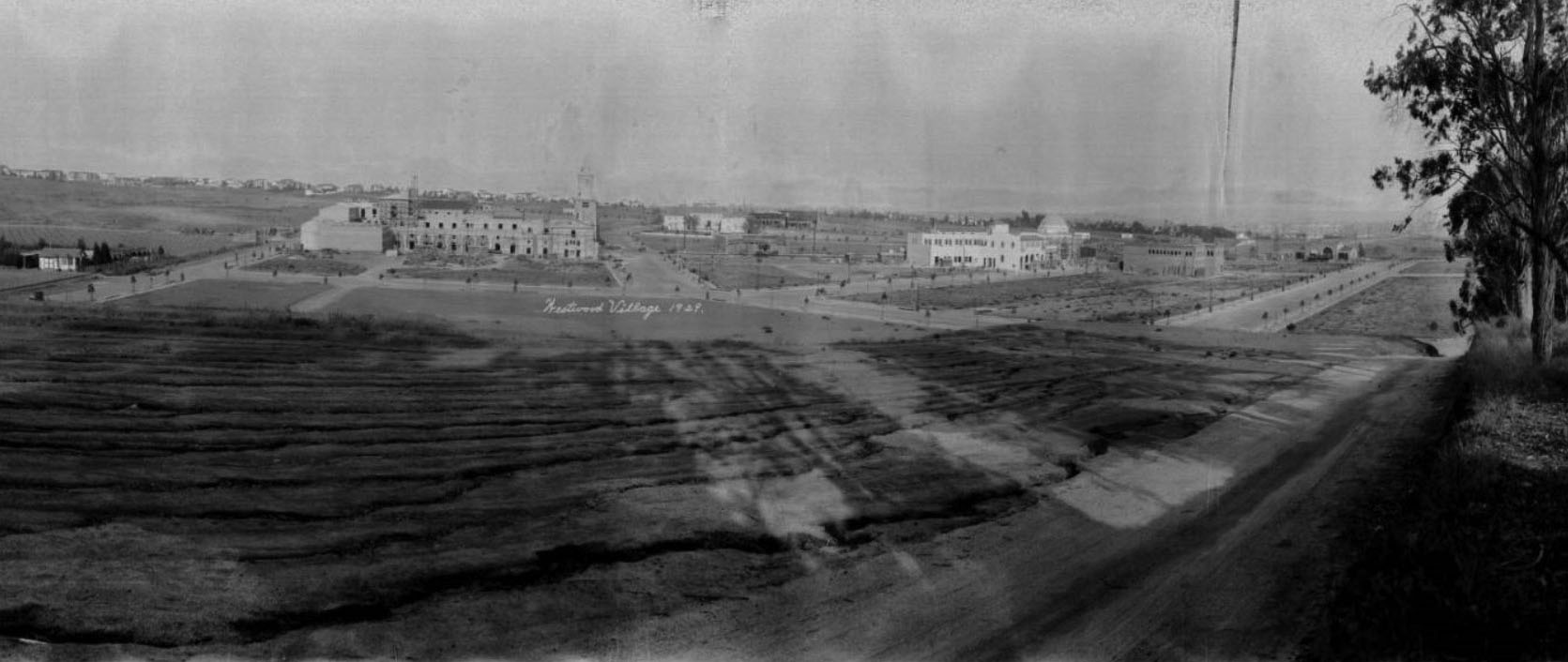 |
|
| (1929)#* - Panoramic view showing Westwood Village under construction. Note the open fields surrounding the development. |
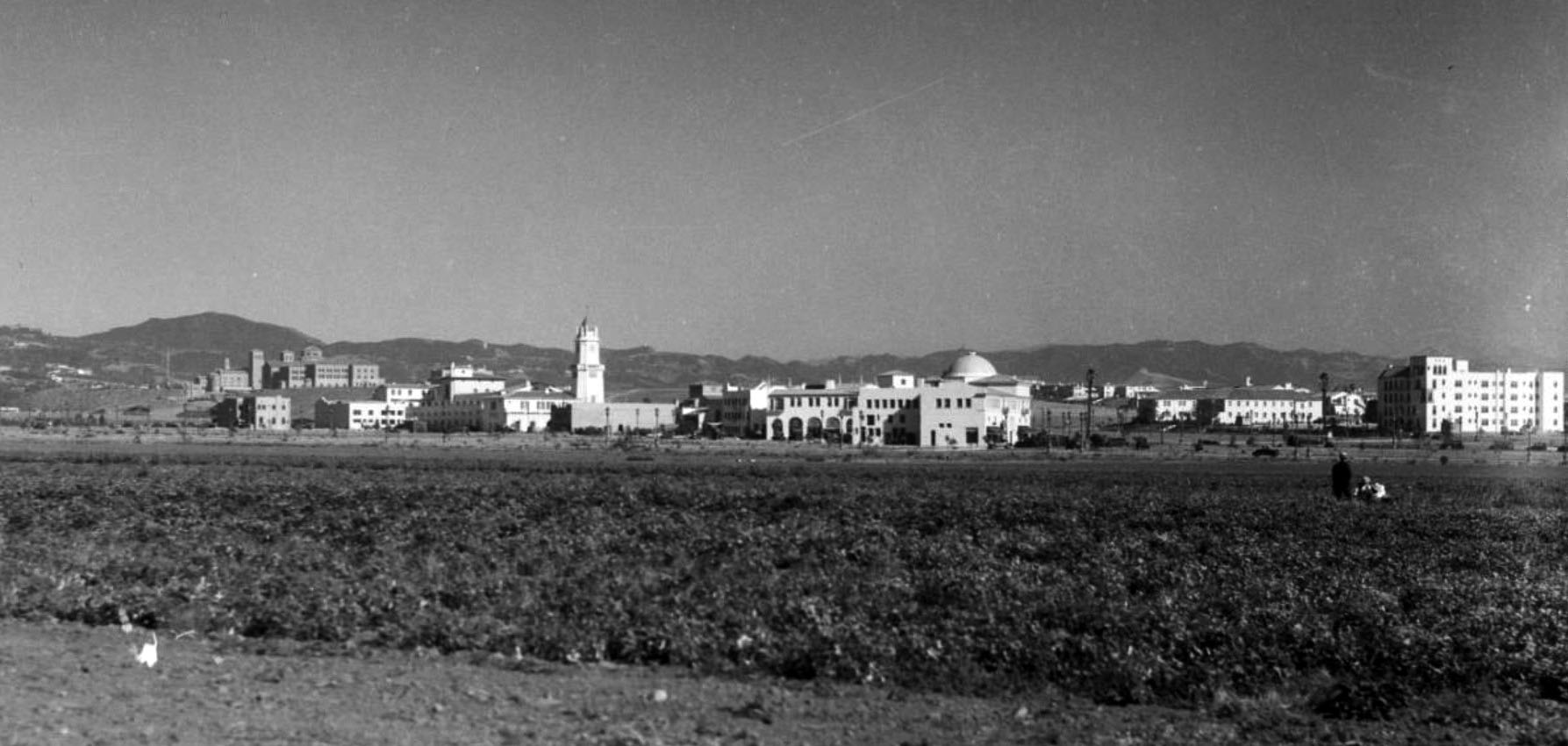 |
|
| (ca. 1930)#* - View of Westwood Village looking northeast, showing agricultural crops in the foreground, and people standing at right. The buildings of the new UCLA campus can be seen on the hill in the distance at left. |
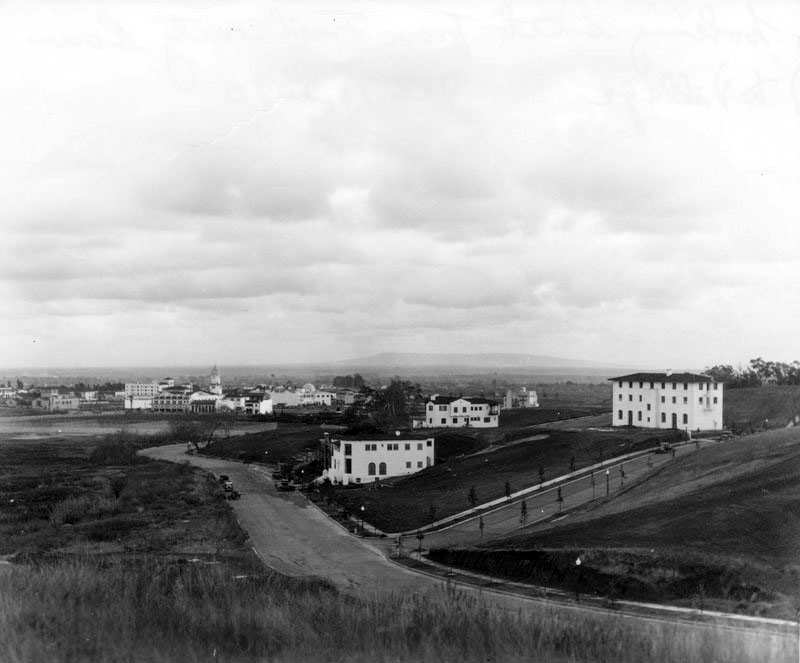 |
|
| (1930)* - View of Westwood Village on January 10, 1930, looking south from UCLA's Fraternity Row. |
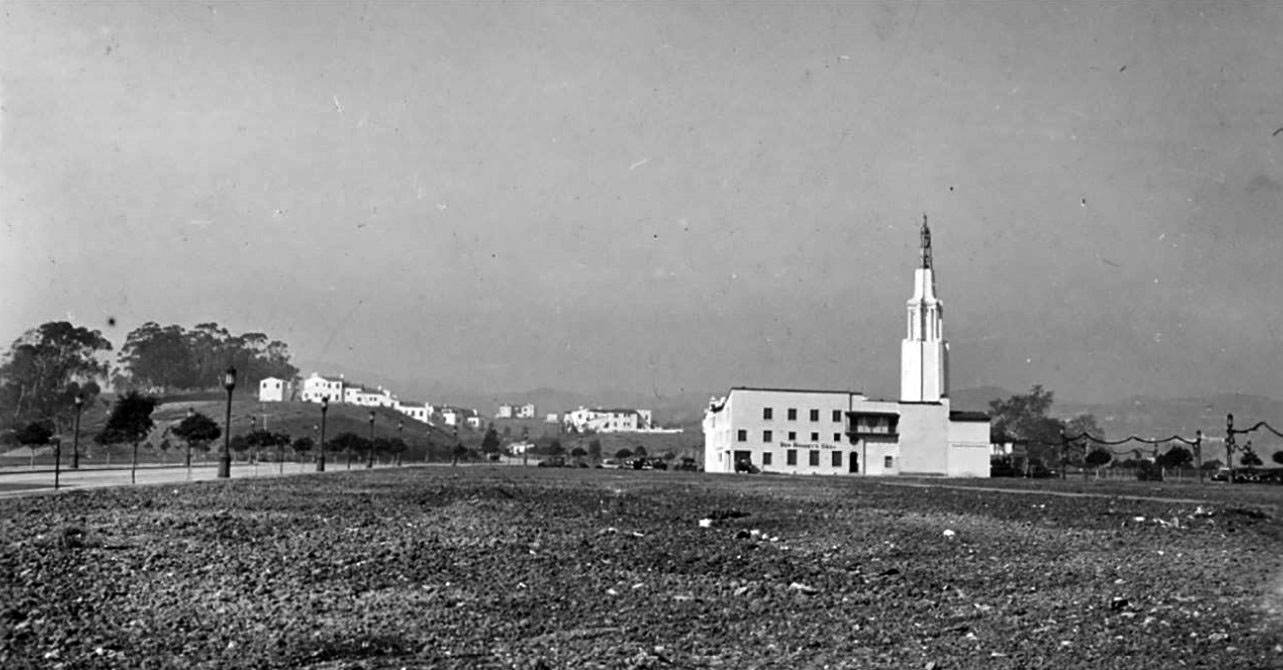 |
|
| (1932)^x^ – Panoramic view looking north toward the Westwood Fox Theatre (built in 1931) with UCLA’s Fraternity Row on the hill in the background. Gayley Avenue is seen at left. Note the amount of undeveloped land in the foreground. |
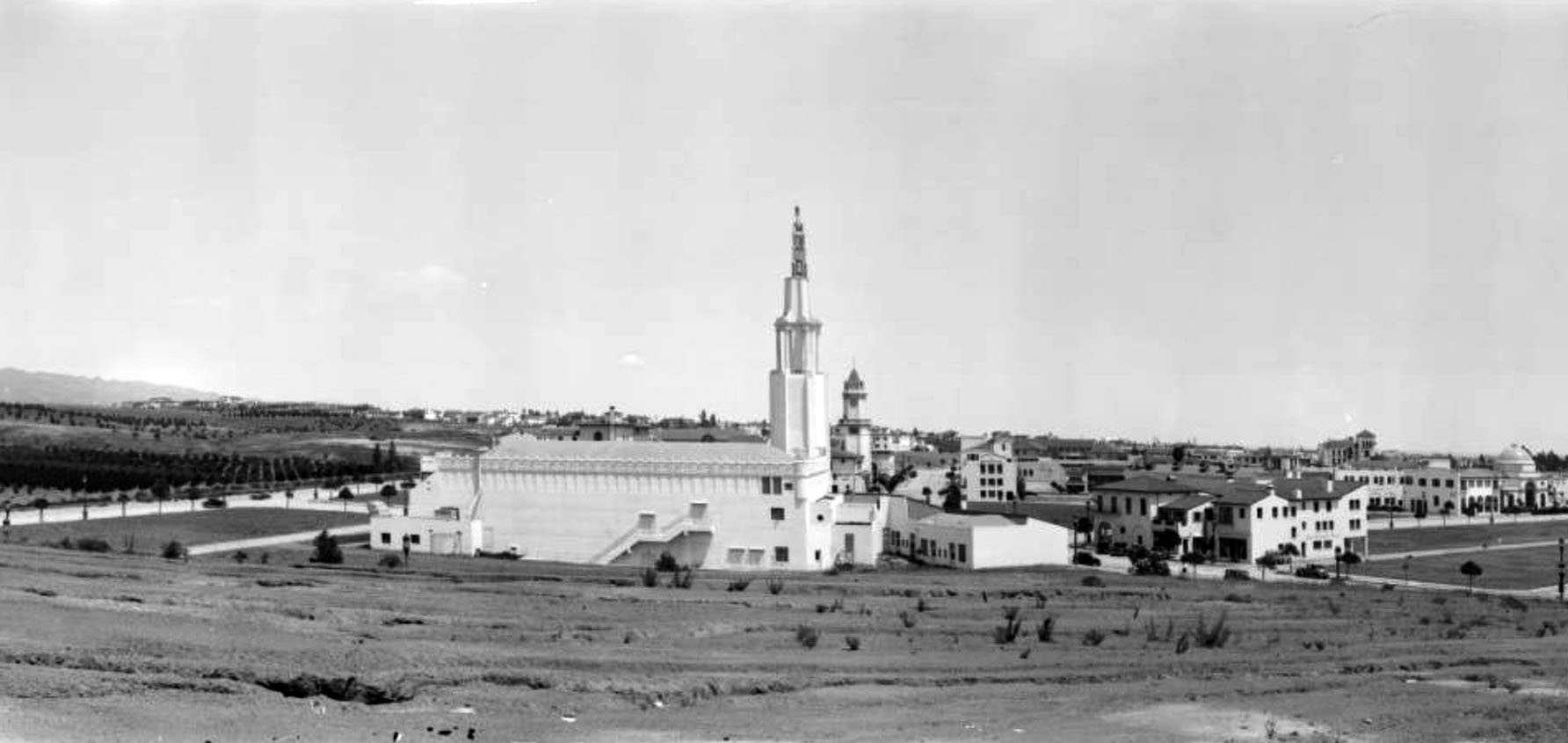 |
|
| (1933)#* – Panoramic view looking east of the Fox Theatre in Westwood Village. There is a large stretch of open space in the foreground, then the theater with its tall tower. The area to the right of the theater is mostly commercial, with stores like Ralphs, while to the left of the theater there is an orchard, and in the distance (out of view) the University of California, Los Angeles, campus. |
 |
|
| (1933)#* – Panoramic view looking east of the Fox Theatre in Westwood Village. There is a large stretch of open space in the foreground, then the theater with its tall tower. The area to the right of the theater is mostly commercial, with stores like Ralphs, while to the left of the theater there is an orchard, and in the distance (out of view) the University of California, Los Angeles, campus. Image enhancement and colorization by Richard Holoff. |
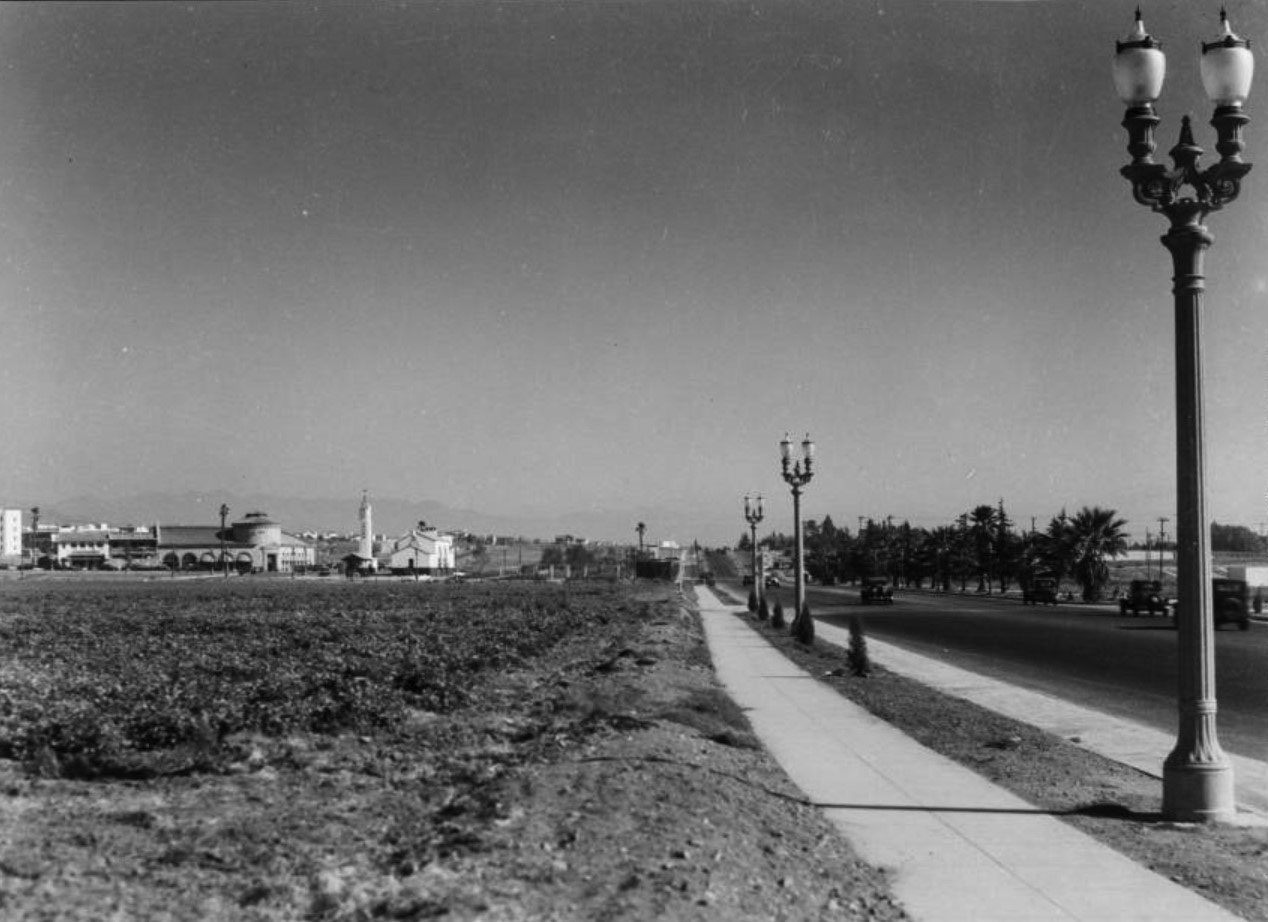 |
|
| (ca. 1930)#* - View looking east along the sidewalk adjacent to Wilshire Boulevard towards the new Westwood Village development. To the left can be seen the new Ralphs Market with its prominent rotunda. Note the ornate streetlamps running down Wilshire Blvd. Click HERE to see more Early LA Streetlights. |
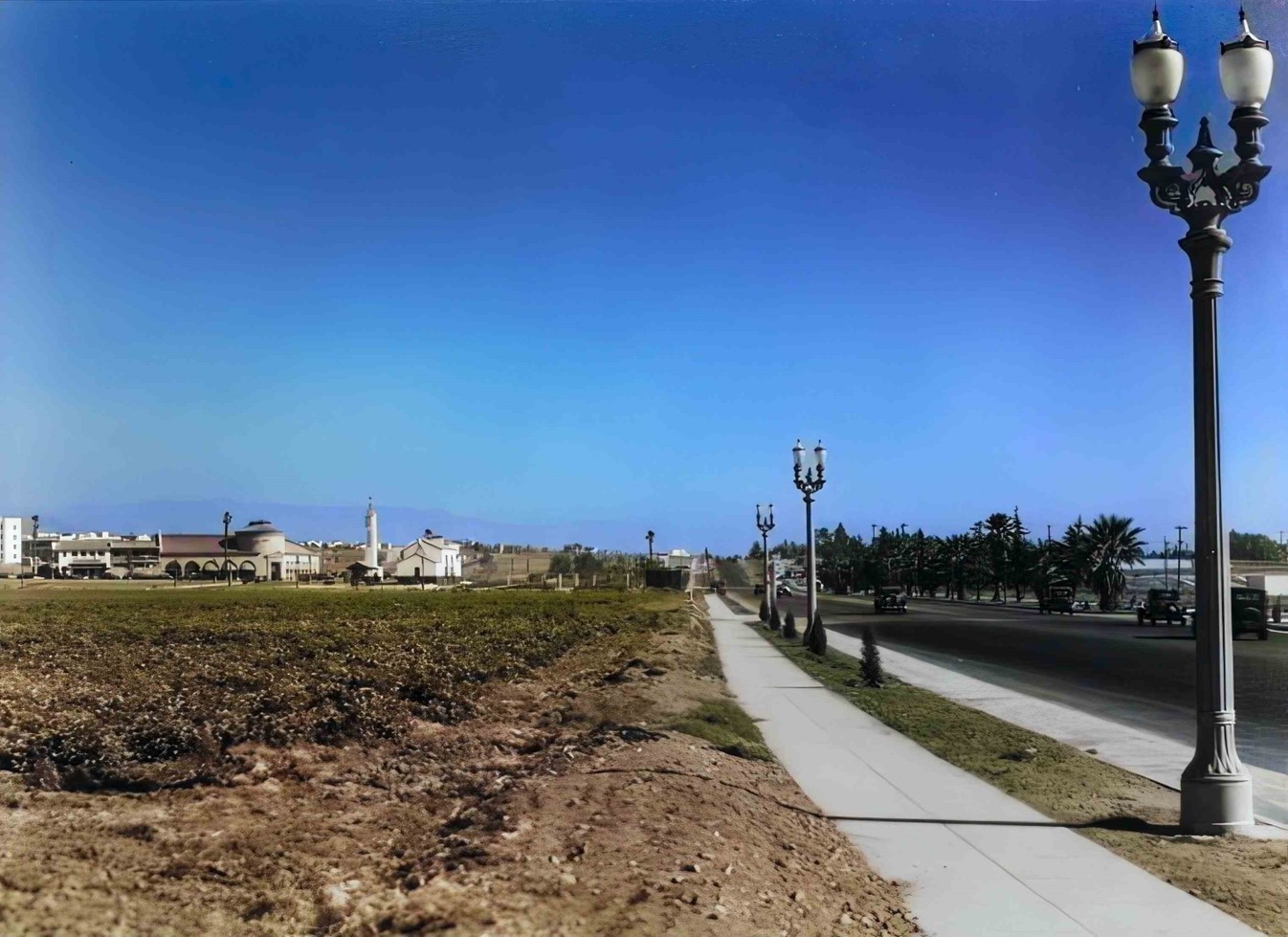 |
|
| (ca. 1930)#* - Looking east along sidewalk adjacent to Wilshire Boulevard towards the new Westwood Village development. To the left can be seen the new Ralphs Market with its prominent rotunda. Note the ornate streetlamps. Photo Source: Huntington Library, Ernest Marquez Collection; AI enhancement and colorization by Richard Holoff |
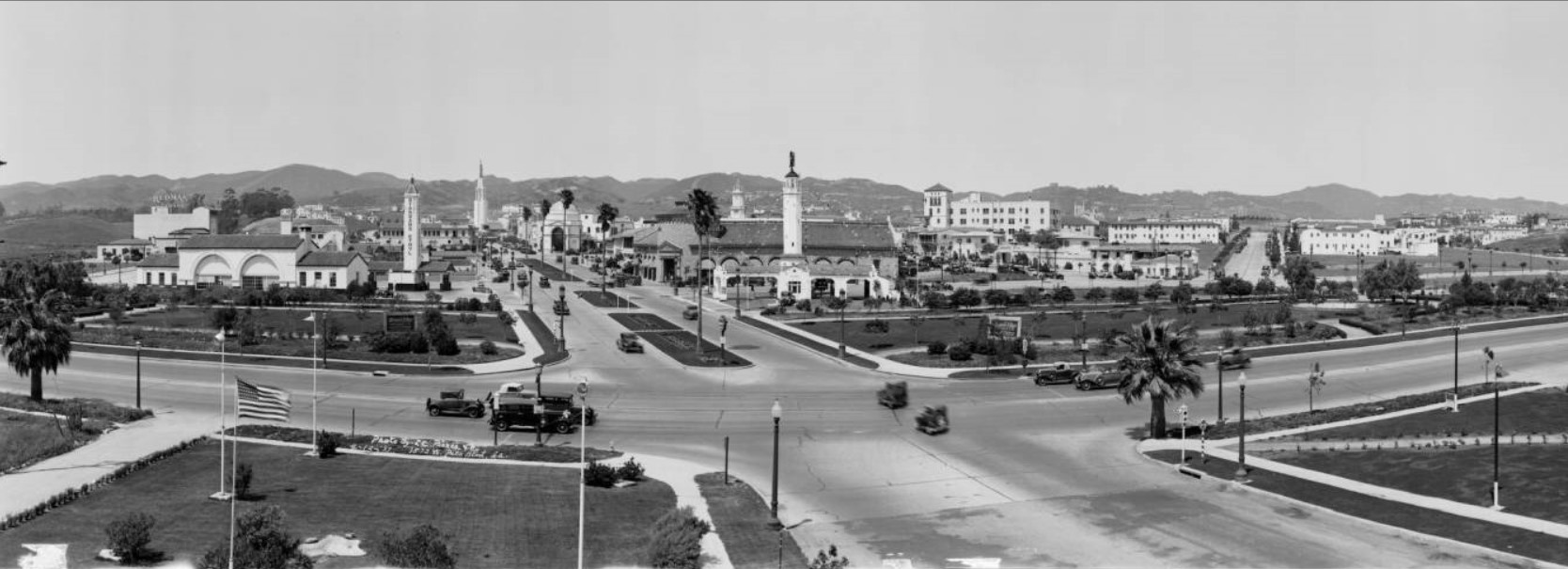 |
|
| (1932)#* - Panoramic view of Westwood facing north at the intersection of Wilshire and Westwood. Wilshire runs the width of the image, in the foreground. Westwood, with palm trees planted in the dividers, goes into the distance, past a variety of stores, including a Ralphs, gas stations, and Janss Dome. |
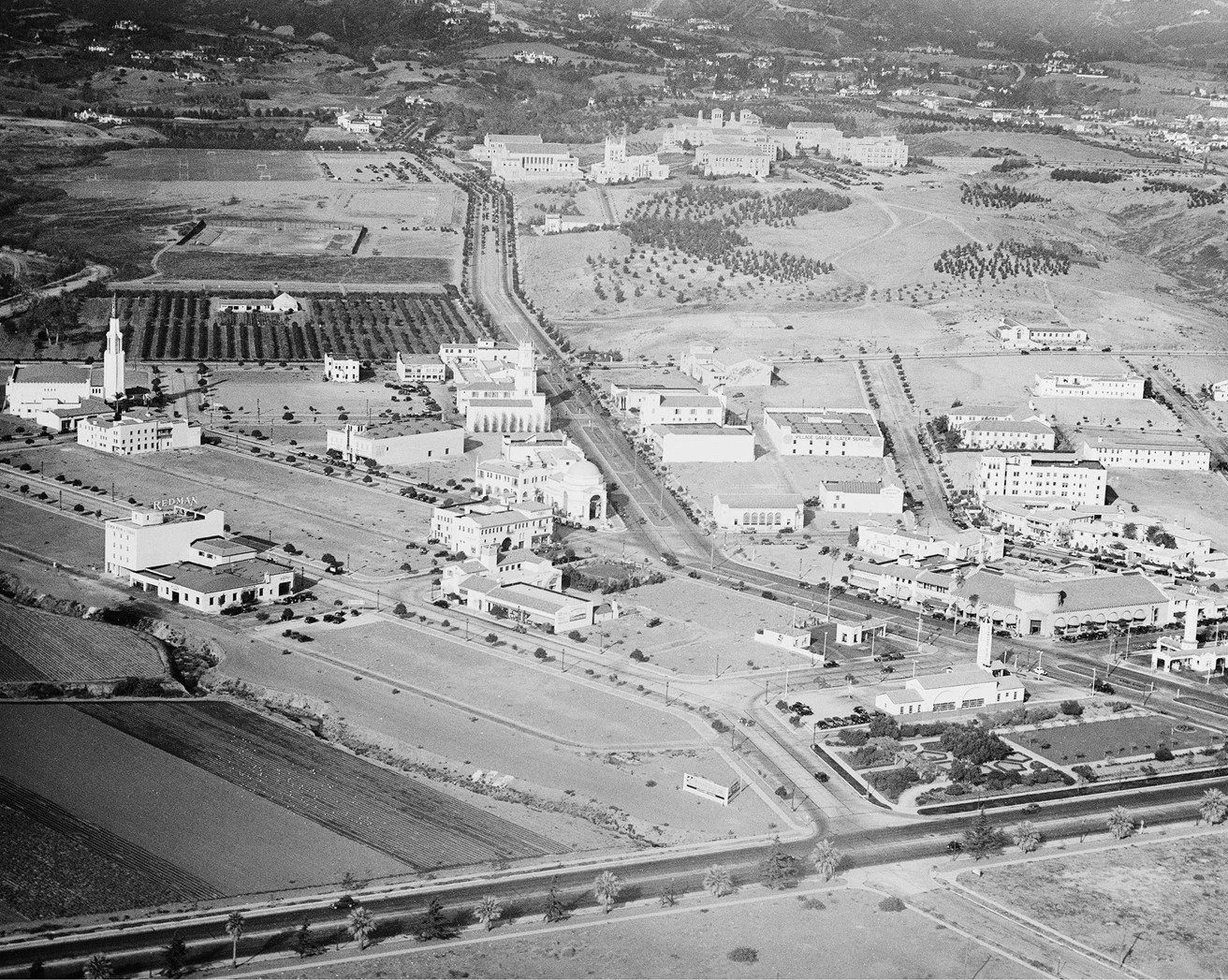 |
|
| (ca. 1933)* - Aerial view of Westwood and the UCLA campus. |
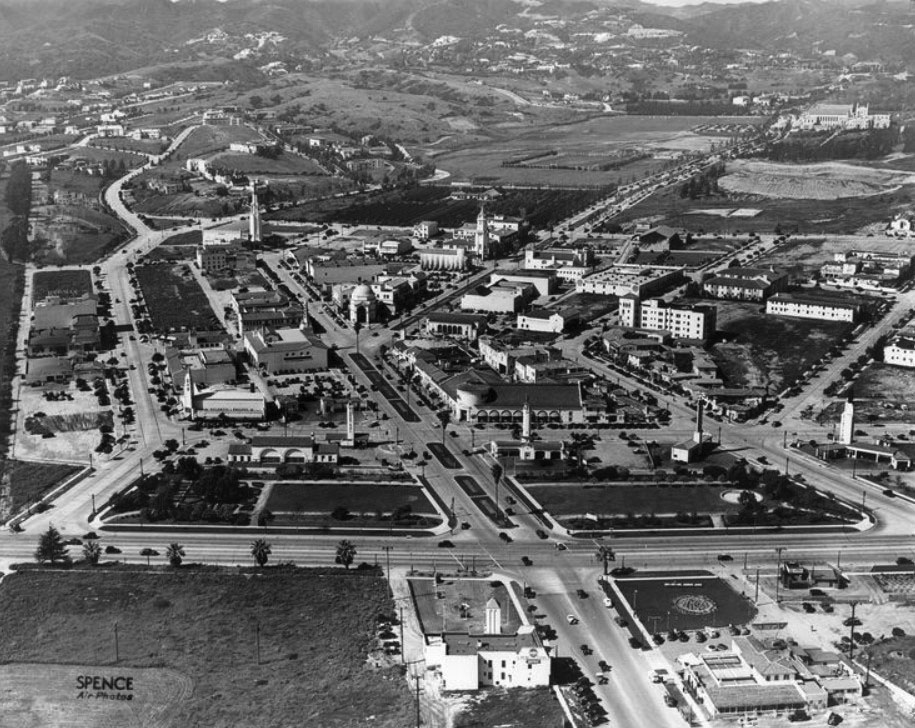 |
|
| (ca. 1936)#+ – Aerial view looking north showing Westwood Village with the intersection of Westwood and Wilshire boulevards seen in the foreground. |
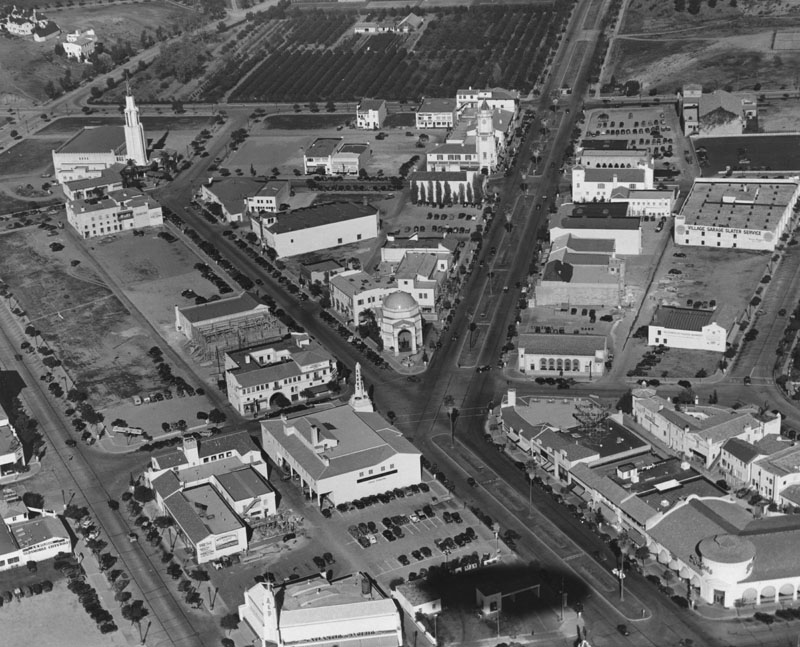 |
|
| (1936)* - Aerial view of Westwood Village from a blimp (note the shadow in the foreground). The Fox Theater is on the upper left, Ralphs lower right. At upper center is the Holmby Building with its clock tower. At center of photo, where Westwood Boulevard intersects Broxton Avenue, sits the Janss Dome Building, built in 1929. |
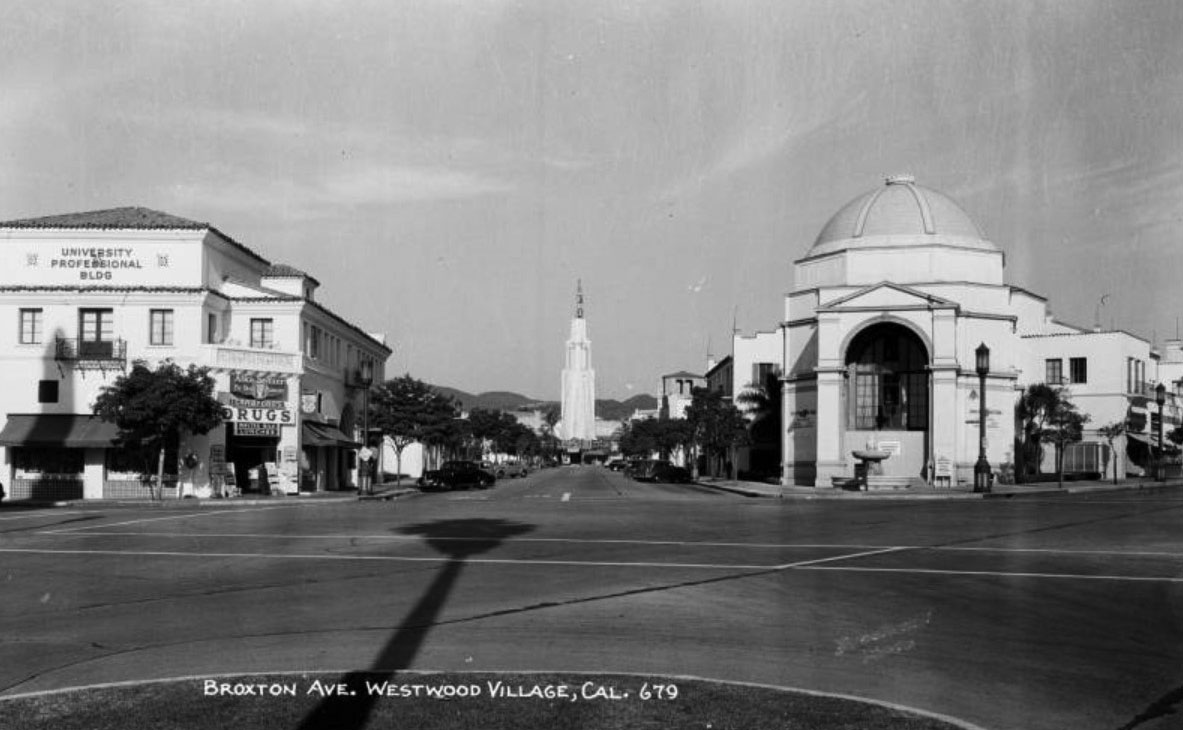 |
|
| (1930s)* – Postcard street view looking northwest showing the buildings at the intersection of Westwood Boulevard, Kinross Avenue, and Broxton Avenue in Westwood Village. At right is the Janss Dome building; at center in distance is the Fox Theater spire and marquee, and the University Professional Building with Crawford's Drug store. Signs on the drug store read "malted milk lunches" and "Alka-Seltzer - be wise alkalize." |
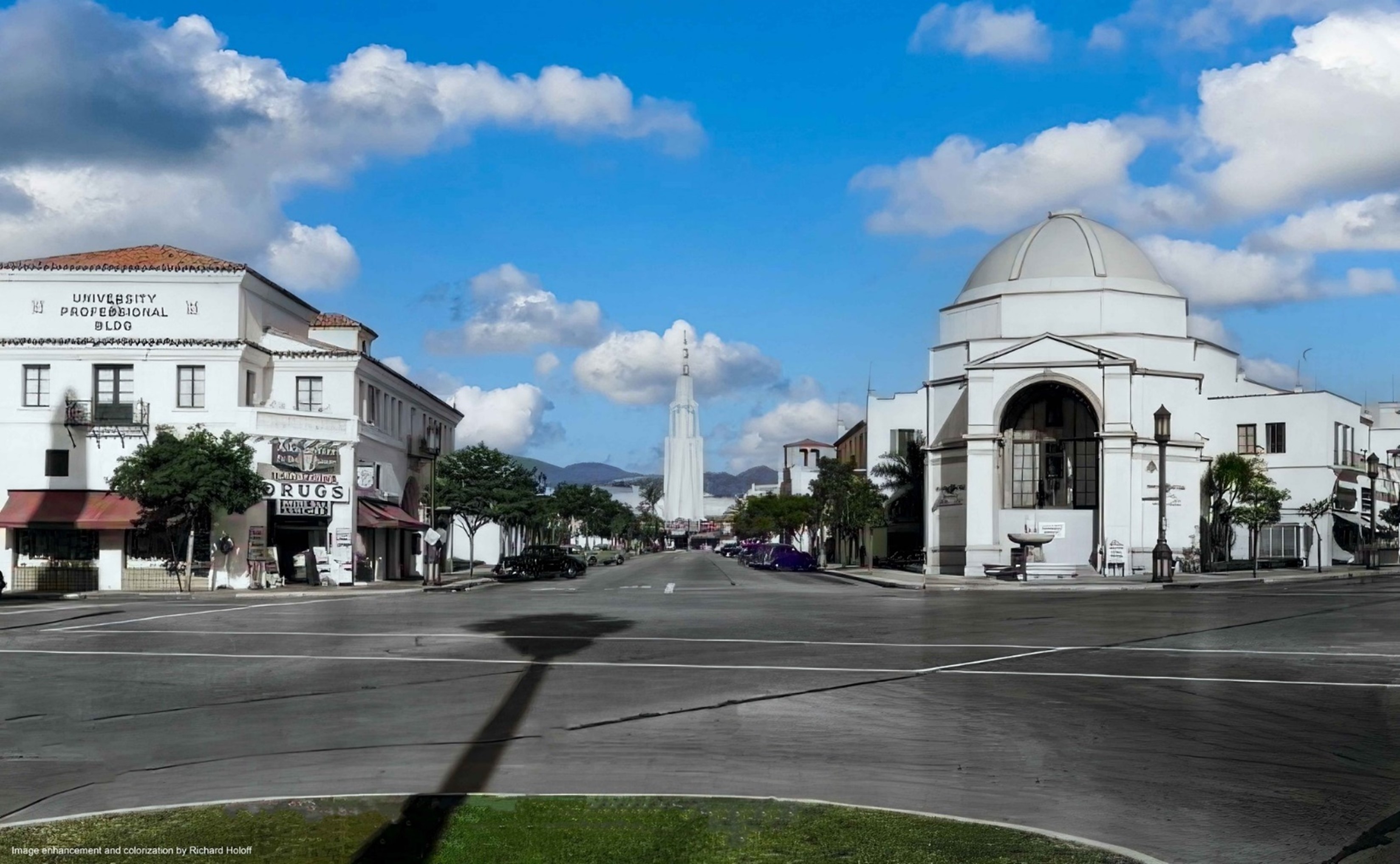 |
|
| (1930s)* – Postcard street view looking northwest showing the buildings at the intersection of Westwood Boulevard, Kinross Avenue, and Broxton Avenue in Westwood Village. At right is the Janss Dome building; at center in distance is the Fox Theater spire and marquee, and the University Professional Building with Crawford's Drug store. Signs on the drug store read "malted milk lunches" and "Alka-Seltzer - be wise alkalize." Image enhancement and colorization by Richard Holoff. |
Janss Dome
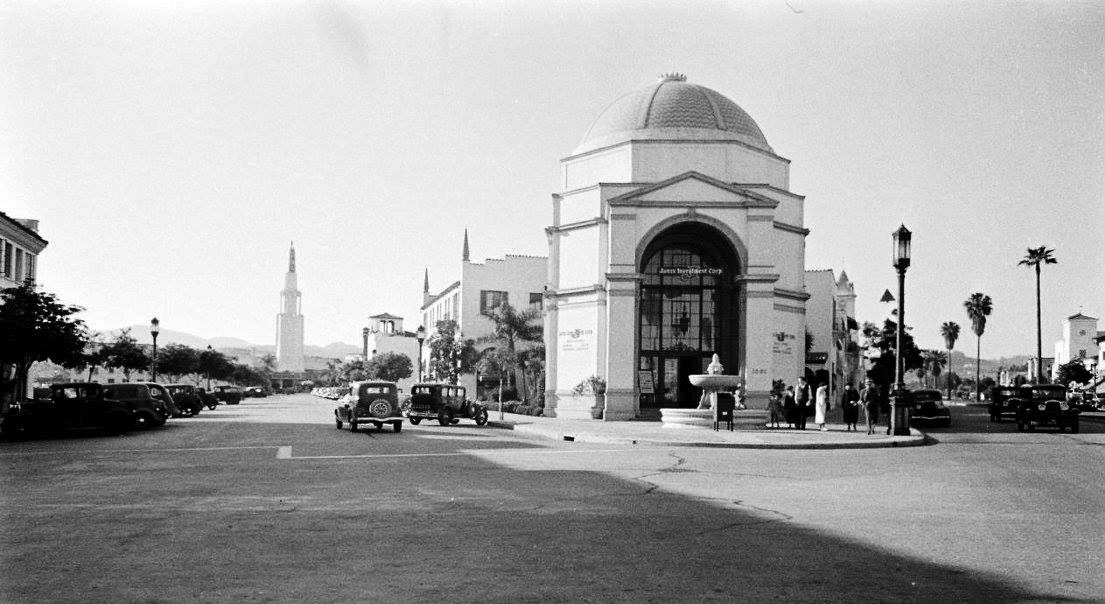 |
|
| (1930s)**# – Panoramic view showing the beautiful Bank of America Building (aka Janss Dome) at the intersection of Broxton Ave (left) and Westwood Boulevard (right). The iconic tower of the Fox Theatre can be seen at the end of Broxton Ave. |
Historical Notes In 1929 the Janss Dome was the first building erected in the Mediterranean-themed Westwood Village. It housed the headquarters of the Janss Investment Company run by the Janss brothers, Edwin and Harold Janss, who were the developers of the village. The village was built as a shopping and cinema precinct to serve the adjacent University of California, Los Angeles (UCLA). The second floor of the Janss building was the first male dormitory for UCLA students.*^ |
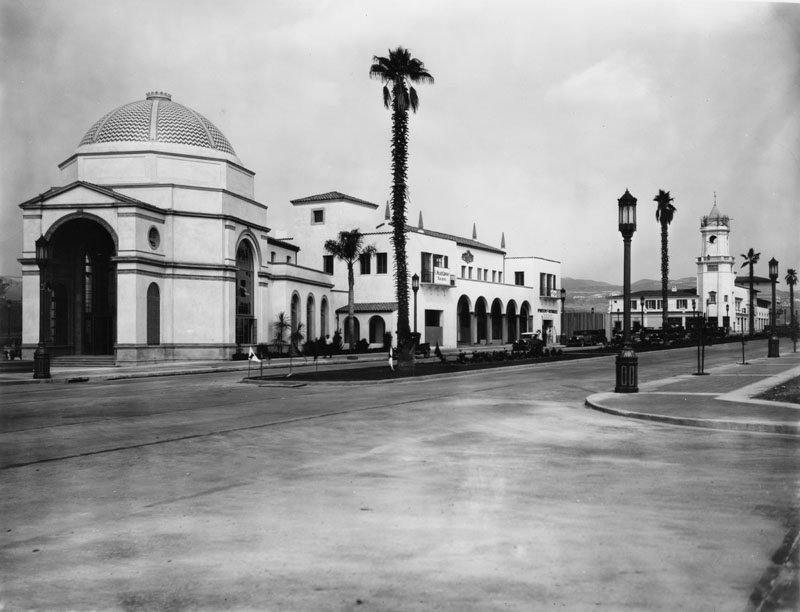 |
|
| (ca. 1930)* - A view of Westwood Boulevard's Bank of America building (also Janss Dome), P. J. Walker Company and Phelps Terkel. |
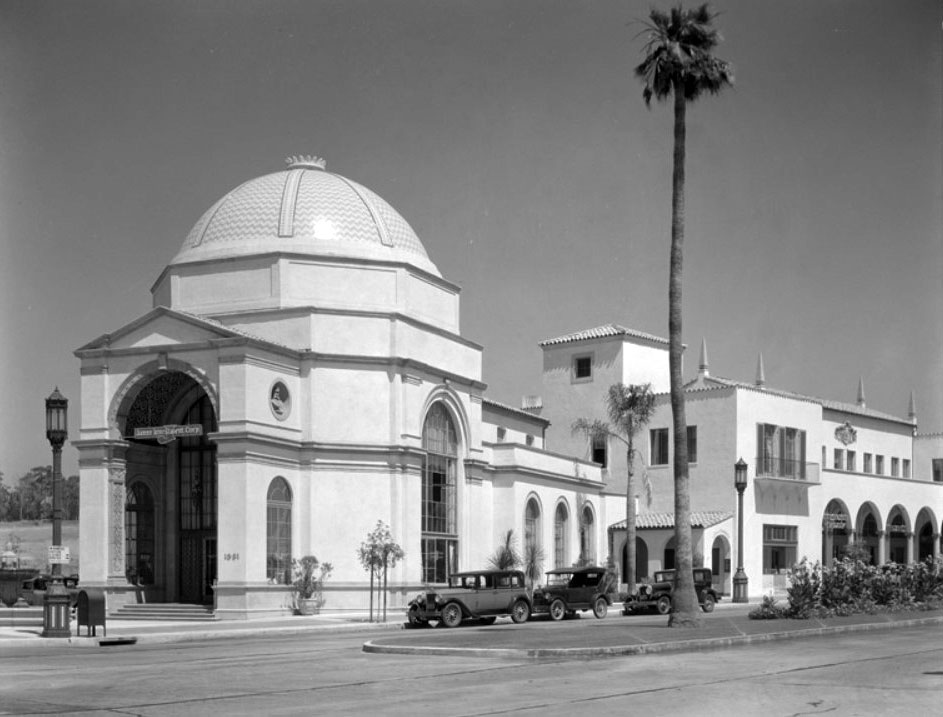 |
|
| (ca. 1930s)#^ - Closer view of the Janss Dome located at the intersection of Westwood Boulevard and Broxton Ave. |
Historical Notes The Janss Brothers' headquarters in Westwood Village, the Janss Investment Company Building or Janss Dome, was opened in 1929. The Dome stands today as one of the iconic buildings of Westwood Village. The firm's Janss Investment Co. "stamps" embellish sidewalks in many Westside residential neighborhoods.*^ |
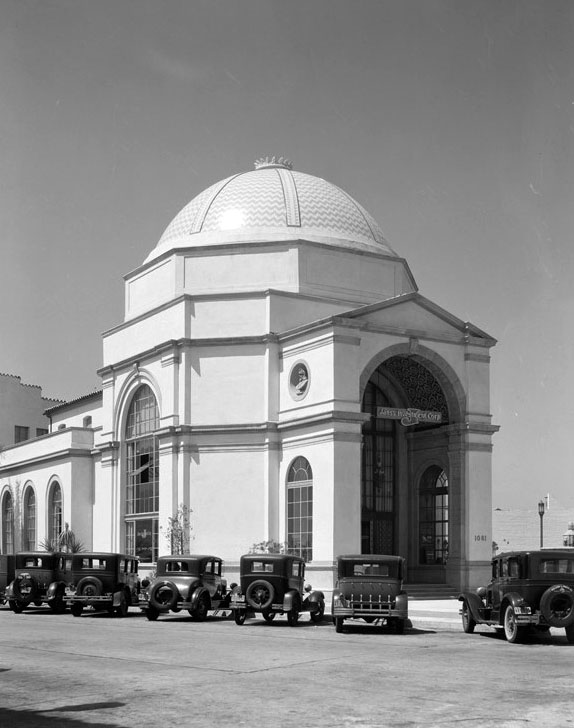 |
|
| (ca. 1930s)#^ - View showing the front entrance to the Janss Dome. Sign near the top of the arch reads Janss Investment Comp. with a large letter "J" overlapping it. |
Historical Notes In 1988, the Janss Investment Company Building (Janss Dome) was dedicated as a Los Angeles Historic-Cultural Monument No. 364 (Click HERE to see complete listing). It is also listed in the U.S. National Register of Historic Places. |
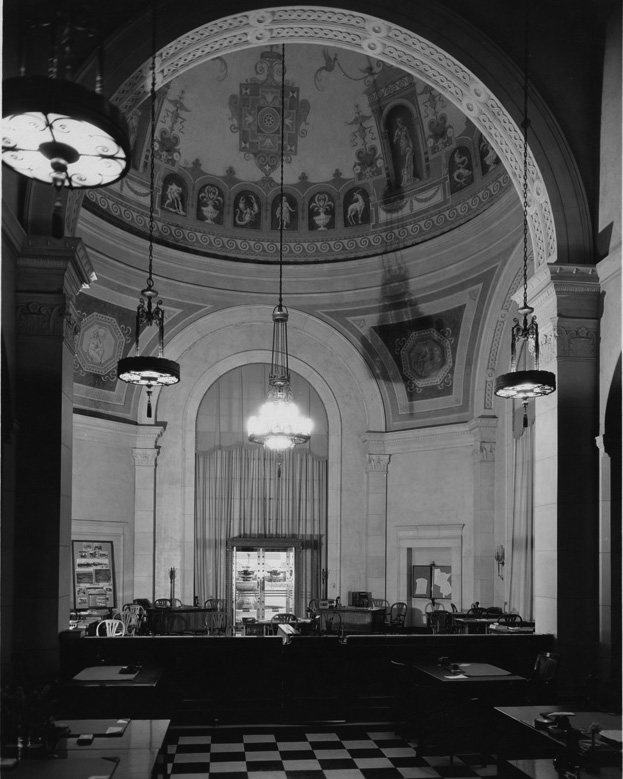 |
|
| (ca. 1930s)#^ - Interior view of the ornately designed Janss Dome circa 1930s. |
Historical Notes The Janss Dome was designed by the architectural firm of Allison & Allison who also designed UCLA’s Royce Hall and Kerckhoff Hall. Architectural features of the building include a high portico and arched windows with the main part of the building having an octagonal shape and being surmounted by its signature dome with its Moorish style aqua and white zig-zag pattern and gold leafing. Atop the dome is a cupola.*^ |
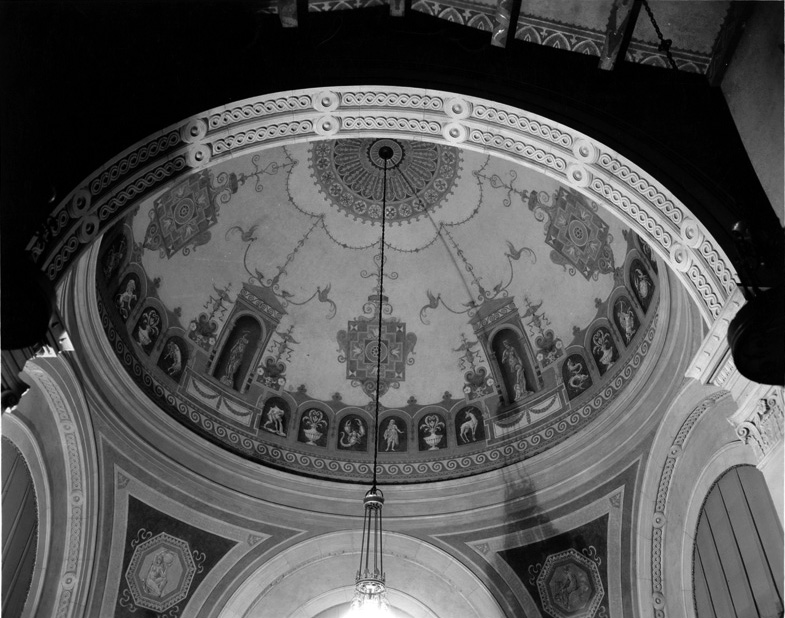 |
|
| (ca. 1930s)#^ - Looking up at the beautiful rotunda ceiling of the Janns Dome Building. |
Historical Notes Around the beginning of the 1990s renowned architectural firm Morphosis adapted the Dome for use as a clothing store by Contempo Casuals, and later it was occupied by a Wherehouse Music store. In 1998 restaurateur Michael Chow remodelled the interior for a Eurochow restaurant but had the time-honored aqua and white zig-zag on the rotunda painted over in white. This caused the Westwood Design Review Board to order that the dome be restored to its traditional decoration. The Janss Dome currently houses a Japanese restaurant, the Yamato.*^ |
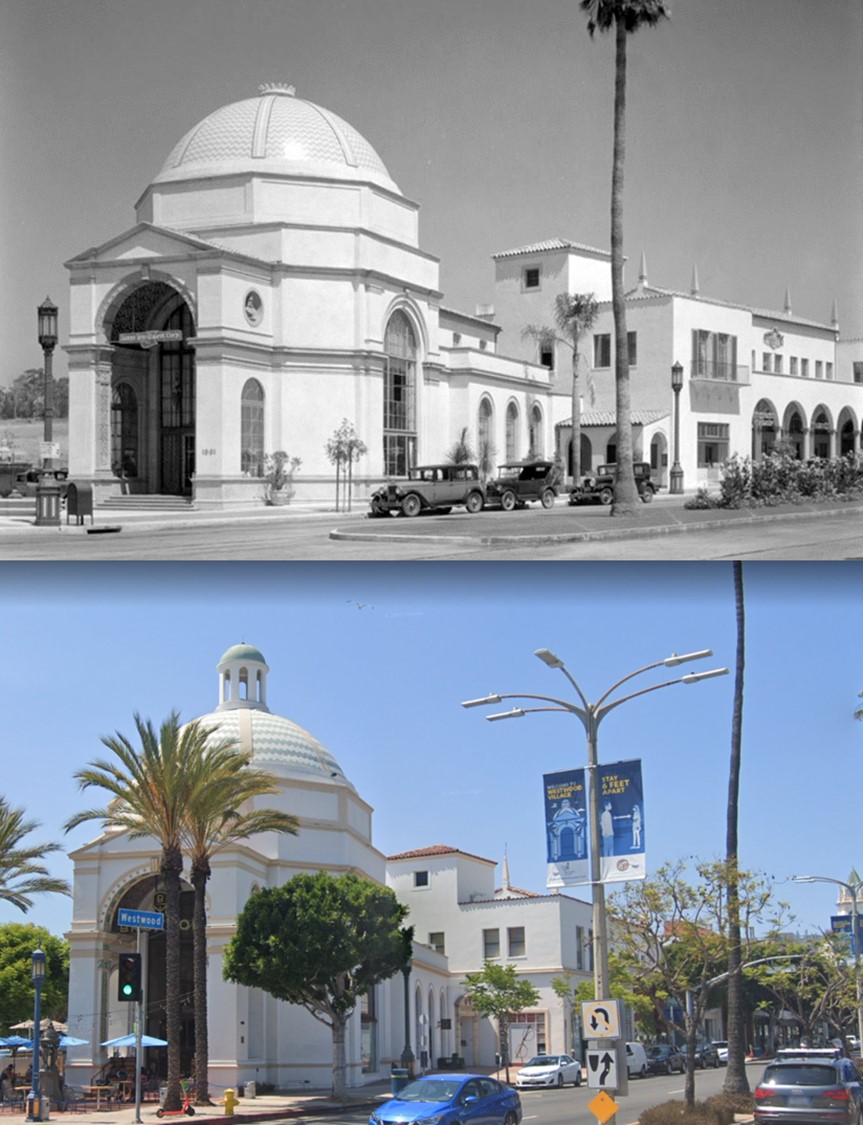 |
|
| Then and Now* – In 1929 the Janss Dome was the first building erected in the Mediterranean-themed Westwood Village. It was designed by the architectural firm of Allison & Allison, who also designed UCLA’s Royce Hall and Kerckhoff Hall. |
Historical Notes The building is currently (2022) occupied by the Broxton Brewery & Public House. |
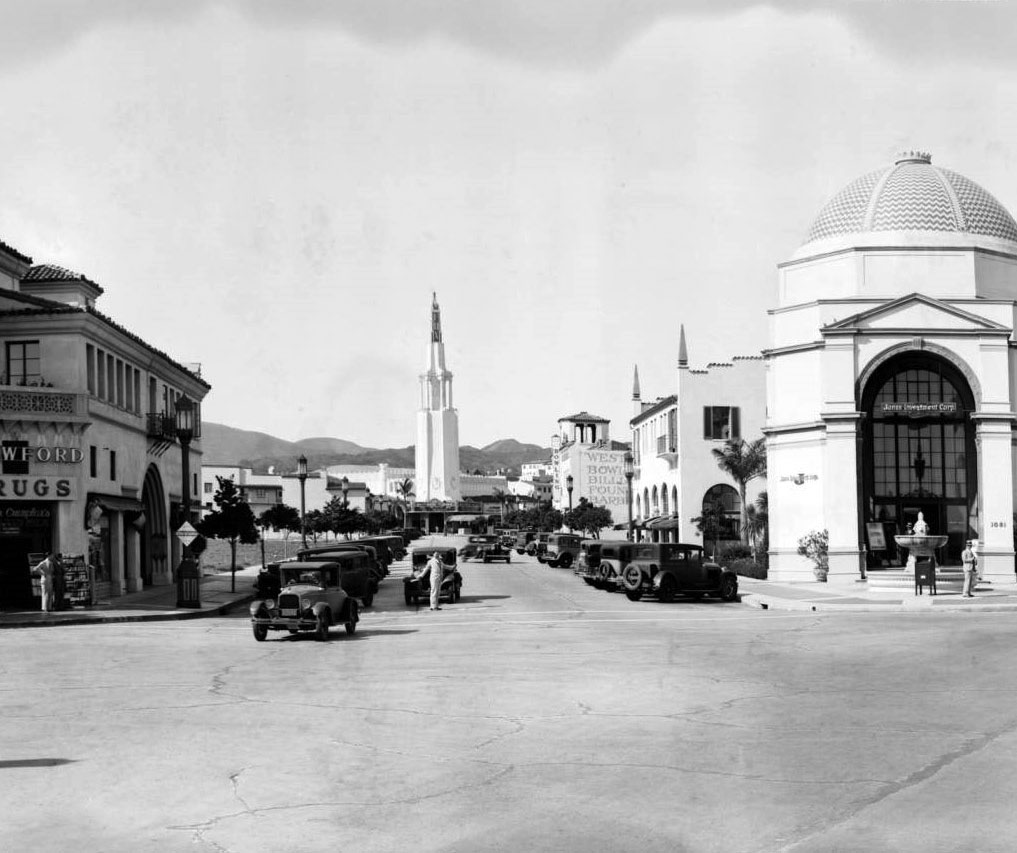 |
|
| (1932)#* - View looking north on Broxton Avenue with the tower of the Fox Theatre in the distance and the Janss Dome on the right. |
Historical Notes The Janns Dome ranks alongside the white Spanish Revival/Moderne tower of the Fox Theater as an iconic landmark of Westwood Village. |
 |
|
| (1932)#* - A panoramic view of Westwood Village in Westwood, Los Angeles. The domed building in the center is the Janss Investment Corp., and the road to the right of it is Westwood. Left of that is the University Professional Building, with Crawford Drugs at the corner on the ground level. The spire down the street between Janss and the Professional building is the Fox Theatre. Across Westwood from Janss is the Citizens National Trust & Savings Bank. On the west side of Westwood in the background is the tower of the Holmby Building. The cross street is now Kinross Avenue, while the street leading to the theater is Broxton. |
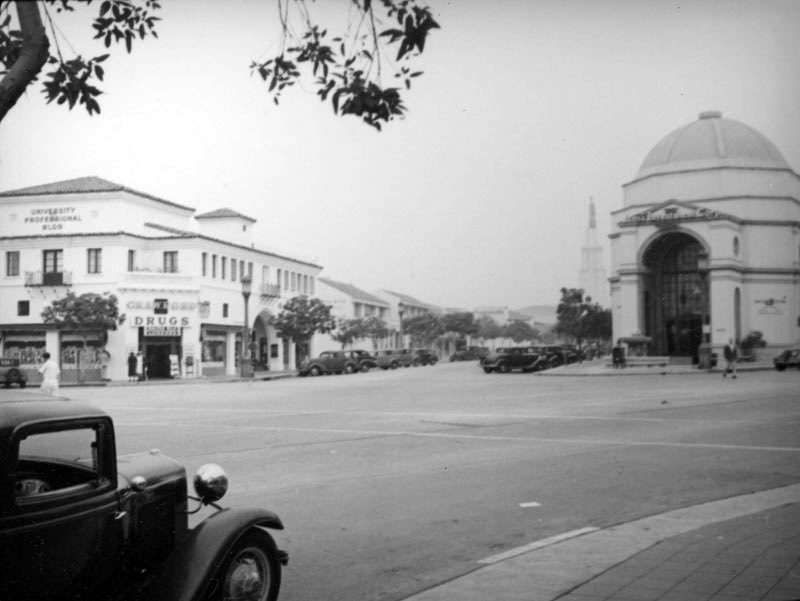 |
|
| (ca. 1940)*- View of Westwood Boulevard, Westwood Village, showing Crawford Drugs and the Janss Dome housing Janss Investment Company--the developers of Westwood. |
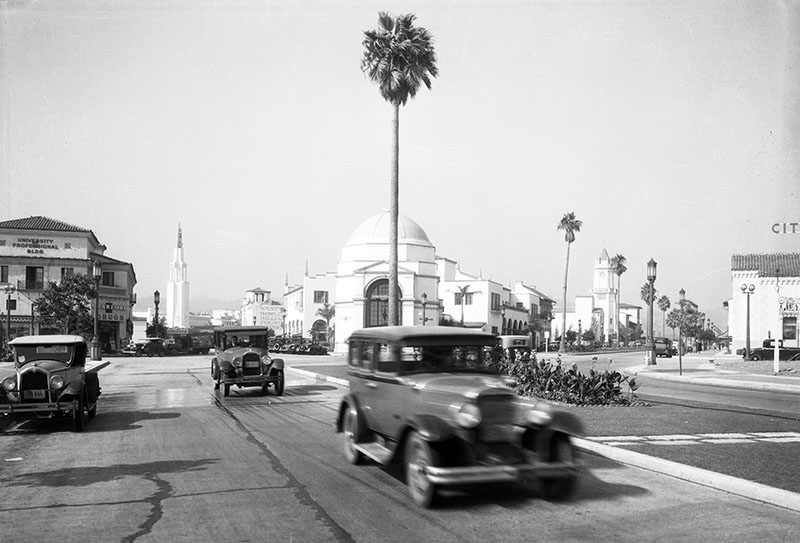 |
|
| (1932)* - View looking north up Westwood Boulevard from south of Kinross Avenue. |
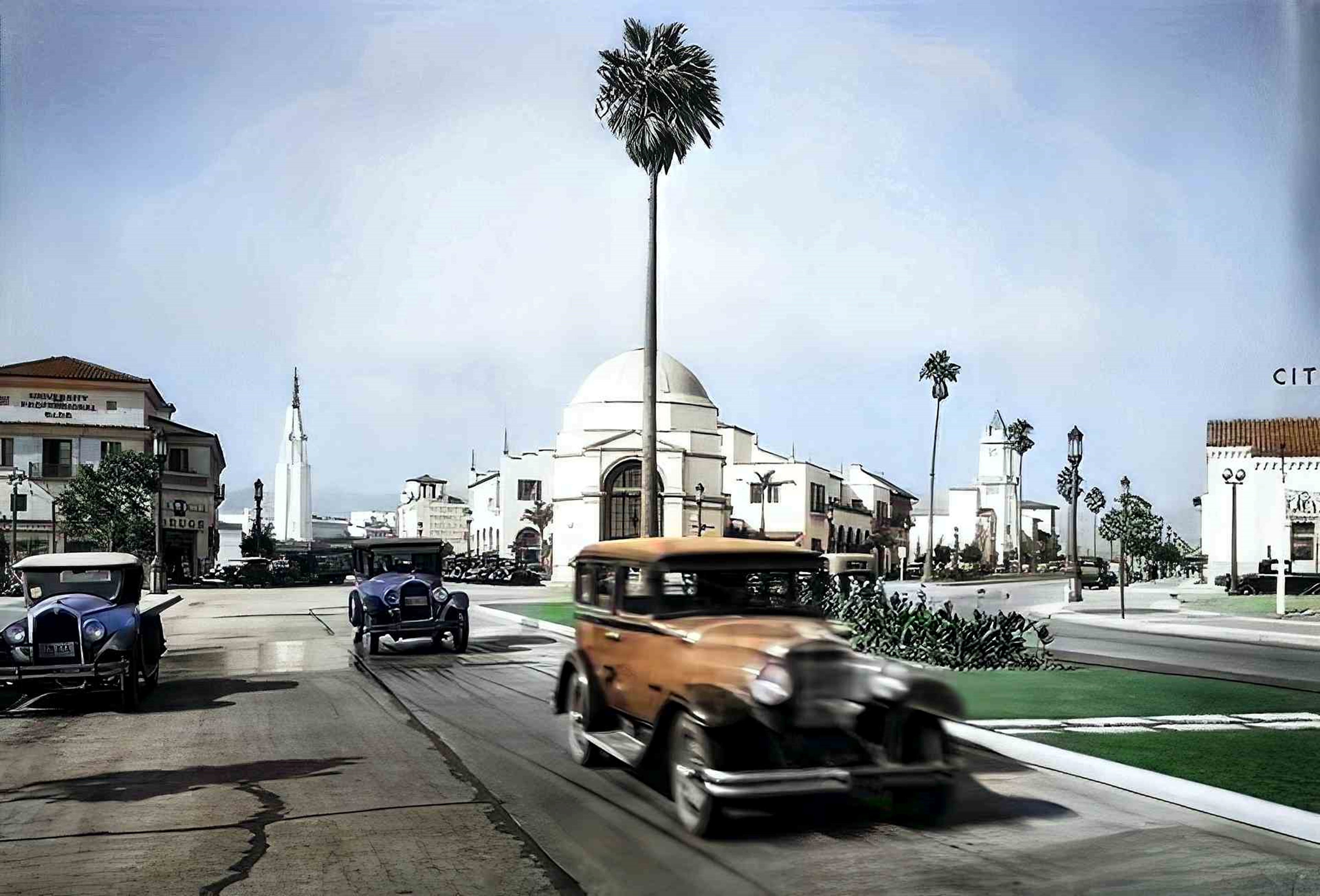 |
|
| (1932)* - View looking north up Westwood Boulevard from south of Kinross Avenue. Image enhancement and colorization by Richard Holoff |
Then and Now
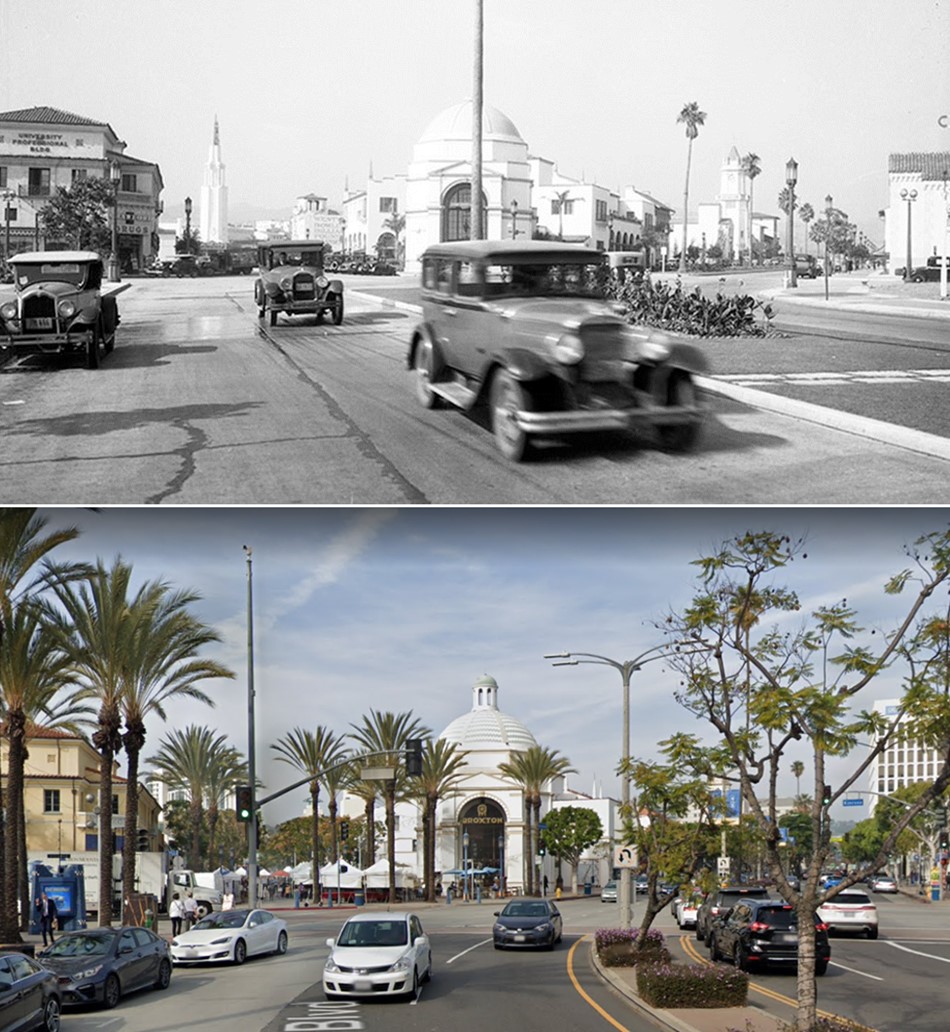 |
|
| (1932 vs 2021)* – Looking north up Westwood Boulevard from south of Kinross Avenue. |
 |
|
| (1932)#* - View looking north on Westwood Boulevard from Kinross Avenue. The tall clock tower in the distance is the Holmby Building. The building on the N/E corner of Westwood and Kinross is the Citizens National Trust & Savings Bank. |
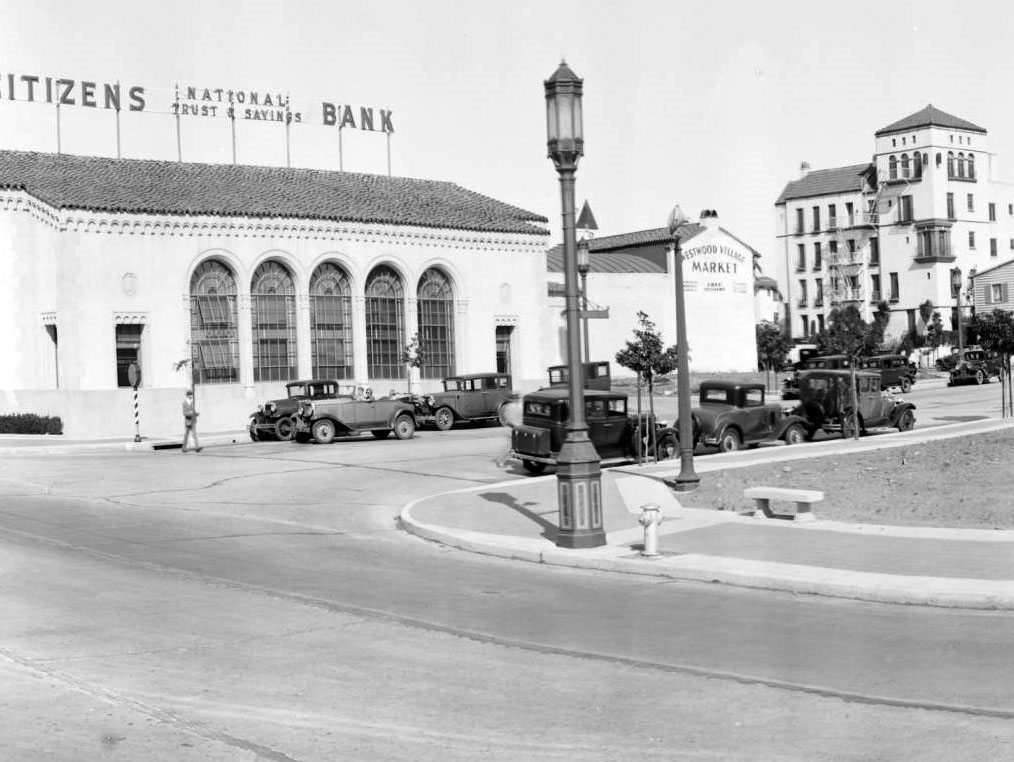 |
|
| (1932)*** – View looking northeast showing the intersection of Westwood Boulevard and Kinross Avenue. Citizens National Trust & Savings Bank is on the N/E corner. On the S/E corner stands a “Westwood Special” streetlamp. Click HERE to see more Early LA Streetlights. |
Historical Notes Citizens began as a state bank in 1890 at Third and Spring in Los Angeles. In 1928, Citizens merged with Citizens Trust and Savings, creating Citizens National Trust & Savings Bank of Los Angeles. Architect William V. Kernan designed the original 1930 Spanish Colonial Revival University-Westwood branch location at 1088 Westwood Boulevard, with brick construction covered with stucco and featuring an art stone entrance and a coffered paneled ceiling. This branch was replaced in 1952 by a new building designed by Stiles Clements, located at 10925 Kinross.* |
Holmby Hall Building
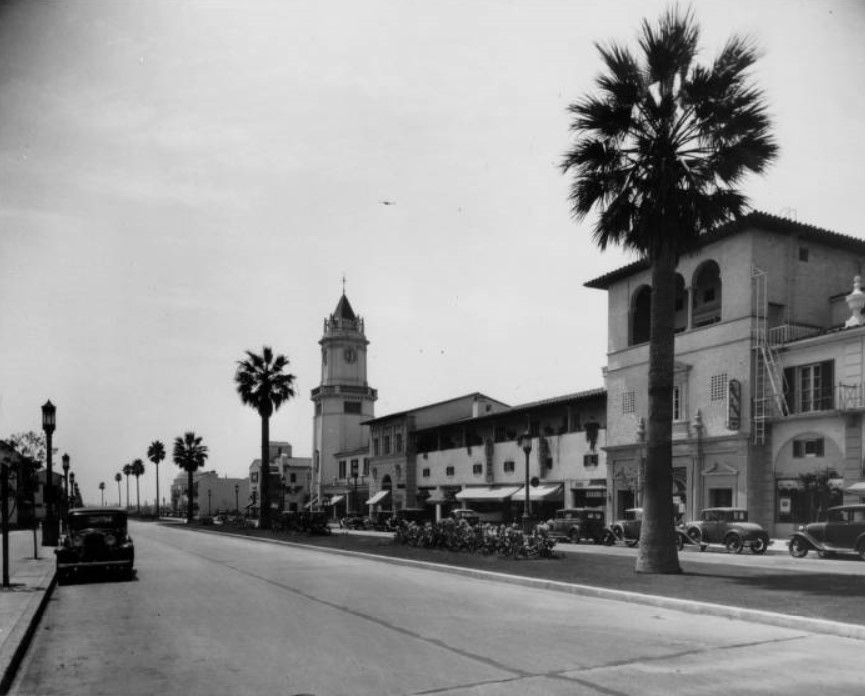 |
|
| (1931)^^ - View looking south at car-lined Westwood Boulevard. The tall clock tower in the distance is part of the Holmby Hall Building. |
Historical Notes The name Holmby was loosely derived from the name of Arthur Letts' birthplace, a small hamlet in England called Holdenby. It was also the name of Letts' new development “Holmby Hills” and his estate in Hollywood. |
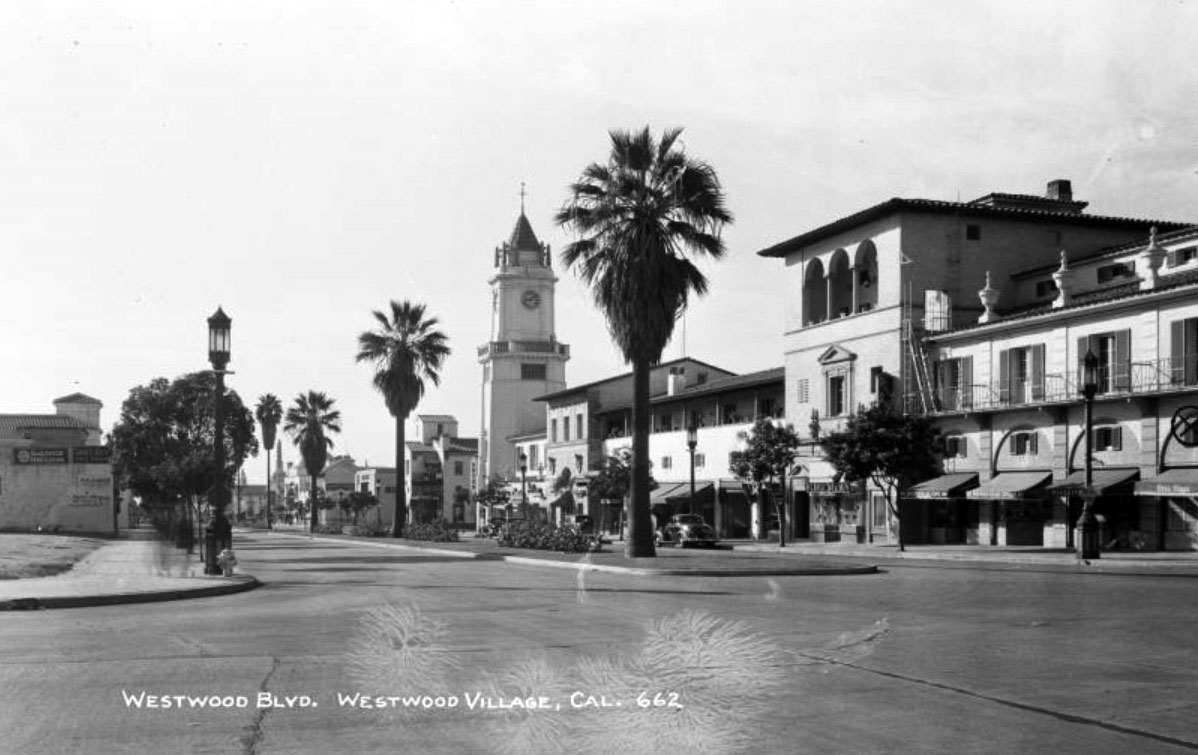 |
|
| (1930s)#* - Postcard view looking south on Westwood Boulevard from Le Conte Avenue. The Holmby Building with clock tower can be seen at center, located at 921 Westwood Blvd. |
Historical Notes Built in 1929, Holmby Hall is a streetscape of six Spanish Colonial Revival storefronts and features a prominent white clock tower, capped by a green pinnacle. It was the first shop building to be erected in the architecturally significant cinema/shopping precinct of Westwood Village.*^ |
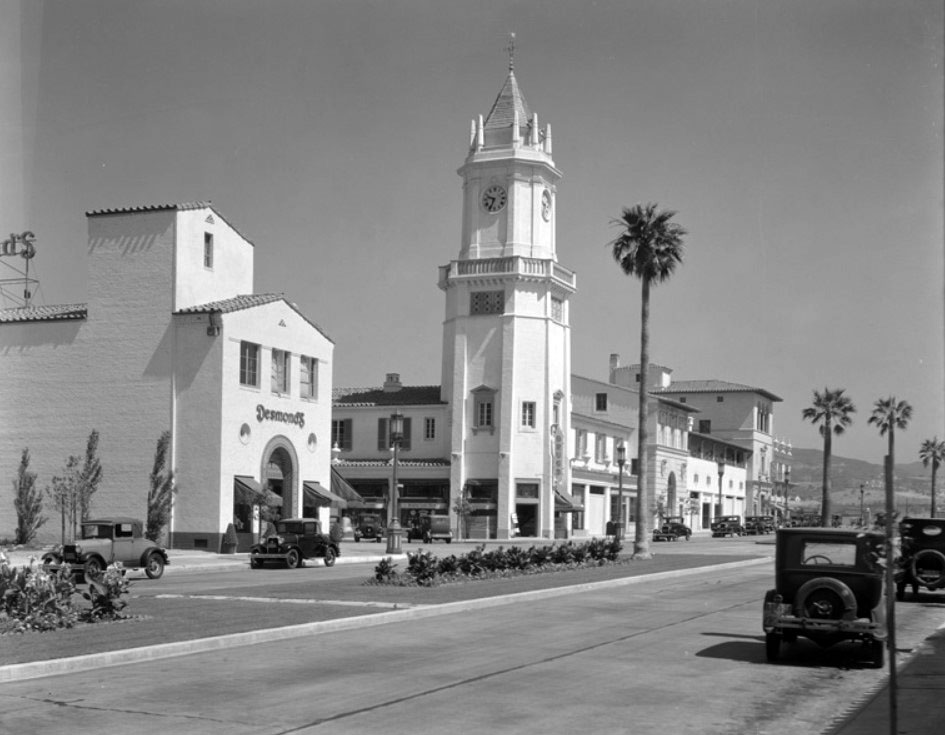 |
|
| (ca. 1930)#^ – View looking north showing the beautiful Holmby Building with its clock tower at the corner of Westwood Blvd and Weyburn Ave. |
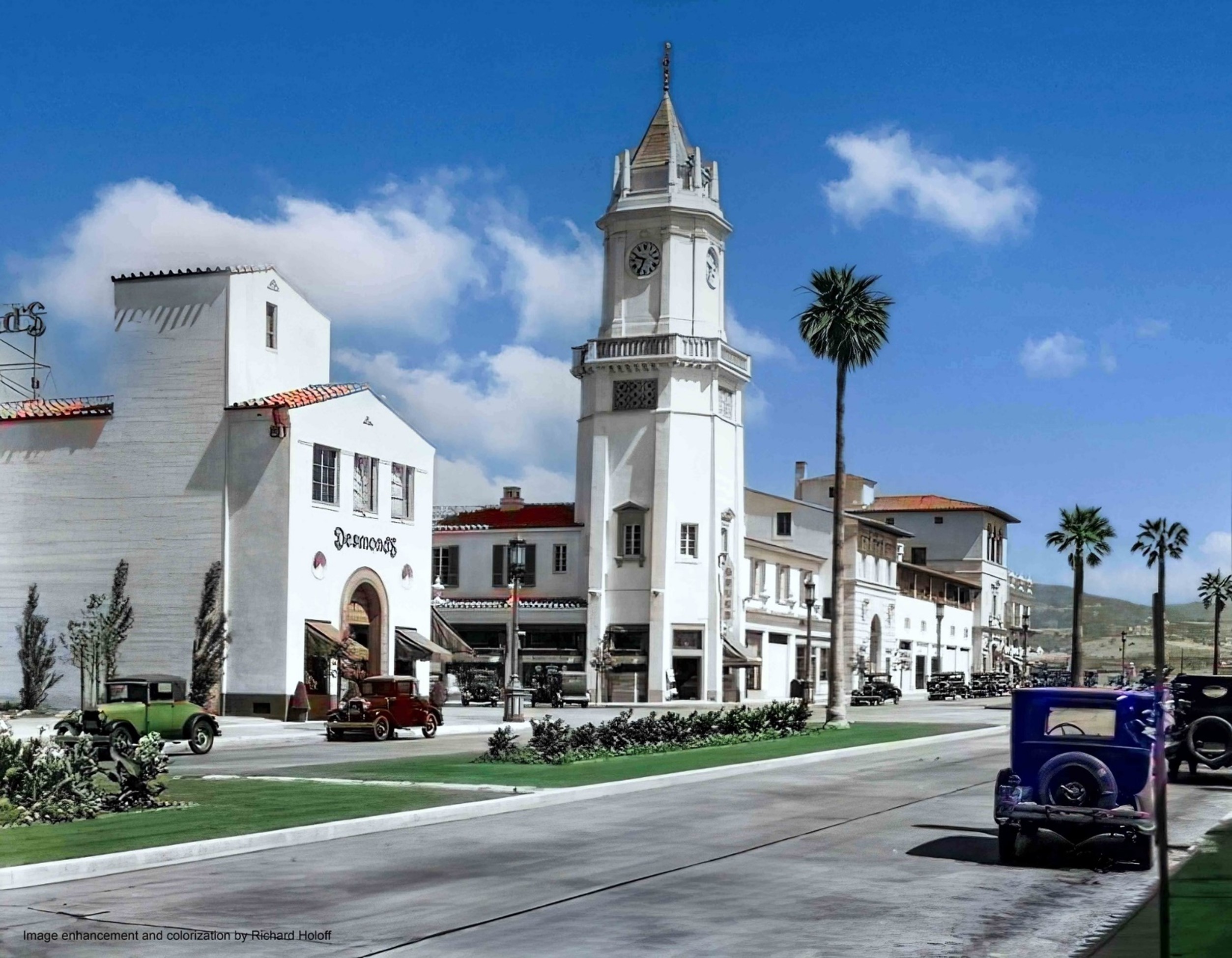 |
|
| (ca. 1930)#^ – View looking north showing the beautiful Holmby Building with its clock tower at the corner of Westwood Blvd and Weyburn Ave. Image enhancement and colorization by Richard Holoff. |
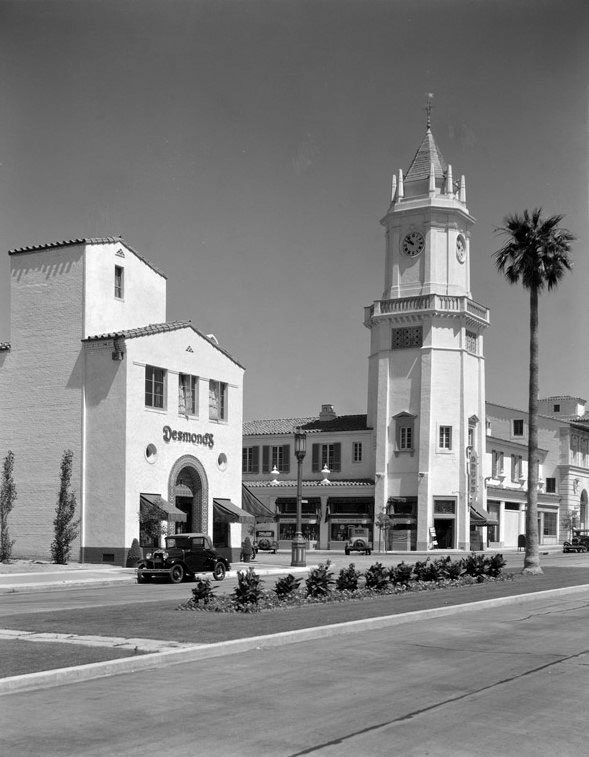 |
|
| (ca. 1930)#^ – View looking north toward the intersection of Westwood Boulevard and Weyburn Avenue, showing Desmond's Department Store on the S/W corner and the Holmby Building on the N/W corner. |
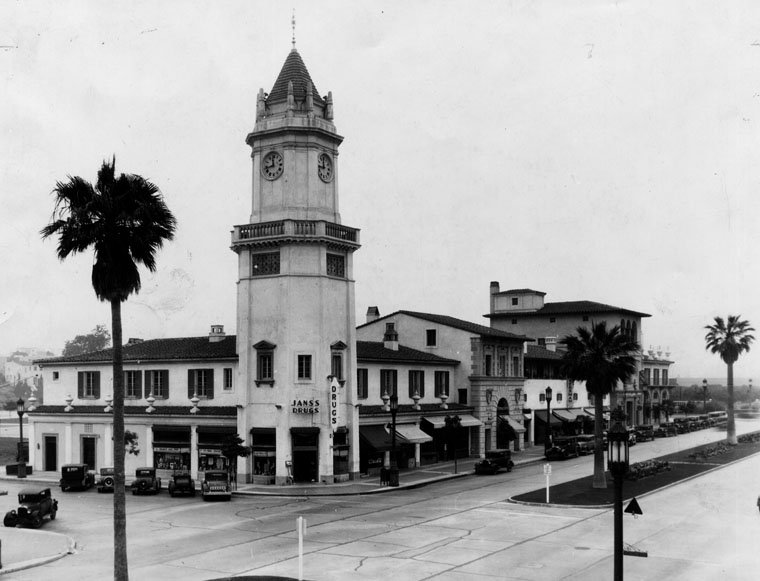 |
|
| (1932)* - Exterior view of Holmby Building, designed by Gordon B. Kaufmann, in Westwood Village. |
Historical Notes Holmby Hall’s history is tied in with that of UCLA, as the building was used as the first dormitory for female students of that famous university.*^ |
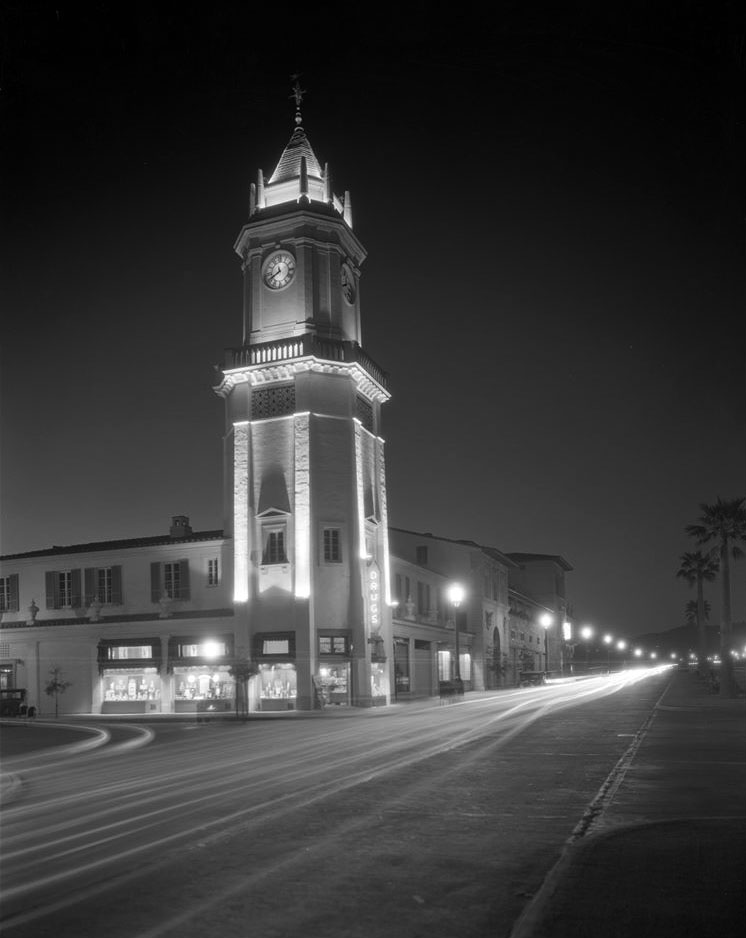 |
|
| (1930)^ - Nightime view of the Westwood Drug Store with the Clock Tower. |
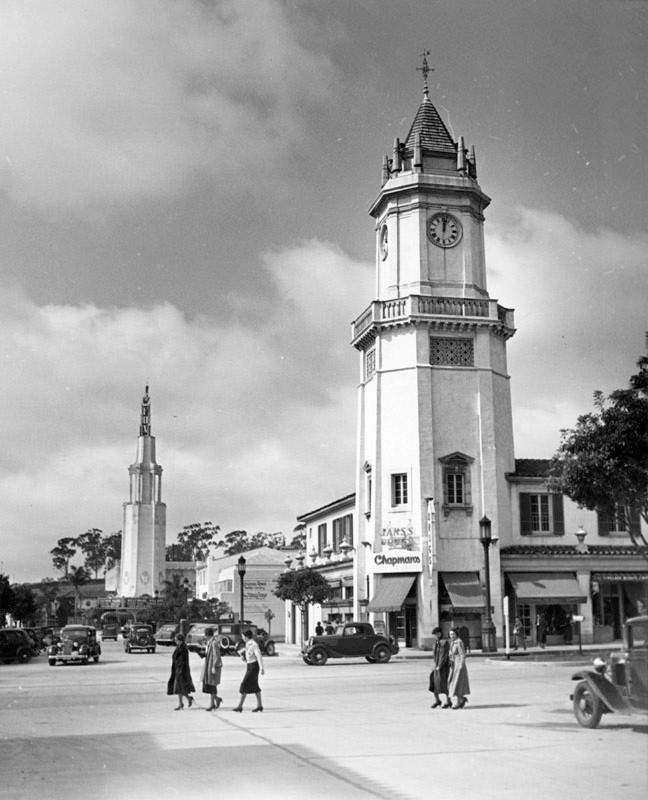 |
|
| (ca. 1938)* - A street scene looking west on Weyburn Ave at Westwood Boulevard. The Holmby Building stands tall on the northwest corner with Chapmans occupying the corner store. Down the street is Fox Westwood Village Theater. |
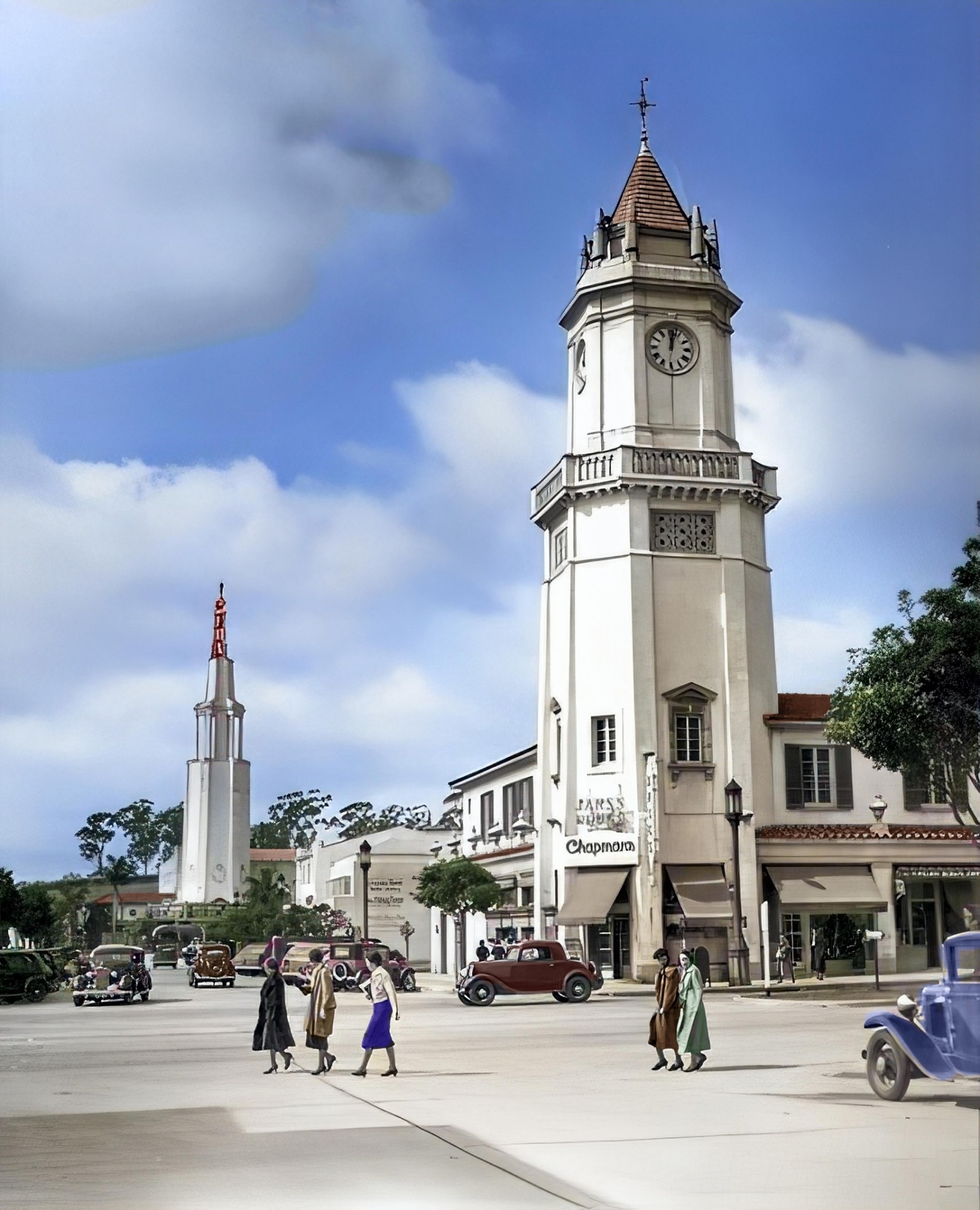 |
|
| (ca. 1938)* - A street scene looking west on Weyburn Ave at Westwood Boulevard. The Holmby Building stands tall on the northwest corner with Chapmans occupying the corner store. Down the street is Fox Westwood Village Theater. Image enhancement and colorization by Richard Holoff |
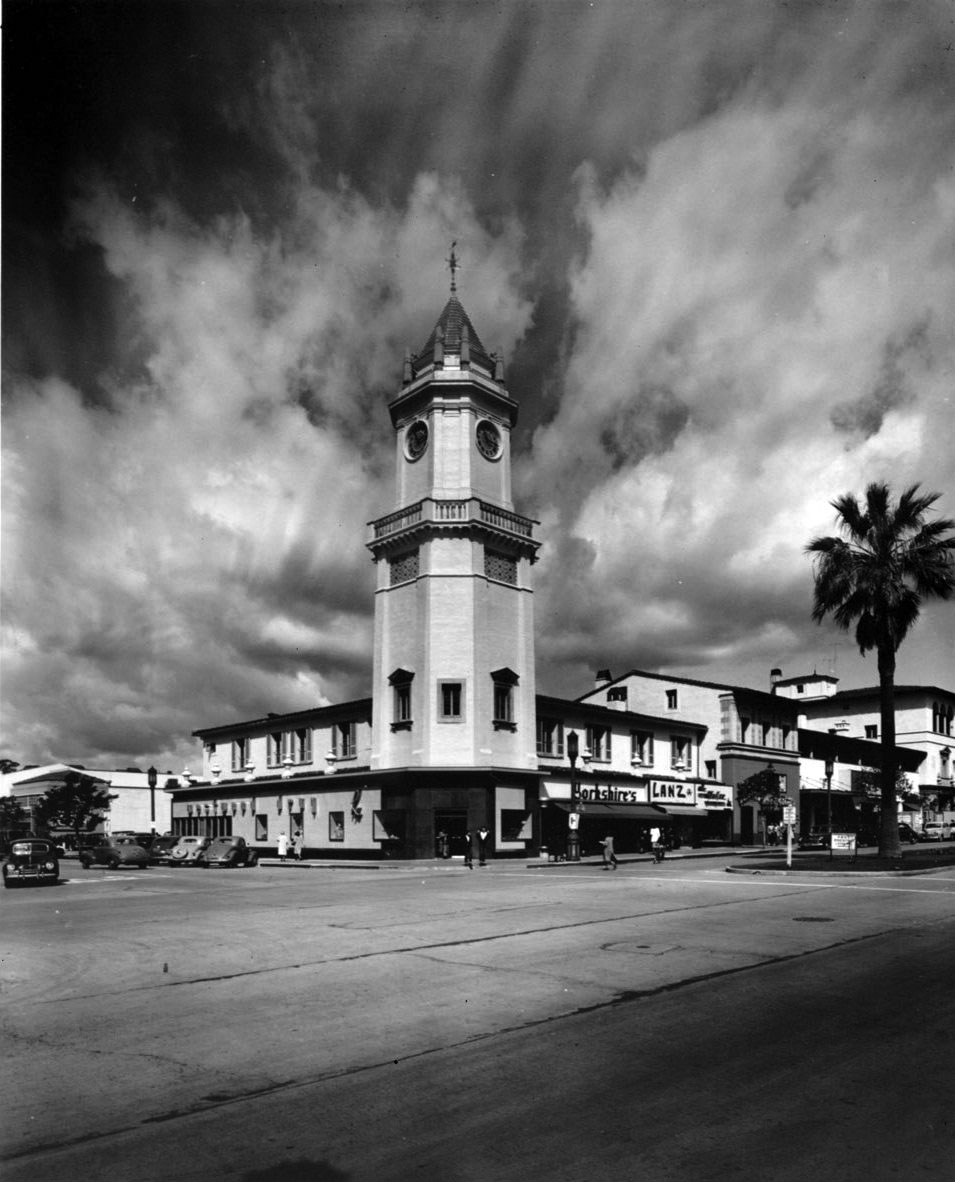 |
|
| (ca. 1948)^^ - A closer view of the Holmby Building (Hall) located at 921 Westwood Boulevard in the block between Weyburn and Le Conte Avenues, with the clock tower on the corner of Weyburn Avenue. Westwood Drug occupies the ground floor. |
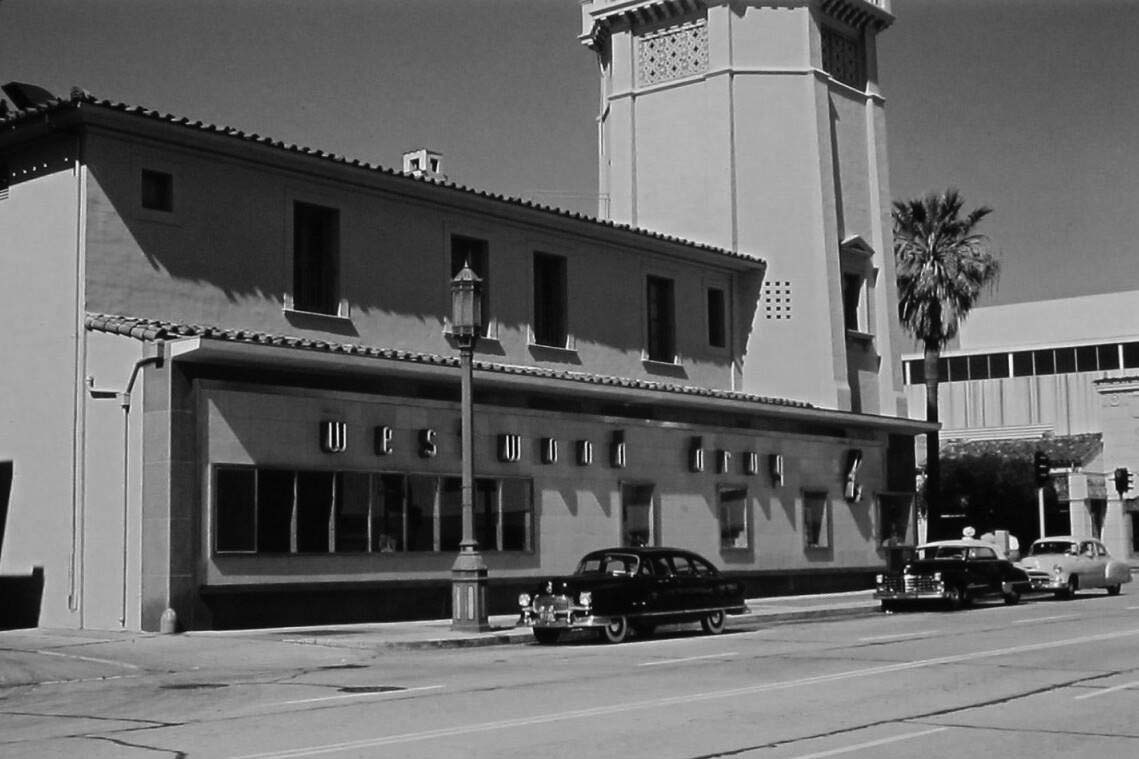 |
|
| (ca. 1950)*#* – View looking at northwest corner of Westwood Boulevard and Weyburn Avenue showing the Westwood Drug Store located on the ground floor of the Holmby Building. |
* * * * * |
Desmond's
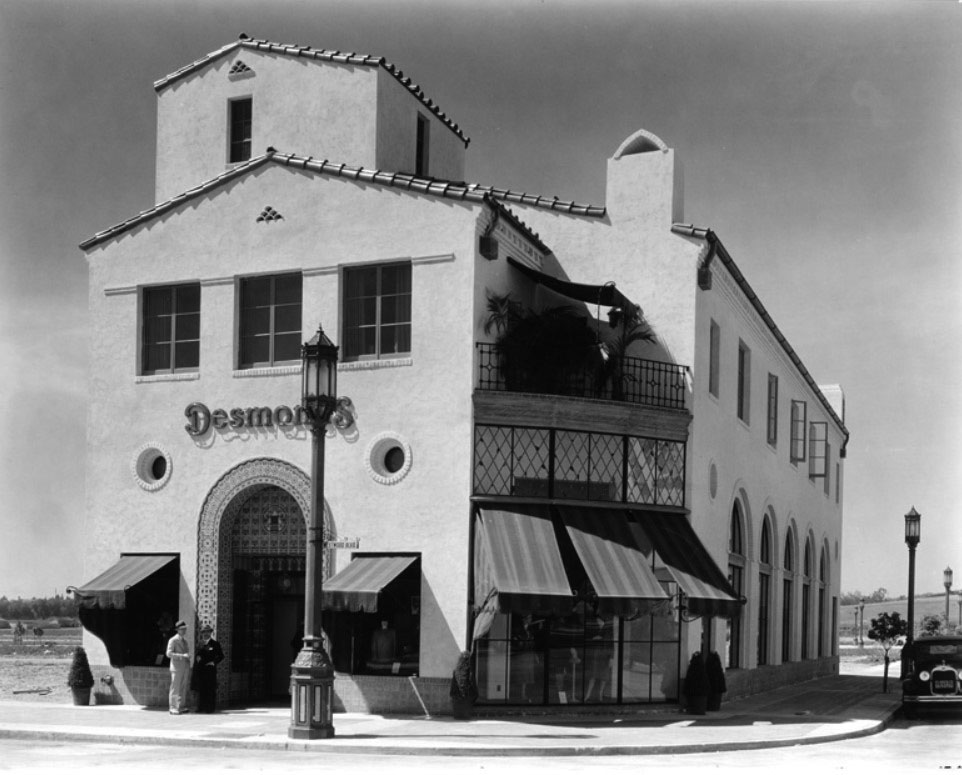 |
|
| (1929)** – View showing two men standing by the entrance of the recently built Desmond’s Building located at 1001 Westwood Blvd. Note the ornate streetlights. These would later be known as "Westwood Specials" streetlights. |
Historical Notes The first Desmond's Department Store was opened on Olvera Street in 1862. In 1921, Ralph R. Huesman purchased the store from the Desmond family and led the expansion of the retailer to several locations throughout the Southern California market. |
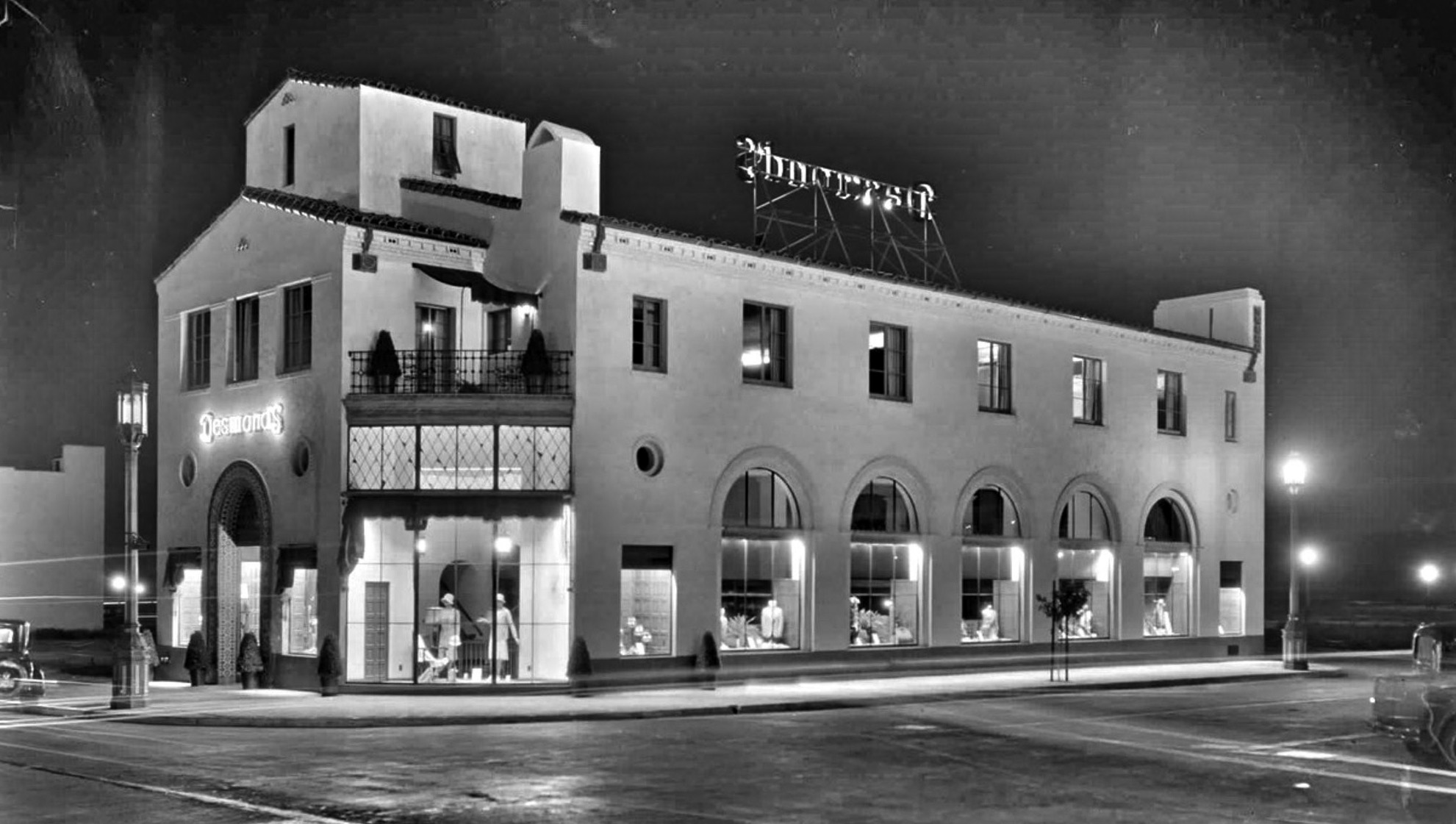 |
|
| (1929)^ - Night view of Desmond’s Clothing Store located on the SW corner of Westwood Boulevard and Weyburn Avenue. |
Historical Notes Designed by architect Allen G. Siple, the Westwood Village store opened in December 1929 and was the fifth store in the chain following Downtown, Pasadena, Wilshire and Beverly Hills. |
Then and Now
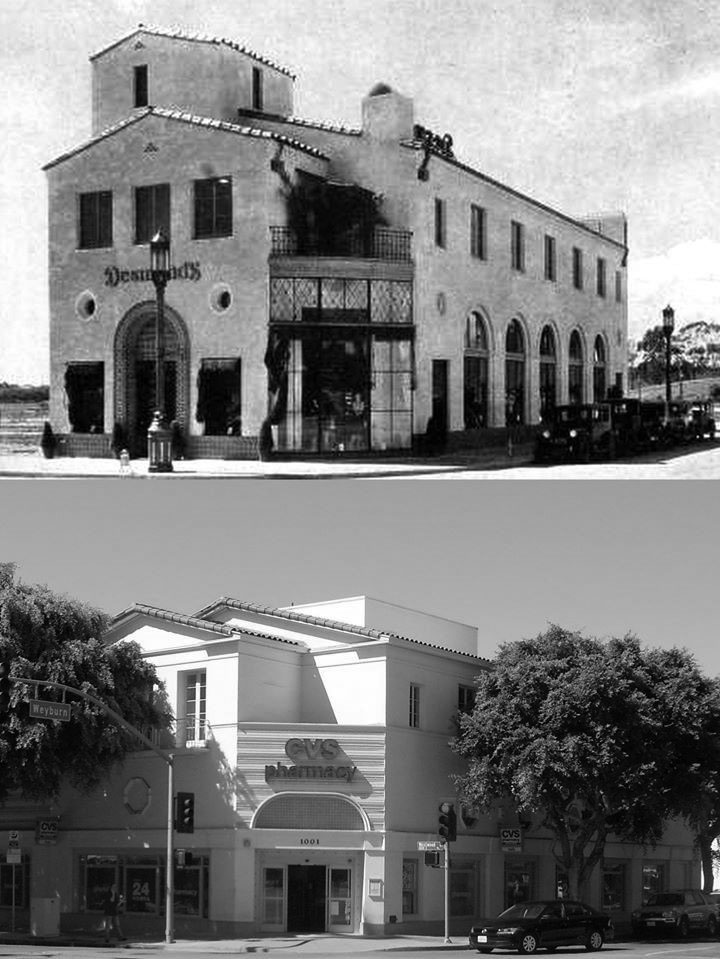 |
|
| (1929) vs. (2020)^.^ - Desmond's Building, today a CVS Pharmacy. |
Historical Notes Today, the Westwood Desmond’s building is occupied by a CVS store. Click HERE for more contemporary views. |
* * * * * |
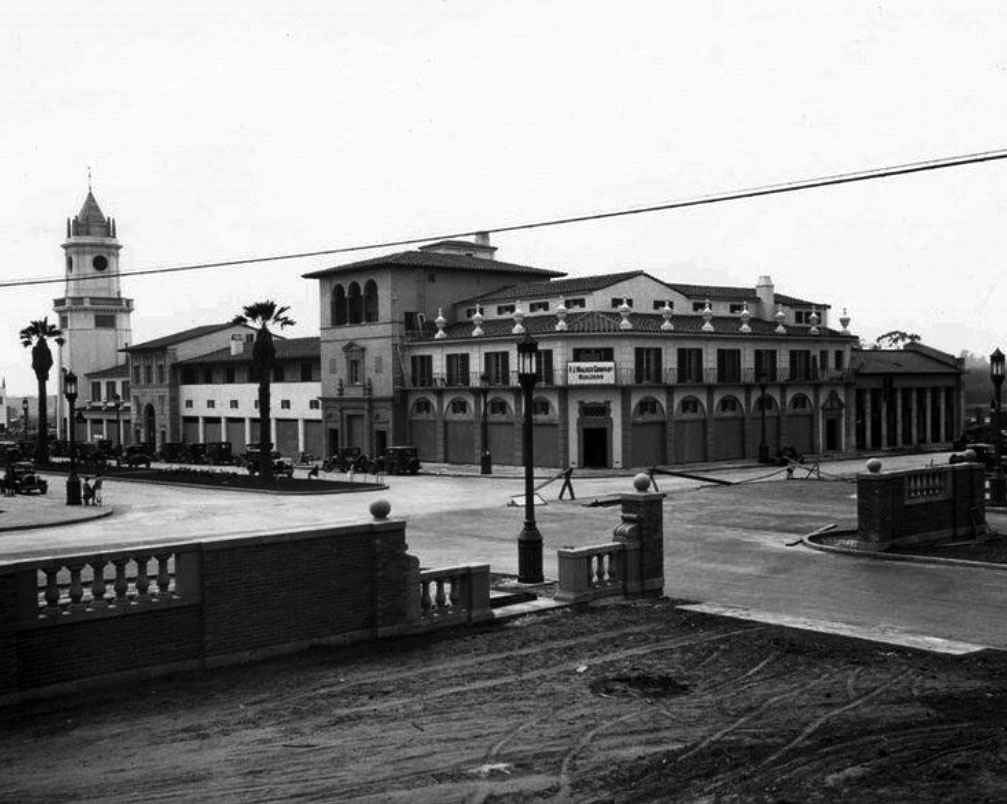 |
|
| (1932)*- View showing the Intersection of Le Conte Ave and Westwood Blvd with the Holmby Hall Building seen on the left. |
Historical Notes Opening in 1929, the original design of Westwood Village was considered one of the most well planned and beautifully laid out of commercial areas in the nation. Harold Janss had hired major architects and instructed them to follow a Mediterranean theme, with clay tile roofs, decorative Spanish tile, paseos, patios and courtyards. Buildings located at strategic points, including theaters, used towers to serve as beacons for drivers on Wilshire Boulevard. Janss picked the first slate of businesses and determined their location in the neighborhood; the area opened with 34 businesses, despite the Great Depression, had 452 in 1939. |
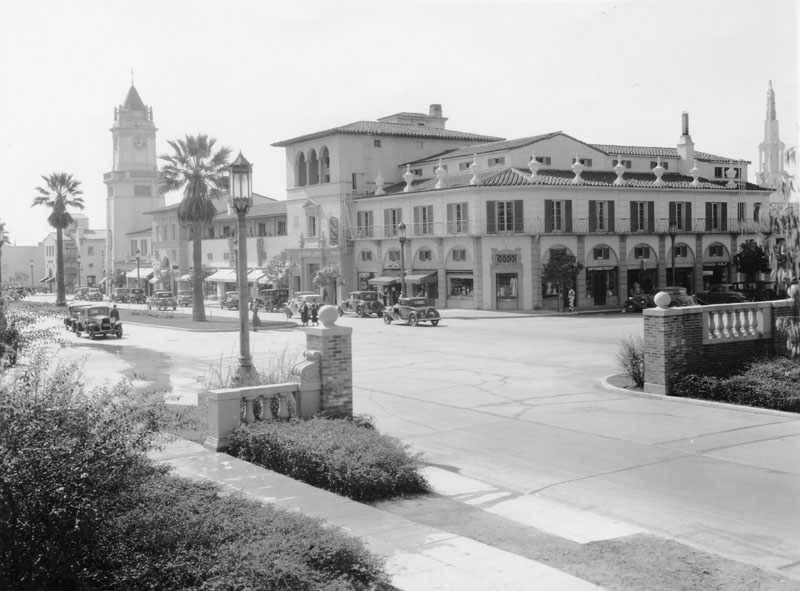 |
|
| (ca. 1937)* - The intersection of Le Conte Avenue and Westwood Boulevard, looking southwest. On the far side is the Holmby Building in Westwood Village. It is a retail and office building in the California Mediterranean style. |
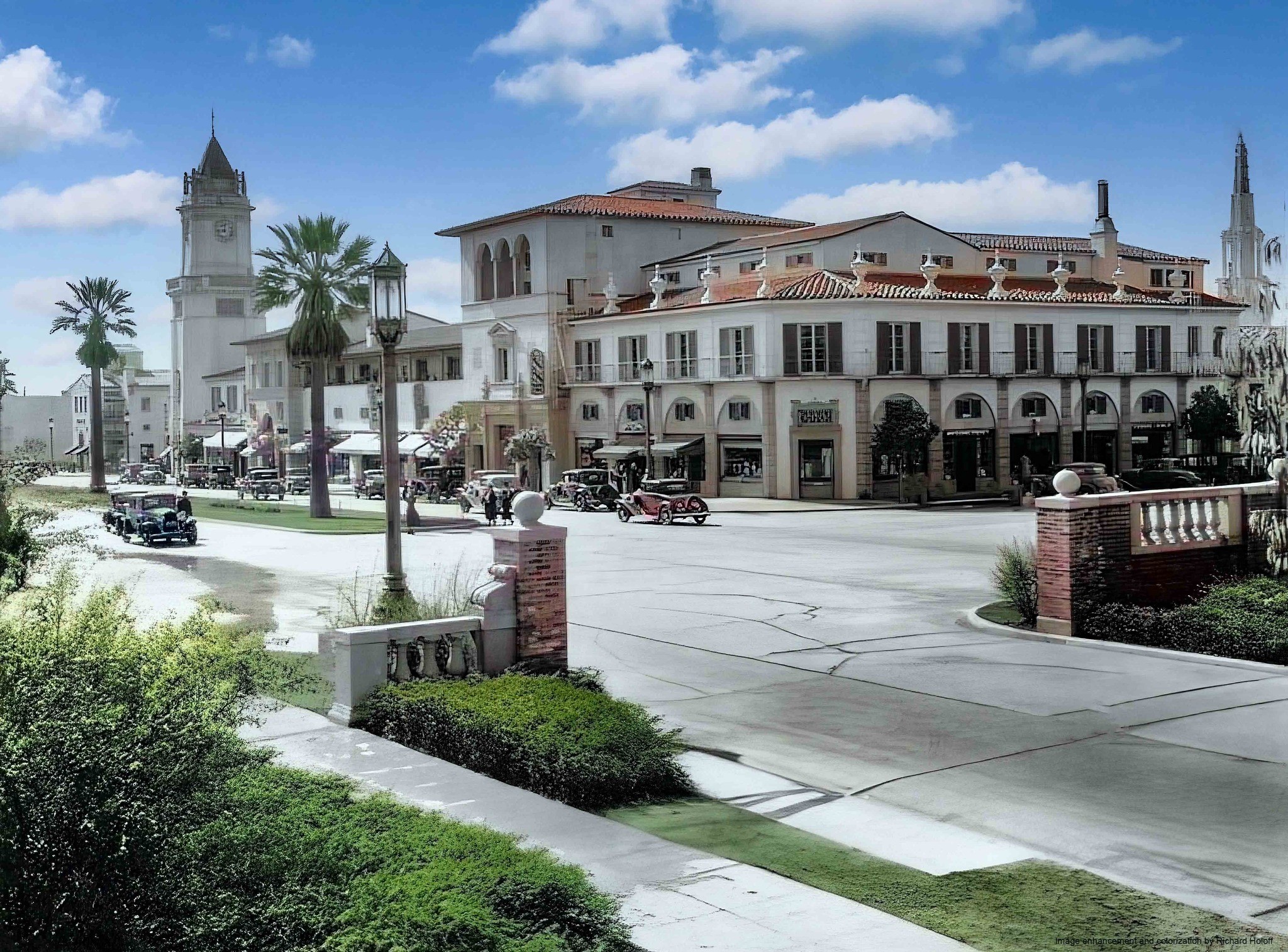 |
|
| (ca. 1937)* - The intersection of Le Conte Avenue and Westwood Boulevard, looking southwest. On the far side is the Holmby Building in Westwood Village. It is a retail and office building in the California Mediterranean style. Image enhancement and colorization by Richard Holoff |
Ralphs Market
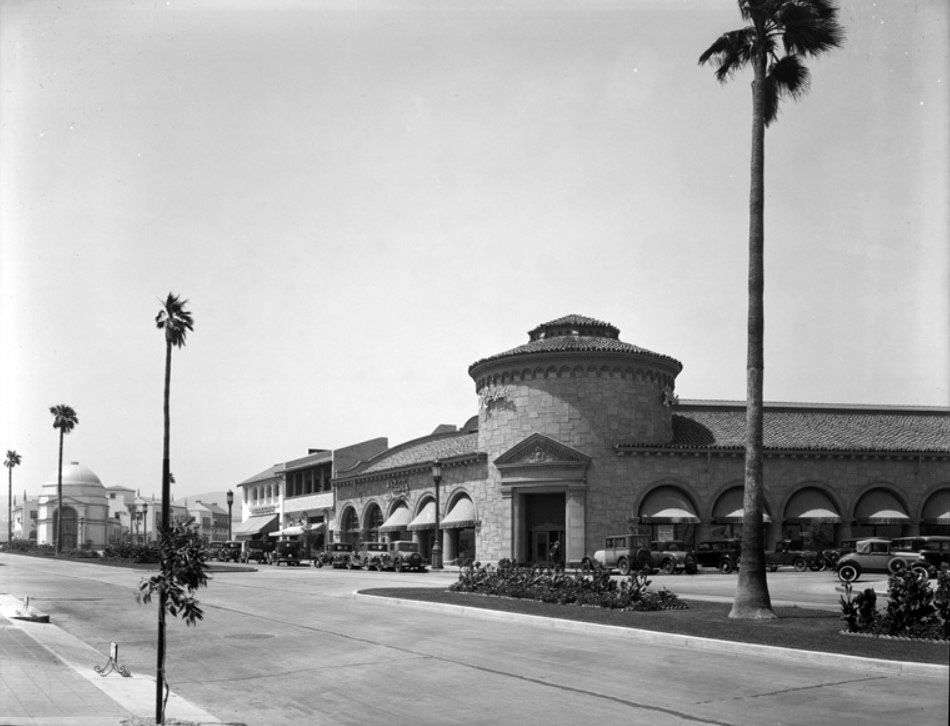 |
|
| (1930s)#^ - View showing the Westwood Ralphs Market designed by Russell E. Collins and S. N. Benjamin in Mission Revival/Spanish Colonial Revival style. |
Historical Notes When the new Westwood Village began to open in 1929, one of its original buildings was the Ralphs Grocery Store located on Westwood Boulevard, one block north of Wilshire Boulevard. The store's most prominent feature was its low rotunda, at the corner of Westwood Boulevard and Lindbrook Drive. The building's exterior walls were built with imitation stone, but were later covered with stucco. The building's style has been described as having Mission Revival, Spanish Colonial Revival, Romanesque Revival and Renaissance Revival elements, and is said to have served as a model for other low-rise commercial structures in the village. Early advertising materials for the Westwood Village development featured images of the Ralphs tower and the Janss dome, which became area landmarks. The opening of the store in the fall of 1929 was timed to coincide with the opening of the UCLA campus, and the Los Angeles Times proclaimed the store "one of the most beautiful exclusive grocery marts in the West." The opening was celebrated with a free food show, as Ralphs boasted a new feature at their Westwood store — "the employment of uniformed boys to wrap each purchase of merchandise while it is being paid for at the cashier's stand, and then carry it to the customer's car."* |
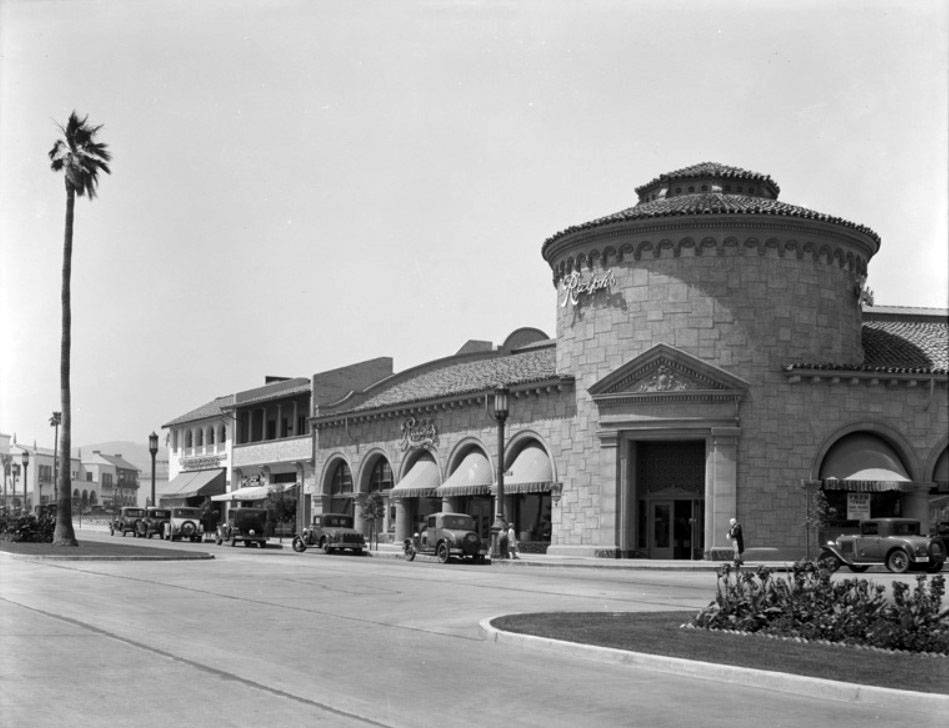 |
|
| (1930s)#^ – View looking north on Westwood Boulevard showing Ralphs Market located on the northeast corner of Westwood and Lindbrook Drive. |
Historical Notes Ralphs operated a grocery store on the site until the mid-1960s, when it left Westwood Village. Ralphs returned to Westwood Village nearly 40 years later, converting the old Bullock's department store into a grocery store (formerly sharing the space with a Best Buy and an Expo Home Design Center). Since Ralphs vacated the building in the mid-1960s, it has housed a number of different businesses. In 1970 a large portion of the space facing Lindbrook Drive was converted into a movie theater, which was known over the years as the United Artists Theater, the UA Egyptian, the Odeon Cinema and finally as the Mann Festival which closed on July 30, 2009. The Bratskeller restaurant, popular with UCLA students, also operated at the building from the late 1960s through the mid-1980s. In the late 1990s and early 2000s the prime corner space at the base of the tower was split between Daphne's Greek Cafe and Togo's Sandwich Restaurant. In late 2008, they were replaced with a Peet's Coffee & Tea, which remains currently. In early 2012, part of the shuttered movie theater was converted to 800 Degrees Neapolitan Pizzeria.* In 1988, the Ralphs Building was declared Historic-Cultural Monument No. 360. It was also listed on the National Register of Historic Places in 1992.* |
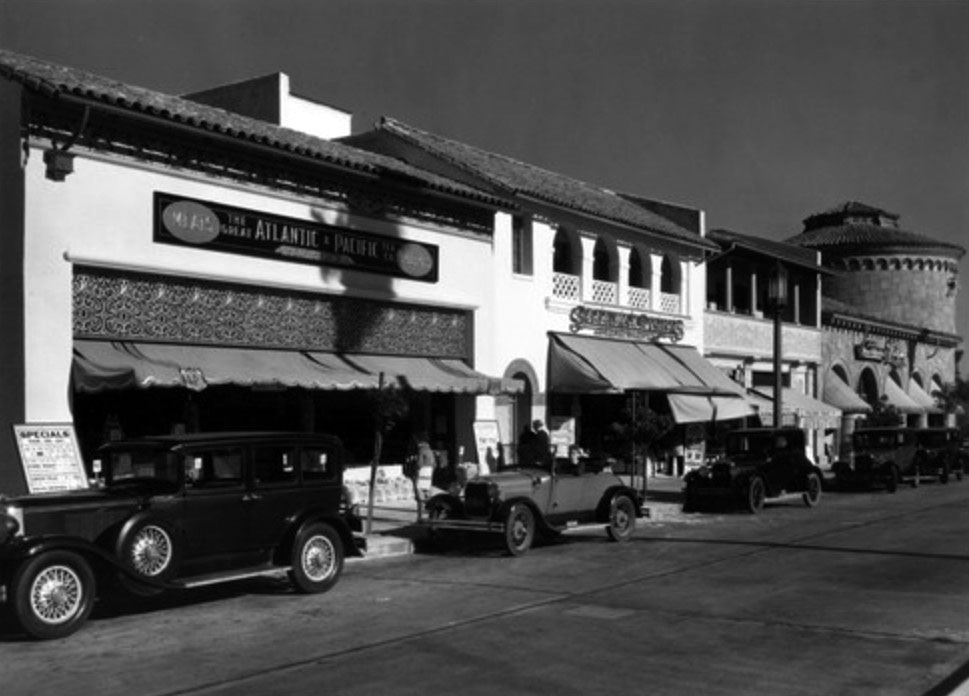 |
|
| (1936)#^ – View looking south on Westwood Boulevard showing cars parked in front of the Great Atlantic and Pacific Tea Company, 1124 Westwood Boulevard. The Ralphs Market rotunda is seen in the distance. |
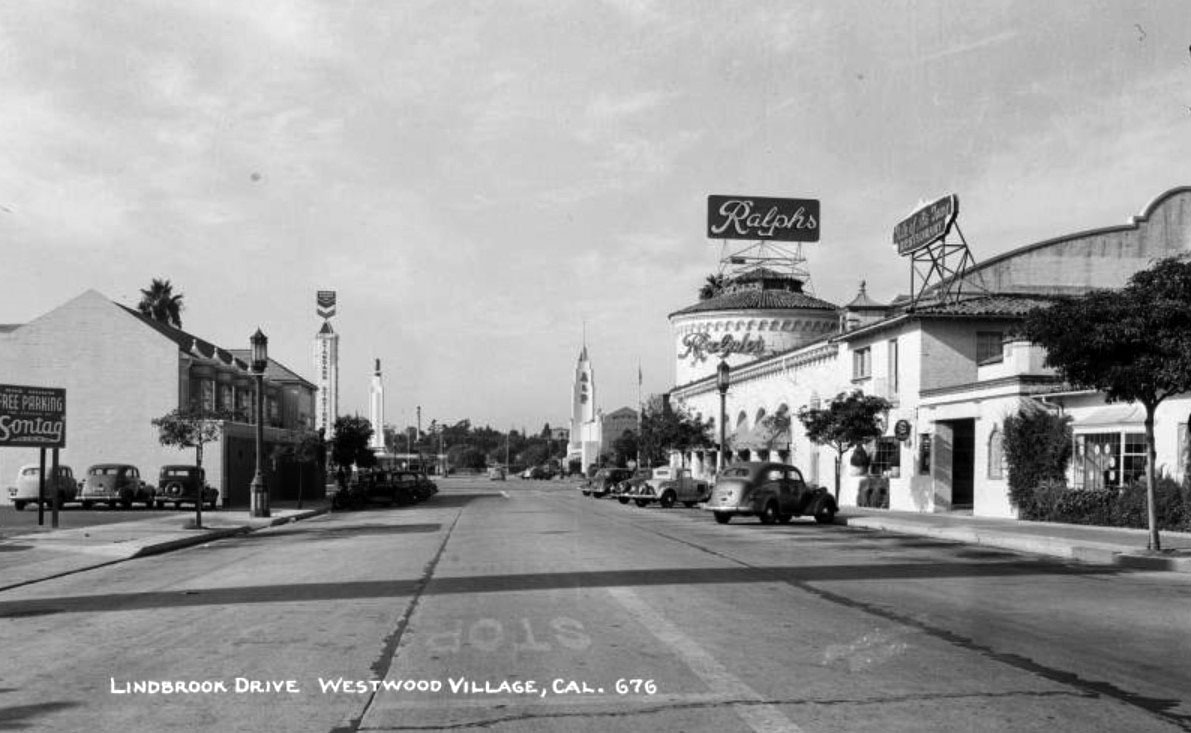 |
|
| (ca. 1939)#* – View looking west on Lindbrook Drive towards Westwood Boulevard where Ralphs Market, with its unique rotunda, stands on the northeast corner. Also seen are the tall towers of two gas stations and the A & P Store. |
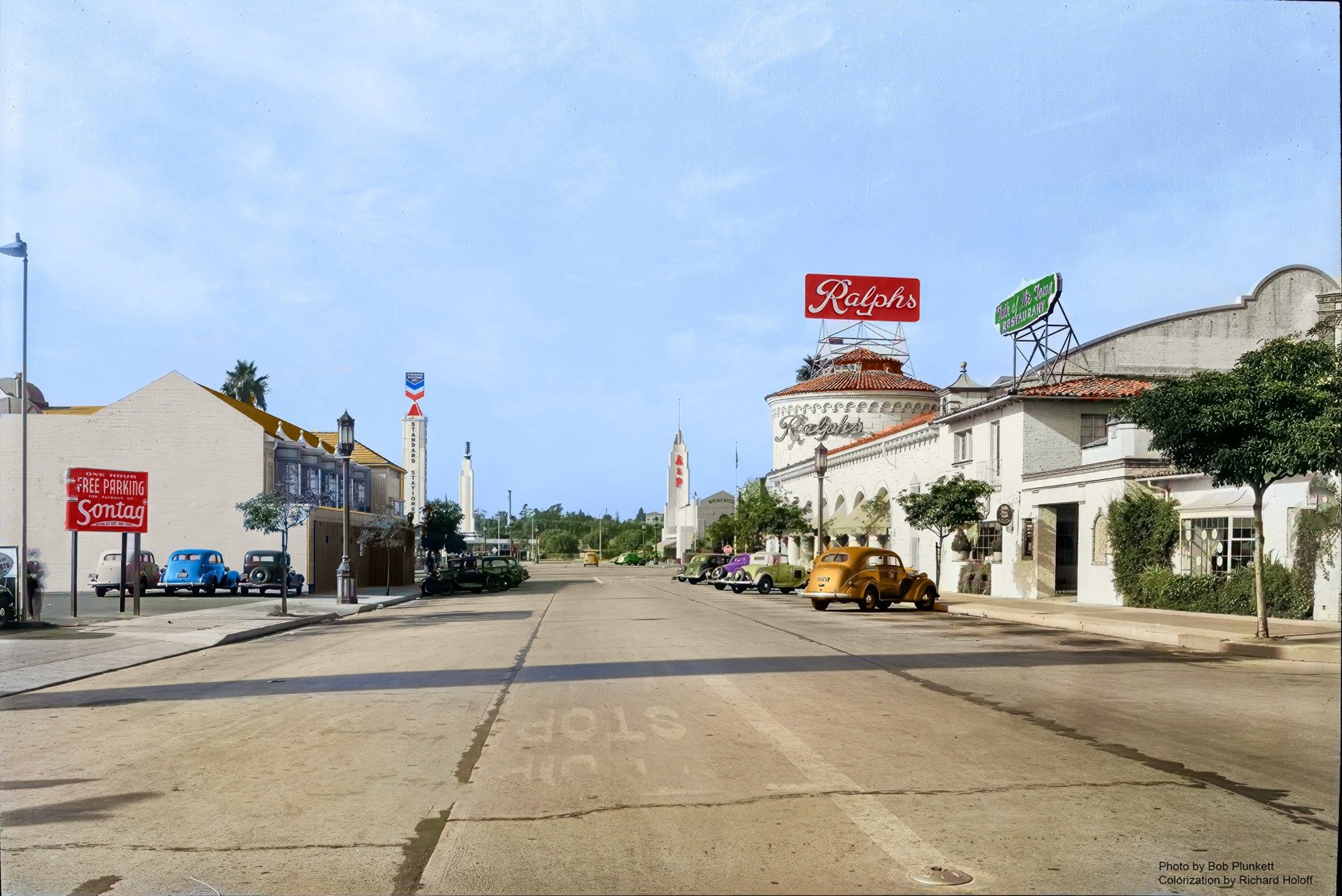 |
|
| (ca. 1939)#* – View looking west on Lindbrook Drive towards Westwood Boulevard where Ralphs Market, with its unique rotunda, stands on the northeast corner. Also seen are the tall towers of two gas stations and the A & P Store. Photo by Bob Plunket; Image enhanced and colorized by Richard Holoff |
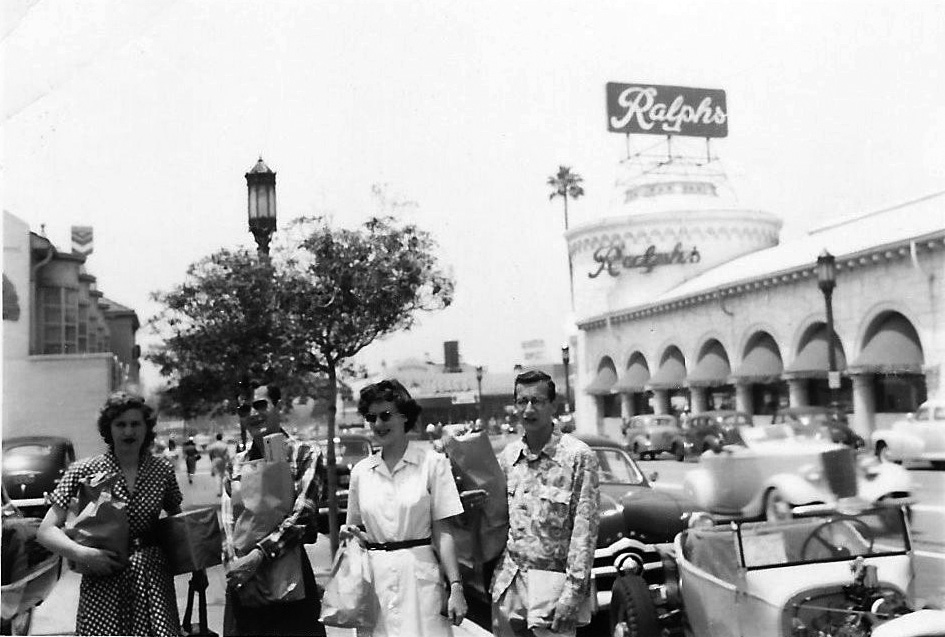 |
|
| (1940s)^.^ – A successful day of shopping in Westwood with Ralphs Market seen in the background. |
Then and Now
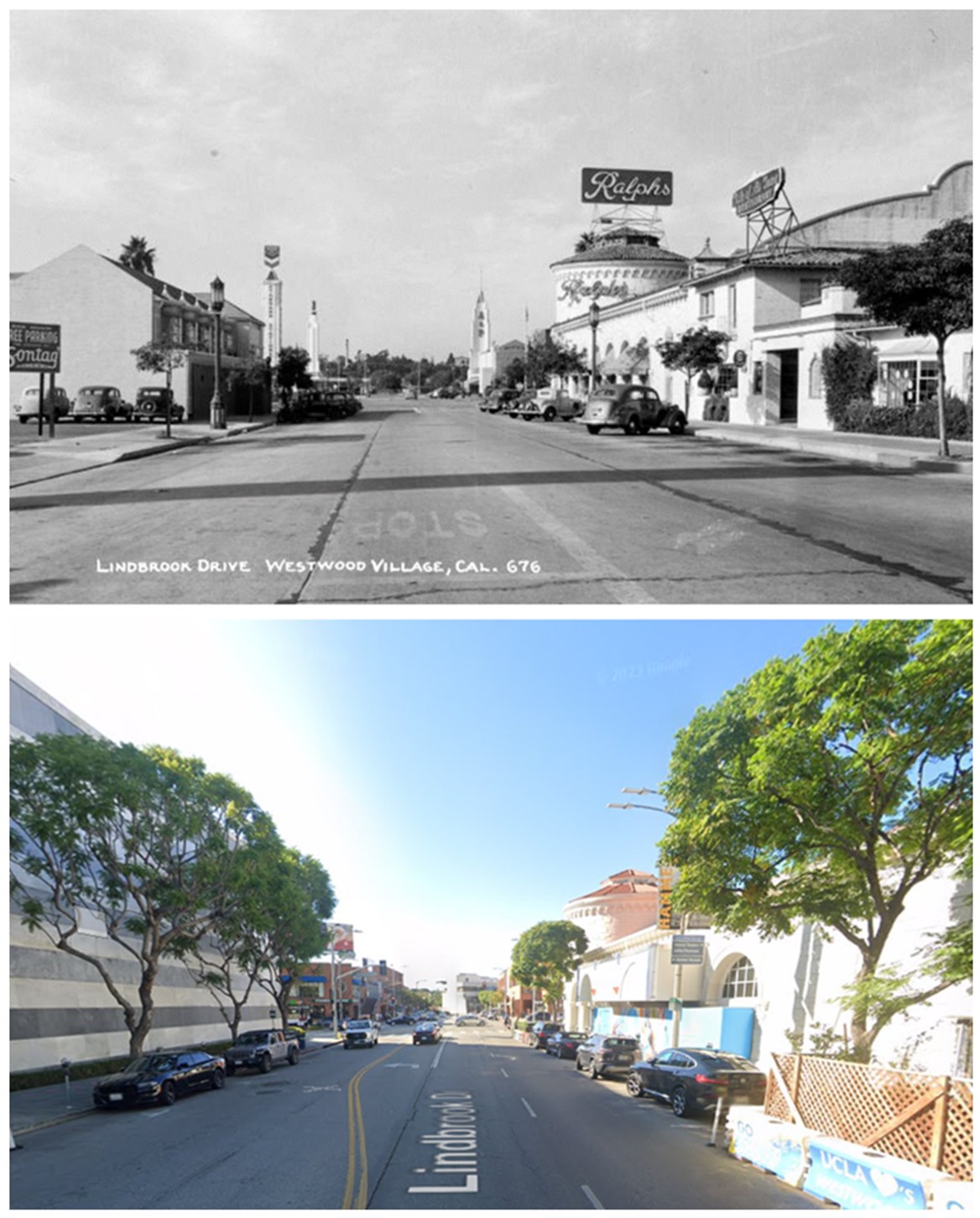 |
|
| (1939 vs 2022)* - Looking west on Lindbrook Drive towards Westwood Boulevard where Ralphs Market building, with its unique rotunda, stands on the northeast corner. |
Then and Now
 |
|
| (1930s vs. 2021)* – The Ralphs Market buildng located on the NE corner of Westwood and Lindbrook in Westwood Village. |
Historical Notes Built in 1929 as a Ralphs Grocery Store, it was one of the original six buildings in the Westwood Village development. The building was noted for its cylindrical rotunda capped by a low saucer dome, with a pediment over the entrance and arcaded wings extending north and east. The opening of the store in the fall of 1929 was timed to coincide with the opening of the UCLA campus, and the Los Angeles Times proclaimed the store "one of the most beautiful exclusive grocery marts in the West."* |
* * * * * |
A&P Market (The Great Atlantic & Pacific Tea Company)
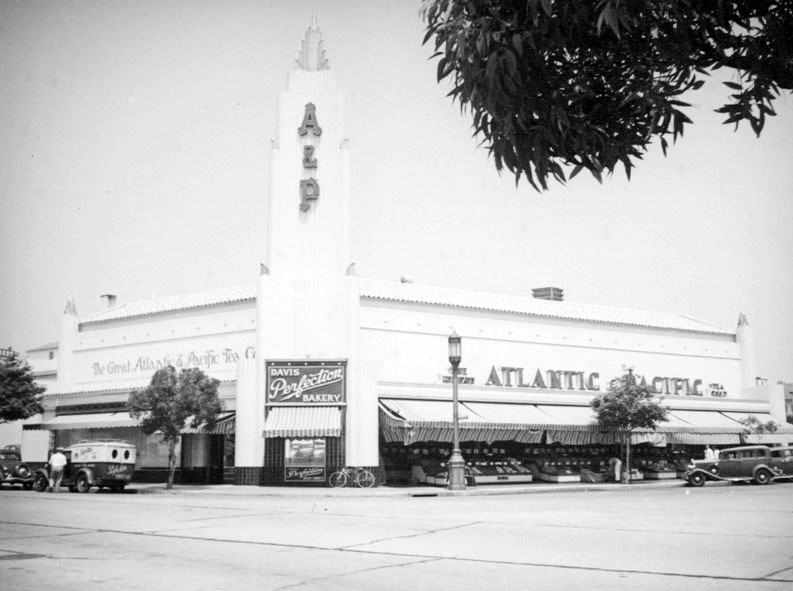 |
|
| (ca. 1937)* – View looking at the northwest corner of Lindbrook Drive and Westwood Boulevard (across the street from Ralphs) showing The Great Atlantic & Pacific Tea Company (A&P). The building above no longer exists. Click HERE for contemporary view. |
Historical Notes The Great Atlantic & Pacific Tea Company, better known as A&P, was a chain of grocery stores that ceased supermarket operations in November 2015, after 156 years in business. From 1915 through 1975, A&P was the largest grocery retailer in the United States (and until 1965, the largest U.S. retailer of any kind). A&P was considered an American icon that according to The Wall Street Journal "was as well-known as McDonald's or Google is today" and that A&P was "Walmart before Walmart." Known for innovation, A&P and the supermarkets that followed its lead significantly improved nutritional habits by making available a vast assortment of food products at much lower costs. Until 1982, A&P also was a large food manufacturer.*^ |
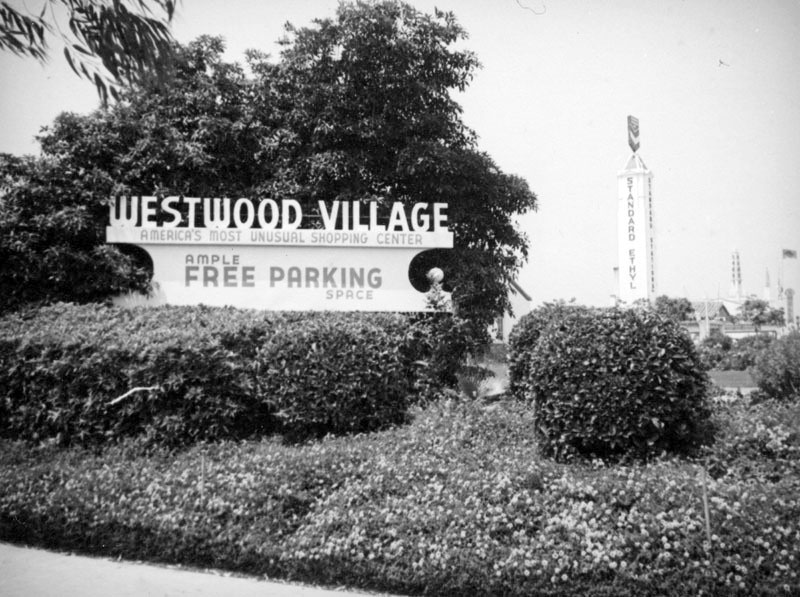 |
|
| (1930s)* - Sign at Westwood Village, "America's Most Unusual Shopping Center," with "Ample Free Parking Space." |
Historical Notes Janss hired Harland Bartholomew, a St. Louis planner, and L. Deming Tilton, involved in the reconstruction of Santa Barbara town center, to develop a master plan for Westwood Village. They chose a Mediterranean-style shopping area with angled streets and irregular blocks. Street corners were anchored by tile-roofed, Spanish Colonial Revival buildings with walk-through plazas and second-floor arcades. Attractions included the Fox Westwood Theatre, department stores such as Bullocks Westwood and Sears, Ralphs grocery, and college shops. Neon-topped towers and a greenbelt along Wilshire drew motorists from the boulevard. |
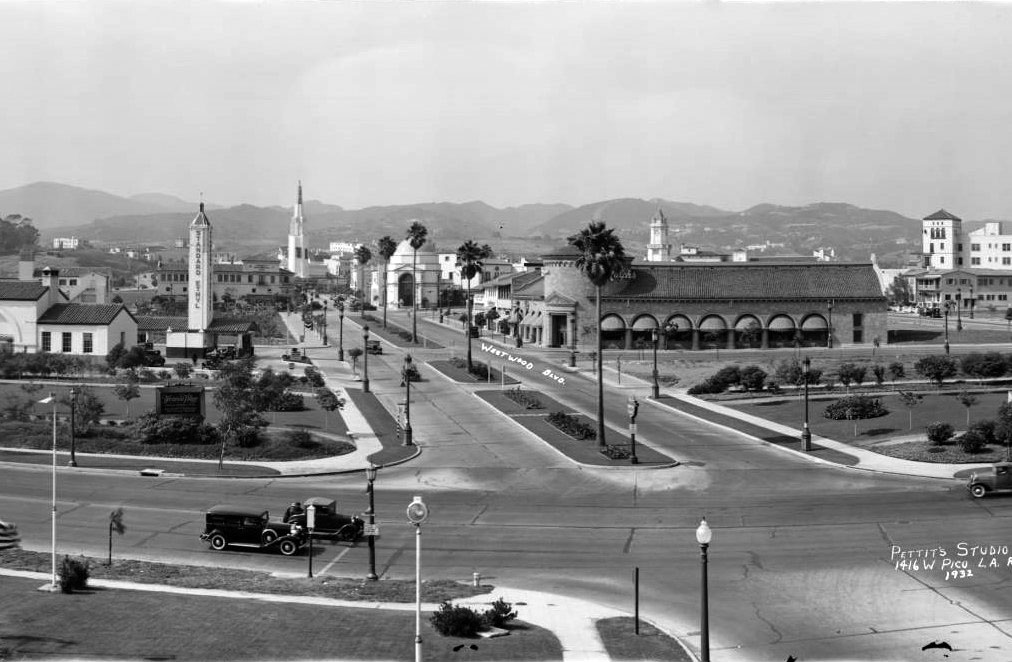 |
|
| (1932)* – View looking north showing the intersection of Wilshire and Westwood boulevards. In the distance can be seen the four major landmarks of Westwood Village. The Fox Theatre, Janss Dome, Ralphs Market and the Holmby Building. Note the absence of any traffic signals at this busy intersection! |
Historical Notes One can see the many towers that served as Village landmarks, including the Fox Theater Tower, Sears Roebuck & Co. Tower, Holmby Hall Clock Tower, and four gas station towers that lined Lindbrook Drive. The towers served to orient pedestrians within the Village, and were intended to catch the eye of motorists as they sped along in the “fast moving traffic” along Wilshire Boulevard.^ |
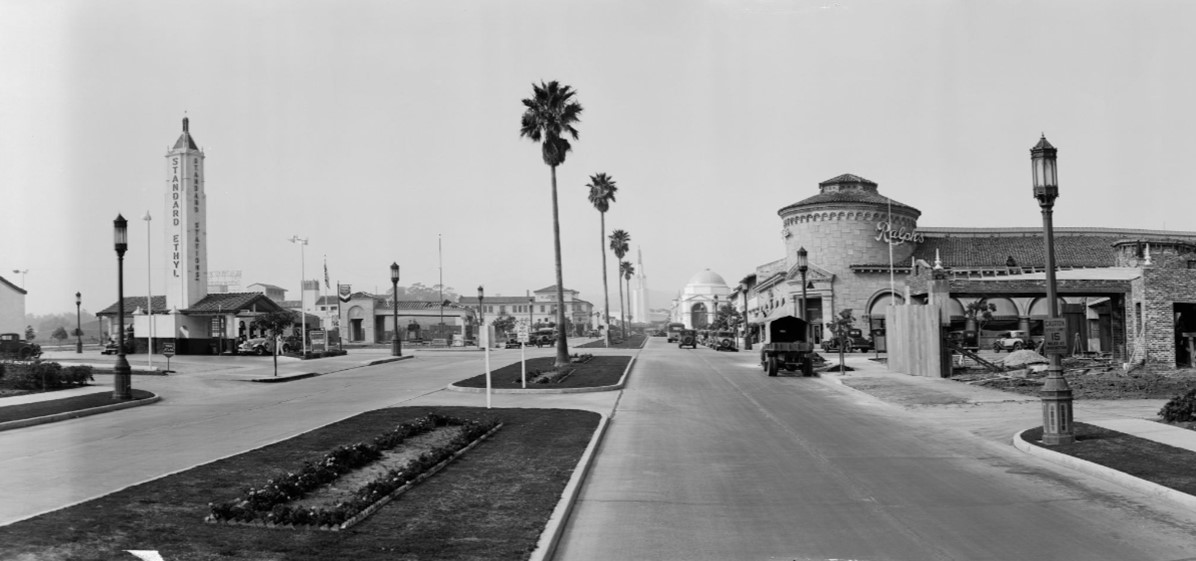 |
|
| (1933)* – View looking northwest along Westwood Blvd. The street, with palm trees planted in the dividers, is lined with a variety of stores, including a Ralphs, and gas stations. In the distance are the dome of the Janss Investment Corp and the tower of the Fox Theatre. |
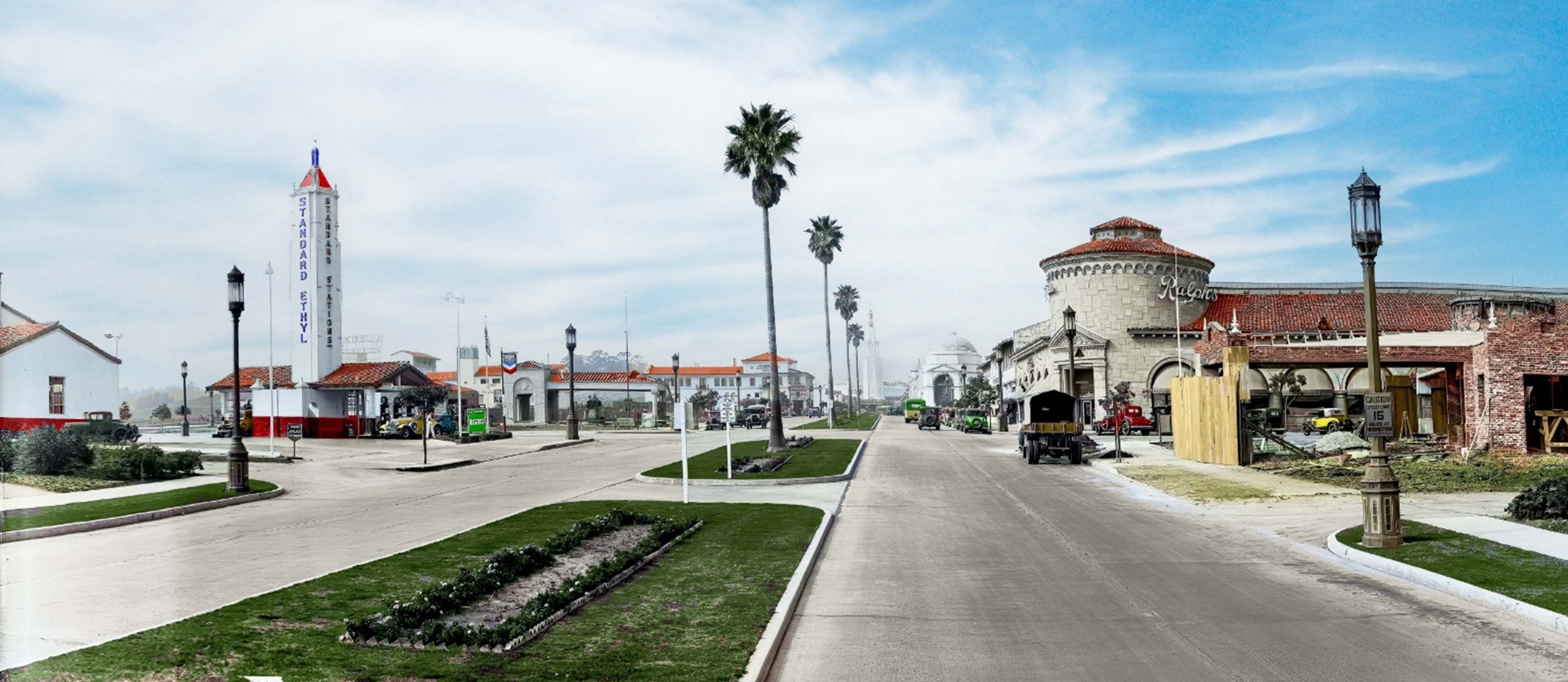 |
|
| (1933)* – View looking northwest along Westwood Blvd. The street, with palm trees planted in the dividers, is lined with a variety of stores, including a Ralphs, and gas stations. In the distance are the dome of the Janss Investment Corp and the tower of the Fox Theatre. Image enhancement and colorization by Richard Holoff |
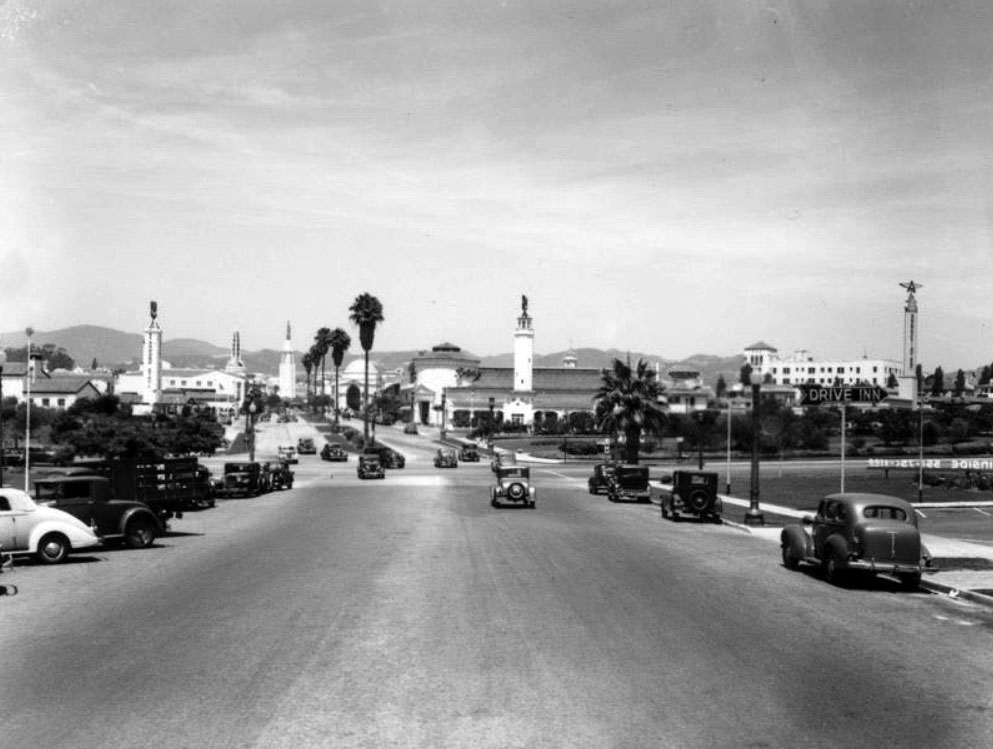 |
|
| (1937)^^* - View looking north on Westwood Boulevard toward the intersection with Wilshire Blvd. |
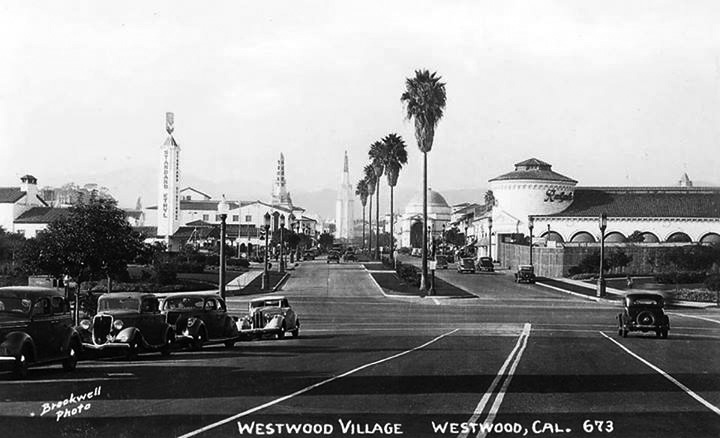 |
|
| (ca. 1937)*^* - Postcard view of Westood Village circa 1937. |
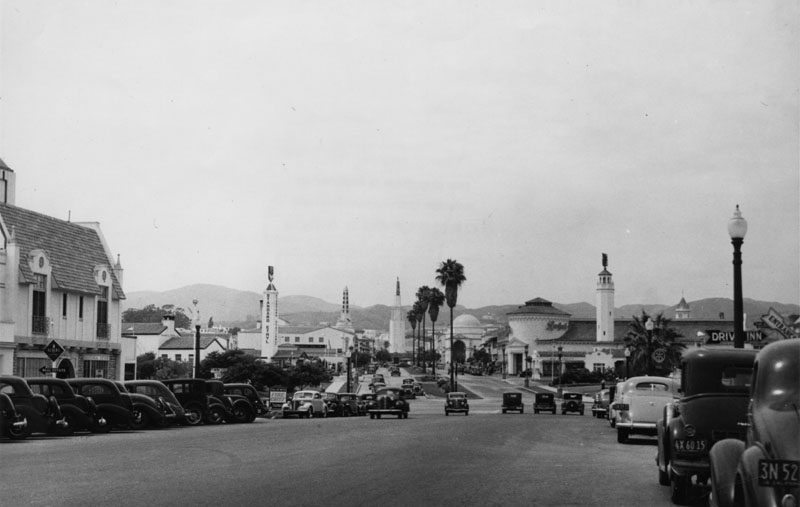 |
|
| (1938)* - Westwood Village, looking north on Westwood Boulevard at Wilshire crossing. |
* * * * * |
Westwood Service Stations
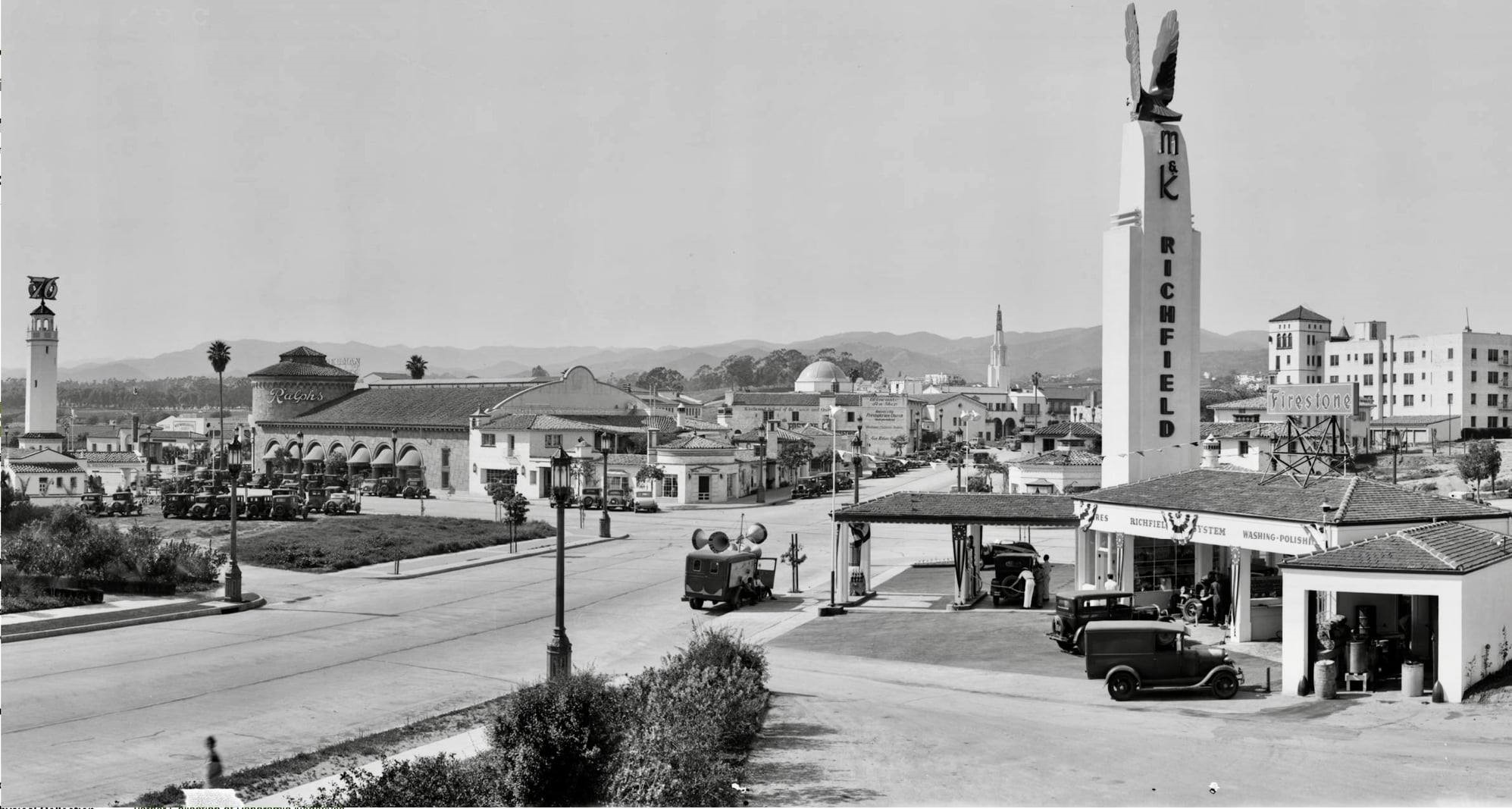 |
|
| (1934)^ – View looking north on Glendon Ave toward Lindbrook Drive showing several tower structures, two of which were for gas stations (Richfield on the right). Ralphs Market is on the left and in the distance can be seen the Janss Dome Building and the Fox Theatre tower. |
Historical Notes The towers in Westwood served to orient pedestrians within the Village, and were intended to catch the eye of motorists as they sped along in the “fast moving traffic” along Wilshire Boulevard.^ |
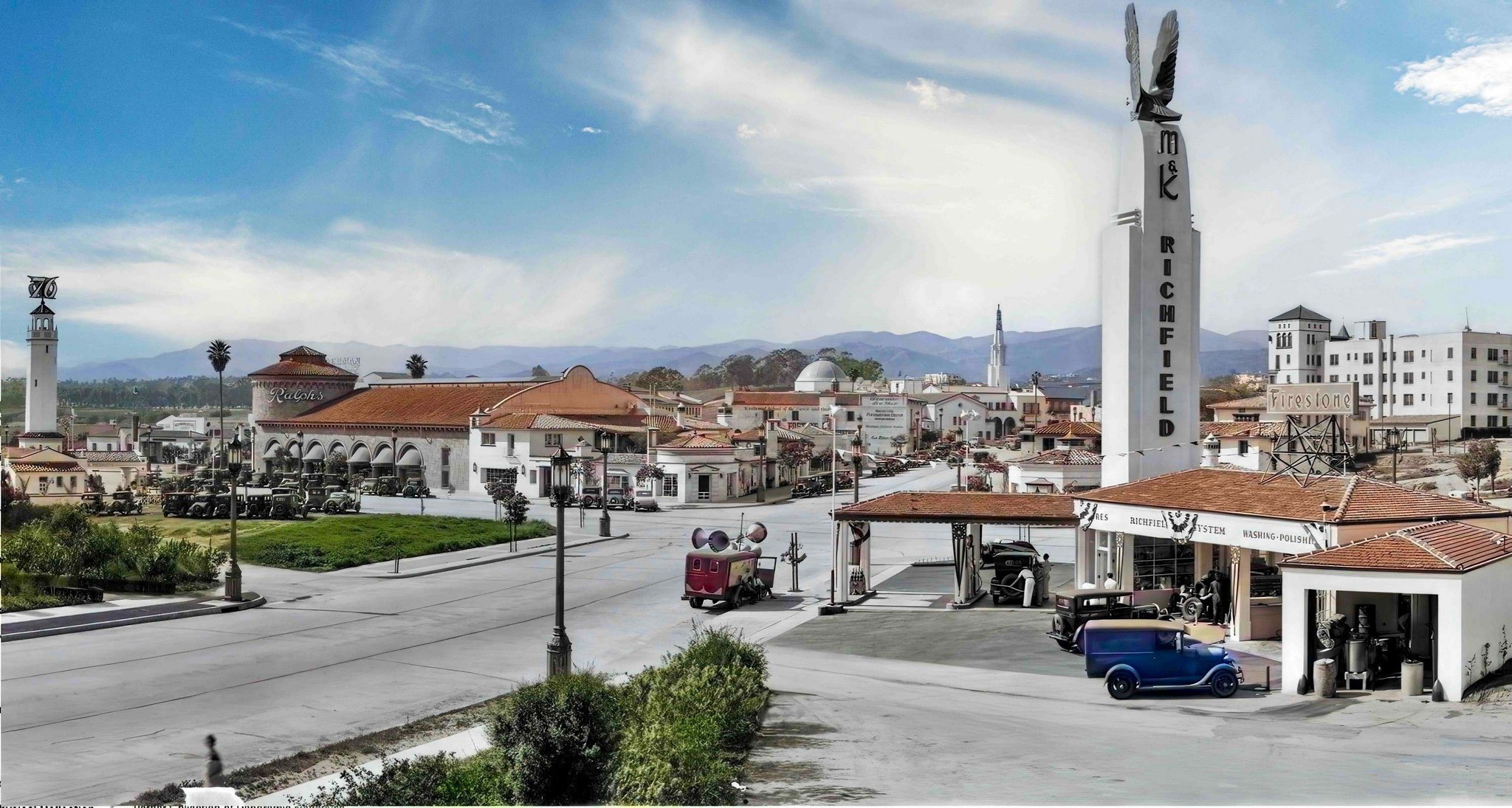 |
|
| (1934)^ – View looking north on Glendon Ave toward Lindbrook Drive showing several tower structures, two of which were for gas stations (Richfield on the right). Ralphs Market is on the left and in the distance can be seen the Janss Dome Building and the Fox Theatre tower. Image enhancement and colorization by Richard Holoff. |
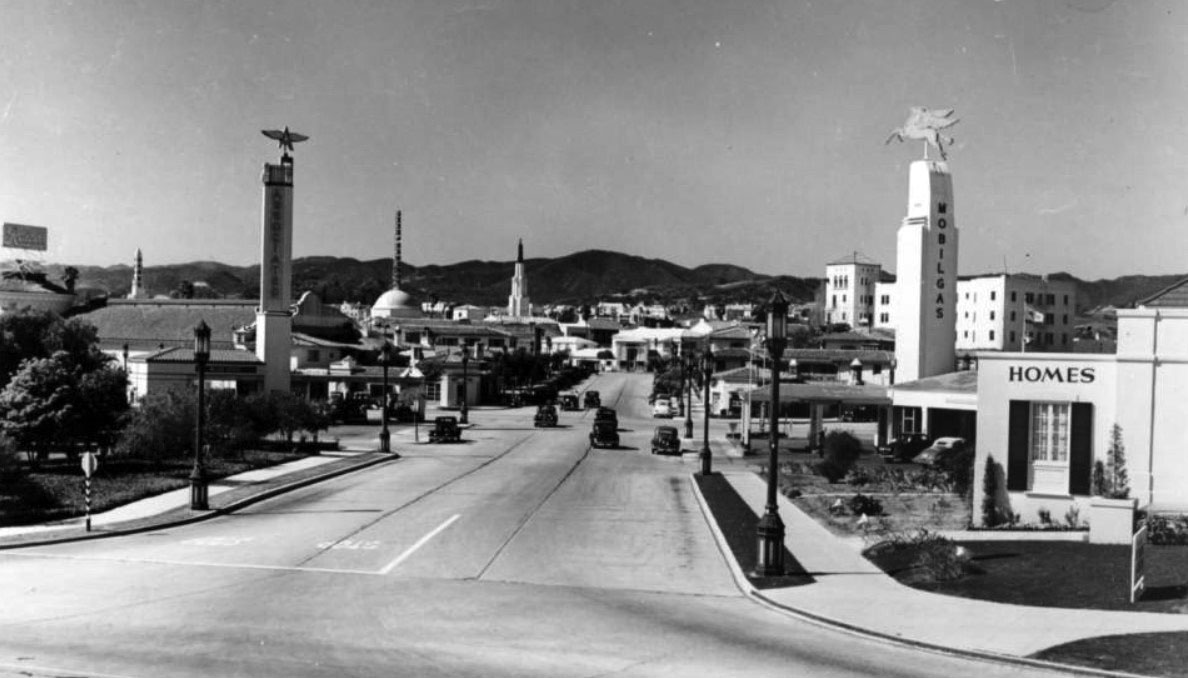 |
|
| (1939)^^ – View looking north on Glendon Ave as seen from Wilshire Blvd. in Westwood. The two closest towers are both for gas stations, Associated and Mobil, located at the intersection of Glendon Ave and Lindbrook Dr. |
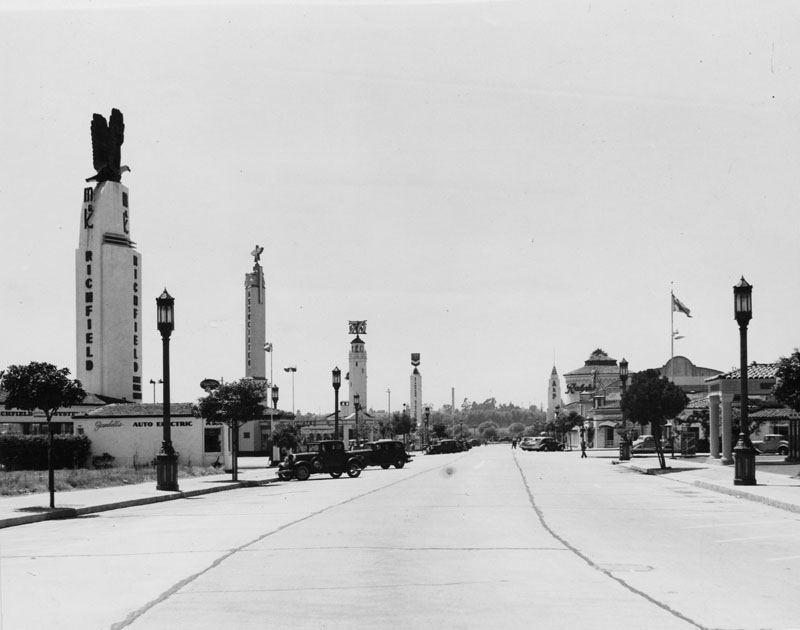 |
|
| (ca. 1937)^ - View of Westwood Boulevard, looking north from Wilshire Blvd. On the left can be seen several gas stations, including a Richfield, Associated, Union 76, and Chevron. On the right are various stores, including a Ralphs Market. |
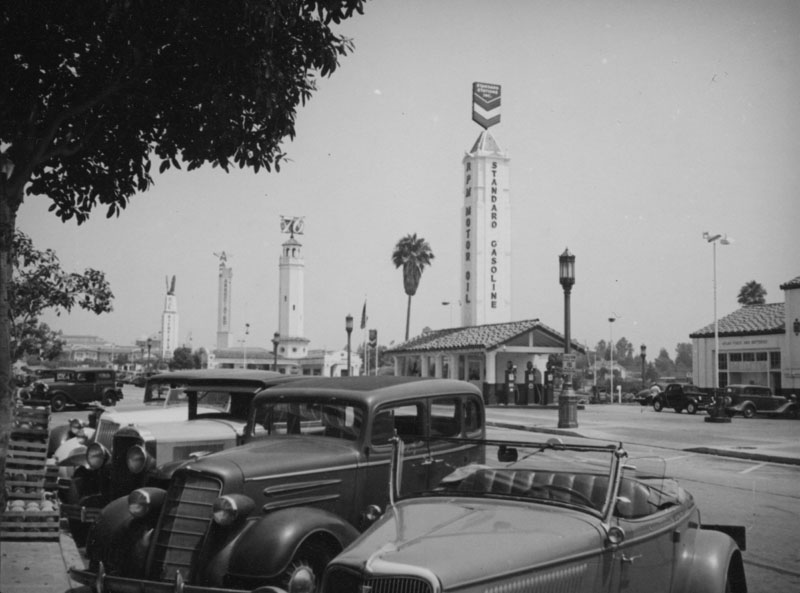 |
|
| (1930s)^ - View of Westwood Village with four tall sign towers in a row, behind the parked cars. Each tower is used to advertise a different gas station, right to left: Standard, 76, Associated, and Richfield. |
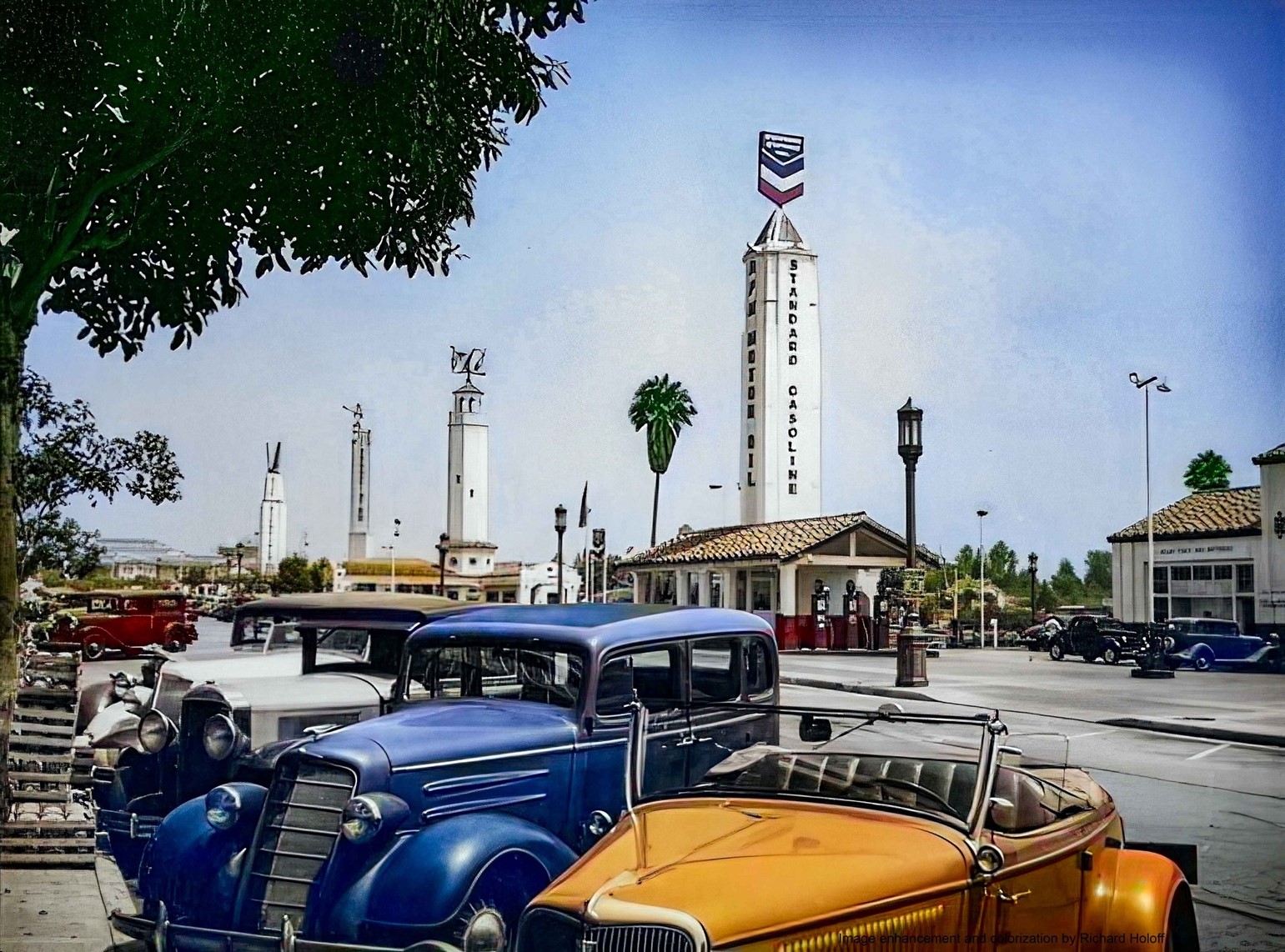 |
|
| (1930s)^ - View of Westwood Village with four tall sign towers in a row, behind the parked cars. Each tower is used to advertise a different gas station, right to left: Standard, 76, Associated, and Richfield. Image enhancement and colorization by Richard Holoff. |
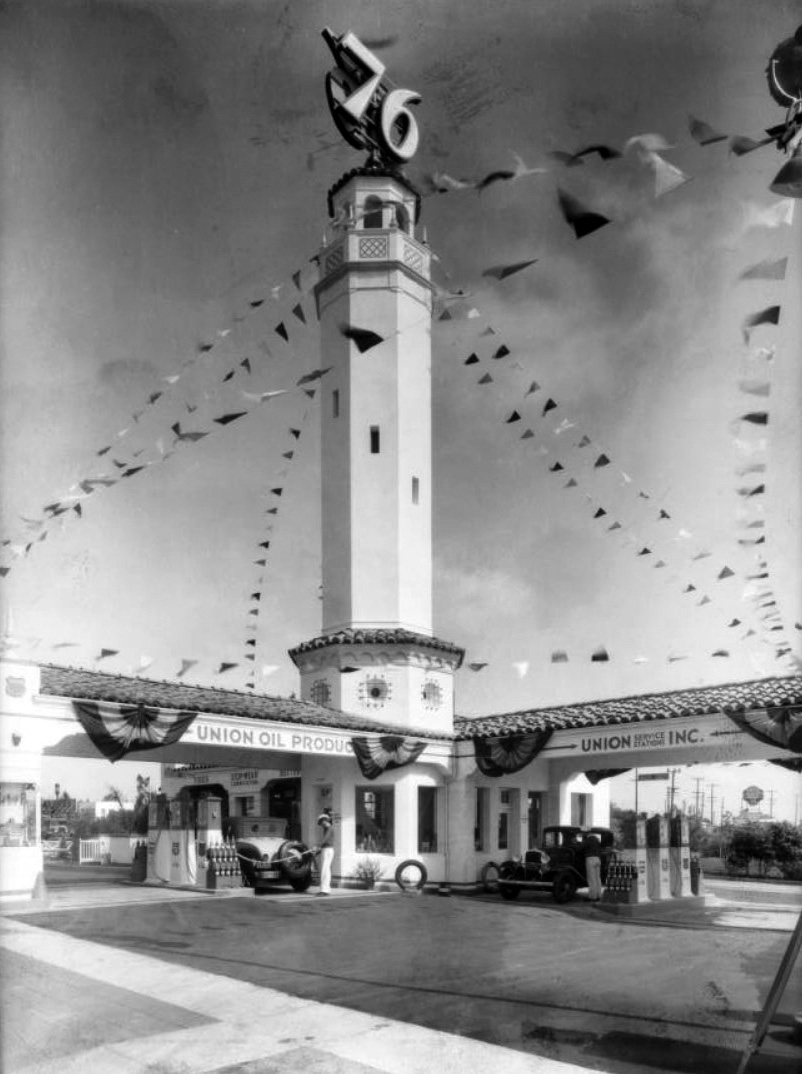 |
|
| (1933)^^ - View showing the grand opening of the Union 76 Service Station located at the southeast corner of Westwood Boulevard and Lindbrook Drive in the Westwood Village. |
Historical Notes This Union 76 Service Station had its grand opening in December 1933 as part of a massive industry opening of 750 stations citywide. The station lasted only until 1936 when it was demolished to make room for Sontag Fountain and Grill, which opened in 1938. |
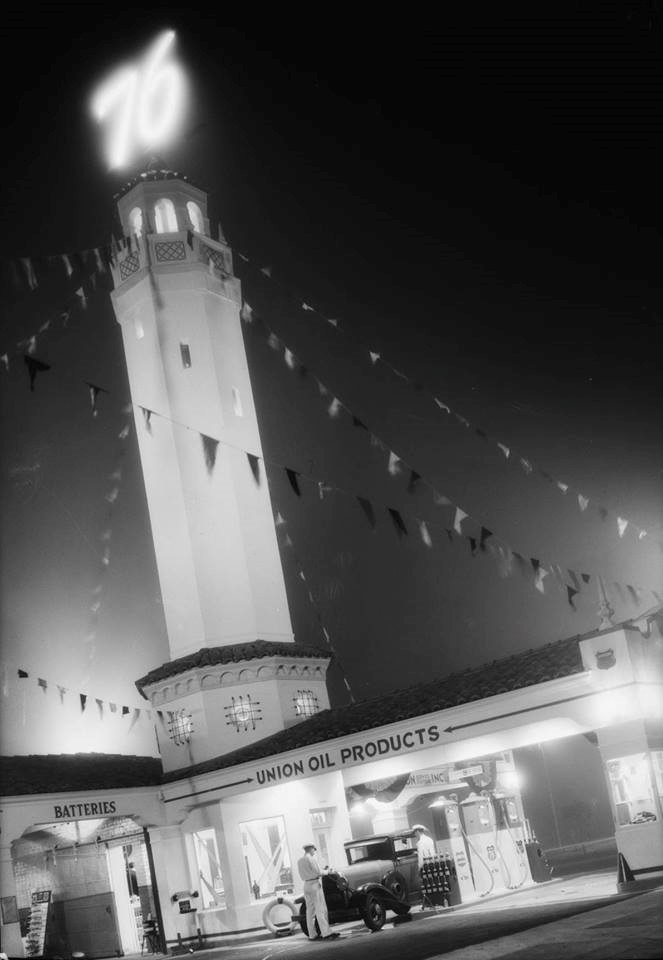 |
|
| (1931)^ – Night view showing the new Union 76 Gas Station on the southeast corner of Westwood Boulevard and Lindbrook Drive. Click HERE to see contemporary view of this same corner. |
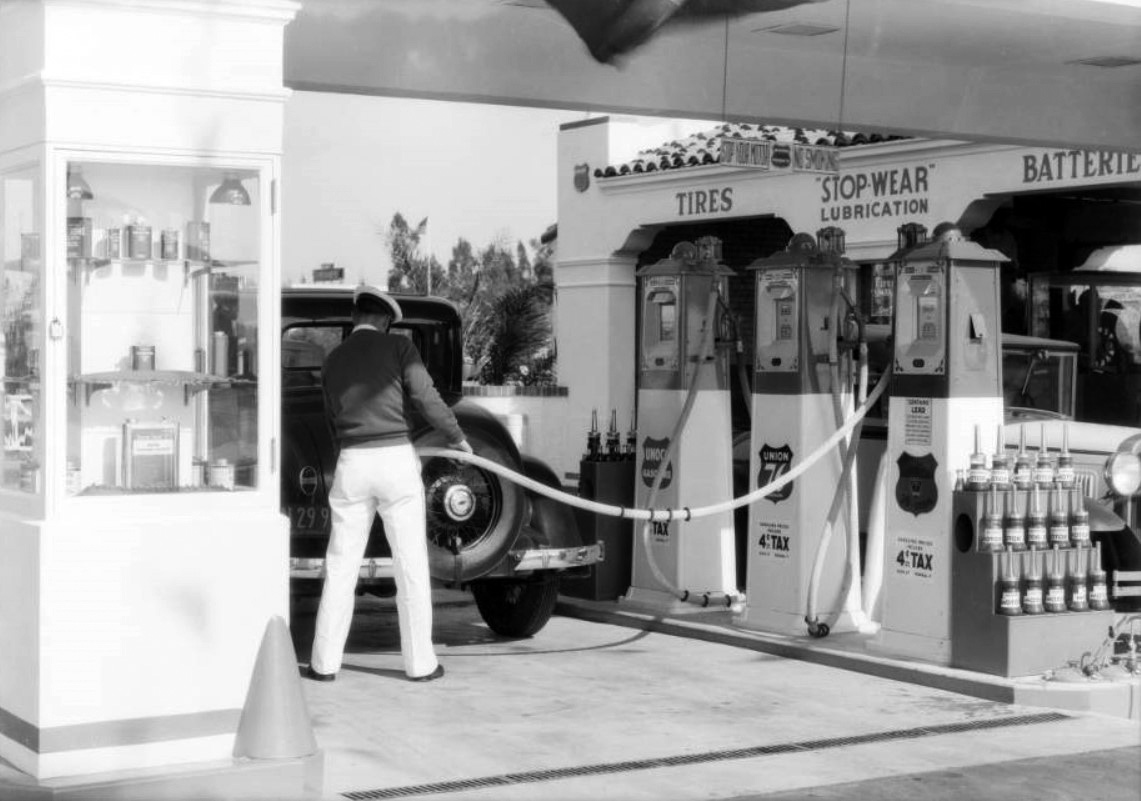 |
|
| (1933)^^ – Close-up view showing an attendant filling up a gas tank at a Union Oil Company Station at 1160 Westwood Boulevard. |
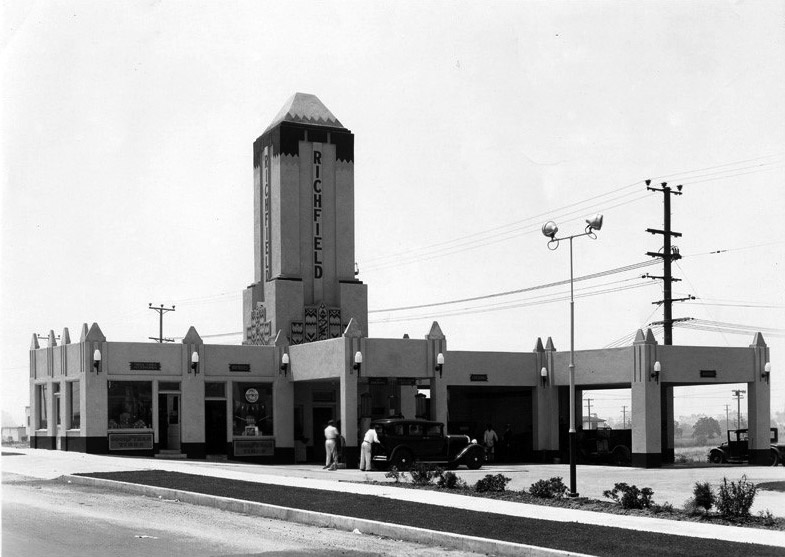 |
|
| (ca. 1933)* – View showing the Richfield Oil Station located at 1215 Westwood Boulevard. |
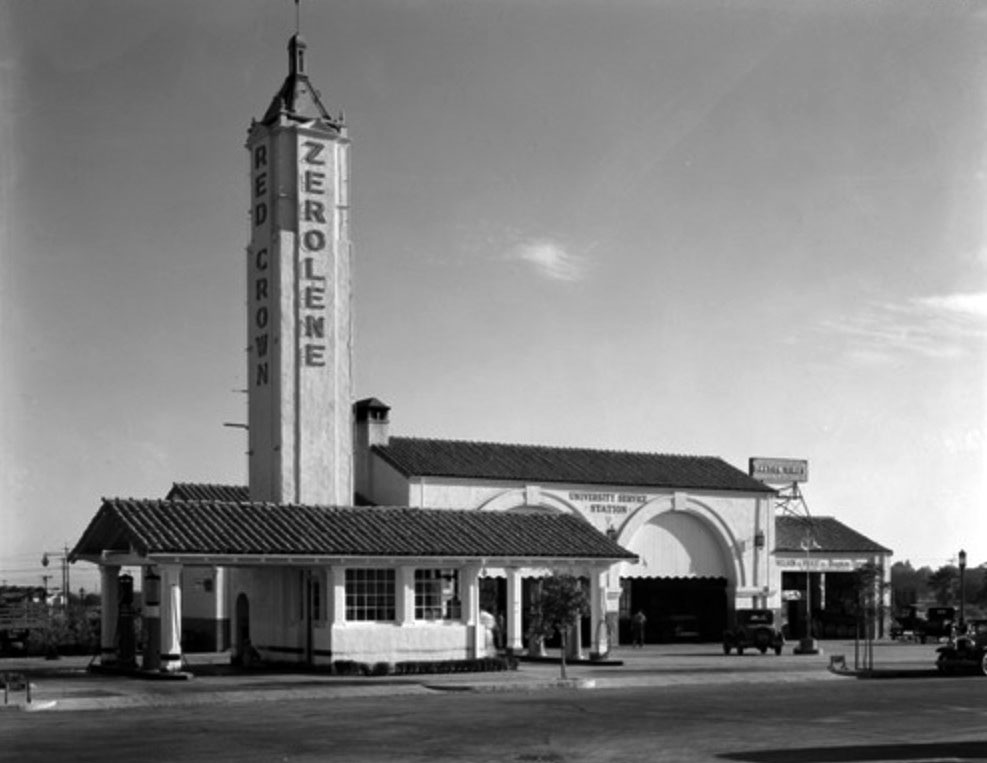 |
|
| (ca. 1933)* – View showing a service station in Westwood Village. Clock tower has "Red Crown Zerolene" on it; other signs read "University Service Station" and "Nelson and Price Inc." |
Click HERE to see more Early LA Gas Stations |
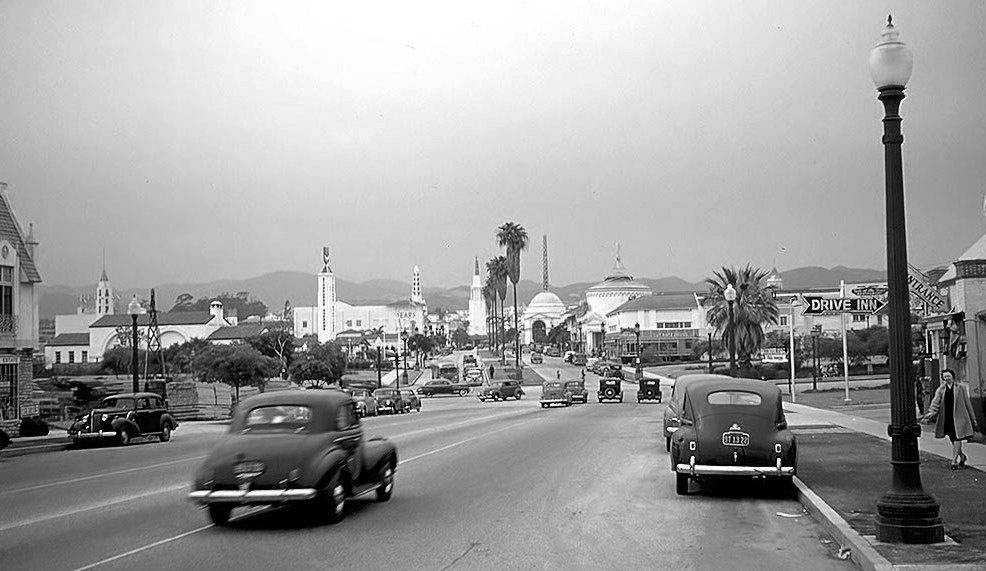 |
|
| (1941)^x^ - Panoramic view looking north on Westwood Boulevard toward Wilshire Boulevard with Westwood Village seen in the background. |
 |
|
| (ca. 1940)#^ - Postcard view looking north showing Westwood Village as seen from the intersection of Wilshire and Westwood. |
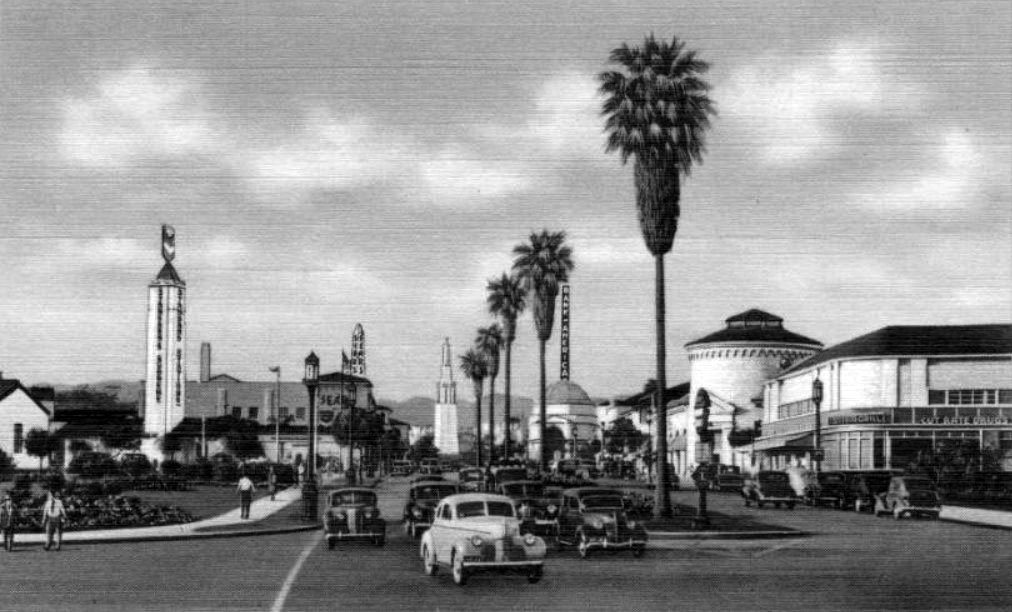 |
|
| (1940)## – Postcard view looking north along Westwood. The meridian is planted with palm trees. Businesses along the street include Cut Rate Drugs, a Standard Supreme (Chevron) gas station, Sears, and the Bank of America. |
Historical Notes Backside of postcard reads: "Westwood Village is ultra-modern, different in every respect, in a land of unusual communities. Smart shops, intimate restaurants, outdoor skating rink and the college atmosphere, all lend to make Westwood one of the most unusual and picturesque of California's newer cities." |
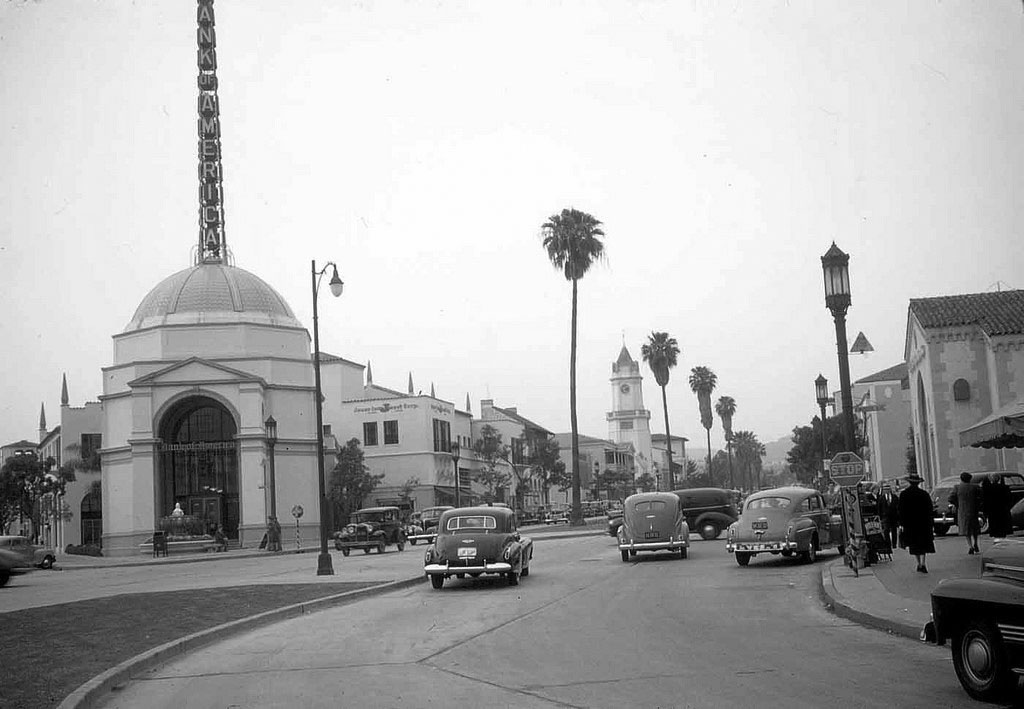 |
|
| (1941)#^ – View looking northeast on Westwood Boulevard. Bank of America (Janss Dome) is on the left and the Holmby Building with its clock tower can be seen in the distance. |
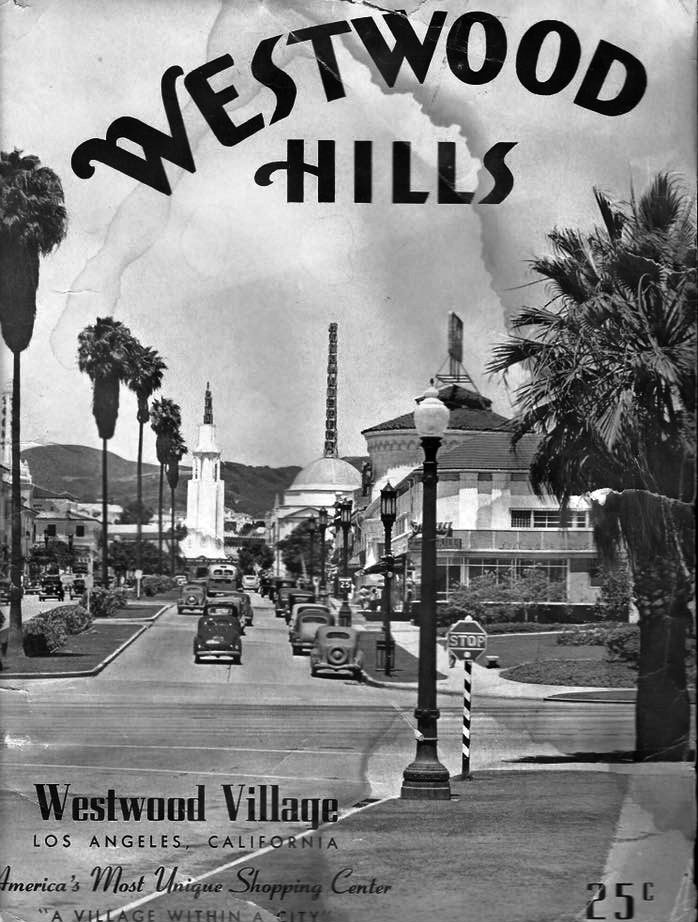 |
|
| (ca. 1940)*^^ – Westwood Hills Magazine cover reads: Westwood Village – America’s Most Unique Shopping Center – “A VILLAGE WITHIN A CITY” |
Historical Notes Westwood Hills Magazine was published by Westwood Hills News Publishing from 1937-1941 and ran as a weekly magazine and cost 25 cents! *^^ |
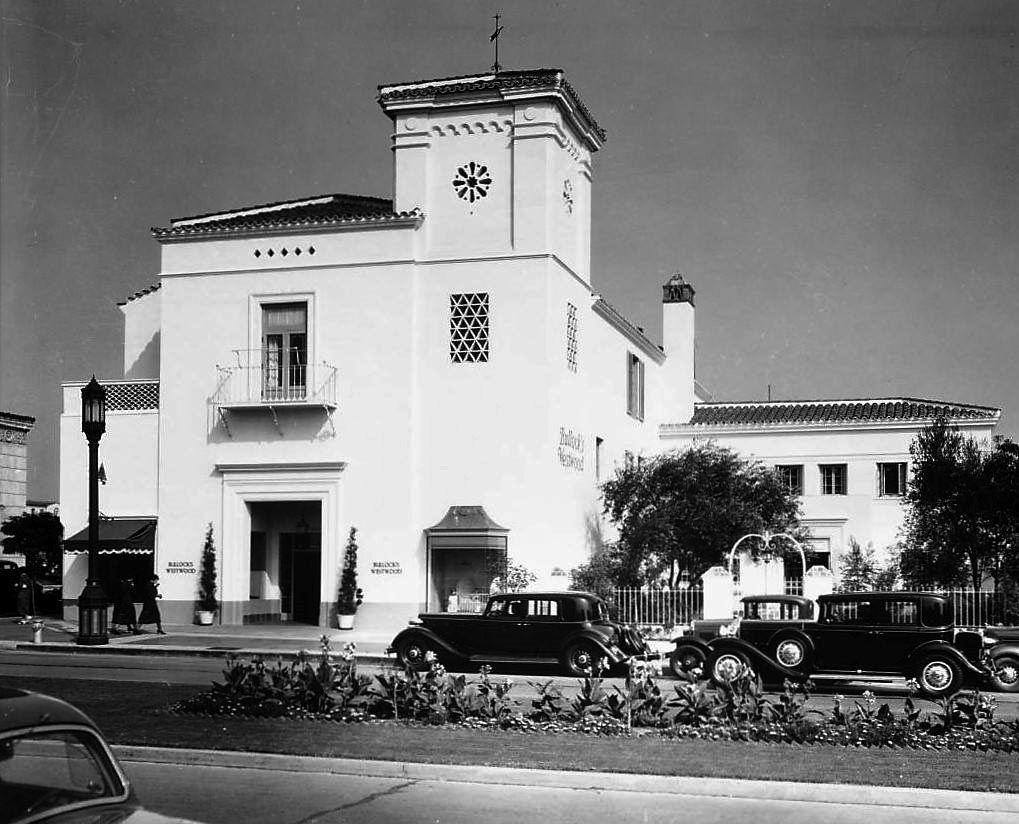 |
|
| (1936)^^ – View of Bullock’s Department Store in Westwood Village, located on the east side of Westwood Boulevard diagonally across the intersection from the Holmby Building. |
Historical Notes The original Bullock's store in Westwood was of Spanish style architecture and served the community from 1932 until 1951. |
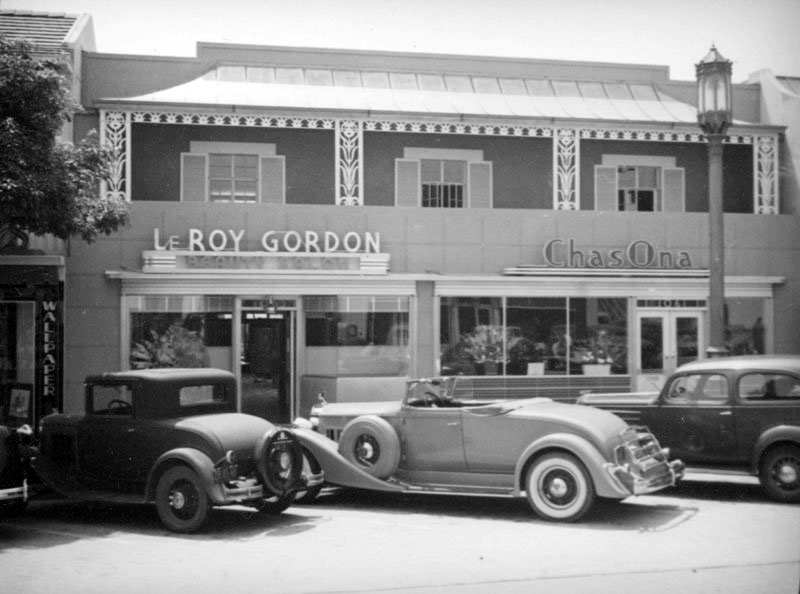 |
|
| (ca. 1937)* - Two shops in Westwood Village: LeRoy Gordon and Chas. Ona, with cars parked in front. The streetlamp on the right was called the "Westwood Special". |
Historical Notes Being adjacent to the University of California at Los Angeles (UCLA), Westwood Village was decorated in the early part of the century with the Westwood Special, notable for the blue and gold ceramic tile around its base. These were replaced with modern lights in the early 1960's when Westwood Village determined to become the brightest lighted commercial area in the world using 1,000-watt mercury vapor lamps. |
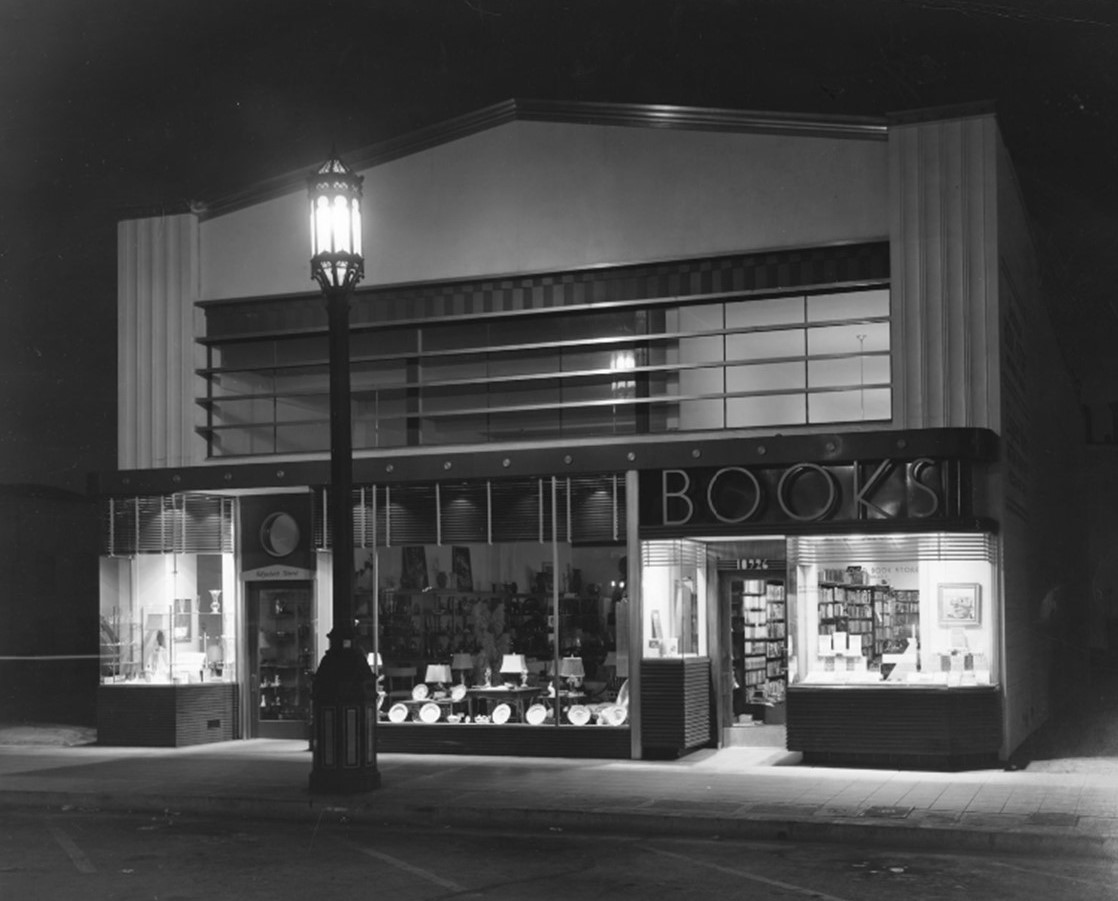 |
|
| (1938)* – View showing an art deco style building located at 10926 Weyburn Avenue in Westwood Village. On the left is a lamp shop with plates and lamps in the display window. Next door, on the right, is the Westwood Bookstore which is still open late at night. A "Westwood Special" streetlight illuminates the building. |
Myer Siegel (Westwood)
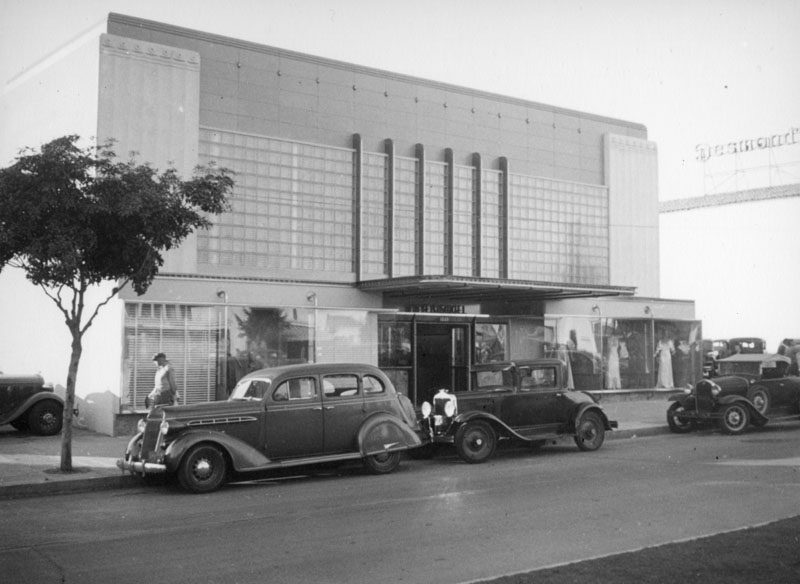 |
|
| (1937)* - View of the newly opened Myer Siegel and Company Store at 1025 Westwood Boulevard. The store opened just in time for Christmas. Photo by Herman Schuleis |
Historical Notes In 1886, Myer Siegel opened his first store at Second and Main in Los Angeles. Designed by architect Allen G. Siple, the Westwood Village store opened in December 1937 and was the fifth store in the chain following Downtown, Pasadena, Wilshire and Beverly Hills. These stores offered better women’s apparel.* |
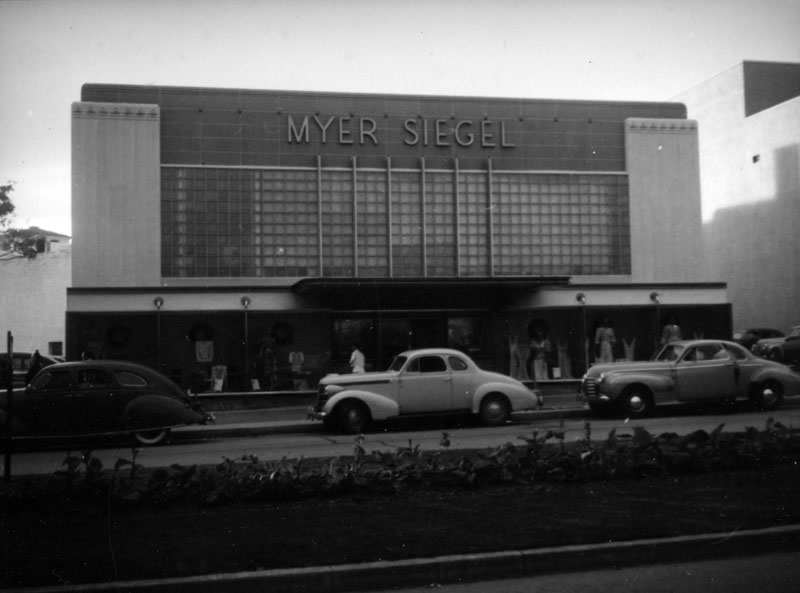 |
|
| (1940s)* - Front view of the Myer Siegel Department Store on Westwood Boulevard. Several late model automobiles are parked along the street. Photo by Herman Schulteis |
Historical Notes The large glass brick panel above the marquee allowed light to enter the mezzanine, and marble wainscoting flanked the entrance which was paved in travertine. The company closed in the late 1950's but the building is still standing today.* |
Then and Now
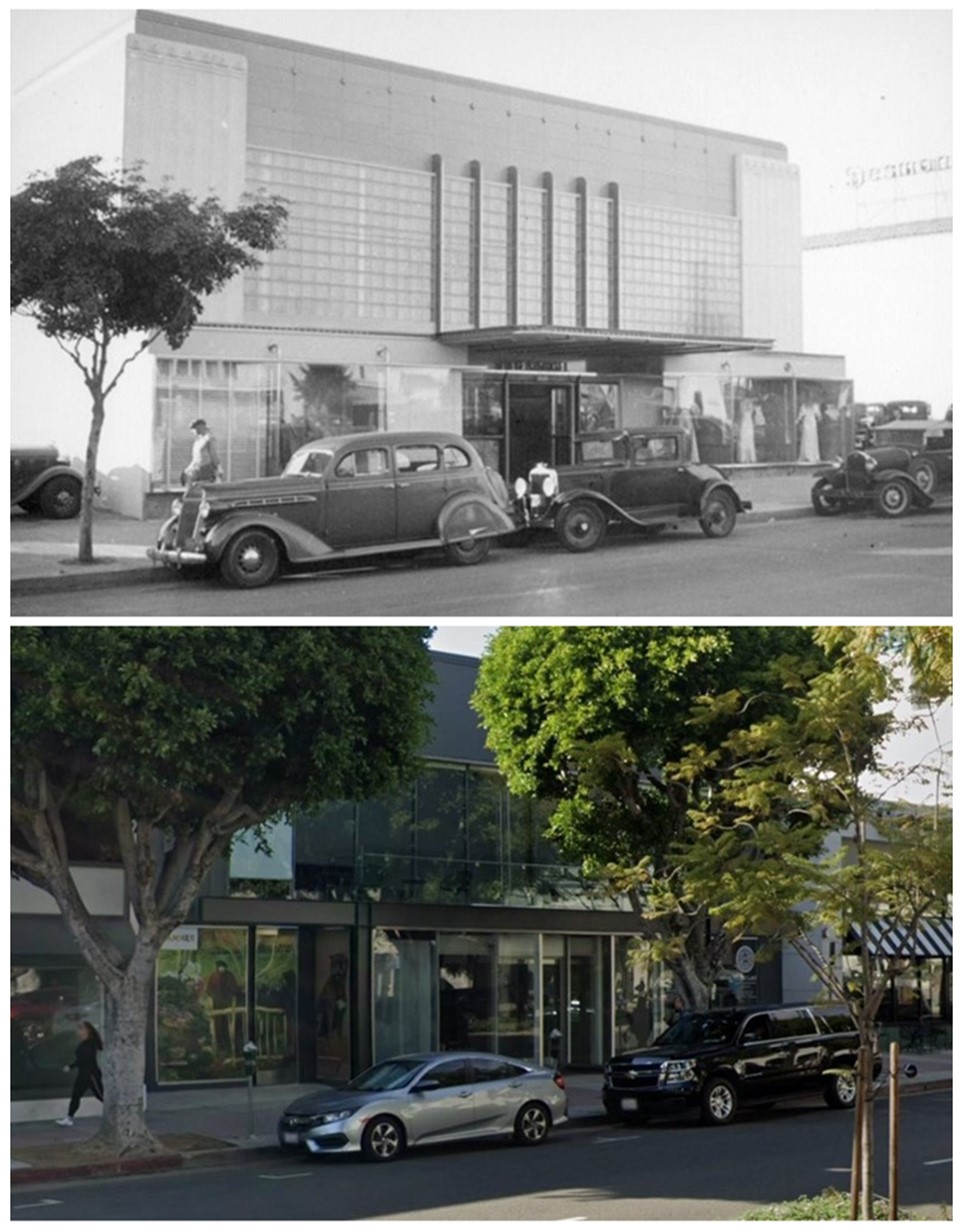 |
|
| (1937 vs 2023)* - Myer Siegel Dept Store Building located 1025 Westwood Boulevard, today occupied by the Float Lab. The one tree on the left appears to be the same. |
.jpg) |
|
| (1940s)^.^ – View looking at Ralphs Market on the corner of Westwood Boulevard and Lindbrook Drive. |
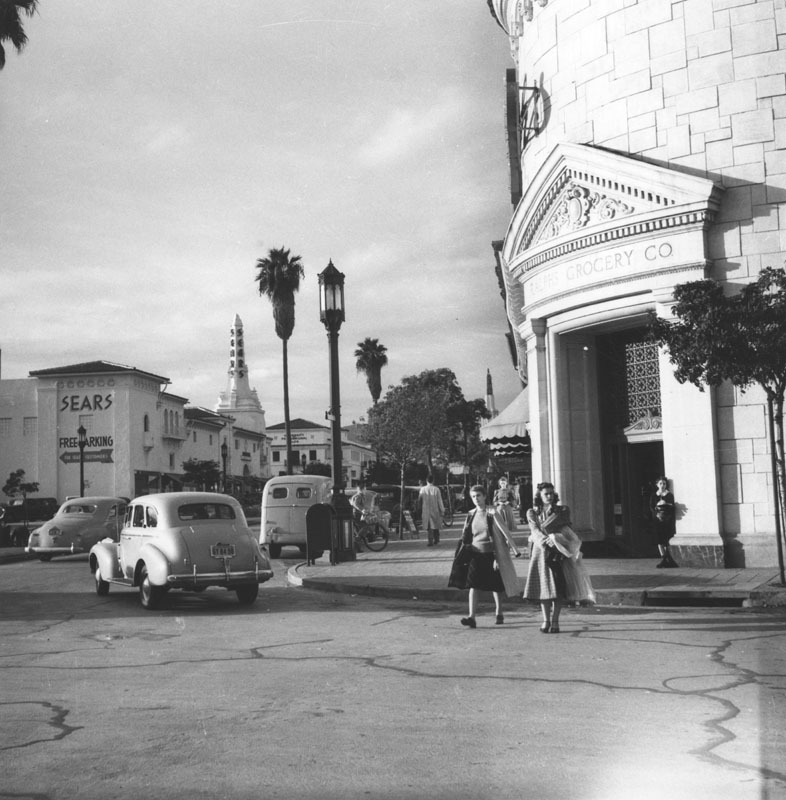 |
|
| (ca. 1940s)* - Two women are seen walking down Lindbrook Drive (foreground) where it meets Westwood Boulevard (left) right outside of a Ralphs supermarket in Westwood Village. Designed by architect Russell Collins and built in 1929, the market is identified by the words "Ralphs Grocery Co.," seen over the doorway. Various businesses, including Sears, are visible in the background, |
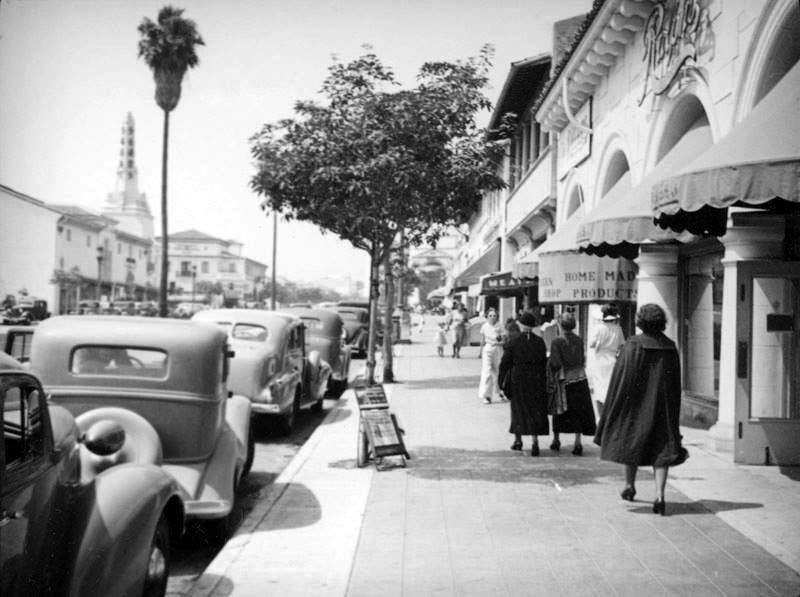 |
|
| (1940s)*#* – View looking north showing shoppers walking by the Westwood Boulevard shops with Ralphs Market on the right. |
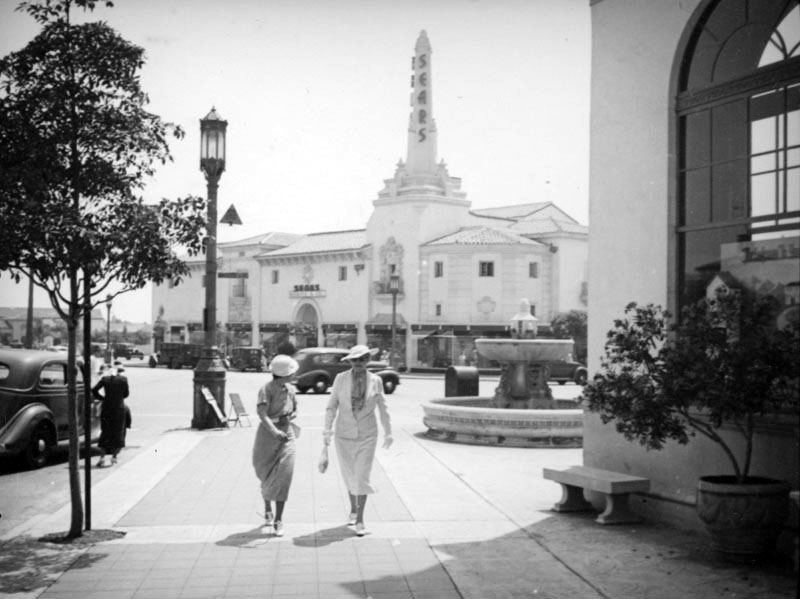 |
|
| (ca. 1940s)* - Women walking down the street adjacent to the Janss Dome located at 1045 Westwood Blvd. Behind them can be seen a large fountain and the Sears store across the street. |
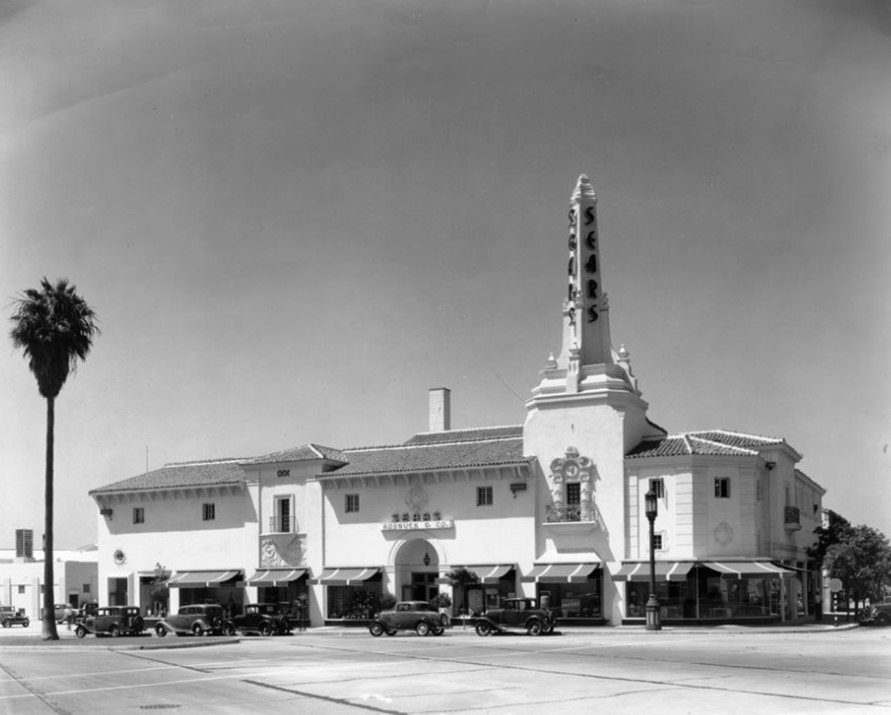 |
|
| (ca. 1936)* – View showing cars parked in front of the Sears store in Westwood at the corner of Westwood and Kinross. |
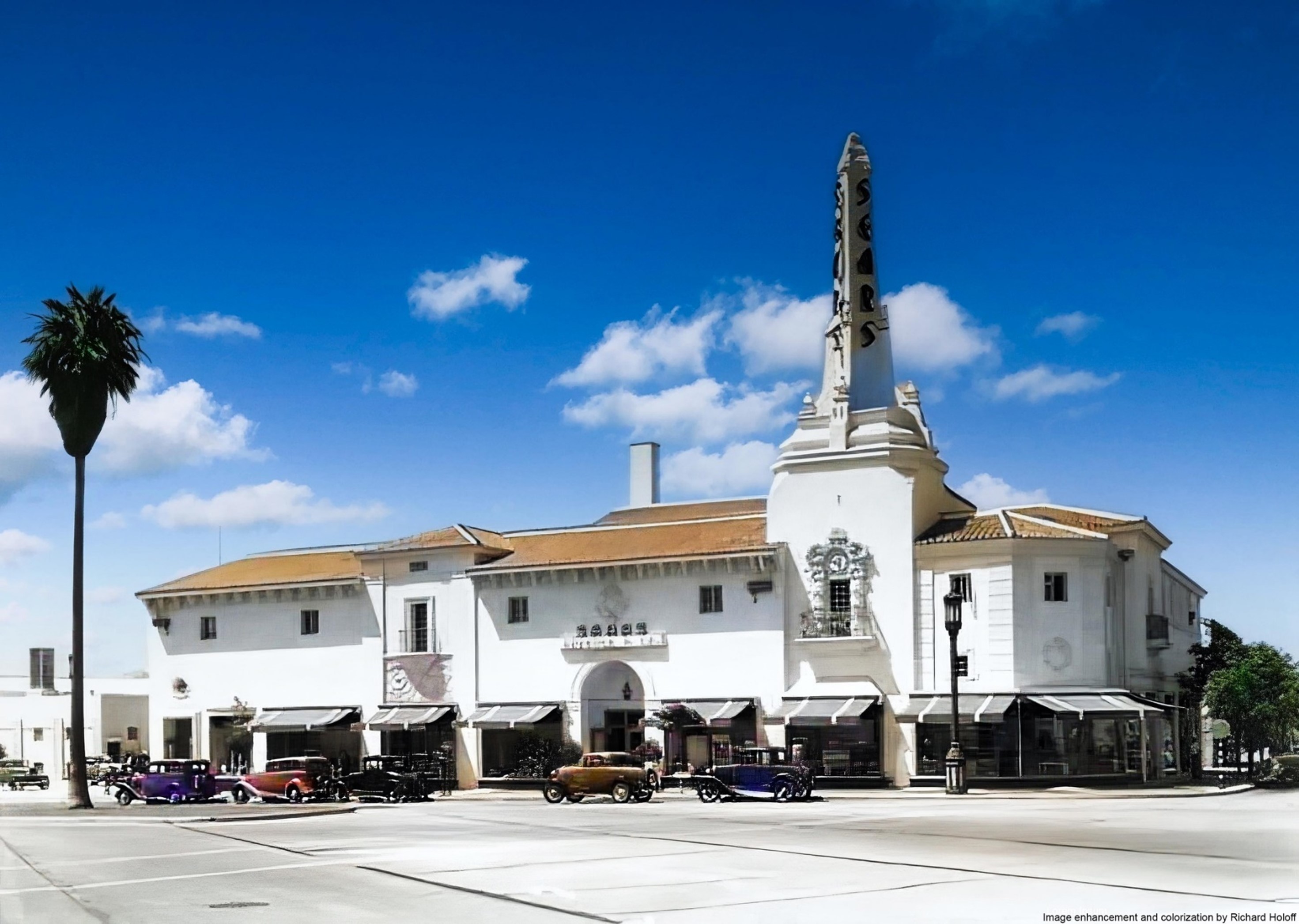 |
|
| (ca. 1936)* – View showing cars parked in front of the Sears store in Westwood at the corner of Westwood and Kinross. Image enhancement and colorization by Richard Holoff. |
Tropical Ice Gardens
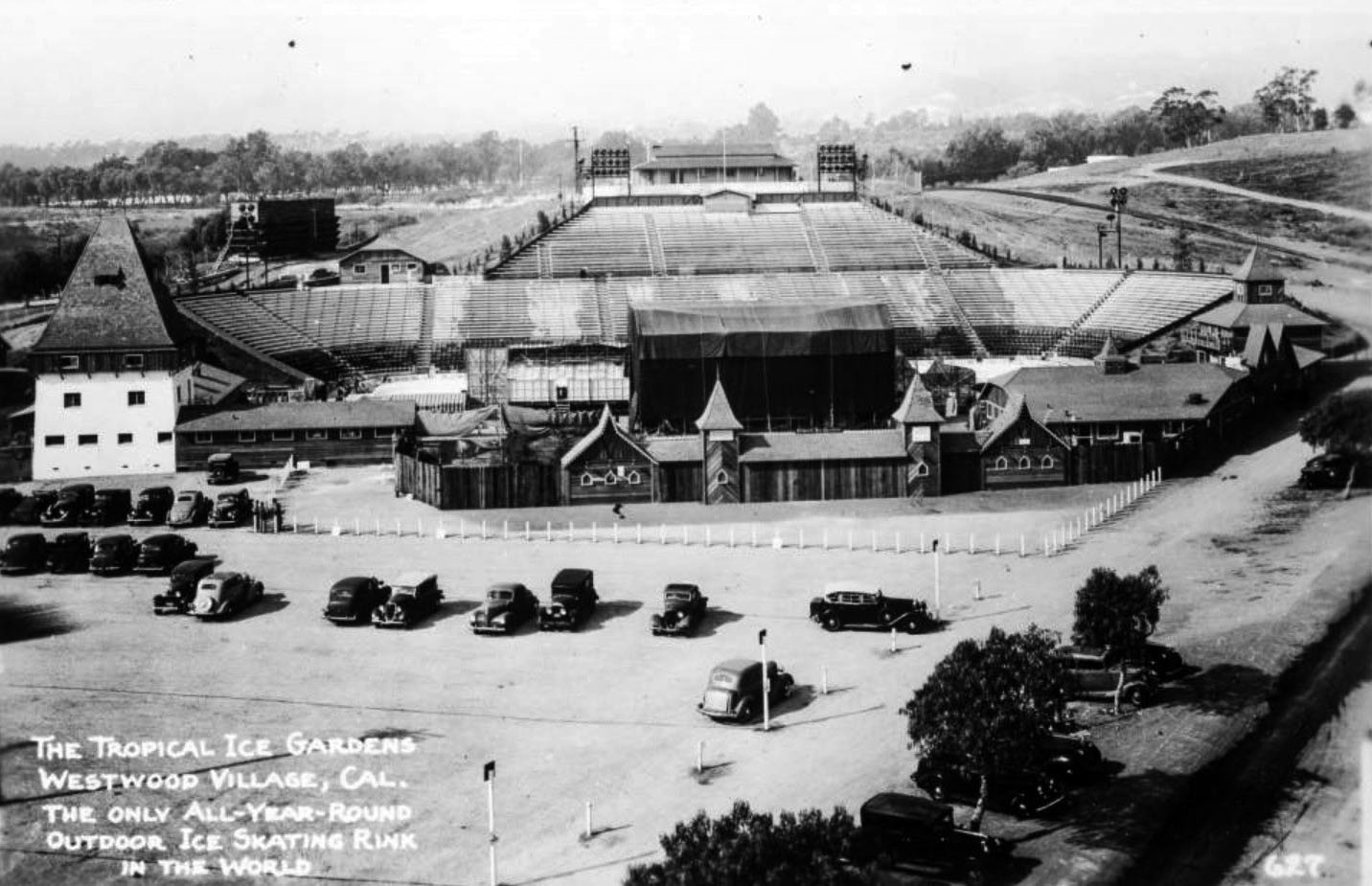 |
|
| (1938)* – Postcard view looking west showing the Tropical Ice Gardens ice skating rink, which opened in 1938 at the corner of Gayley Avenue and Weyburn Avenue in Westwood. Writing on photo reads: “The Tropical Ice Gardens, Westwood Village. The Only All-Year-Round Outdoor Ice Skating Rink in the World”. |
Historical Notes The Tropical Ice Gardens opened in November 1938 at the corner of Gayley Avenue and Weyburn Avenue in Westwood Village, near the UCLA campus. It was billed as the "world's first year-round, outdoor ice skating rink" and aimed to recreate an Alpine village setting despite Los Angeles' warm climate. The facility occupied 21,000 square feet and could accommodate around 2,000 skaters and 12,000 spectators in the stands. |
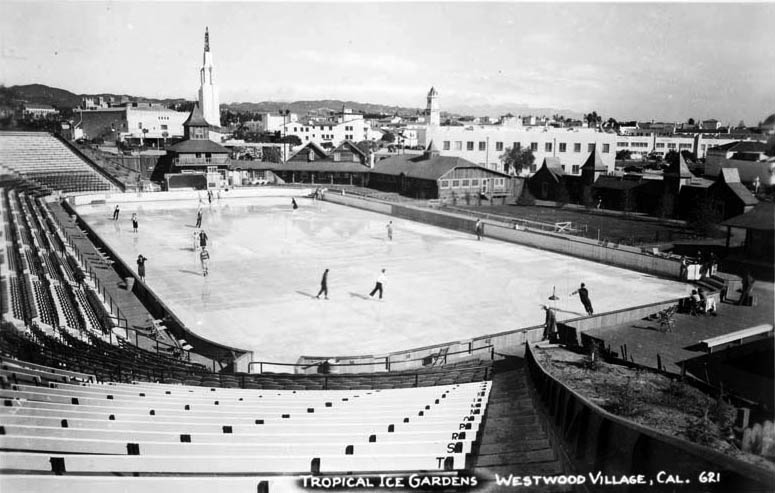 |
|
| (ca. 1939)* - Postcard view of the Tropical Ice Gardens in Westwood Village. The Fox Theater Tower can be seen in the background. |
Historical Notes UCLA's ice hockey team, formed in 1926, played its home games at Tropical Ice Gardens and had a rivalry with USC. The Tropical Ice Gardens also hosted hockey games, ice dancing shows, comedy and animal ice shows, as well as skating clubs. In 1945 the Tropical Ice Garden merged with the Mercury Figure Skating Club to become the All-Year Mercury AFC. |
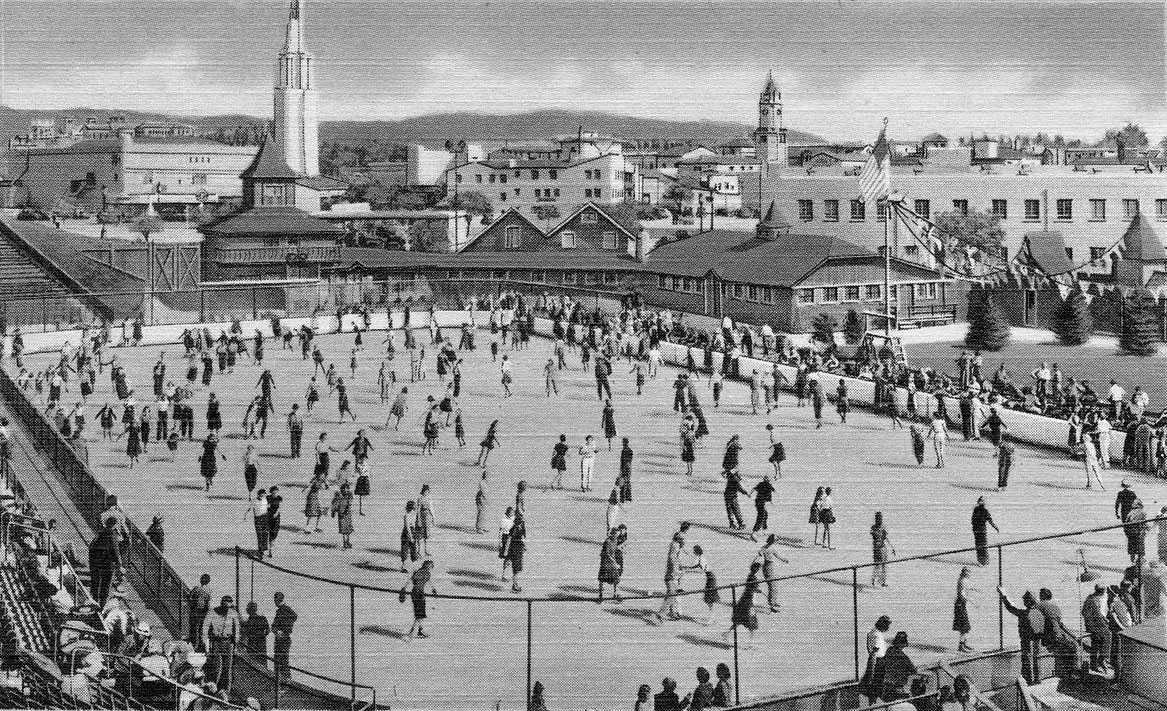 |
|
| (1930s)* – Postcard image showing a full house at the year-round Westwood Village ice skating rink. |
Historical Notes The massive outdoor rink measured 21,000 square feet and used refrigeration technology to maintain the ice year-round. |
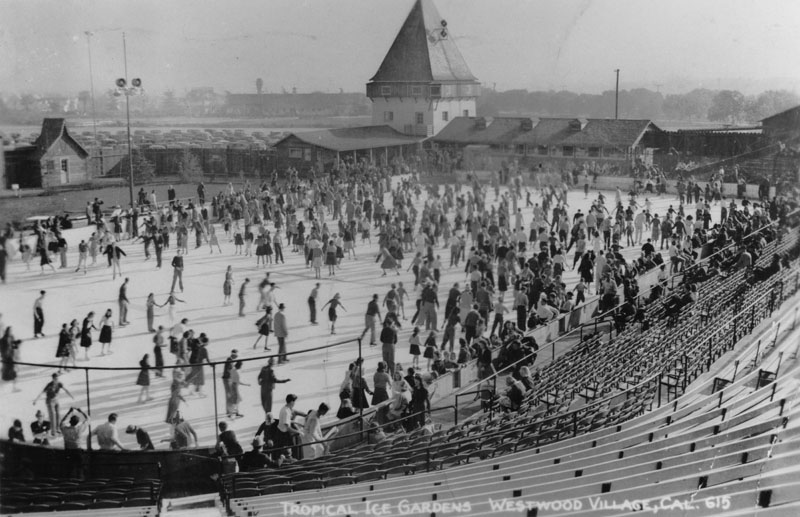 |
|
| (1939)* - Postcard photo of Tropical Ice Gardens looking southeast, showing an almost filled-to-capacity ice rink. |
Historical Notes The rink became known as the "Sonja Henie Ice Palace" after the famous Norwegian Olympic figure skater's films were shot there in the 1940s. |
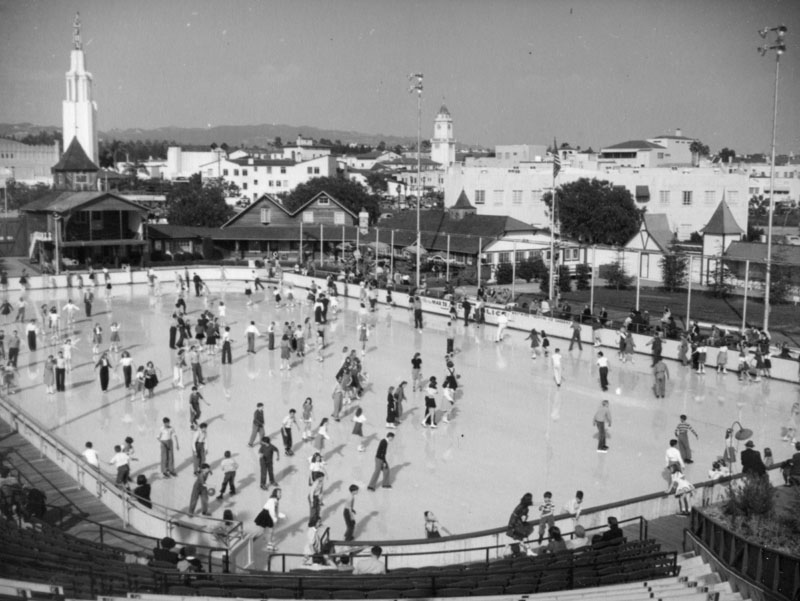 |
|
| (ca. 1940s)* - View from high up in the bleachers, where large crowds can be seen enjoying the large outdoor ice skating rink at Tropical Ice Gardens, located in Westwood Village. The towers of both the Holmby Building and the Fox Westwood Village Theatre can be seen in the background. |
Historical Notes Tropical Ice Gardens appeared in so many films starring Norwegian Olympic champion Sonja Henie that people referred to it as her rink, though she never actually owned it. By 1949 the Tropical Ice Gardens was called the Sonja Henie Ice Palace. |
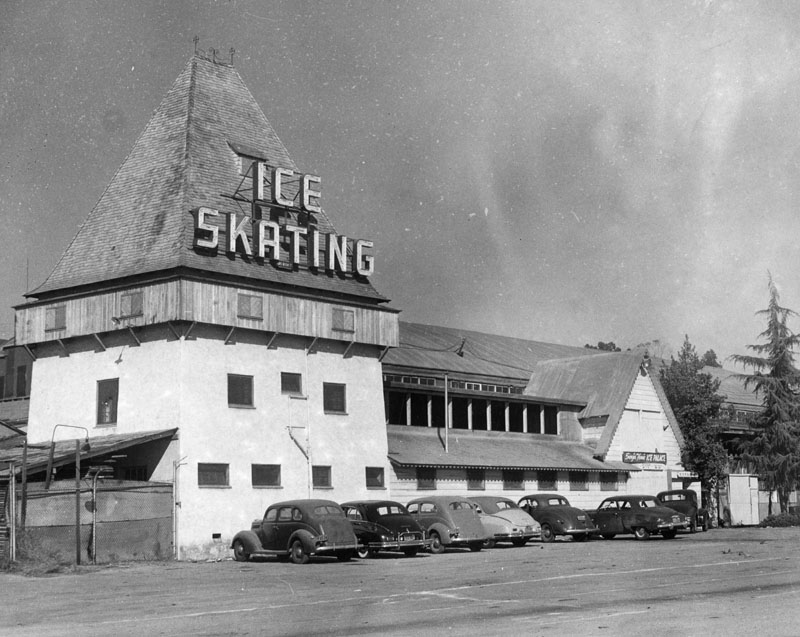 |
|
| (1949)* - View showing the Alpine-style buildings and parking lot of the Tropical Ice Gardens in Westwood Village. A line of early model cars are parked in front of the building. |
Historical Notes The rink closed in 1949 to make way for UCLA's westward expansion of its campus into Westwood Village. |
* * * * * |
Fox Theatre (aka Fox Westwood Village Theatre)
 |
|
| (1938)* – Postcard view looking northwest on Broxton Avenue showing the Fox Westwood Village Theater. |
Historical Notes Opened on August 14, 1931, “The Fox” as it was known for decades, was the first motion picture theater and the first entertainment facility built in Westwood Village. Its soaring 17-story tower, capped by a three-sided spire in blazing blue-and-gold neon sign that says “FOX,” has been a dominant Westwood landmark for more than 80 years. |
 |
|
| (ca. 1938)* - View looking west down Weyburn Avenue towards the Fox Theater (later the Village Theater) in Westwood Village, located on the northwest corner of Weyburn and Broxton avenues. |
Historical Notes Designed by architect Percy Parke Lewis in Spanish Colonial Revival style with Classical Revival influences, the Fox opened in 1931 as part of a widespread cinema construction program undertaken by Fox West Coast Theatres. The Fox Theater quickly became the most recognizable symbol of the new Westwood Village. |
 |
|
| (ca. 1938)* - Fox Theater is in the center of the picture, FOX clearly visible at the top of the building, and streamers of flags hanging from mid-high on the building down to the bop of the marquee. Advertised on the marquee is the movie My lucky star with Sonja Henie, R. Greene. On the right in the picture is the Bruin Theater. |
 |
|
| (1951)* - Nighttime view of the Fox Westwood Village Theater. Crowds of people stand at the front of the theater to attend a premiere. |
Historical Notes A feature of the building is the huge ‘wedding cake’ tower which is still virtually unchanged today, and still sports its original neon lighting. |
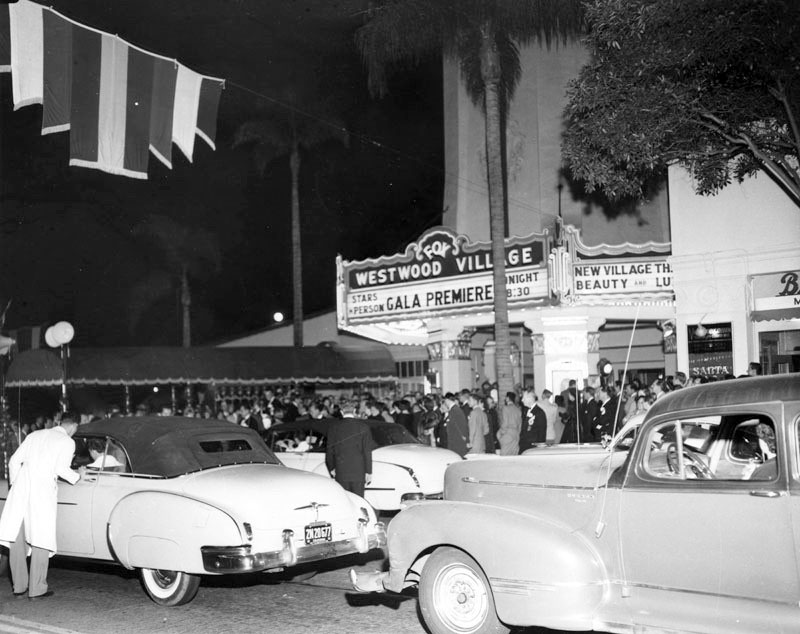 |
|
| (1951)* - Premier night at the Fox Westwood Village Theater (later renamed the Mann Village Theater). The marque reads: ‘Gala Premiere - Stars in Person - Tonight 8:30’. The street in front is completely filled with two rows of cars arriving for the gala, with attendants at the front cars to assist those arriving. The sidewalks underneath the marquee are filled with people. |
Historical Notes After more than 70 years as a first run movie palace, the Village Theatre is still one of the sites for Hollywood’s biggest movie premieres. Regency Theatres replaced Mann Theatres as the movie operator on April 1, 2010. Click HERE to see contemporary view. |
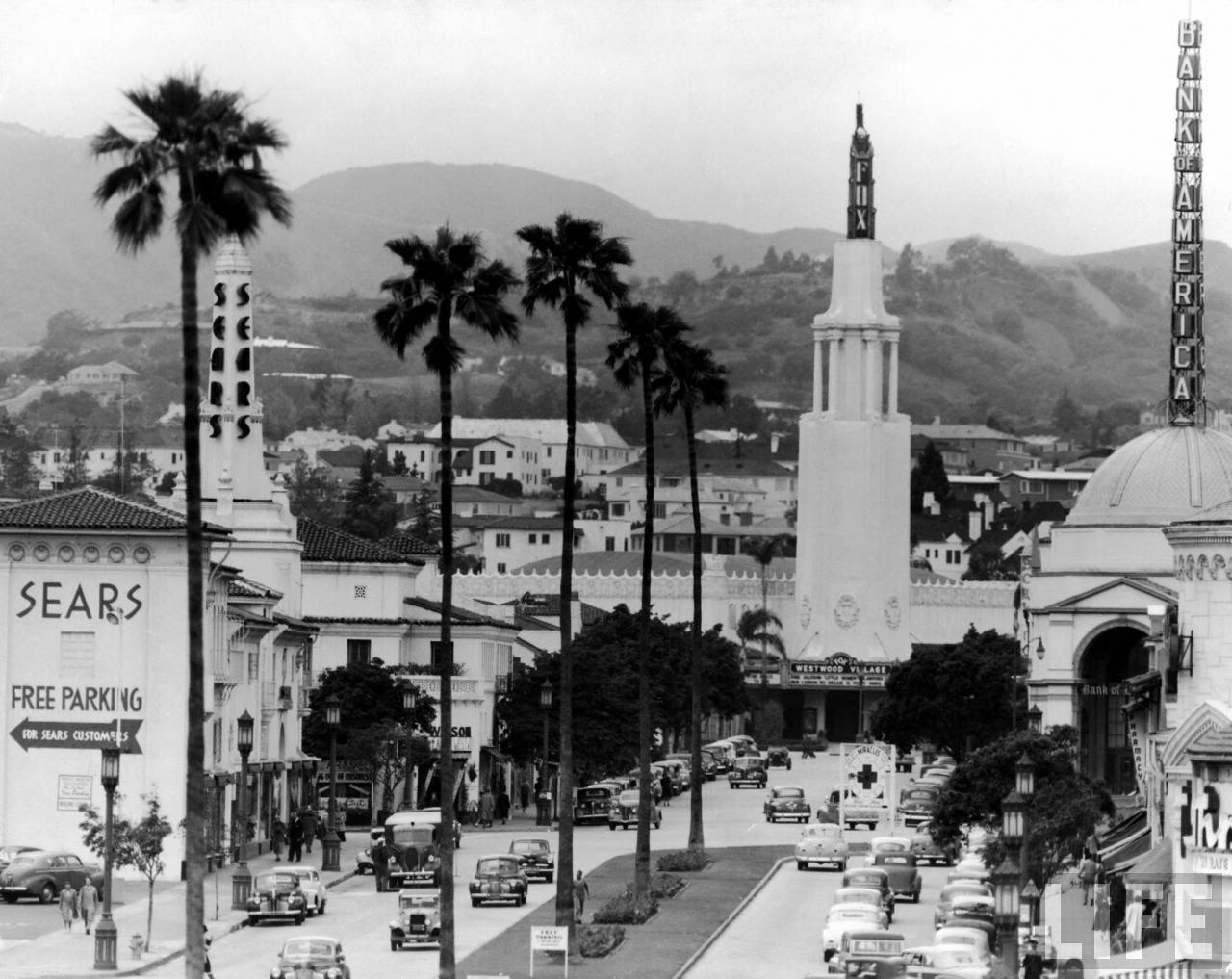 |
|
| (1949)^# - View looking northwest down Broxton Avenue. The towers of the Sears, Fox Theater, and Bank of America buildings can be seen in the background. Life Magazine Photo. |
Historical Notes A number of notable buildings remain from the early years of Westwood Village, including: The Fox Theater (or Village Theater) features a landmark 170-foot white Spanish Revival/Moderne tower and Churrigueresque stucco decorations. The theater looms over the Broxton and Weyburn Avenues intersection. Built in 1931 this cinema later became famous for the many movie premieres held there. The Janss Dome (Janss Investment Company Building) the first building to be built in Westwood Village in 1929, is another village landmark with its dome on an octagonal base, portico and large arched windows. The Dome is situated at the three-way intersection of Westwood Boulevard, Broxton and Kinross Avenues. Ralphs Market Building, also built in 1929, is a red tile-roofed Spanish Colonial Revival building featuring a rotunda with a pediment over the entrance and arcaded wings, at 1142–1154 Westwood Boulevard. The Bruin Theater (1937), a streamlined Art Deco cinema, which sits just across Broxton Avenue opposite the Fox Theater. These four buildings have all been declared Los Angeles Historic-Cultural Monuments (Click HERE to see complete list). Another village landmark is Holmby Hall (1929), a Spanish Colonial Revival building featuring a clock tower which was damaged by fire around 2003, located at the corner of Weyburn Avenue and Westwood Boulevard. |
 |
|
| (1980s)* – View looking west on Weyburn Avenue toward the Fox Westwood Village Theatre on Broxton Avenue, with a pedicab visible in the foreground. Photo courtesy of Obet Maldonado. |
Historical Notes In the ’80s, getting around the village by pedicab—a mix of rickshaw, bicycle, and taxi—was a popular option. Drivers had to be male, with at least two years of college and a 3.0 GPA or higher. Dressed in tuxedo shirts, shorts, and bow ties, they got quite a workout on the job, while passengers paid $3 per ride. |
* * * * * |
Bruin Theatre
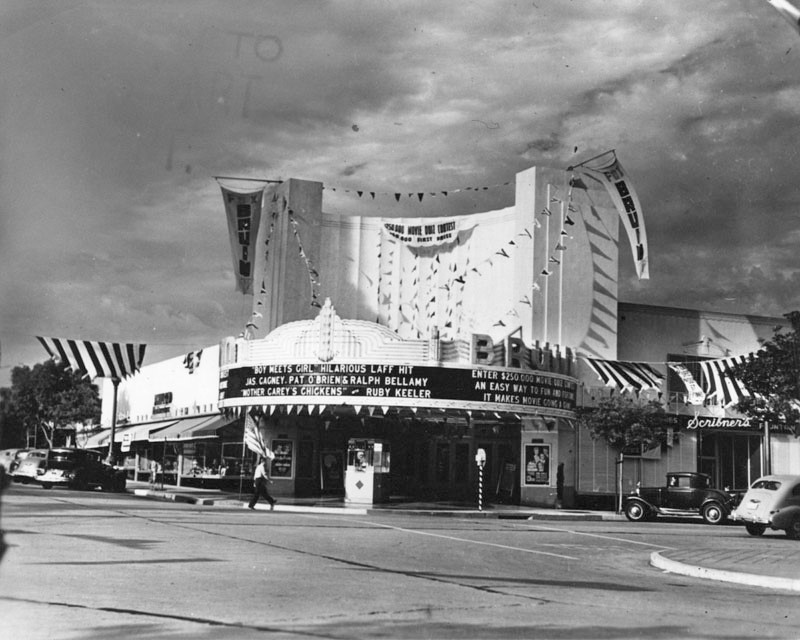 |
|
| (1938)* – View looking at the Bruin Theater located on the northeast corner of Broxton and Weyburn avenues, across the street from the Fox Theatre. The marquee wraps around the corner to be seen from all directions. |
Historical Notes The Bruin Theater opened across the street opposite the Fox Theater in 1937, as the second movie theater in the Village. This City Historic-Cultural Monument was designed by renowned theater architect S. Charles Lee in Streamline Moderne style, with UCLA inspired blue-and-gold neon flashing along the sweeping curve of its Art Deco style theater marquee. |
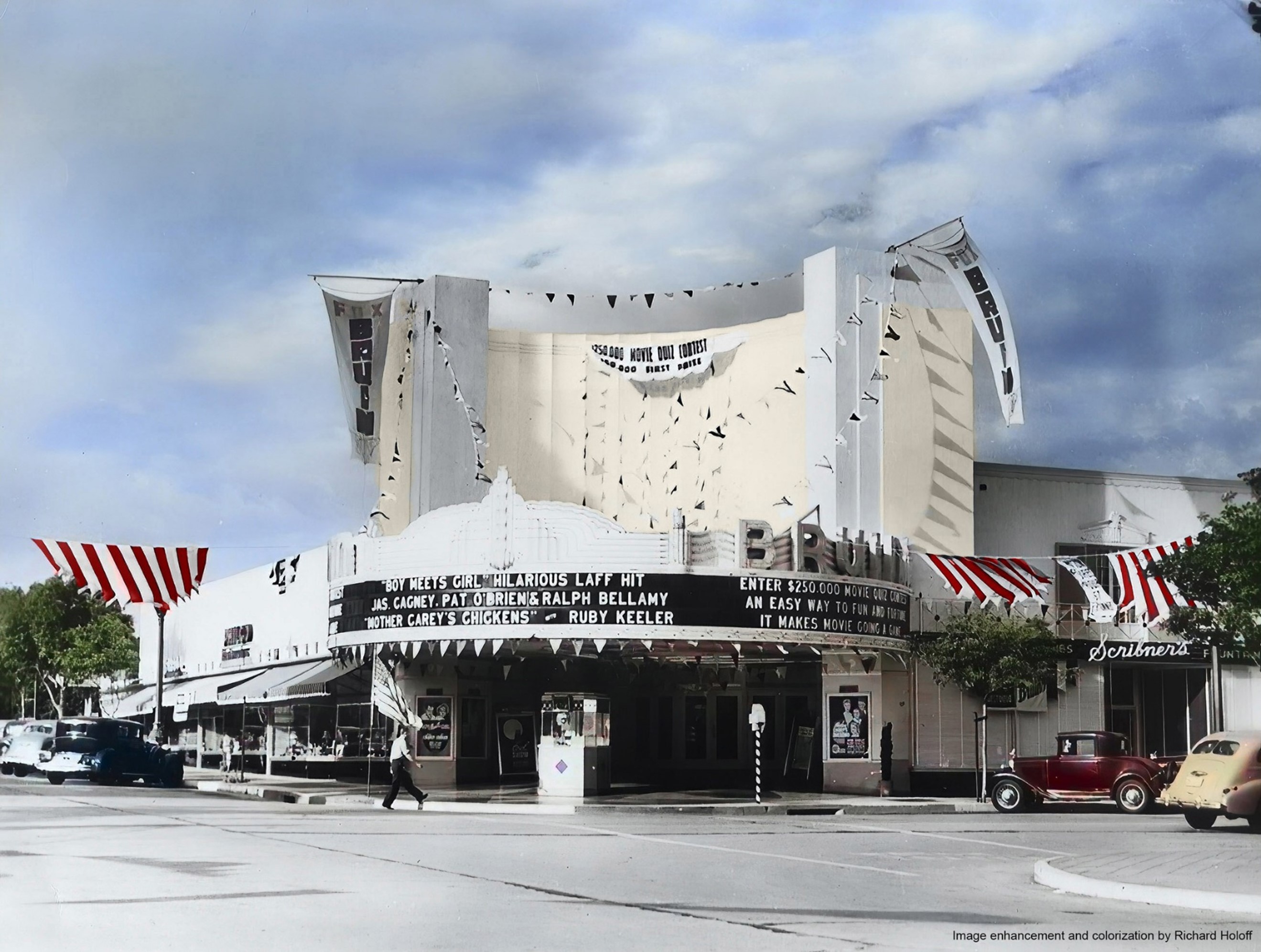 |
|
| (1938)* – View looking at the Bruin Theater located on the northeast corner of Broxton and Weyburn avenues, across the street from the Fox Theatre. The marquee wraps around the corner to be seen from all directions. Image enhancement and colorization by Richard Holoff. |
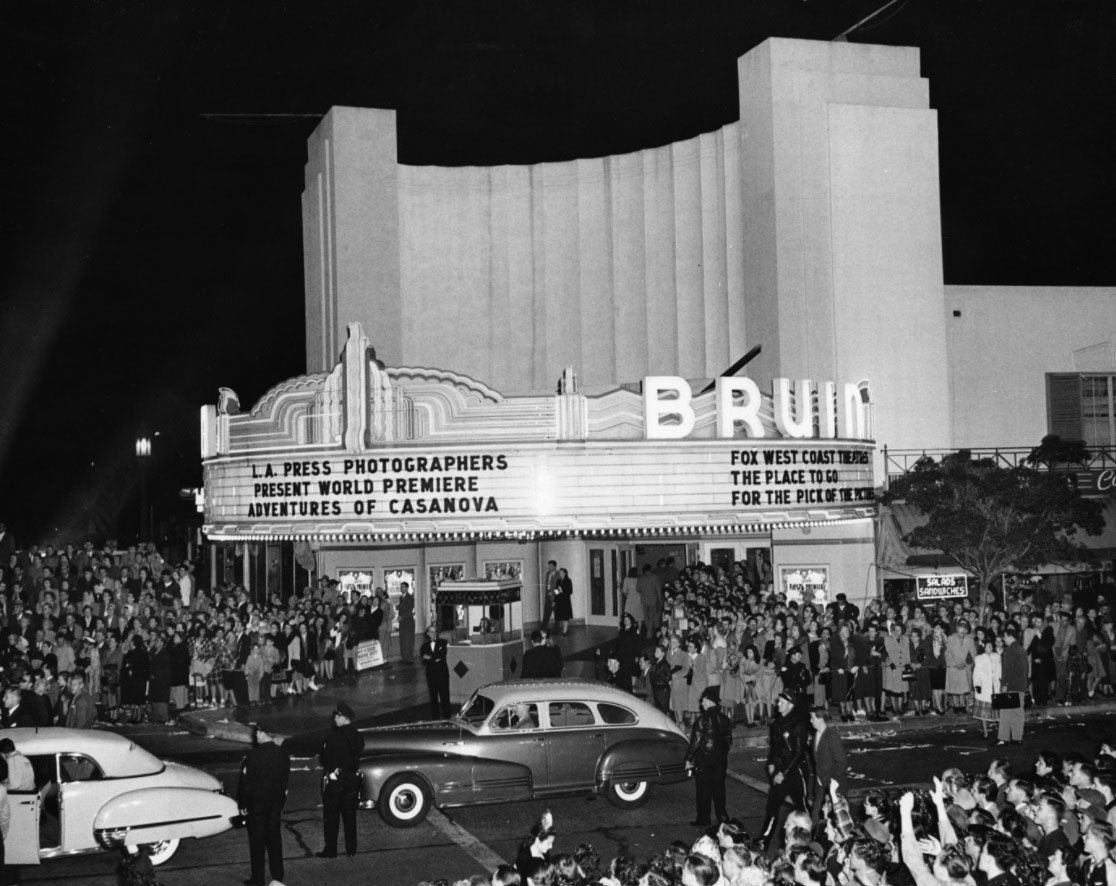 |
|
| (1948)* – Bruin Theater premier of “Adventures of Casanova” getting the Hollywood red carpet treatment. Throngs of movie fans surround the theater, eager to catch a glimpse of their favorite stars. |
Historical Notes The Fox Bruin Theatre originally had 876 seats, all on a single floor. It was designed by architect S. Charles Lee, one of the foremost & prolific theatre architect’s in Southern California, who’s earlier work included the downtown Tower Theatre and Los Angeles Theatre. |
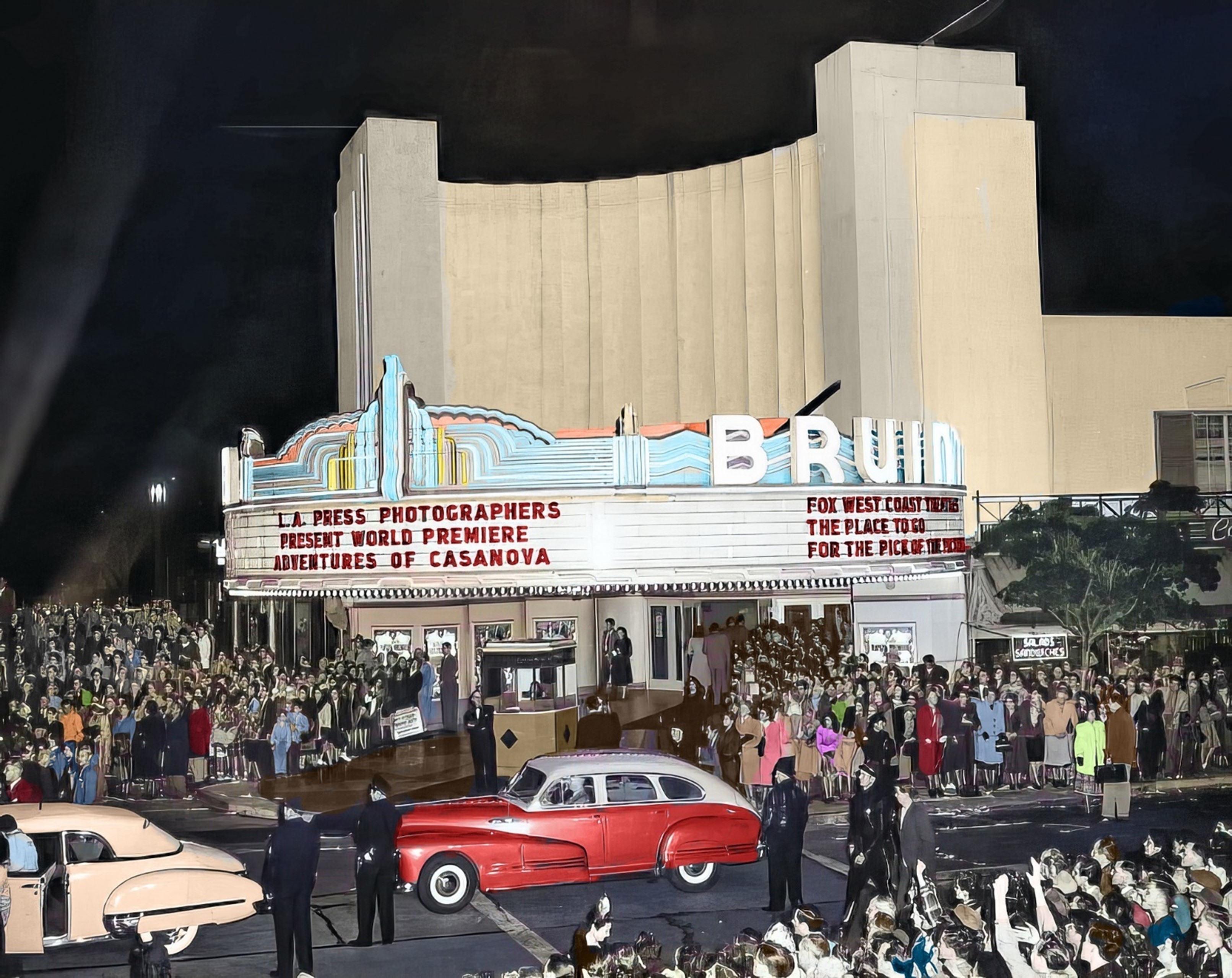 |
|
| (1948)* – Bruin Theater premier of “Adventures of Casanova” getting the Hollywood red carpet treatment. Throngs of movie fans surround the theater, eager to catch a glimpse of their favorite stars. Image enhancement and colorization by Richard Holoff |
Historical Notes The theater was taken over by Mann Theatres chain in 1973 and was equipped to screen 70mm movies in 1978. Regency Theatres replaced Mann Theatres as the movie operator on April 1, 2010. Click HERE for contemporary view. |
* * * * * |
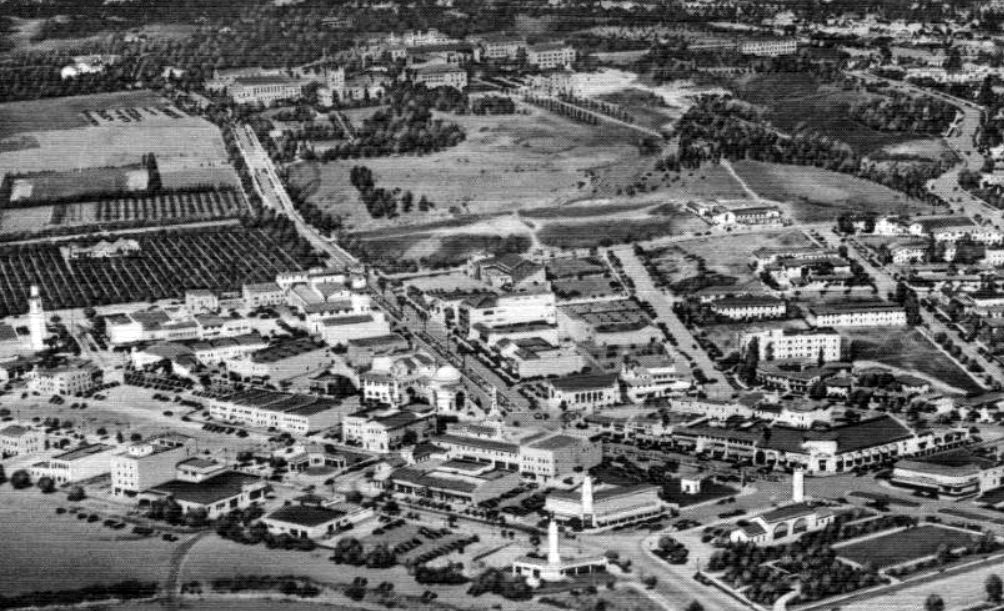 |
|
| (1939)## – Postcard view of Westwood Village showing the University of California (UCLA) in the background. |
Historical Notes Back of postcard reads: Westwood is a district 13 miles west of downtown Los Angeles, and includes the campus of the University of California, Los Angeles (UCLA), a residential neighborhood, and Westwood Village, a shopping district. Clustered around its central thoroughfare of Westwood Boulevard, the shopping district serves the affluent neighborhoods of Bel Air and Westwood to the north, as well as students from UCLA. ## |
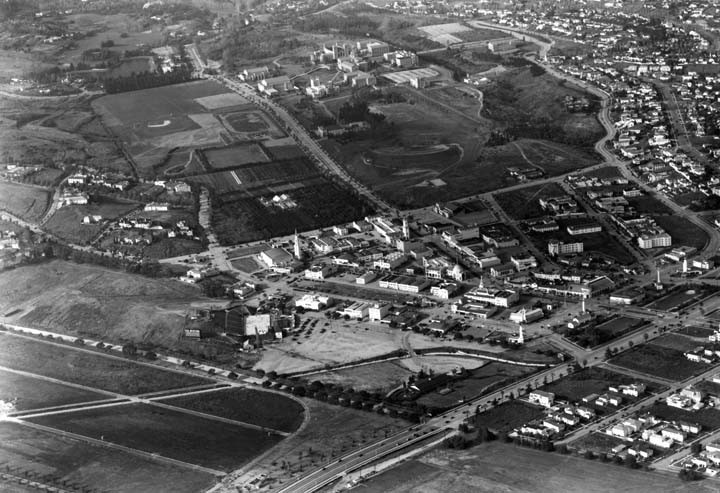 |
|
| (1940)#^ – Aerial view looking northeast showing a built-up Westwood Village. The UCLA campus can be seen in the distance at top of photo. Venteran Avenue runs diagonally from lower-right. Sepulveda Boulevard is at lower-left (out of view). |
.jpg) |
|
| (1937)* – View looking north on Sepulveda Boulevard from Wilshire Boulevard in Westwood, showing the pepper trees as they appeared at sundown. This section of the boulevard was also known as Pepper Tree Lane. Click HERE for contemporary view. |
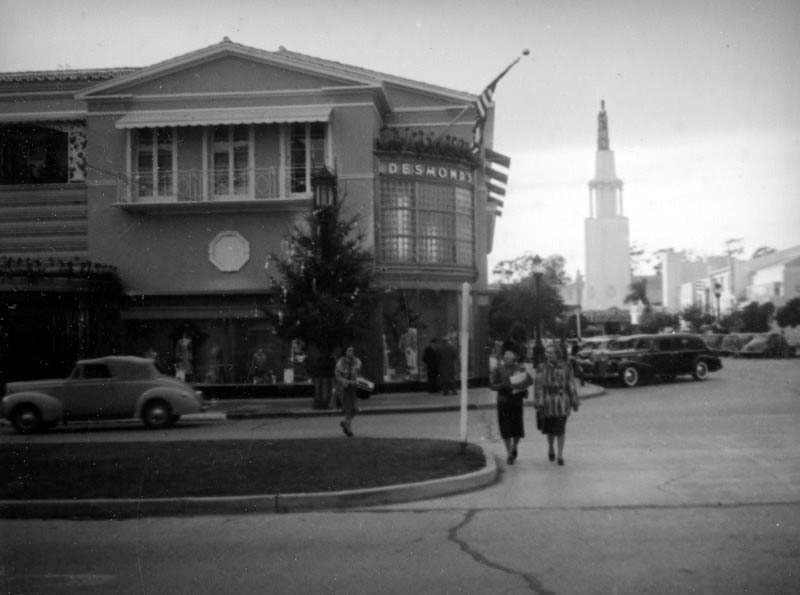 |
|
| (1940s)* - View of Desmond's Department Store, located at 1001 Westwood Boulevard. Several people can be seen walking across Weyburn Avenue, and the white tower of the Fox Theater, later Village Theater, is visible in the background on the right. |
Historical Notes The first Desmond's Department Store was opened on Olvera Street in 1862. In 1921, Ralph R. Huesman purchased the store from the Desmond family and led the expansion of the retailer to several locations throughout the Southern California market.* Today, a CVS Pharmacy occupies the old Desmond's Store. Click HERE to see contemporary view. |
 |
|
| (1940)^^ – View looking south on Westwood Boulevard from Weburn Avenue showing Desmond's Department Store, Bank of America, and Myer Siegal. Photo by Dick Whittington |
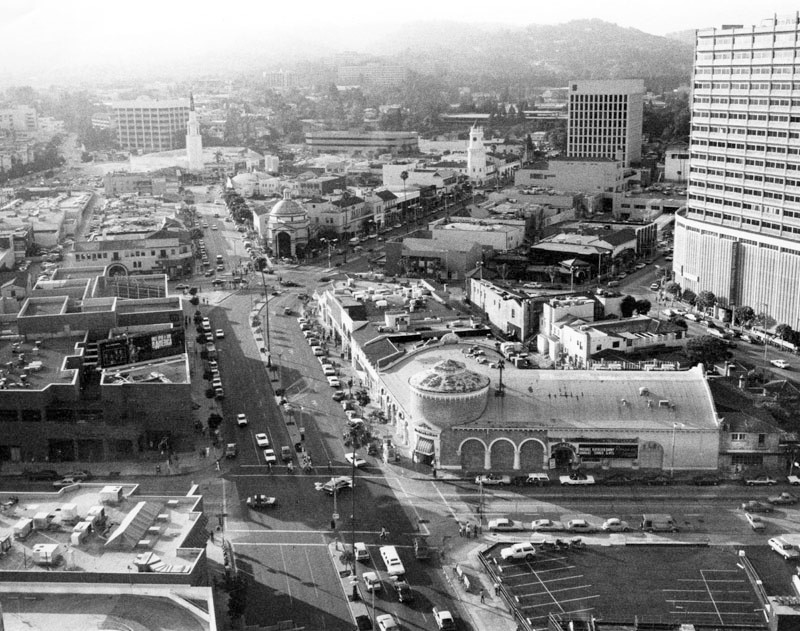 |
|
| (1954)* - Aerial view looking north on Westwood Boulevard from just south of Wilshire Boulevard. The Bank of America (Janss Dome) can be seen at center-top. Also seen are the towers of Fox Theatre and the Holmby Building. |
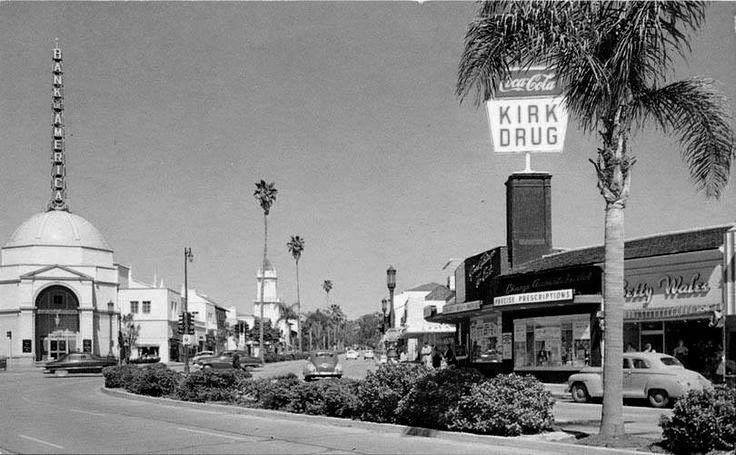 |
|
| (1950s)^^# – View looking northeast showing where Westwood Boulevard meets Kinross Avenue. The striking Bank of America building (today Yamato Restaurant) with its soaring tower is on the left with Kirk Drug Store on the right. The Bette Wales store specializing in ladies sportswear is on the far right. |
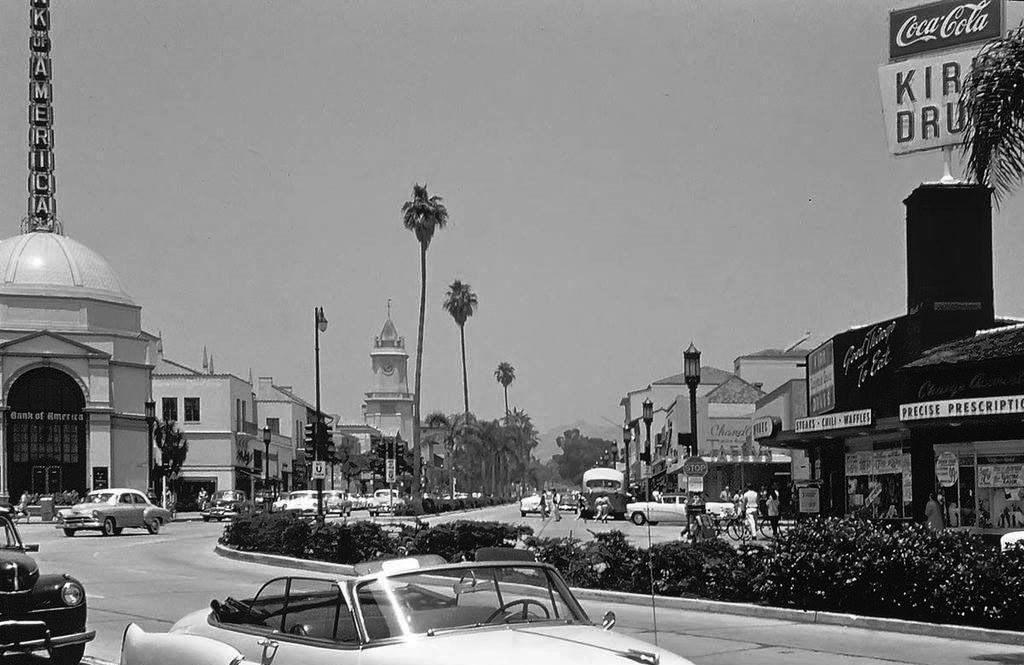 |
|
| (ca. 1956)*#* - Another view looking northeast on Kinross Avenue from Westwood Boulevard with an early 1950s Cadillac convertible in the foreground. |
Then and Now
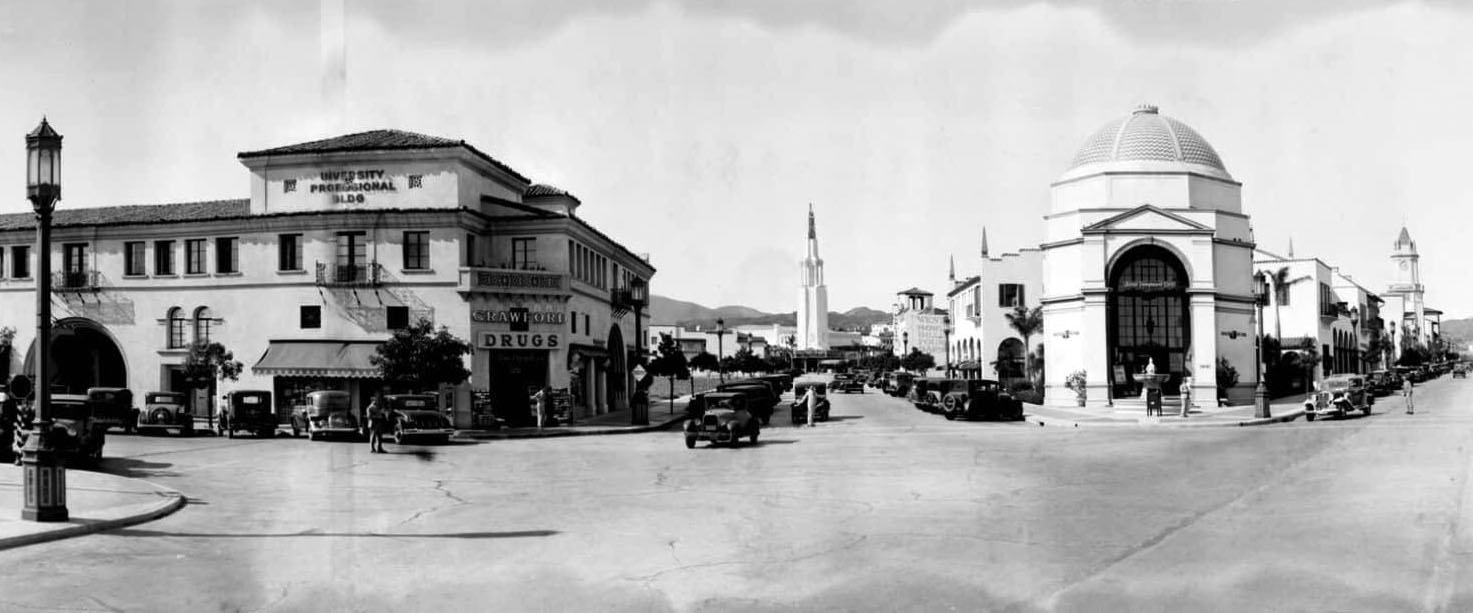 |
|
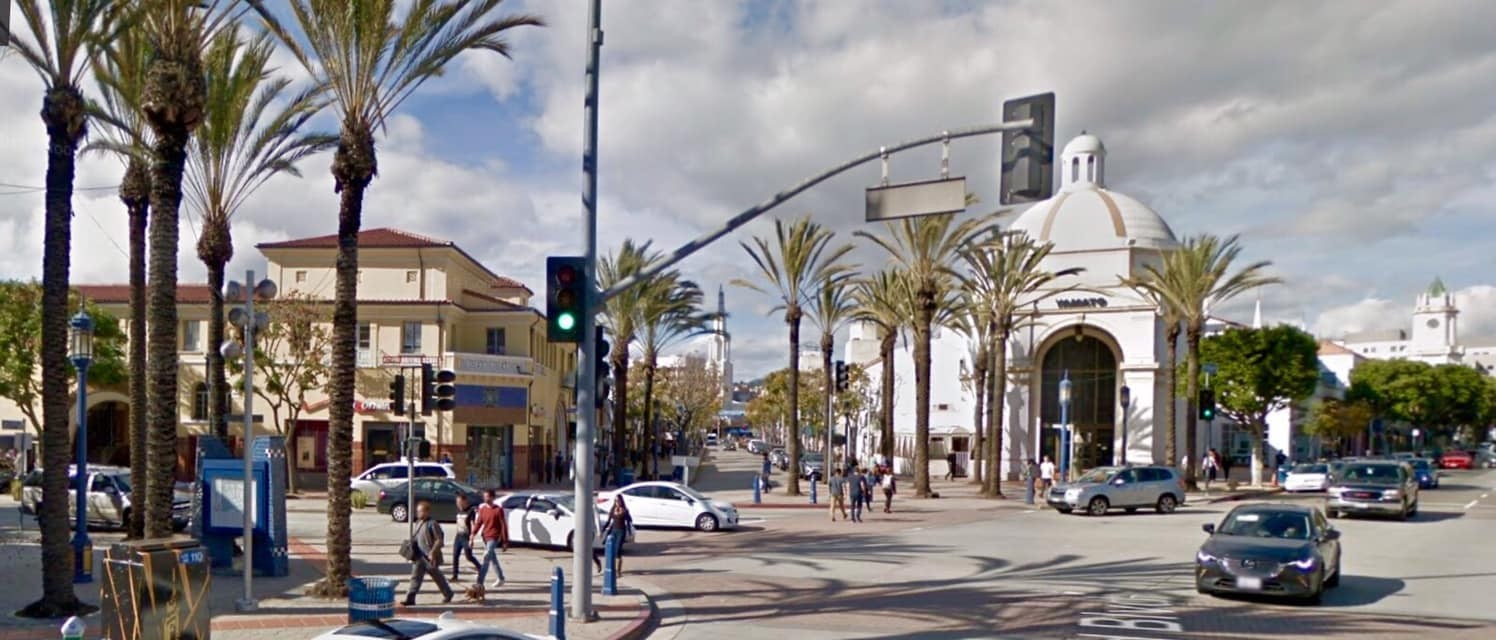 |
|
| (1932)* vs. (2021)^ - Then and Now |
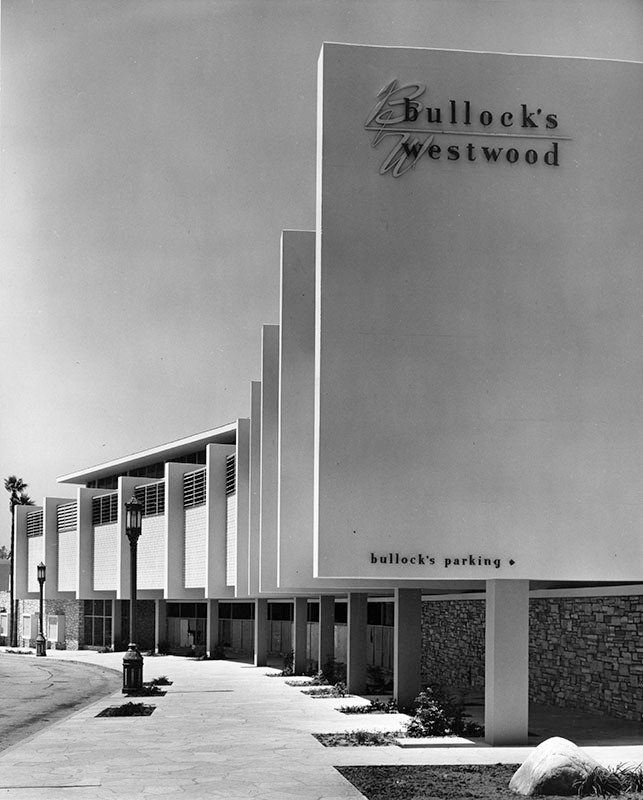 |
|
| (1951)* - Exterior view of the recently completed Bullock's Westwood, located at 10861 Weyburn Avenue in Westwood Village. Photograph dated September 5, 1951. |
Historical Notes The new Westwood Bullock’s replaced the original Bullock's store that was of Spanish style architecture and served the community from 1932 until 1951. The store contained three-levels and included unique four-level parking.* |
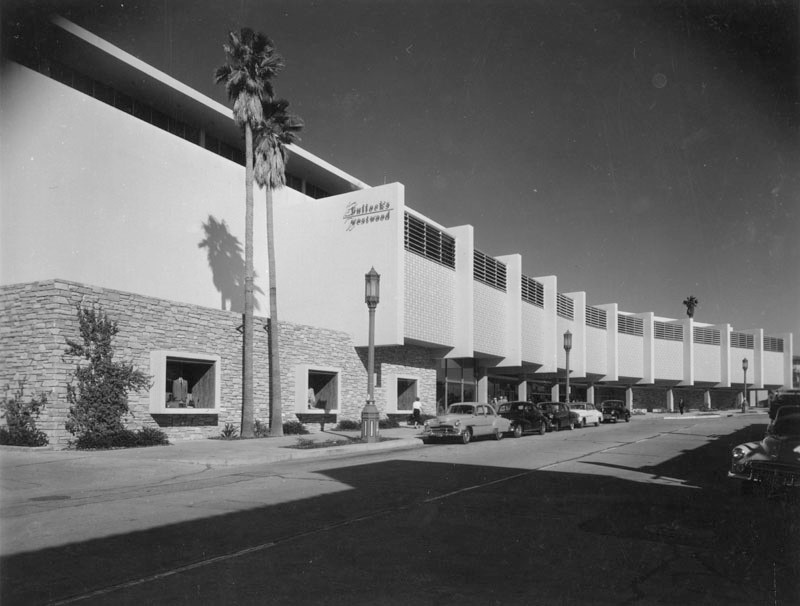 |
|
| (ca. 1953)* – View showing the Bullock's Westwood store with cars parked by the curb in front. |
Historical Notes The new Westwood Bullock's store, designed by Welton Becket, opened in 1952. It lasted for over forty years as a Bullock's, becoming a Macy's store in 1996. But three years later it was closed.* |
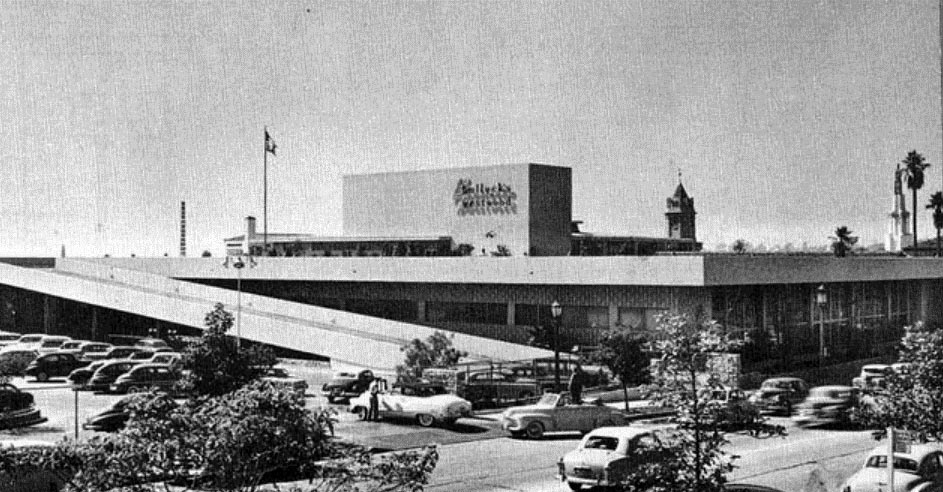 |
|
| (ca. 1952)#^^ - View of Bullock's Westwood from Le Conte Avenue showing part of its four-level parking. The tower of the Holmby Building can be seen in the background. |
Historical Notes In 2001 the building was remodeled to become an EXPO Design Center. A City Target opened in the space in 2012, and in 2015, a Ralphs Grocery Store (largest in Southern California) opened on the middle level. Click HERE to see contemporary view. |
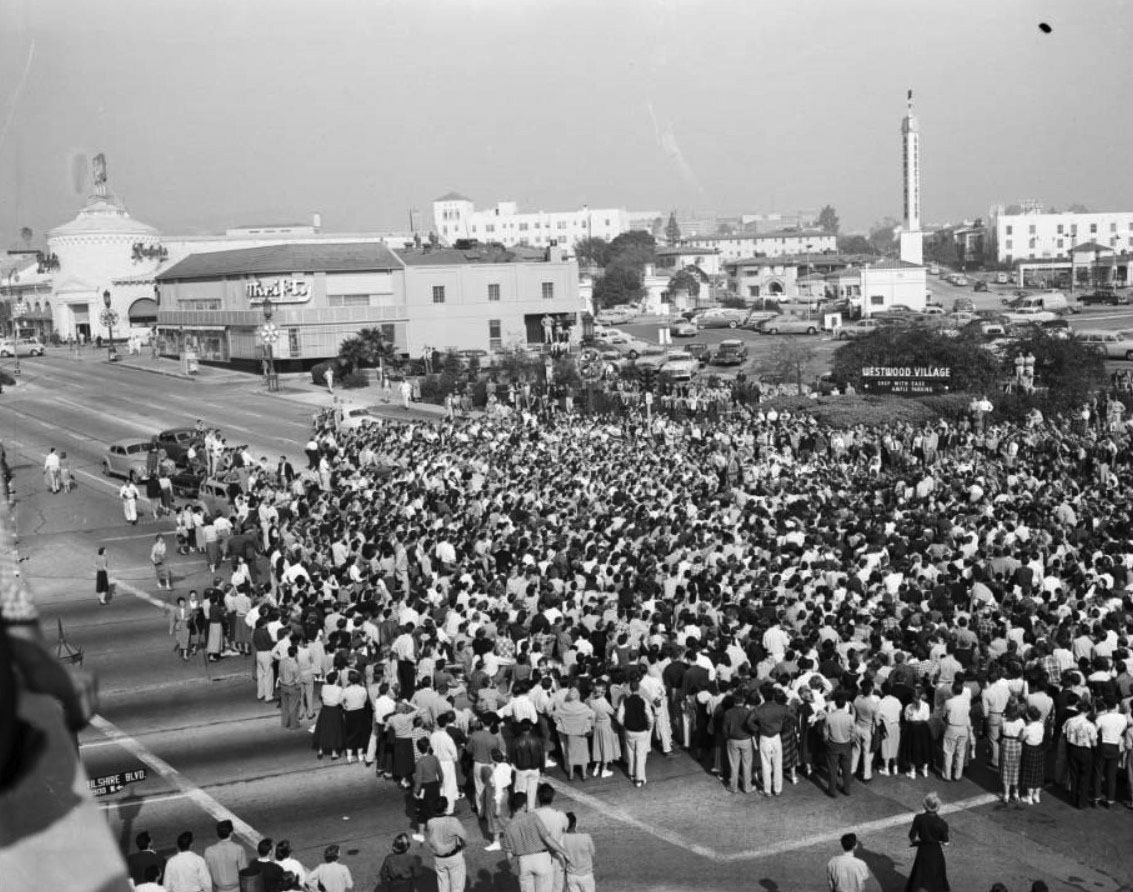 |
|
| (1953)^^– View showing a Victory rally in Westwood Village, at the intersection of Wilshire and Westwood boulevards. |
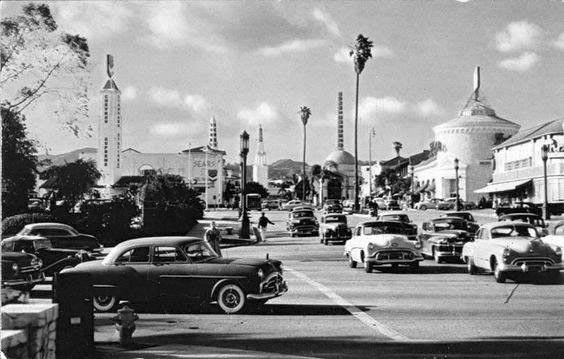 |
|
| (ca. 1956)^^# – View looking northward across Wilshire Boulevard into Westwood Village. |
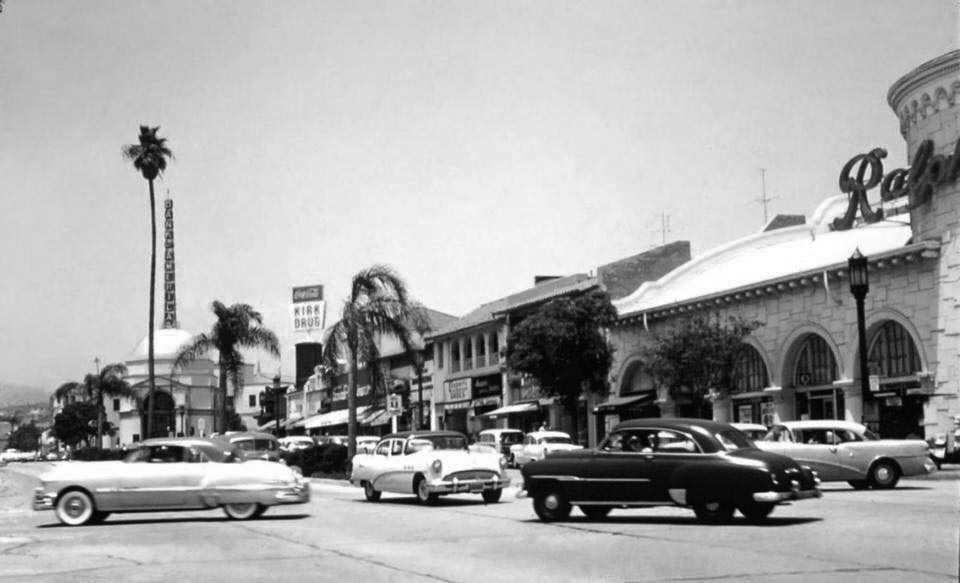 |
|
| (1950s)*^^ – View looking north on Westwood Boulevard with the iconic domed Bank of America building at left behind a tall palm tree. To the right, on the northeast corner of Westwood Blvd and Lindbrook Drive, stands Ralphs Super Market. The darker car in the photo is a 1951 Chevrolet Styleline Deluxe two door sedan. |
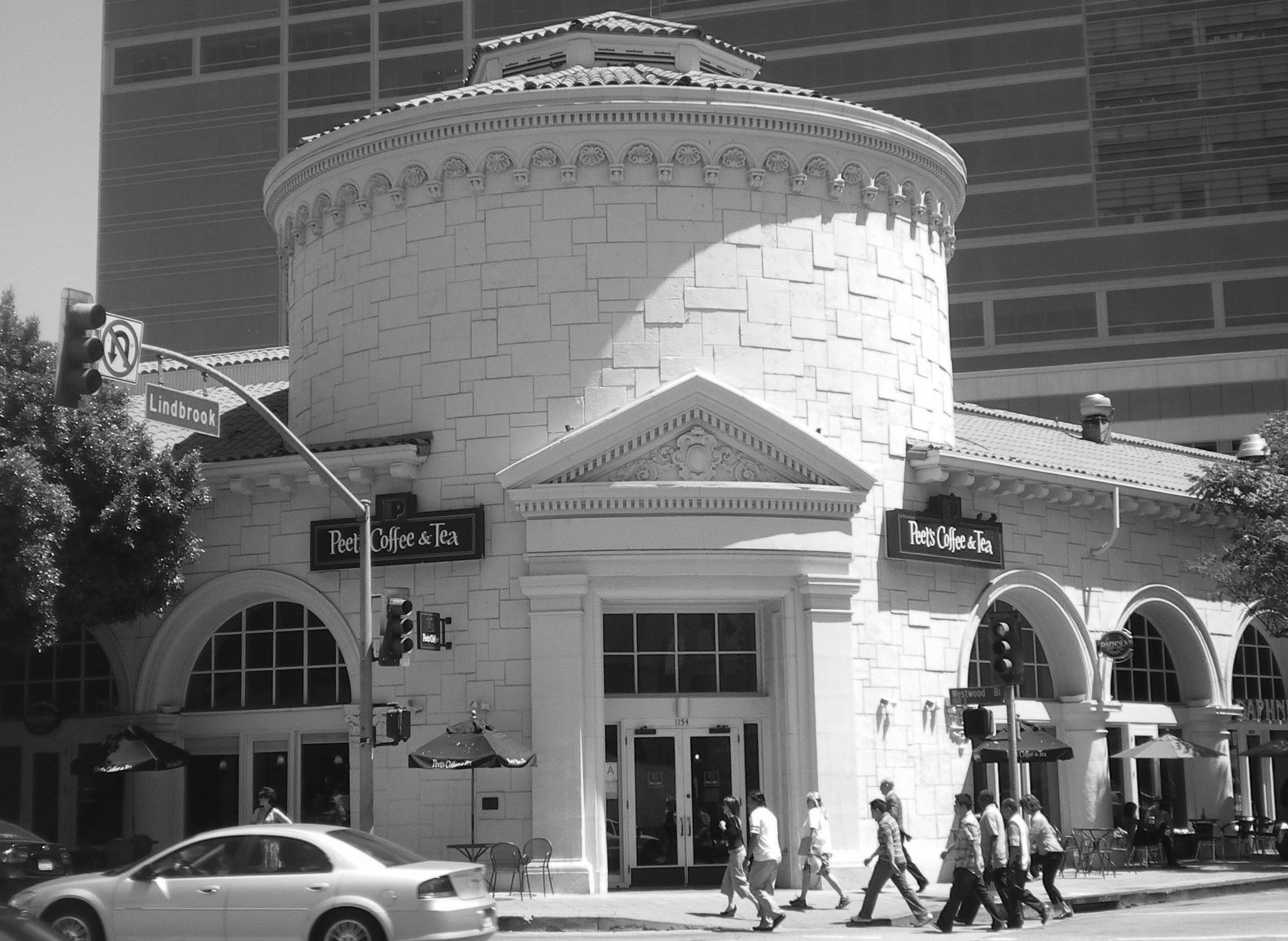 |
|
| (2008)*^ - View showing the Ralphs Grocery Store building as it appears today, with Peet's Coffee & Tea now occupying the corner. Ralphs moved further north into the old Bullock's Westwood structure on Le Conte Ave. |
Historical Notes Built in 1929, Ralphs Grocery Store was one of the original six buildings in the Westwood Village development. The building was noted for its cylindrical rotunda capped by a low saucer dome, with a pediment over the entrance and arcaded wings extending north and east. It was photographed by Ansel Adams in 1940, declared a Historic-Cultural Monument in 1988, and listed on the National Register of Historic Places in 1992.*^ |
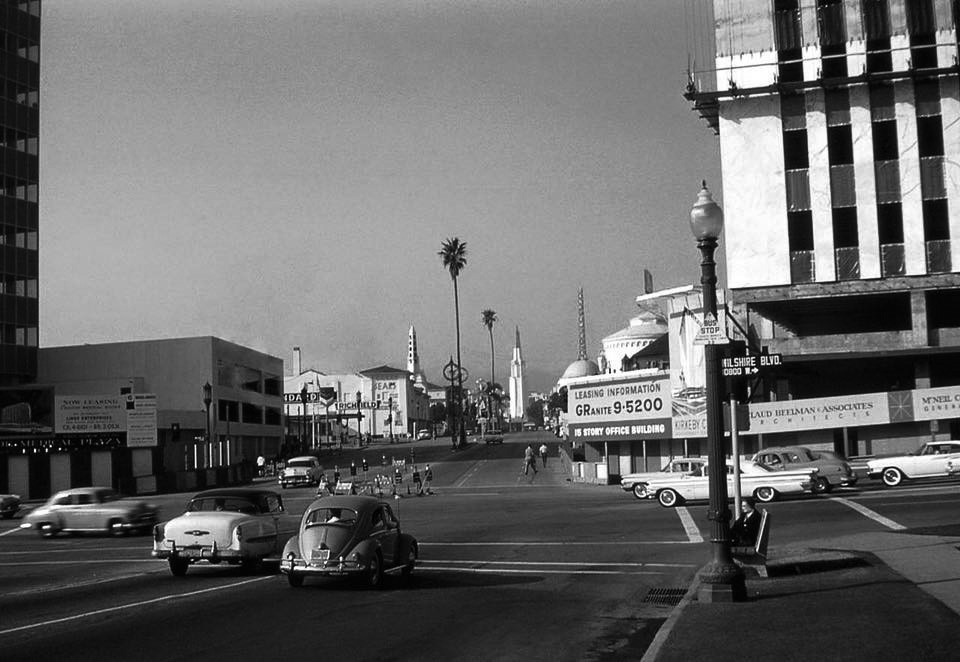 |
|
| (1961)*^^ - View looking north on Westwood Boulevard at Wilshire with the Art Deco tower of the Fox Theatre in the distance. Two new high-rise office buildings are under construction on the N/E and N/W corners. |
Historical Notes The altering of the area's skyline began here with construction of the two hi-rises on the north corners---the Linde Medical Center (currently the Westwood Medical Plaza) and Occidental Petroleum Center (recently purchased by UCLA). Today the Hammer Museum is located at right, on the N/E corner of Wilshire and Westwood Blvd.*^^ |
National Theatre
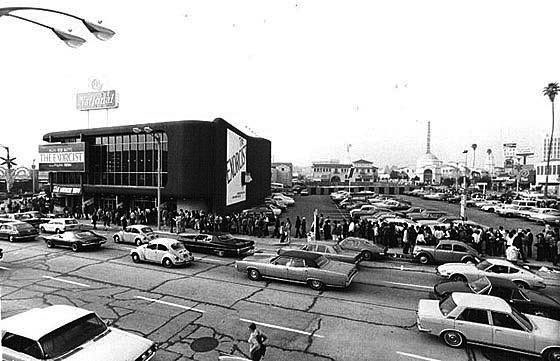 |
|
| (1973)* – View looking north across Lindrook Drive showing long lines in front of the National Theatre, located on the NE corner of Lindbrook Drive and Gayley Ave. In the distance, past the theater parking lot, can be seen Janss Dome. |
Historical Notes The debut of the National Theatre was March 27, 1970 with "The Boys in the Band." It was a project of National General Corporation, then the operator of the remnants of the Fox West Coast chain. The location was the northeast corner of Lindbrook and Gayley Ave. |
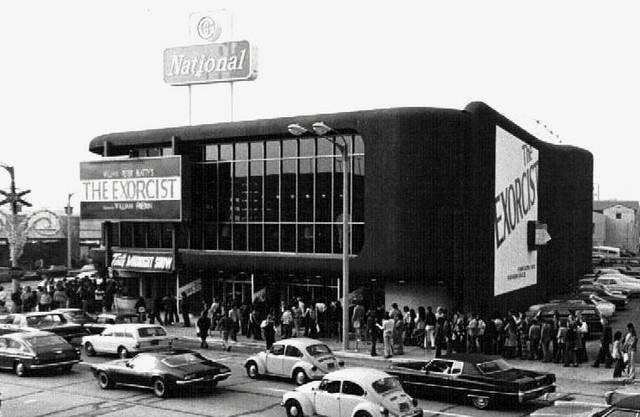 |
|
| (1973)^* – Close-up view of the the National Theatre with people waiting in long lines to see opening of ‘The Exorcist’. |
Historical Notes Starting construction in 1969, the 1,112 seat National Theatre was to be called the Fox Westwood (not to be confused with the classic Fox Westwood Village theatre two blocks away). But by the time the theatre opened to the general public on Friday, March 27, 1970, the National name graced the front of the building. That was because National General had just phased out the Fox name that appeared as part of every one of their theatre names (for years, directory ads always read National General's Fox West Coast theatres).^ |
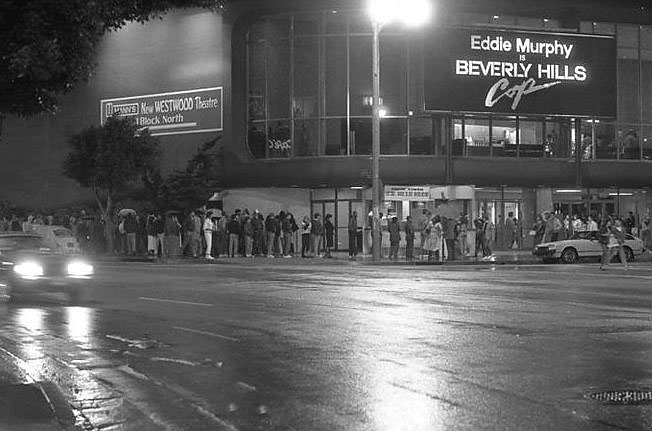 |
|
| (1984)** – Moviegoers line up in front of the National Theatre in Westwood to "Beverly Hills Cop" with Eddie Murphy. Location: 10925 Lindbrook Drive, Westwood |
Historical Notes For years, the National was an exclusive engagement theatre, with clearance over every other theatre in a three county area (L.A., San Bernardino, Riverside). There were exceptions. After Fiddler on the Roof ended its reserved seat engagement at the Wilshire, the National was added to the selected theatre release, albeit with an exclusive 70mm print. |
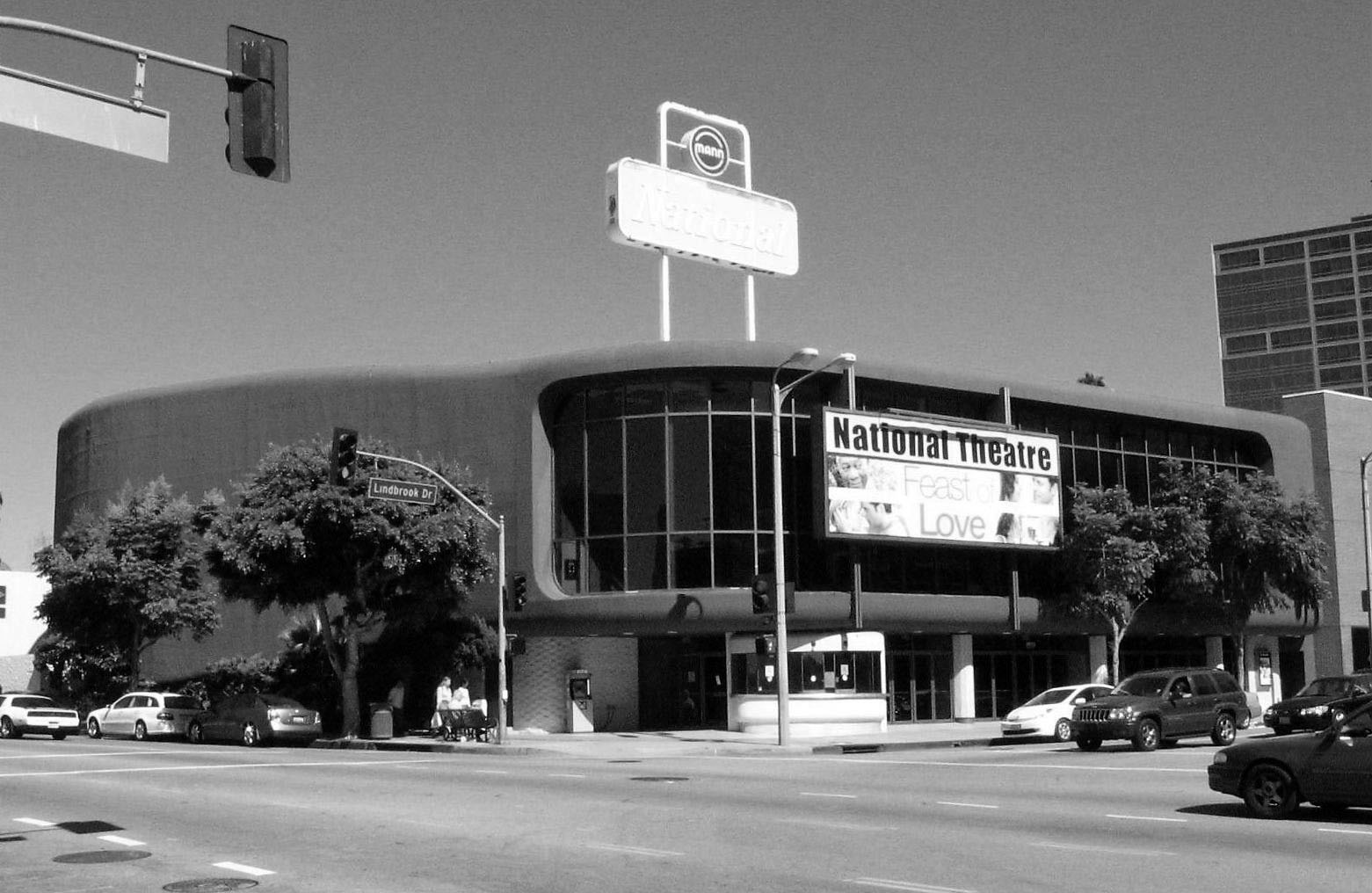 |
|
| (2007)* – View showing the National Theatre, NE corner of Lindbrook and Gayley, in its last year of operations. It was there between 1970 and 2007 before being torn down to make way for an office building. |
Historical Notes Designed by Architect Harold Levitt, the NGC National Theatre was one of the last single screen giants to be erected. Its 1970s futuristic-style exterior belied a large upstairs lobby (which was replete with chandeliers) and an enormous orange-colored auditorium (which boasted a massive screen 56ft wide and 26ft high). All seating was on a single sloping floor. It was equipped with Norelco DP-75 projectors which were capable of screening 35mm & 70mm films. One interesting feature of the theatre was its marquee. It mounted on two tracks, which allowed it to be lowered all the way to the ground for easy changing. Mann Theatres closed the theater on April 19, 2007. It was re-opened on May 11, 2007, by an independent operator, but closed again on October 7, 2007.* |
Ships Coffee Shop
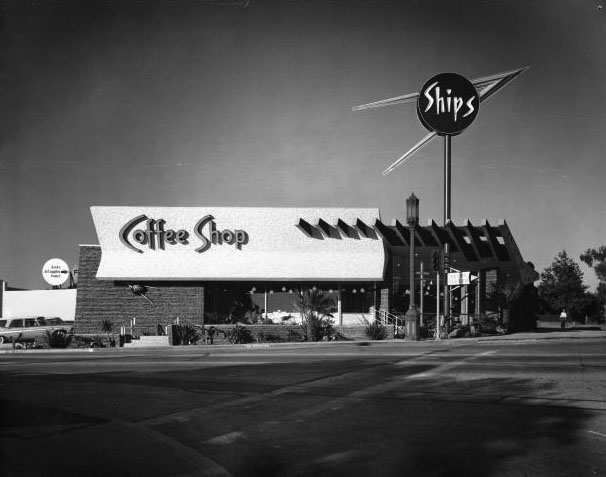 |
|
| (ca. 1963)+# – View showing Ships Coffee Shop located on the northeast corner of Wilshire Boulevard and Glendon Avenue in Westwood. Ships' iconic Modern architecture is classified Googies Architecture. |
Historical Notes There were three Ships locations opened by resterauteur Emmett Shipman and his father Matt Shipman, at Westwood, Culver City and La Cienega (near Olympic). They were open 24 hours, 365 days a year, never closing. The first Ships Coffee Shop opened in Culver City (1956). Architect Martin Stern, Jr. designed that building and the second Ships (seen above), which was built in Westwood in 1958. There was a third Ships built near La Cienega and Olympic (1968). Fans of Googies Architecture considered the Westwood location a fine example of the futuristic style, with its hovering angular roof canopy and glass walls that seemed to defy the rules of gravity. It was a huge hit with UCLA students. ^+^ |
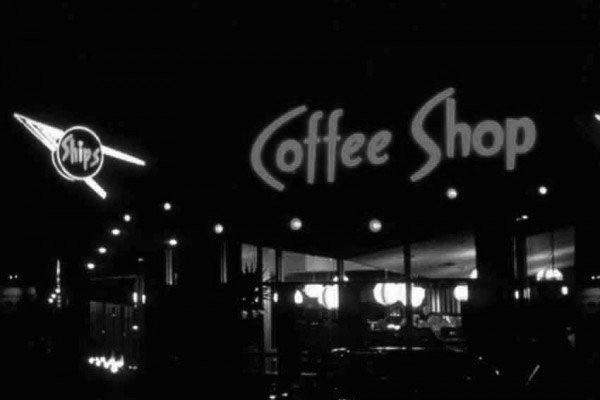 |
|
| (1963)*^* – Night view showing Ships Coffee Shop located at 10877 Wilshire Boulevard. Photo by George Mann |
Historical Notes With their boomerang-shaped roofs and futuristic neon signs, Ships Coffee Shops were impossible to miss. Inside, the small chain dished out American favorites, but the diners’ exteriors were otherworldly; they looked like UFOs! |
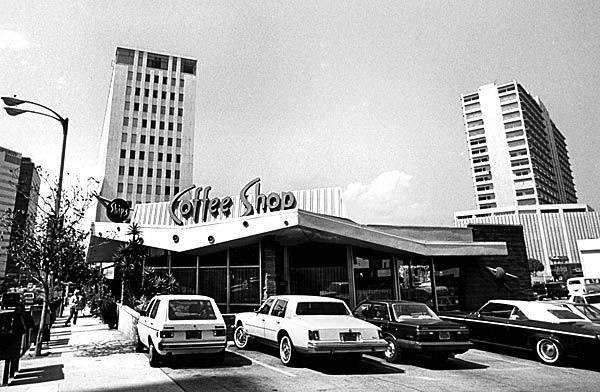 |
|
| (ca. 1984)#+ – Sidewalk view looking west on Wilshire Boulevard showing Ships Coffee Shop and parking lot. The tall building on the left is the Occidental Petroleum Center, currently Union Bank, Hammer Museum, and the Billy Wilder Theatre. |
Historical Notes Both locals and tourists loved Ships. The three restaurants served 50 million customers from 1956 to 1996. Because there was a toaster on every table, Ships always smelled of burnt toast. Preparing your own toast of choice was the main event. *^* |
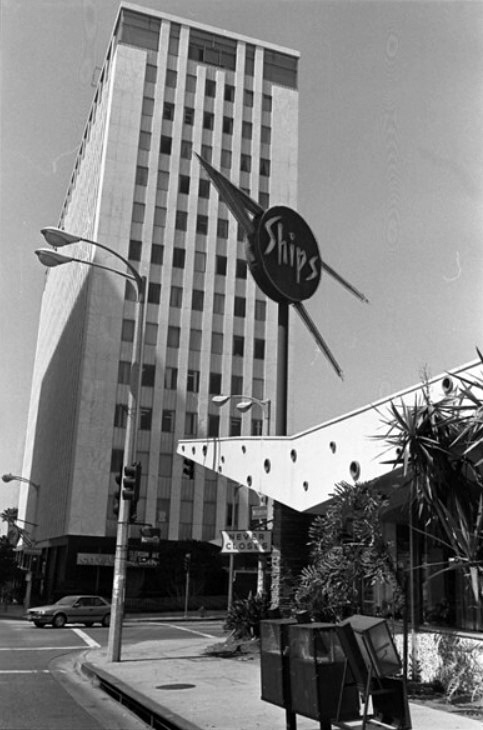 |
|
| (1984)^.^ – Ships, Westwood shortly before it was demolished, with the Occidental Petroleum Center in the background. |
Historical Notes The Ships Coffee Shop in Westwood closed on September 20th 1984 and was demolished the following day, to make way for a 20 story office building. *^* |
Monty's Steakkhouse
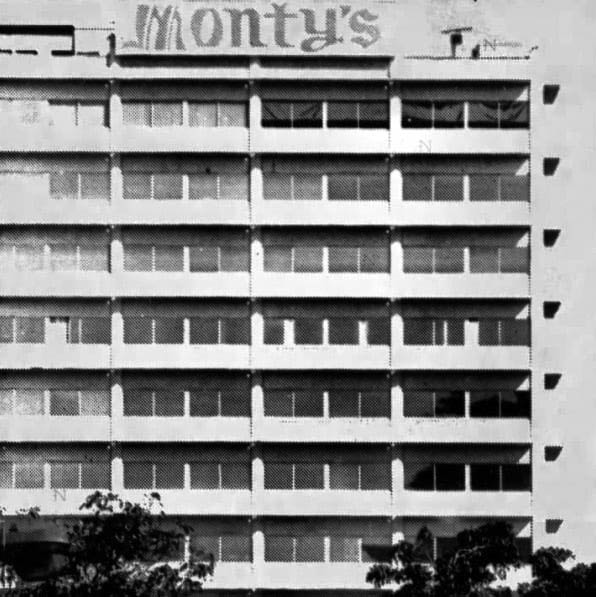 |
|
| (1987)^ - Monty's Steakhouse, located on the top floor of the Westwood Center Building at 1100 Glendon Avenue. |
Historical Notes There was a Monty’s at the top of an office building, high above Westwood, with a wonderful view of UCLA and the hills of Bel Air beyond. Monty’s Steakhouse, the Westwood fixture set atop the Westwood Center building at 1100 Glendon Ave. It had been entrenched in the penthouse since 1969 (the structure dates from ’65). During its reign, its neon sign became a landmark and its dark interior saw lots of interesting events, including Snoop Doggy Dogg’s acquittal party. It was also the spot for scores of recruitment dinners for UCLA athletes, including the infamous meal that led to basketball coach Jim Harrick’s dismissal in November 1996.* Monty's Steakhouse was closed in 1999 just before the building it was housed in (Westwood Center Building) was renovated. |
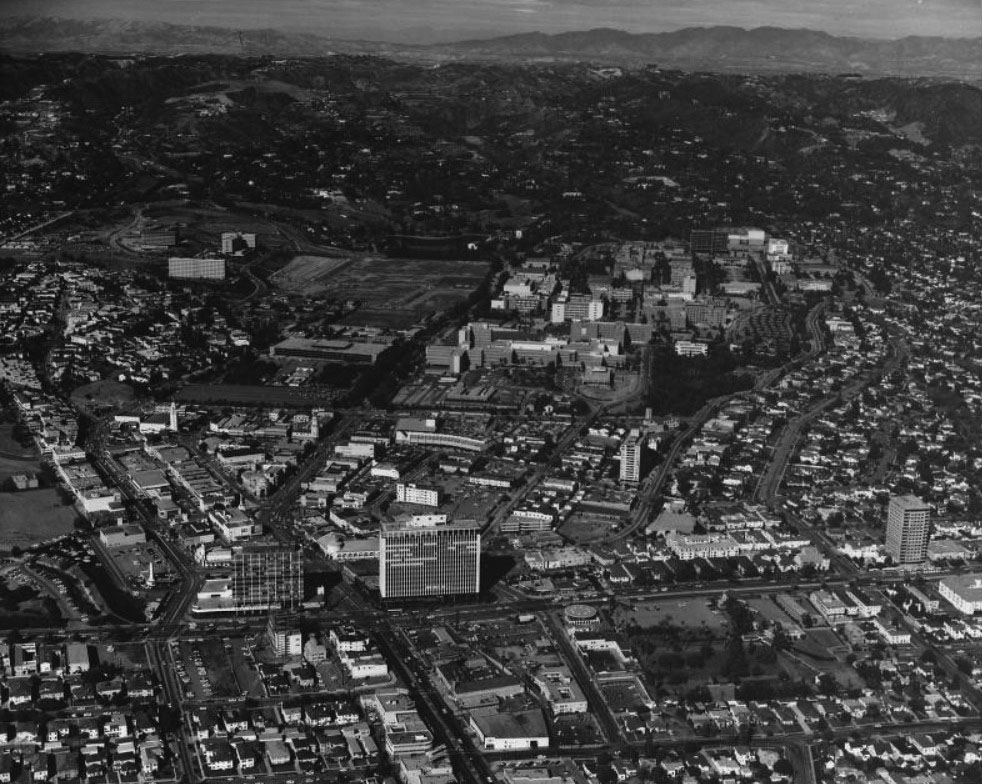 |
|
| (1966)^^ – Aerial view looking north showing the two new high-rises at the intersection of Wilshire and Westwood boulevards (lower center-left) with Westwood Village and the UCLA campus seen further back. |
 |
|
| (1970's)^.^ - Westwood Village |
* * * * * |
More Early Views of UCLA
 |
|
| (1931)^ – View showing the UCLA stop on the Wilshire bus route, essentially at the foot of Janss Steps with Powell Library in the background. The bus is parked on what would soon become a vast athletic field which would, in turn, give itself over to Pauley Pavilion (out-of-frame to the right). |
 |
|
| (1930s)^^ - Photograph of a wide view of the University of California at Los Angeles. The buildings of the campus lie beyond two vast fields. The field in the foreground is rocky and overgrown, while the field nearest the buildings is manicured and used for sports. Sunset Boulevard is seen on the left. |
 |
|
| (ca. 1938)^^ - View of the University of California Los Angeles campus from the baseball field, ca.1938. A baseball diamond is visible in the foreground at center, and bleachers can be seen on both the first and third base lines. In the background are several large brick buildings. These include, from left to right: Women's Gym, Royce Hall, Men's Gym, Powell Library, Kerckhoff Hall, and Moore Hall behind. A parking lot can be seen between the diamond and the buildings and is full of cars, indicating that UCLA was a commuter campus from early in its history. |
 |
|
| (ca. 1930s)^^ - View of the buildings on the UCLA from across an open field. In the foreground, a wide field is pictured with football blocking equipment at left and what appears to be a sprinkler at right. Behind this, a cluster of Roman Revival-style and gothic buildings comprises the University of California, Los Angeles campus. At left, a stand of trees makes a border to the field. |
 |
|
| (1937)* - View of UCLA's campus buildings from left to right: Men's gymnasium, Royce Hall, Janss Steps; and Powell Library. |
 |
|
| (1939)* - Exterior view of the Men's Gym on the UCLA Westwood campus on May 3, 1939. |
 |
|
| (1939)* - View of UCLA's campus buildings, as seen from the northwest. |
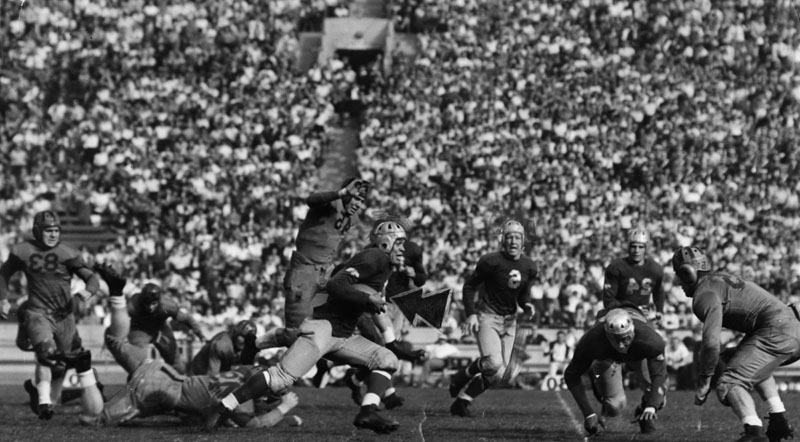 |
|
| (1939)* - The University of California at Los Angeles after trailing California at Berkeley through the first quarter, finally came into its own at the Memorial Coliseum. In this photo, Kenny Washington, brilliant Bruin halfback, is away to a smashing gain as his teammate, Strode, effectively blocks out the California secondary defense. The Washington to Strode combination is a famous one. Photo dated: November 4, 1939. |
Historical Notes Kenny Washington led the nation in total offense and became the first consensus All-American in the history of the school's football program in 1939. He rushed for 1,914 yards in his college career, a school record for 34 years. He was one of four African American players on the 1939 UCLA Bruins football team, the others being Woody Strode, Jackie Robinson and Ray Bartlett. Washington, Strode, and Robinson starred on the 1939 UCLA Bruins football team, in which they made up three of the four backfield players. This was a rarity to have so many African Americans when only a few dozen at all played on college football teams. They played eventual conference and national champion USC to a 0-0 tie with the 1940 Rose Bowl on the line. It was the first UCLA-USC rivalry football game with national implications.*^ |
 |
|
| (ca. 1940)* - View of UCLA's campus buildings, as seen from the west, across the playing fields. From left to right: Royce Hall, built in 1928-29, and the Women's gymnasium, built in 1932. |
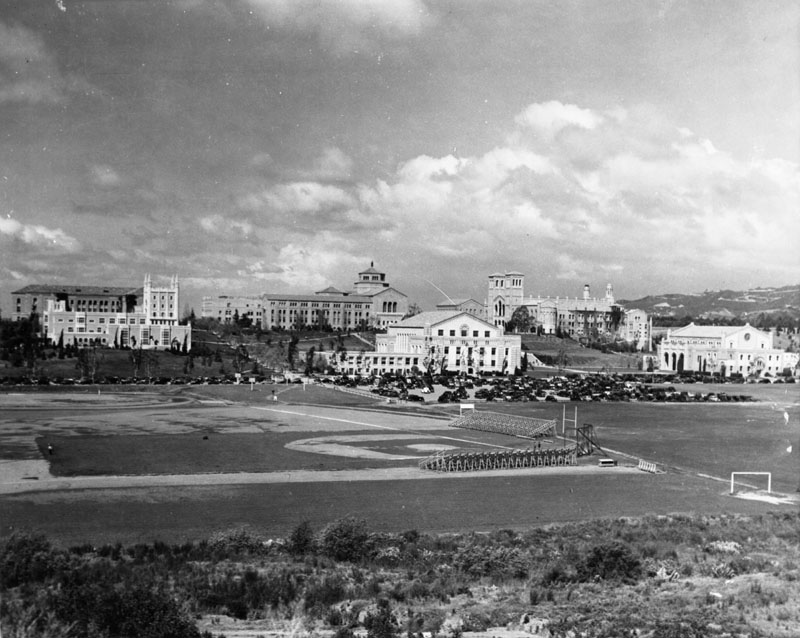 |
|
| (ca. 1940)* - View of UCLA's campus buildings, as seen from the west. |
.jpg) |
|
| (ca. 1953)^^ – Aerial view looking west showing the University of California Los Angeles campus with the Sawtelle Reservoir seen at center-right. The two large quads in the foreground at right are situated where a gully once existed with a bridge over it connecting the campus to Hilgard Avenue. |
Before and After
 |
|
.jpg) |
|
| (1929)* vs (ca 1953)^^ - Aerial view looking west of the UCLA campus before and after the gully was filled-in. |
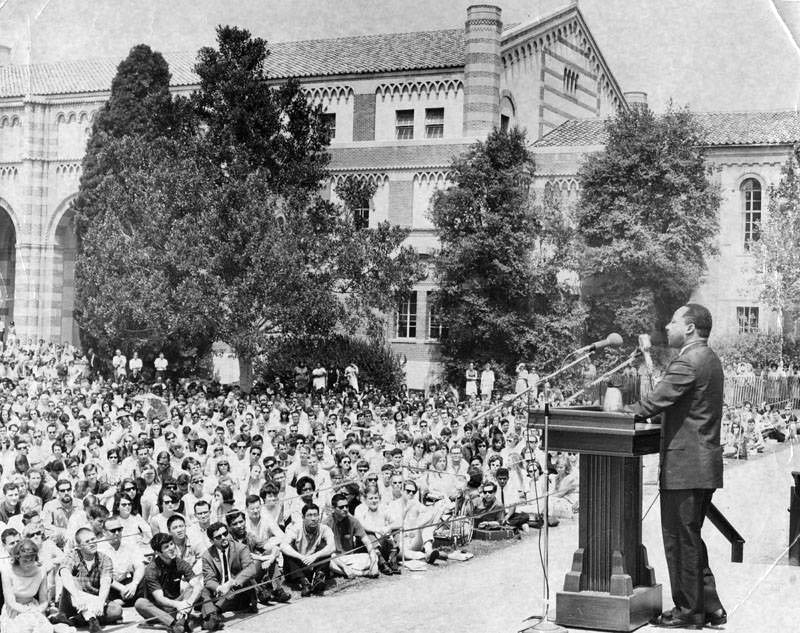 |
|
| (1965)* - Martin Luther King, Jr. speaks to a crowd of 4,500 on the campus of the University of California, Los Angeles in April 1965. |
Historical Notes In this 1965 speech at UCLA, Martin Luther King called for students to join a "Domestic Freedom Corps" to work in 120 counties of the Deep South to help increase the number of registered African American voters.* On October 14, 1964, King received the Nobel Peace Prize for combating racial inequality through nonviolence. In 1965, he and the SCLC helped to organize the Selma to Montgomery marches and the following year, he took the movement north to Chicago to work on segregated housing. In the final years of his life, King expanded his focus to include poverty and speak against the Vietnam War, alienating many of his liberal allies with a 1967 speech titled "Beyond Vietnam". In 1968, King was planning a national occupation of Washington, D.C., to be called the Poor People's Campaign, when he was assassinated on April 4 in Memphis, Tennessee. King was posthumously awarded the Presidential Medal of Freedom and the Congressional Gold Medal. Martin Luther King, Jr. Day was established as a holiday in numerous cities and states beginning in 1971, and as a U.S. federal holiday in 1986.*^ |
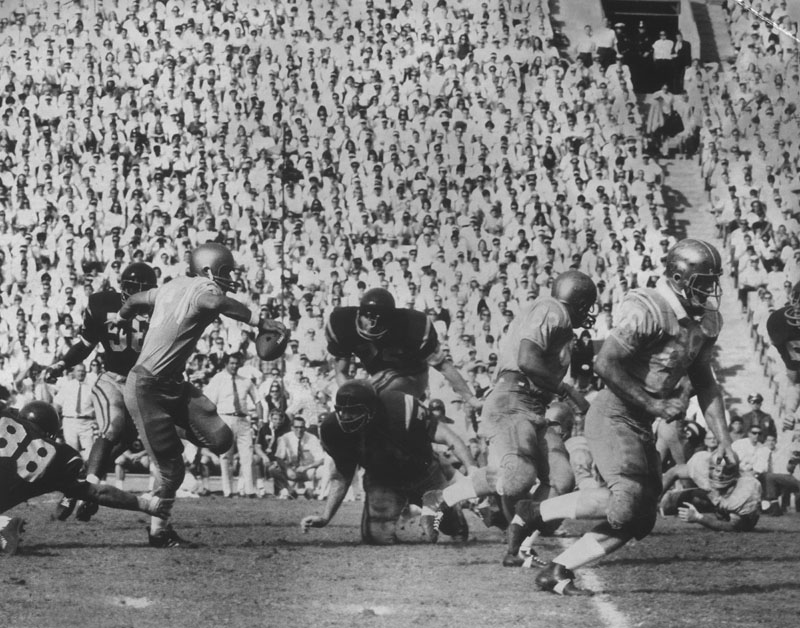 |
|
| (1967)* - When USC met UCLA in 1967, the game wasn't just for cross-town bragging rights. UCLA was undefeated and ranked No. 1 in the nation. Ranked No. 4, USC had one loss. Early in the fourth quarter, UCLA's Gary Beban threw a 20-yard touchdown pass to give the Bruins a 20-14 lead. But on a third-and-eight play late in the fourth quarter, O.J. Simpson broke loose on a 65-yard touchdown run for USC's come-from-behind 21-20 win. Beban did win a consolation prize: he beat out Simpson for the Heisman Trophy. |
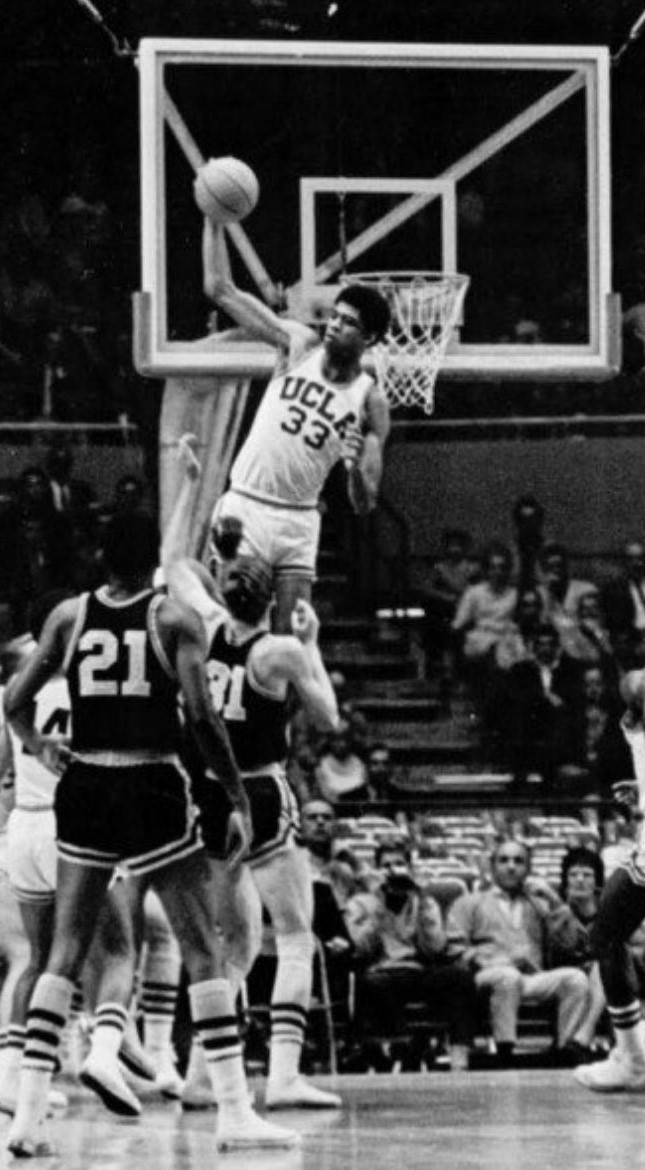 |
|
| (1966)* – Lew Alcindor (aka Kareem Abdul-Jabbar), named “Greatest College Player of All Time”. |
Historical Notes From 1967–69, Lew Alcindor played under coach John Wooden, contributing to the team's three-year record of 88 wins and only two losses: one to the University of Houston in which Alcindor had a not fully healed eye injury, and the other to crosstown rival USC who played a "stall game" (i.e., there was no shot clock in those days, so a team could hold the ball as long as it wanted before attempting to score). In his first college game, Lew set a UCLA single game record with 56 points. The 1965–66 UCLA Bruin team was the preseason #1. But on November 27, 1965, the freshman team led by Alcindor defeated the varsity team 75–60 in the first game in the new Pauley Pavilion. Alcindor scored 31 points and had 21 rebounds in that game. During his college career, Alcindor was twice named Player of the Year (1967, 1969); was a three-time First Team All-American (1967–69); played on three NCAA basketball champion teams (1967, 1968, 1969); was honored as the Most Outstanding Player in the NCAA Tournament (1967, 1968, 1969); and became the first-ever Naismith College Player of the Year in 1969.*^ |
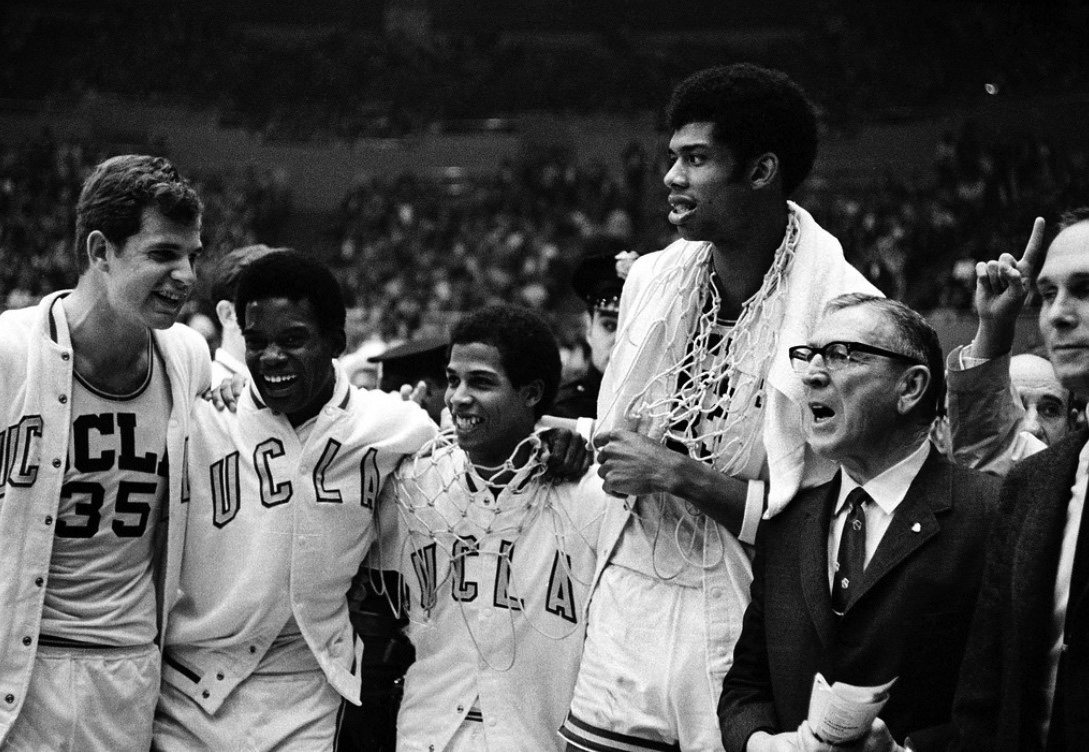 |
|
| (1968)* - UCLA coach John Wooden celebrates with his players, from left, Mike Lynn, Lucius Allen, Mike Warren and Lew Alcindor after the Bruins beat North Carolina, 78-55, to win the NCAA championship final at the Los Angeles Sports Arena, March 23, 1968. |
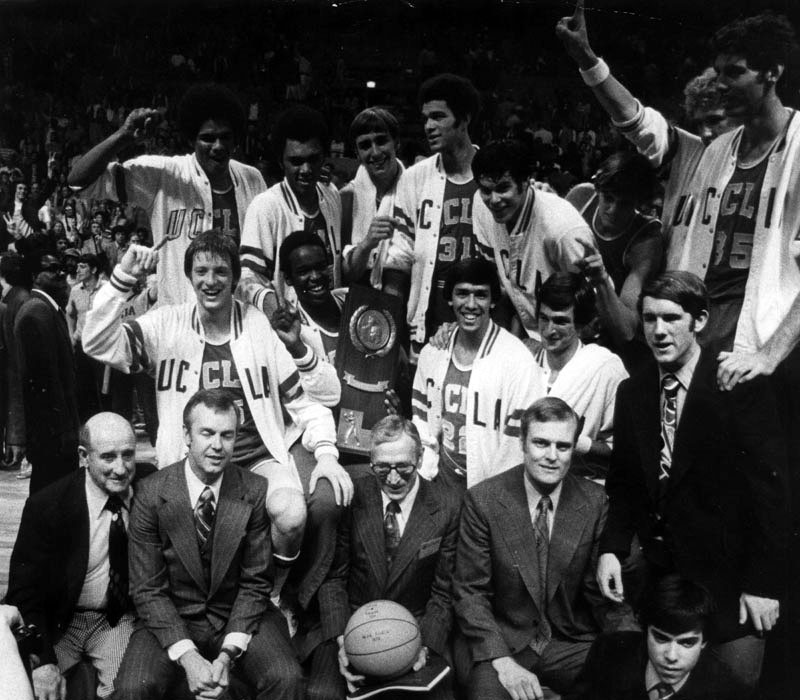 |
|
| (1975)* - This photo was taken after the final game that John Wooden coached--a 92-85 win over the Kentucky Wildcats, to give the Bruins their 10th NCAA title under Wooden. |
Historical Notes Ihe UCLA Bruins have won 125 national championships, including 108 NCAA team championships as of December 2011, more than any other university. UCLA student-athletes have won 214 Olympic medals – 106 gold, 54 silver and 54 bronze. The Bruins have had at least one competitor in every Olympics since 1920 with one exception (1924), and UCLA has won a gold medal in every Olympics since 1932 with the exception of 1980 (boycott).* |
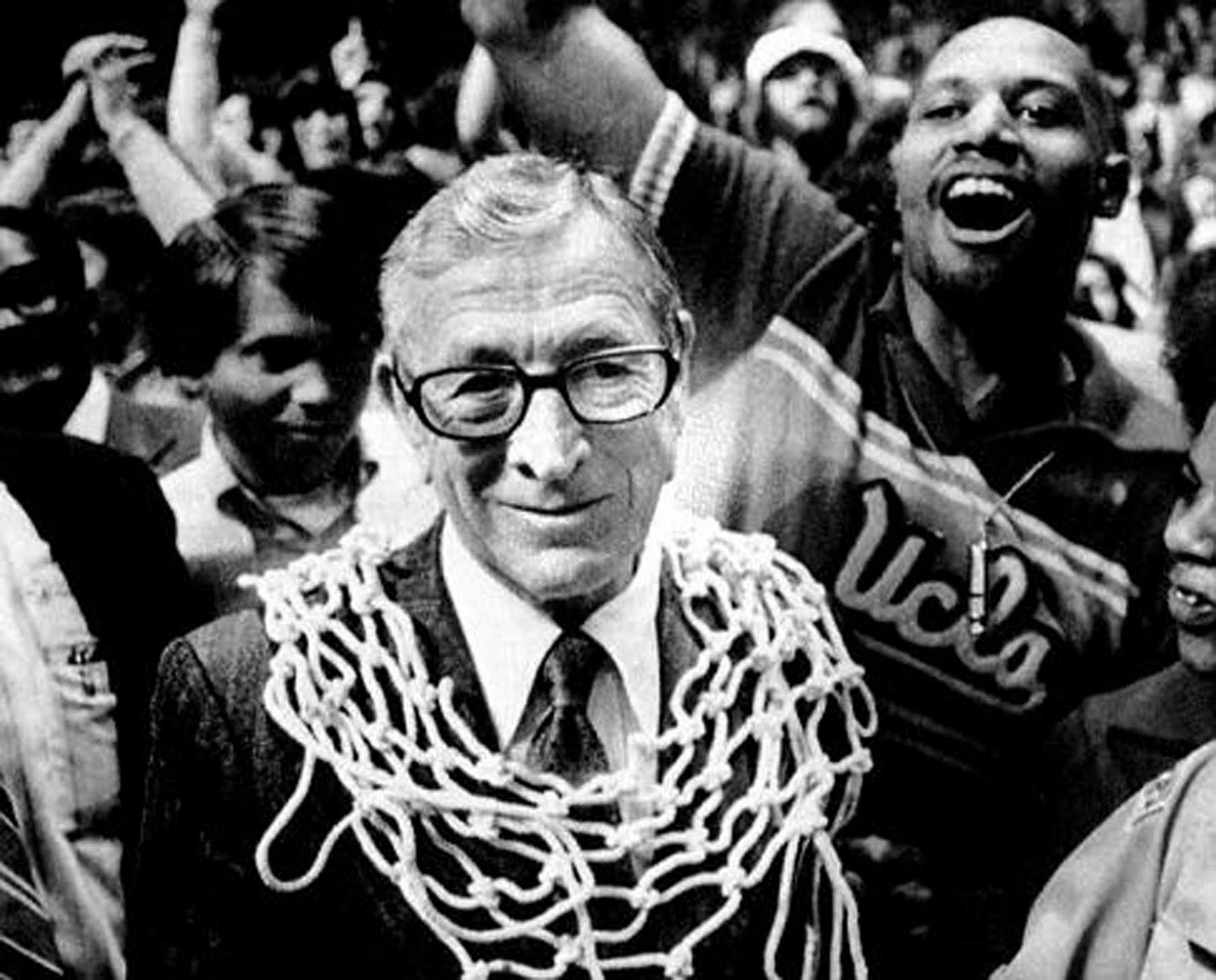 |
|
| (1975)**^ - John Wooden the 'Legend'. “You haven’t taught until they have learned.” With this simple phrase and his dedication to constant improvement, John Wooden sparked a revolution in coaching strategies. |
Historical Notes In some cases, the word "legend" is an understatement. That was the case with former UCLA coach John Wooden, winner of 10 national titles in a 12-year stretch. He'd announced his retirement before the 1975 national title game against Kentucky. The 1974 -75 squad was not Wooden's best -- he didn't have Lew Alcindor or Bill Walton -- but the Bruins' 92-85 win in the national title game that year guaranteed a proper sendoff for Wooden. He left the game on top. Few coaches in any sport can match that.* |
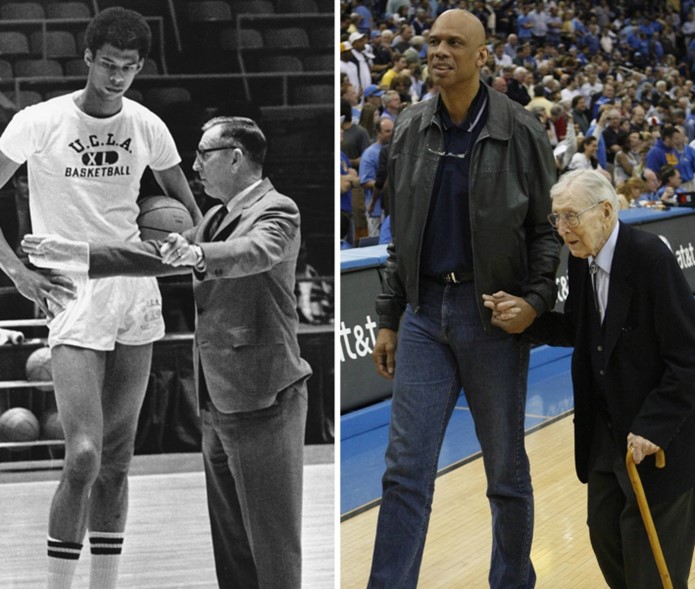 |
|
| (1967 vs. 2010)* - “The effectiveness of a leader is best judged by the actions of the ones he guided.” Priceless pic of love and respect! |
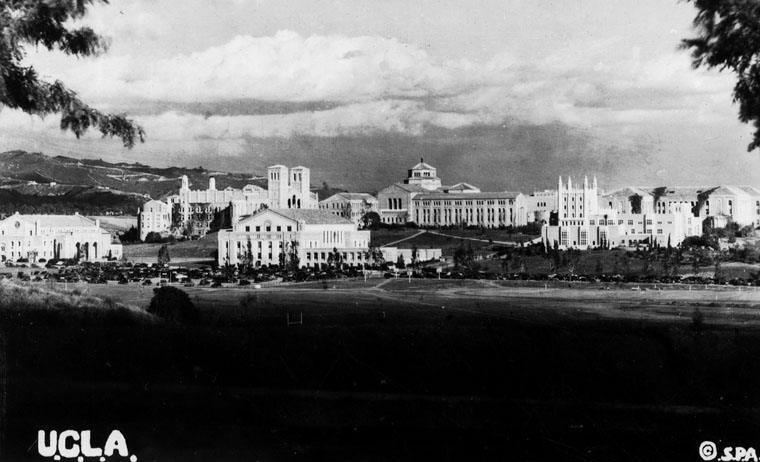 |
|
| (ca. 1930s)* - Postcard view of UCLA's campus buildings, as seen from the southwest. |
Historical Notes After World War II, the architects changed to a less costly and more modern style buildings which still featured red brick. The 1950s and early 1960s saw a building boom that produced more than 60 permanent structures on campus.** |
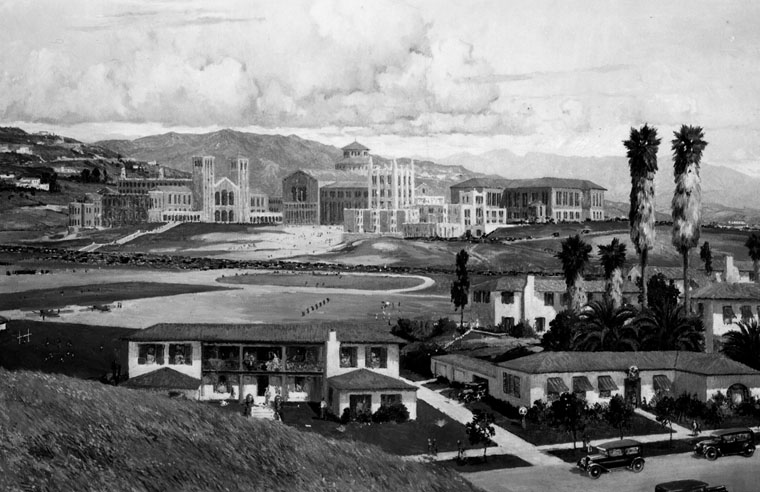 |
|
| (ca. 1930)* - Panoramic view of the UCLA Westwood campus. This is a photograph of a Chris Siemer painting created for a display by the L.A. Chamber of Commerce. |
* * * * * |
Please Support Our CauseWater and Power Associates, Inc. is a non-profit, public service organization dedicated to preserving historical records and photos. Your generosity allows us to continue to disseminate knowledge of the rich and diverse multicultural history of the greater Los Angeles area; to serve as a resource of historical information; and to assist in the preservation of the city's historic records.
|
More Historical Early Views
Newest Additions
Early LA Buildings and City Views
History of Water and Electricity in Los Angeles
* * * * * |
References and Credits
* LA Public Library Image Archive
#*Huntington Digital Library Archive
#^California State Library Image Archive
^# Skyscraperpage - Noirish Los Angels: Rancho San Jose de Buenos Ayres; Westwood-Life Magazine; Janss Steps; Westwood Observation Tower
#+ Pinterest: Eldon Davis and Googie Architecture
^*^Alumni.ucla.edu: UCLA History - A Bridge to the Future; UCLA History Timeline
**^The Sports IQ: John Wooden's Legacy
***ESPN: NCAA Tournament - The Top 75 Moments
**#Facebook.com: Garden of Allah Novels, Martin Turnbull
*^*LA Magazine: Ships Coffee Shop
*^^Facebook.com - Vintage L.A.: Westwood Boulevard
^^*Facebook.com - Bizzare Los Angeles
^^#Facebook.com - Matrin Turnbull
^^^Flickr.com: Michael Ryerson
^x^Facebook.com
#^^Flickr.com
*#^Historylosangeles.blogspot.com: Ice Skating in Westwood
^#*Campus Destinations: UCLA Kerckhoff Hall
^#^Oldhomesoflosangeles.blogspot.com: Arthur Letts Holmby House
^+^Los Angeles Conservancy: Ships Coffee Shop
^.^Westwood: Photos Then and Now
*^*Facebook.com - City of Angels: Westwood Village, ca.1937
*#*Facebook.com - Classic Hollywood/Los Angeles/SFV: Lew Alcindor; UCLA vs. Huston; Le Conte and Westwood
*^ Wikipedia: Janss Investment Company; Westwood; Westwood Village; UCLA; History of UCLA; Kenny Washington Holmby Hall; FOX Theatre, Westwood Village; Janss Investment Company Building; William G. Kerckhoff; Glorya Kaufman; Janss Dome; Marymount High School; Martin Luther King, Jr.; Kareem Abdul-Jabbar; Westwood Ralphs Market
< Back
Menu
- Home
- Mission
- Museum
- Major Efforts
- Recent Newsletters
- Historical Op Ed Pieces
- Board Officers and Directors
- Mulholland/McCarthy Service Awards
- Positions on Owens Valley and the City of Los Angeles Issues
- Legislative Positions on
Water Issues
- Legislative Positions on
Energy Issues
- Membership
- Contact Us
- Search Index